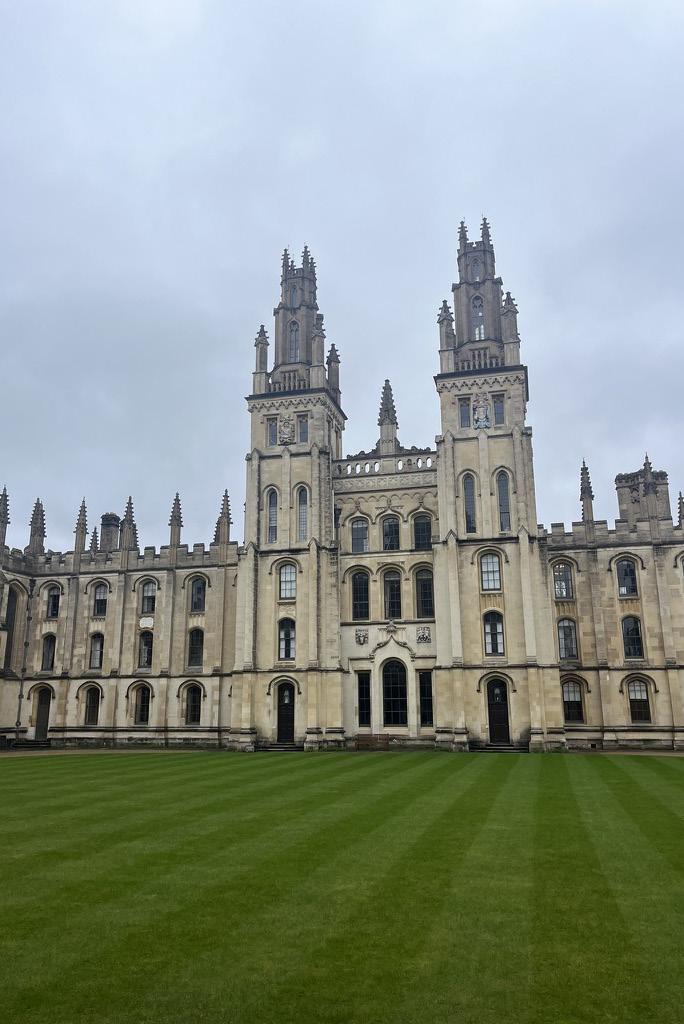
Special exhibition: The london review
museum map







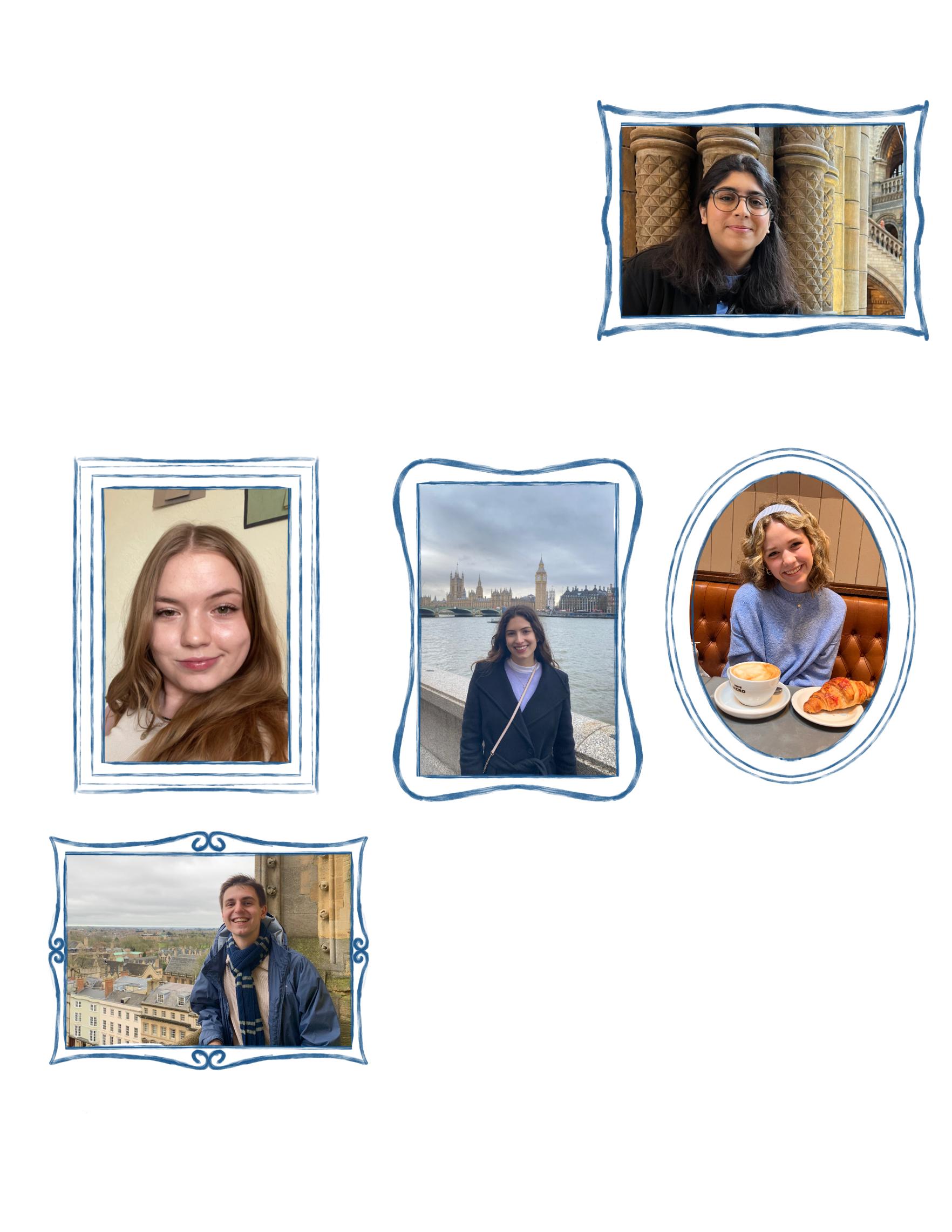
1. Fatima Asif: Senior, Double Major in Biochemistry and English, Overland Park, KS
2. Katie Bryan: Senior, English Major, Journalism and Mass Communications Minor, Lake Elmo, MN
3. Irene Caracioni: Senior, Triple Major in Mathematics, Economics, and Spanish, Topeka, KS
4. Emily Colby: Sophomore, Exercise Science Major, English Minor, Bloomington, MN
5. Ben Flynn: Sophomore, Environmental Science Major, Journalism Minor, Ainsworth, NE
1. Fatima Asif 2. Katie Bryan 3. Irene Caracioni 4. Emily Colby 5. Ben Flynn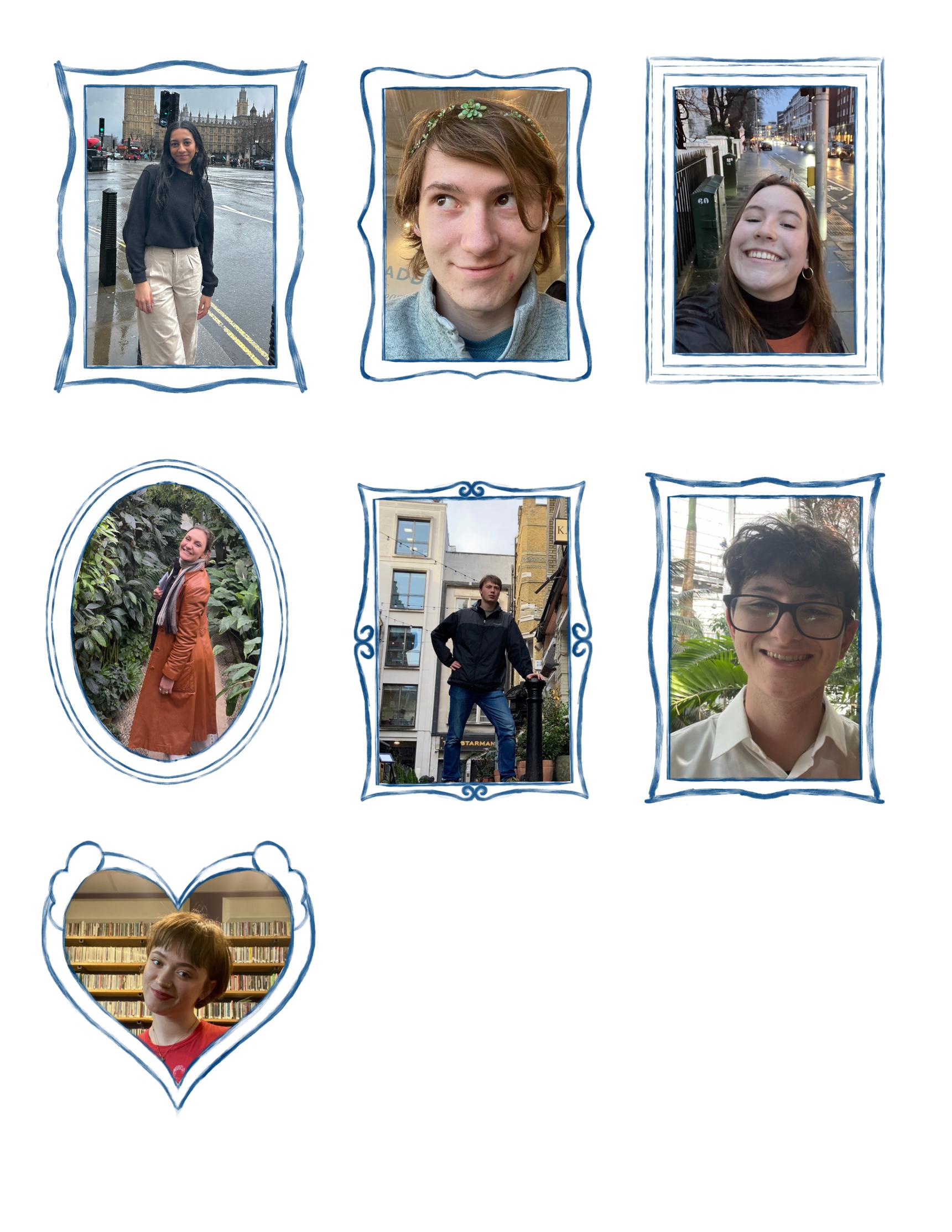
6. Bhavya Gupta: Sophomore, Microbiology Major, Minors in Journalism and Global and International Studies, Overland Park, KS
7. Joel Harrison: Freshman, Double Major in English and Computer Science, Philosophy Minor, Lawrence, KS
8. Lolly Hindman: Freshman, Double Major in Journalism and Sociology, Economics Minor, Lawrence, KS
9. becca Jones: Senior, Behavioral Neuroscience Major, Chemistry Minor, St. Louis, MO
10. Michael Koch: Junior, English Major, Philosophy Minor, Stillwell, KS
11. Elijah Kumin: Sophomore, Double Major in English and Philosophy, Minors in Visual Art and Classics, Lenexa, KS
12. Betsey Lewis: Junior, English Creative Writing Major, Women Gender and Sexuality Studies Minor, Kearney, NE
11. Eli Kumin 10. Michael Koch 9. becca Jones 6. Bhavya Gupta 7. Joel Harrison 8. Lolly Hindman 12. Betsey Lewis13. Easton Logback
Connor Maloney
Madeleine Morris

13. Easton Logback: Freshman, Triple Major in Philosophy, Classical Humanities, and English, Overland Park, KS
14. Connor Maloney: Junior, Theatre Design Major, Wichita, KS
15. Madeleine Morris: Junior, Double Major in English and Communication Studies, Columbia, MO
16. Xander Nichols: Freshman, Sports Management Major, Business Minor, Independence, MO
17. Carina O’Brien: Sophomore, Social Work Major, English Minor, Barrington, IL
18. Rachel Odabasi: Junior, Architecture Major, Lincoln, NE
19. Rylie Oswald Al-Awhad: Junior, Journalism and Creative Writing Major, Osage City, KS
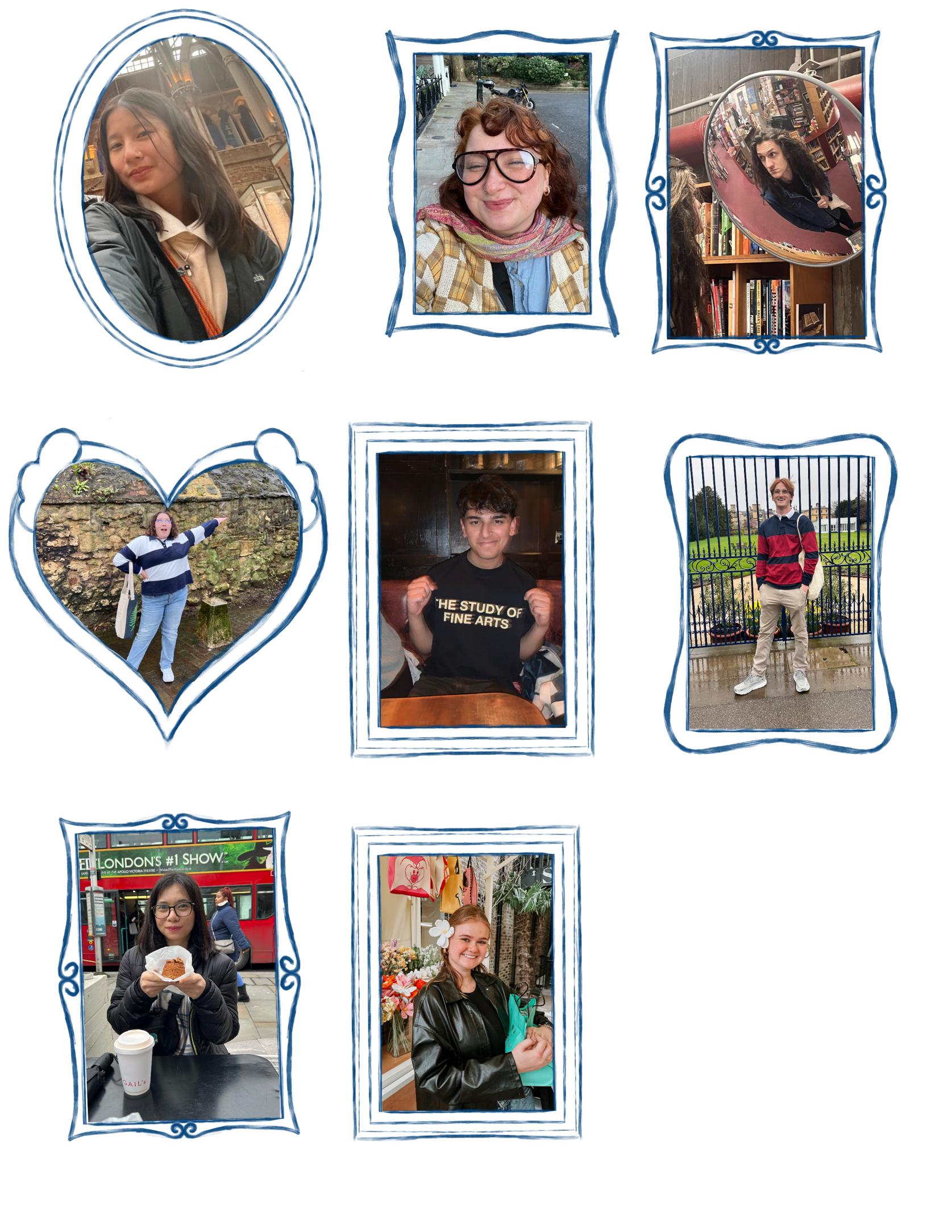
20. Elena Pacioianu: Sophomore, Biology Major, Creative Writing Minor, Topeka KS
21. Kahill Taylor Perkins: First-year graduate student, Double Major in Creative Writing & Literary Theory, Lawrence, KS
22. Nile Russo: Sophomore, English Major, Lawrence, KS
23. Lilia Spiess: Freshman, Chemical Engineering Major, Women, Gender and Sexuality Studies Minor, Lenexa, KS
24. Hamdan Tariq: Sophomore, Behavioral Neuroscience Major, Global & International Studies Minor, Overland Park, KS
25. Wyatt Vaughn: Freshman, Double Major in Chemical Engineering and English, Olathe, KS
26. Tam Vu: Senior, Civil Engineering Major, Topeka, KS
27. Preslie Wallace: Junior, Psychology Major, Business Minor, Wichita, KS
22. Nile Russo 20. Elena Pacioianu 24. Hamdan Tariq 25. Wyatt Vaughn 23. Lilia Spiess 26. Tam Vu 27. Preslie Wallace 21. Kahill taylor Perkins
To Betsey and Maddy, the music they listened to in London (British artists/bands and not) largely influenced the way they experienced their new surroundings. Upon returning, they compiled a playlist including music they listened to before, during, and after the trip in an attempt to encapsulate the sounds of their study abroad journey! Scan the QR code or type in the Spotify link into any web browser to listen along with them.
https://open.spotify.com/playlist/135sBGKcxXkgbmImRopN8U?si=aef9244014f64482
To Betsey and Maddy, the music they listened to in London (British artists/bands and not) largely influenced the way they experienced their new surroundings. Upon returning, they compiled a playlist including music they listened to before, during, and after the trip in an attempt to encapsulate the sounds of their study abroad journey! Scan the QR code or type in the Spotify link into any web browser to listen along with them.

https://open.spotify.com/playlist/135sBGKcxXkgbmImRopN8U?si=aef9244014f64482
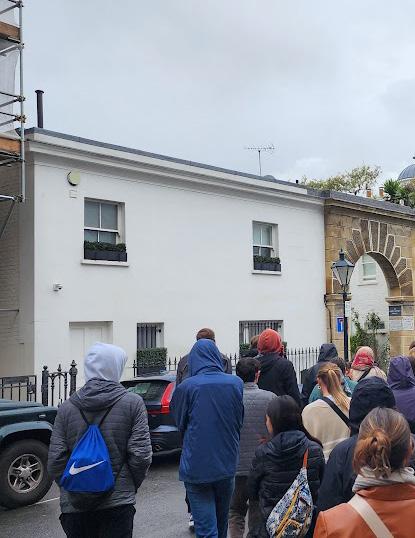
Fitbit overload, packed tube stations, and a questionable plane. All this and more were a part of our transportation journey. You can experience it all firsthand behind the doors of this gallery. But fair warning: possibility of increased heart rate ahead.






I can’t remember when I first heard the term “walkable city,” but I know I didn’t think much of it. I probably didn’t pay any attention to it because I had never actually been in a walkable city, so I didn’t realize how different they were (and how much better they are) from Lawrence, Kansas or any place in the United States I had been before. Like most cities throughout the U.S., Lawrence is a product of car-centered city planning thanks to the National Defense Highway Act of 1956. This act, modeled after Nazi Germany post-WWII, plowed large interstate highways through the United States as a mechanism of preparing for a foreign attack (that never came, might I add). As time moved on from the implementation of that act, suburban life became more attainable and desired resulting in cities becoming less attractive to the wealthy. Soon the upper class moved to the country, leaving the lower classes behind in the cities. Because of this, there was no money nor incentive to improve these once highly populated centers. Emphasis was placed on the suburbs and accommodating for life away from the city. Roads and single-family housing took over “city” planning, and getting from point A to point B as fast as possible - and then faster - was the only thing planners and people of the time cared about. You would think this focus on roads would have led to greater public transport, but that went right out the window with the construction of all the interstates and highways. Human life was entirely centered around and dependent on the car, and industry was no different. It wasn’t realized, or if realized then ignored, by planners that the most efficient way of life was in the center of the city. By the time we realized what we had done to America’s cities, it was too late. Urban fabrics aren’t like etch-a-sketches - you can’t just shake away decades of built roads, interstates, single-family housing, and suburban development and start over. It’s rare to find a city that was originally built to be walkable, but once you do, the difference is night and day. You don’t have to be an urban planner to realize the contrast between a walkable and non-walkable city. There is an obvious difference in the feeling of being in London compared to Lawrence, or really any average American city.
Quoting Google, London is “Immensely walkable”. London was a beautiful example of what happens when people and services are put at the center of urban planning. Hundreds of years later, it’s still extremely apparent how London planners placed emphasis on the existing structures and culture. For example, London’s streets wind and snake through the city. This is evidence of London being laid out to connect places in the city together as opposed to forcing a gridded plan on top of what already existed. Reflecting on my time in London, I am astonished by the number of places and things I was able to see in just one week, and it was all because of London’s walkable urban layout and convenient public transportation. In one day, I was able to visit Buckingham Palace, Big Ben, The National Gallery, Chinatown, and Westminster Cathedral just by walking and taking a couple rides on the Tube and city buses. Not having to rely on a car was almost surreal. Finally, being able to experience a city that makes it convenient to be a pedestrian (unless you’re trying to cross the street) showed me why walkable cities are both amazing and important. Coming back to the copy-paste road-based gridded suburban layout of Lawrence was a big letdown. I am already counting down the days until the next time I can experience the convenience of a consciously designed pedestrian-centered city.
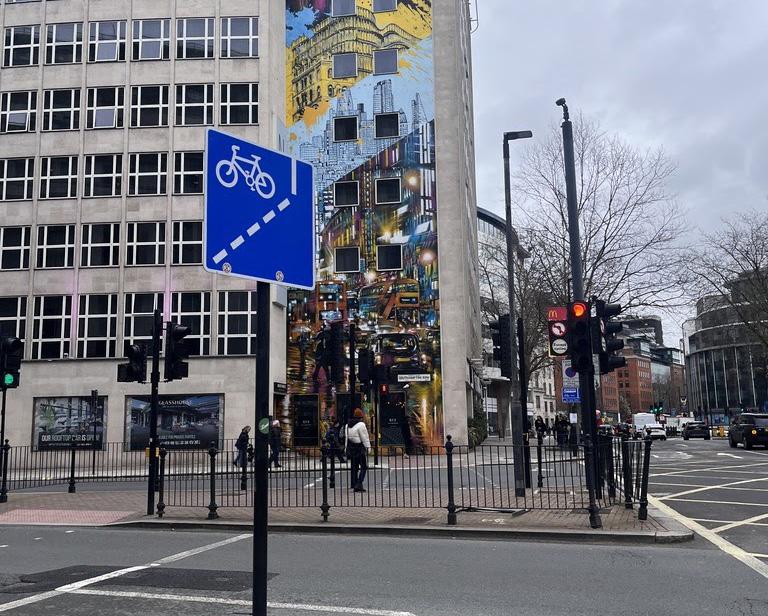
Having transportation, sidewalks, roads, etc. accommodate those with disabilities is important and must be implemented around the world. London is not too far behind with these designs, however, it is important to remember that London is improving and adapting to their current infrastructure while other cities have the space to accommodate those with disabilities.
As someone who works for the City of Lawrence, I noticed quickly that most sidewalks and crosswalks were not accommodating to those in a wheelchair, blind, or deaf. If you are at a crosswalk (not one in a tourist area), there isn’t a sign to show when to cross or not. When you press the button to signal to cross, there isn’t a noise to indicate that the call has been heard or to notify you when to cross. There isn’t a ramp with bumps on it for those who use a cane to let them know that they’re at a crosswalk. Additionally, when crossing across a small road, the slope of the sidewalk is too high that it even feels difficult to walk through.
I can’t imagine how it is for those in a wheelchair. It is important to remember that London is a city, so it is expensive to install those design details at every crosswalk/sidewalk throughout. However, I feel if they do a little every year, it will go a long way.

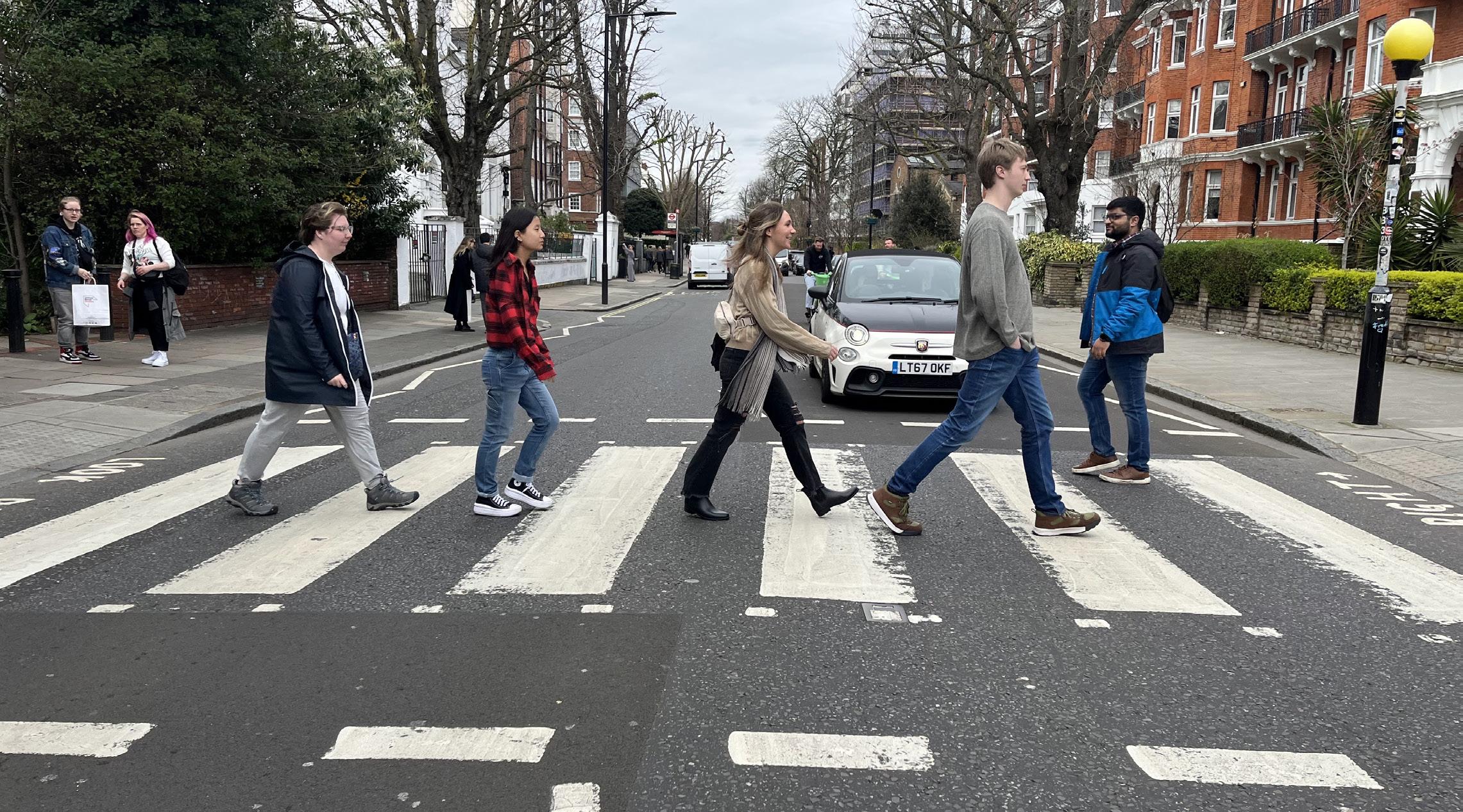
I was absolutely obsessed with the Beatles from age twelve to about sixteen. The amount of time I spent studying their history and committing all their songs (even the bad ones) to memory, I could have had a PhD in Beatlemania. I always knew I wanted to see wanted to see Abbey Road in London, where they walked across a crosswalk in an incredibly mundane fashion that later became one of their most famous album covers. I ventured to Abbey Road twice during my trip in London because I just wanted to absorb the feeling of finally being there. My first trip was a solo one because I wanted to be able to let it all sink in. The famous crossing is in St. John’s Wood, which was the first place in London I saw the sun after being there for nearly five days. It felt symbolic that I should step off the tube and be blinded by the sun the day I checked a site off my Beatles bucket list. (Get the “Here Comes the Sun” reference?)
The first time I saw the crossing, I had to stop and stare. The area didn’t even look remotely like the photo,
which was taken 55 years ago. The street was busy, with cars constantly rushing past the crossing and hoping not to stop for an extensive time while tourists took pictures. When I strode across, I admit it felt like walking across any crosswalk, albeit with more people staring expectantly as if it would change your life and you would arrive on the other side in bellbottoms and rose-tinted wire-rim glasses. It didn’t change my life and I still wore boring, 21st century clothes, but I did feel as if I’d tucked away a loose end in my life.
On the other side of the crossing, there was a white wall where thousands had left their mark with doodles, initials, and love for the Beatles. And behind the white wall was Abbey Road Studios, blocked off from the public by a metal gate. I stared in awe for a few moments. It was a regular, flat-roofed building, but I was so glad that I was finally looking at it, and with the sun beaming down and making me sneeze.
I ventured farther down the sidewalk, rubbernecking the recording studio as I did so, and stumbled across the Abbey Road Studios gift shop. It was tucked away between the studio and a row of townhouses. I ventured in, only to be blasted by “Penny Lane” and so much Beatles merch, I almost dropped into a memorabilia coma. Every type of merch you can imagine: socks, magnets, coffee cups, t-shirts. I claimed a magnet and a tiny rendition of the white Volkswagen bug that was parked in the background of the album cover. I scrutinized the details before buying it, wanting to know how committed the little car was to the real one. The license plate number was the same, and that solidified my decision to buy it. I was glad I had not allowed my fourteen-year-old self to unleash herself in the gift shop. She clanged around in my mind, demanding I let her out so she could spend at least £100 on figurines and band shirts identical to the ones I had at home. After making my purchase, I hurried out and tried not to look back. I felt like I was dragging part of myself from the gift shop kicking and screaming.
On my second visit to the crossing a few days later, I finally got a long-awaited photo of me and three friends walking across in a line like the cover. Of course, it wasn’t just like the cover because there was a car waiting at the crossing for us to get it over with, and a random man passed us on the crosswalk, but it was perfect for me.

Eleanor Rigby
Happiness is a Warm Gun
I’m Only Sleeping
Norwegian Wood
One After 909
While My Guitar Gently Weeps
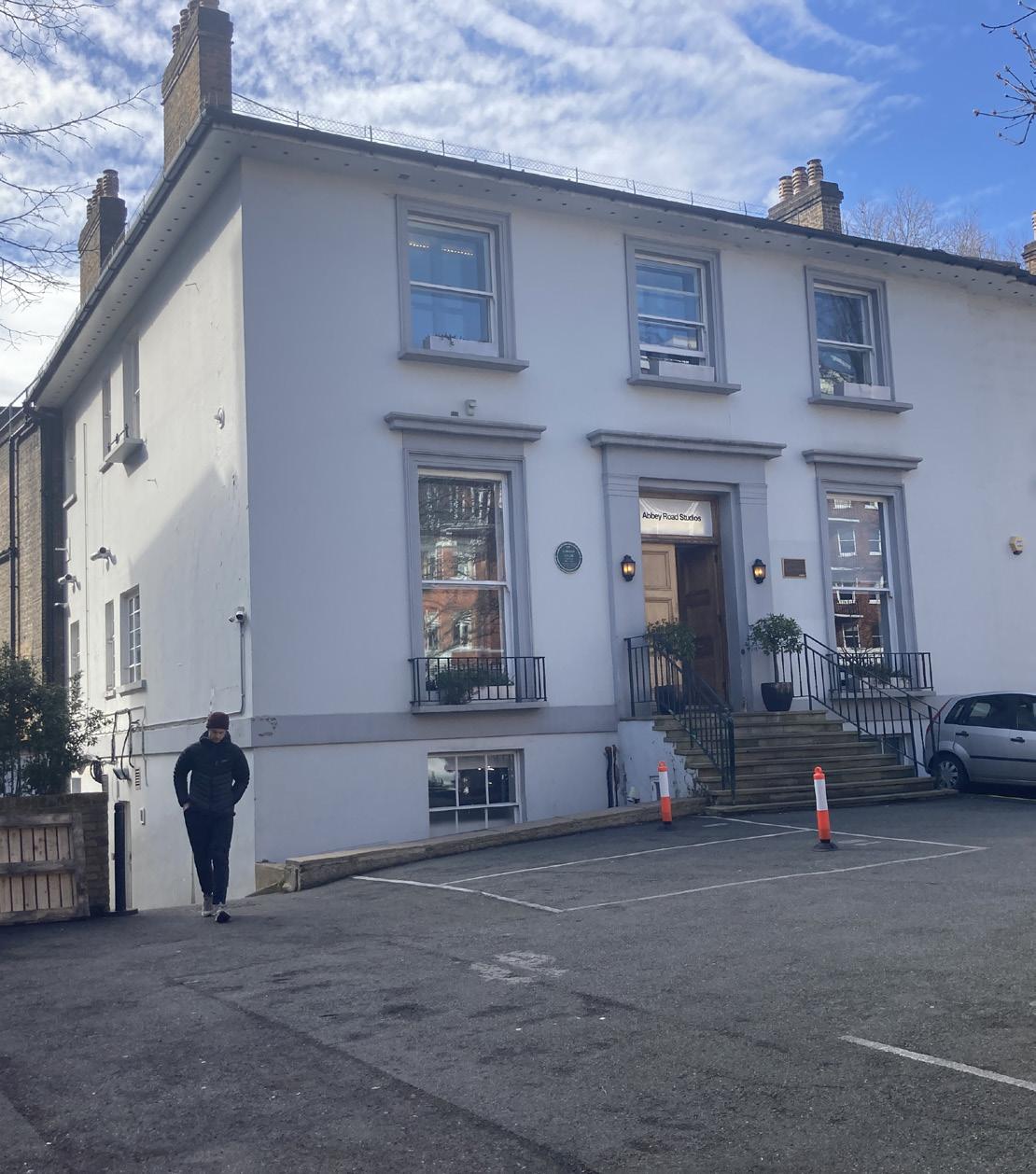
While abroad, a tourist may rightfully be shocked by cultural differences. Sometimes, these differences are expected but still silently gawked at.
“Wow, they really do drink a lot of tea!”
“It really is gloomy on the other side of the pond!”
Other times, these differences may be completely unexpected and might knock a traveler off their high horse they acquired from countless minutes of Google searching, “Does London (fill in the blank)?” I must admit, I was shocked to see a person penny-farthing on a high wheel bicycle.
A first-time traveler like myself may be surprised to find that the simple, ordinary, and often mundane act of walking can vary so much in a different country. This was the first culture shock I faced while in London. Our class had talked about the cultural difference of hospitality between Americans and Native Londoners before our time in London. Correct, we have more to critique about England than our messy history . . . but it’s in the past. Regardless, it is the status quo that London folk do not care for the inorganic platitudes and hyperbolized interactions that Midwestern Americans are often characterized by. I certainly was not prepared for how out of place my Midwest manners would be in London for the seemingly impossible-to-screw-up act of walking on sidewalks and crossing streets. My experience in the Midwest seems like fantasy and fairytale in comparison to my experience walking and commuting in London. I’ve grown up not jaywalking, looking both ways twice before crossing the road, and following the etiquette rules of the Midwest to a tee. Next to “ope!” there is nothing more Midwestern (in my opinion) than the solemn raising of the hand and majestic bowing of the head to a woman driving a minivan as if to say, “Thank you! Thank you, fair lady, for granting me passage in my travels. Blessings upon you and your kin!” I concede, it is hyperbolic.
London commuting culture was different to say the
least. Buttons to cross the street were optional — a side quest even — for locals. They would walk when they decided fit and wouldn’t react to any cars honking their horns (an ordinary sound of everyday London). It seemed as if they had a new application of their famous line, “Mind the gap.” For commuters, they would mind how large the gap was between cars and would cross the street between them without significant regard to how large the gaps were. The right-hand rule also seemed nonexistent in London — people would walk on whichever side they saw fit. Initially, I thought the default manner was to walk on the left and that I was walking wrong. Then I learned that it didn’t matter what side of the sidewalk one walks on.
Truthfully, this realization helped me to overcome some of the anxieties I had about being a tourist. I had always feared sticking out like a sore thumb in London, but seeing everyone doing their own thing and not being concerned at all by what others were doing helped me to reject my social anxiety and embrace the trip.
The native Londoner attitude of non-concern persists strongly throughout the busy region. While locals didn’t care if it wasn’t “their turn” to cross, baristas at coffee shops didn’t greet me with broad smiles and warm welcomes. Servers didn’t say, “Welcome to our fine establishment! I hope we cater to your every need — it is our duty and honor to serve you!”
Frankly, I found the lack of concern, attention, and uniformity to be comforting and empowering throughout the trip. I especially felt this newfound autonomy after the first walk I went on from South Kensington to Chelsea. The tube line, though, was a harder obstacle to overcome. Nevertheless, it ended with the same success and satisfaction that navigating the sidewalks did.
As the Sunday morning walking tour ended, our loud American crowd begin to split off into smaller groups. My group devised a plan to hit the Natural Gallery, China town, Soho, the British Museum, and Big Ben. Despite our already drenched socks and no sign of the rain stopping, we were determined to do it all. Well, almost all of it. By the time the British Museum closed, our feet ached and our social batteries were drained. Even though Big Ben was conveniently in the area, we were done. Someone suggested we rest at the hotel and pay Big Ben a visit later that night. This spontaneous fix to an over-packed day began a tradition.
After dinner and a much-needed change of socks and shoes, we were ready to take on London again. I was a bit nervous because this was my first time trying to figure out the tube system. My compulsive double and triple checking of Google Maps paid off because Big Ben was right at the exit of Westminster Station to greet us. The lights gave him a golden bronze tone and his bright white clocks faced all four directions. Maybe it was the excitement. Maybe it was the sleep deprivation. But there was something whimsical about running around under the blanket of night in a foreign country. Despite a few judgmental looks from locals, inside telephone booths. We continued to walk along the Thames River until the drizzle returned. After that night, I had an affinity for London nights and would wait for sunset every day in anticipation of exploring a new area of the Thames.
 Elena Pacioianu
Elena Pacioianu
Nocturnal London has a special charm. It replaces gloomy daytime skies (the sun probably only showed herself twice the whole week) with popping colors that are reflected by the clouds. Sometimes, it even felt brighter and more alive than during the day. The London Eye glows a neon pink. Spotlights expose every detail of the Tower of London and the teal complexion of the Tower Bridge. Cooperate buildings that usually blend into the overcast sky are illuminated and draw attention to themselves. All these lights and colors gave my group a second wind after long days and drew us out of our afternoon downtime at the hotel. Some of my favorite memories of the trip occurred on these night excursions: the Waterloo graffiti tunnel, getting scammed by an Uber Boat, St. Pancras Square gelato.
We returned to Big Ben on our last night as one final outing before stuffing our suitcases and returning to reality; some hadn’t seen Big Ben yet while others simply wanted to spend more time in the night air. Though brief, it brought our night excursions full circle and reminded me of everything I had learned since the last time I was there. In contrast to the thrilling feeling during our first Big Ben visit, there was a sense of bittersweetness this time. As we descended into the depths of the tube station, I took one final look at the illuminated county hall in an attempt to soak up the last bit of Nocturnal London.
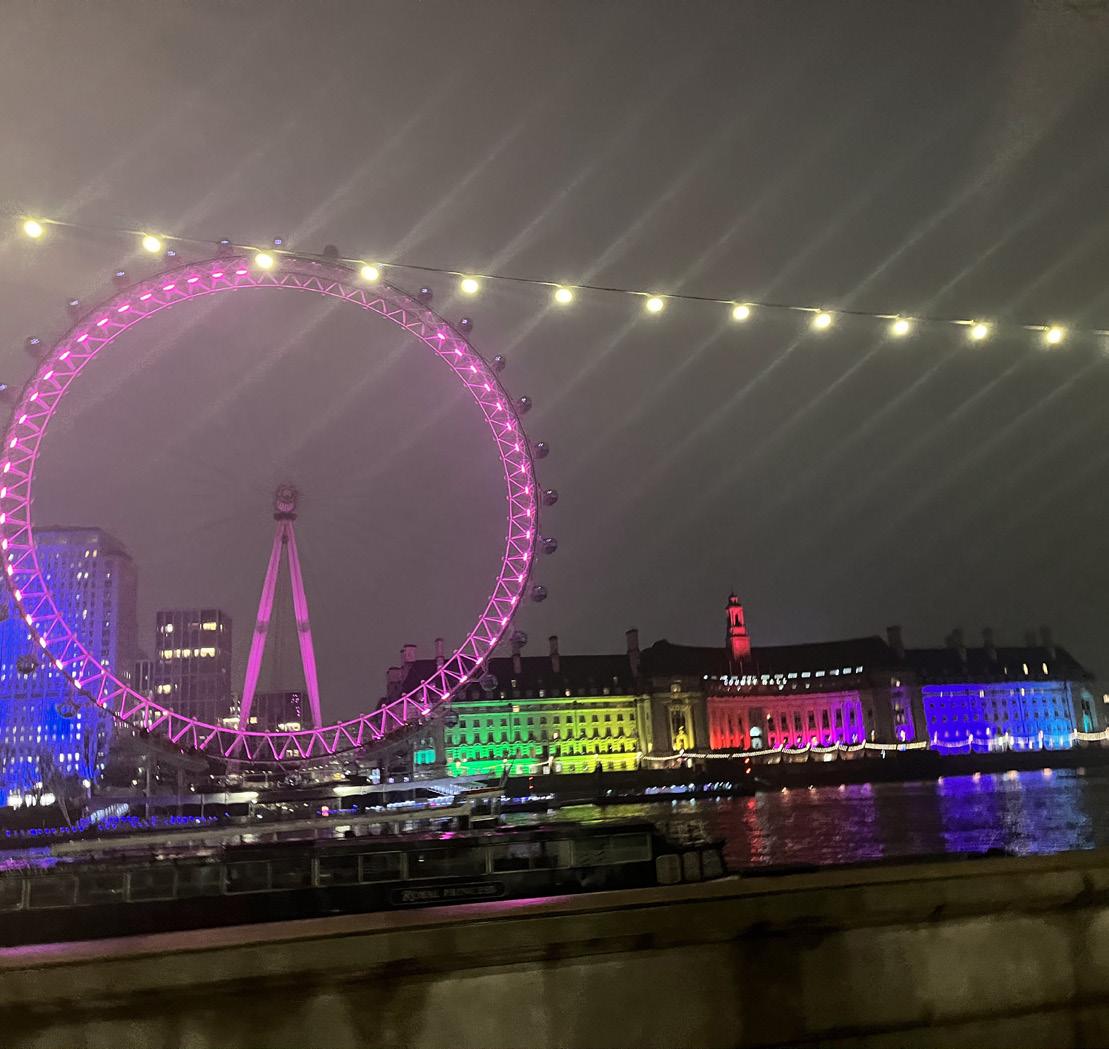

Before I went to London, my dad gave me one piece of advice: “When crossing the street, look right, then left, then right again.” Of course, I didn’t think much of this as there were so many other things to consider and look forward to, especially since it was my first time traveling outside of the country. Throughout my London trip, it was evident that I should have taken his advice to heart. In London, it’s the little things that are so different that you don’t even realize they are different until you almost get hit by a car. My friends and I found ourselves looking to the left first when crossing the street, just like we did in the United States. We would think we were in the clear to not get hit by a car, then a vehicle would come zooming around the right corner. It felt like almost every time we crossed the crosswalk, one of us almost got hit. We would be quick to grab each other’s arms and pull them back when we looked the wrong direction. Pretty soon, I didn’t even know what direction to look when crossing the street. What way should I look in America? Where is the car even coming from? Basically, crossing the crosswalk was
a warzone – a car could be coming from any direction, so I quickly learned to keep my head up in busy parts of London.
I can’t say I’ve ever been the best at directions at any point in my life. I definitely held up Ls on my hands for too long when determining right versus left growing up. Regardless, I knew I had to be very aware of directions when being in an unknown place like London. Thankfully, I had a few friends who were directionally gifted who were able to help navigate the tube, maps, and keep me, a directionally challenged girl, from dying when crossing the street.
A couple days into our trip, we visited Oxford. We strolled around the university campus, looked in shops, and went into cathedrals. Regardless, there were directional struggles. Our phones often had issues connecting to the Wi-Fi, especially when we were walking. My friends and I were trying to go to the oldest pub in Oxford for some fish and chips but were struggling directionally, especially because Google Maps was not our friend. Eventually, we stopped at a campus library and a British man told us how to get there. We made it to the restaurant by attempting to memorize right and left turns and street names.
All throughout our day at Oxford, rumors had been circling that scenes from the Harry Potter movies were filmed there. Although I’ve only seen a few of the Harry Potter movies years ago, I still wanted to see the ground where Harry Potter walked. We arrived at this beautiful, massive church with intricate detailing all around. My eyes were wide as I walked the same path as the actors of this iconic movie. My phone snapped so many pictures of this famous place and as soon as we walked in, my jaw dropped to the floor. “I can’t believe this is where Harry Potter was filmed,” I stated as I walked on monumental ground. I glanced over to the chapel and knew in my heart that the Harry Potter dining room scenes were filmed there. I was astonished. Light burst through the mosaic of glass that covered a giant window, the entire room glowing golden. It was
the most amazing thing I’d ever seen. Sadly, my friends broke the news to me that Harry Potter was filmed in Christ Church College, and we were at the University Church of St. Mary the Virgin. My internal compass had led me astray and we were not where Harry Potter was filmed. We burst into laughter as we realized this mistake. After that, we climbed a tall spiral staircase to the top of the church which looked over all of Oxford from various directions. The confusion, laughs, and directional challenges were all worth it when we saw this elegant view of the city. In Oxford, I learned that I need to rewatch the Harry Potter movies and that I’m a directionally challenged girl. I guess I’ll just have to go back to London someday to test my directional skills again.



Walking disgruntled through the streets of Kensington, the travel fatigue having finally caught up with me, I desperately needed a day of relaxation but felt guilty that I was not using my time more productively. As a compromise, I decided to take a walk to nowhere in particular, it being a rare sunny spring day in the city, blue skies and highs in the sixties- something which made my current dilemma all the more frustrating. Londoners come out like worms ( or maybe the opposite) after the rain ends; they all crawl out of hiding in the earth to soak up the sun for a while. This description has no intent to cast them in a charming light, as I lamented to a friend earlier. In my frustration I had projected a certain discontent onto the city- a hyper-awareness of my position as a foreigner, even in a culture more comparable to my own than some. I had told him, everyone feels guarded here- a big city affliction. Seemingly nobody cares to explain anything to you, but are just waiting to catch you on your mistake. This culture shock manifested in ordinary things most of all.
In my head, London had been described all over (but nowhere in particular) as a “pedestrian city” whatever that meant. Certainly, if it was referring to the occasional blocked-off-to-traffic street or the presence of the tube (not the m-word- metro), such an abstract label may apply. However, I would defer any such designation as many of these trademarks of a pedestrian city are really once commonplace ideas which were previously taken for granted, even in our own society, only to be taken away with the personal automobile. In fact, London proved to be just as frustrating as a pedestrian equally, if not more than any other city I had visited. Nowhere was this paradox more apparent than on the road- motorists are always alert- holding pedestrians to the highest scrutiny at all times (even walking through a completely empty but red pedestrian light will get you honks and dirty looks), yet simultaneously have very little regard or accountability when it comes to yielding towards pedestrians. Native pedestrians themselves seem to adopt this practice on the sidewalks (albeit as a more universal principle). A
group of English students is like a moving roadblock, an “iceberg” as I referred to them once. Best be prepared to awkwardly shuffle out of the way and feel that silent but heavy castigation of everyone around you stand thick and still in the air.
Thankfully, there are a few remedies to this situation. The lowliest consolation is the lack of self-awareness, for example, an elderly couple moving so slowly that all have no choice but to navigate around them (possibly a rite of passage once reaching retirement age in Britain). Or similarly, swarming in massive droves that swallow everyone in your vicinity and forcefully present them with no other option than to slow their pace. However, this strategy seems to only work with schoolchildren (generally socially forgiven or otherwise silently cursed for being a nuisance) or gigantic tour groups (refer again to lack of self-awareness). The most logical/sensible choice is to become a city walker yourself, a mock Londoner, picking your designated path and sticking towards it, though it comes with its own caveat- unless you are in a group that is well rehearsed, dedicated, and/or coordinated (impossible), this maneuver is only possible alone, lest you want to elicit confusion from your group and potential scorn from a more leisurely significant other.
These various pedestrian strategies, or lack thereof, seem to intersect in a uniquely American paradox. After watching my tour group block countless footpaths, roadway entrances, passages, and the like, not even reacting to a poor soul shifting sideways and squeezing haphazardly past them, I came to the conclusion that our society is devoid of some sense of shame (among other things, to come). Personally, as a neurotic and generally reserved individual, I felt that I would easily integrate into the rhythm of English society. Acutely self-aware, and always hesitant to cause any sort of public scene or inconvenience, I considered myself, somewhat proudly, to be at the top of some sort of hierarchical structure, a considerate and rational participant in society, at least in the day-to-day happenings of public life. As a result of never making any
sort of fuss or rocking the boat in any conceivable way, I saved my discontent for cynical comments in my head, looks of displeasure, and if necessary, the occasional long exhale.
Upon having no choice but to become (to some degree) a public nuisance and societal detritus myself, I came to a horrible and shocking realization upon beholding the reactions of London natives: being a cynic, a misanthrope in my home country, a society of generally sociable, spunky, happy-go-lucky types, can be a plausible navigation of social scenarios and a bit rewarding for the ego. But when you’re one of several million in a city in which everyone is a cynic and a misanthrope, you begin to feel a bit tormented- only the shame from being judged with none of the sick pleasure resulting from doing it yourself, plus the sting of illusory individuality being shattered. The sentimental epiphany is that one must not judge so harshly, there’s no hope in conforming to the cruel status quo of another society; it doesn’t feel so good when it happens to YOU, now does it? More pragmatically, on the other hand, changing one’s nature is not such an easy task (plus the sweet ego trip, so no Freud Museum visit for me), so the real lesson is that it’s a lot easier to stand out in your own society, and thus, do your judging there. Here you’re just another stupid inconsiderate American. Some might even say happy-go-lucky.


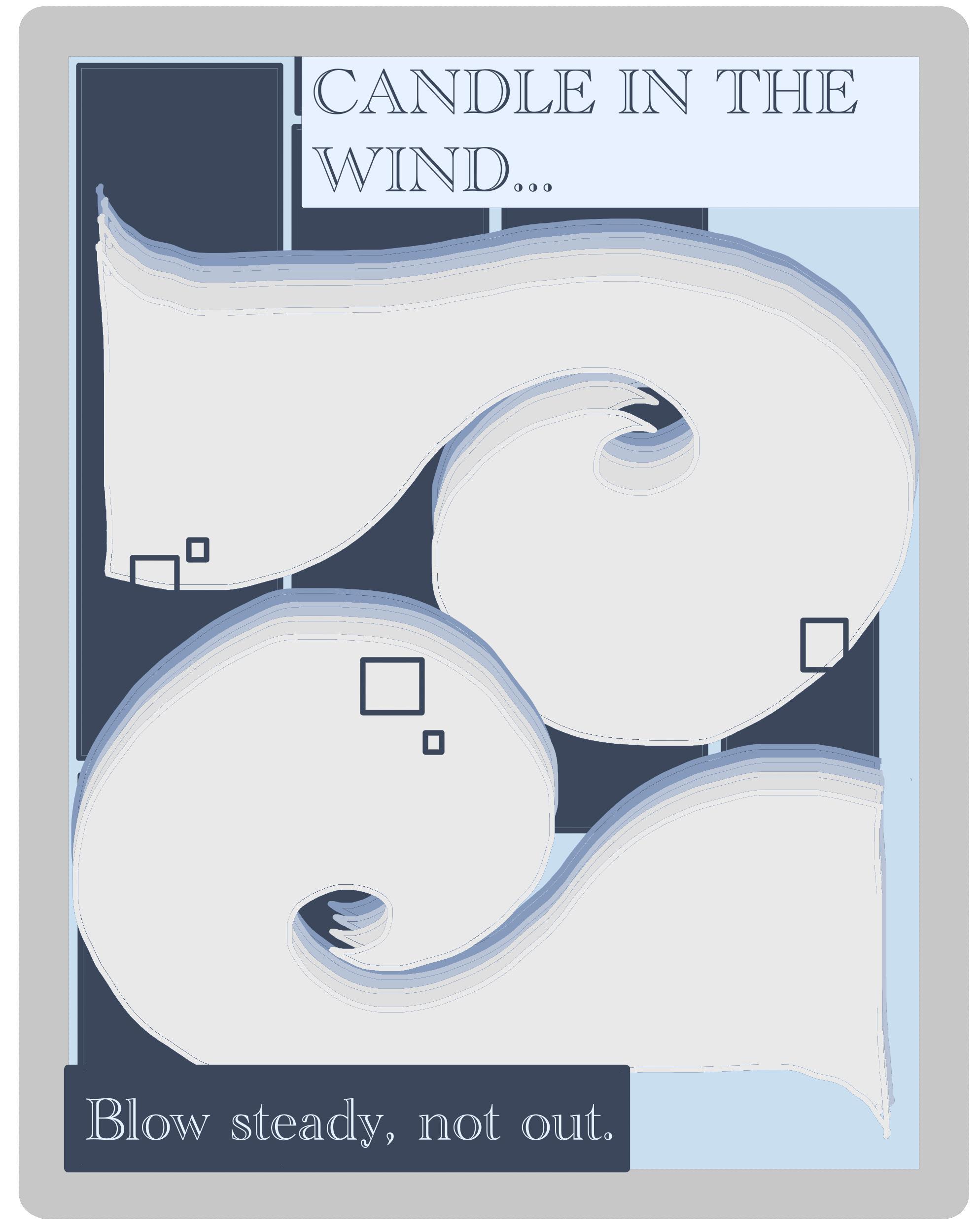
Keeping yourself entertained in London is fairly easy – so much so that you can make an entire day just out of going from place to place, without even needing a destination. By the latter half of the week, many people were starting to reach a limit when it came to museums. They’re all great fun, save for the Natural History Museum (no, I won’t elaborate); but you can only do so many – day in and day out – before the excitement begins to wear off. You start to want new things out of the day – more than anything, you want to sit down. Given all that, a friend and I decided that a great remedy for these issues, while still getting the “London experience,” would be to do some good old-fashioned tube hopping.
The task was simple: get as lost as possible. There are a lot of stops available, even if you stay within the two zones allowed by our Oyster cards – more than enough to quickly stray away from familiarity. In order to confound ourselves as much as possible, each time we got onto a line, we found a new way to decide how many stops we’d go before getting off. For the first, we played rock paper scissors, and counted how many times we tied. The stars aligned for this one, and we ended up eight stops away from our hotel off the bat.
Exiting the Piccadilly line, we followed the signs without rhyme or reason, eventually finding ourselves on the Northern line. By now, we had decided that there should probably be a point to this game, and settled on judging each line and station we take. Some of the criteria were as follows:
For Lines:
Ads:
Cleanliness:
Accessibility:
Name:
Smoothness:
Screeching:
For Stations:
Ads:
Cleanliness:
Accessibility:
Name:
View:
Aesthetic:
By the end of our day, which we nicknamed “Tube Roulette,” we had managed to ride on the majority of London’s lines: Piccadilly, Northern, Bakerloo, Jubilee, Central, Victoria, Circle, and District; and along the way, we got on and off at just as many, if not more stations. Though there are far too many to rate individually, I’d like to share some of the highest ratings we had:
Station Aesthetic: Tottenham Court Road, 9/10
Station Name: King’s Cross at St. Pancras, 10/10
Station View: Edgware Road, 8/10
Line Smoothness: Circle Line, 9/10
Line Ear-Popping (An Exclusive Rating): Victoria Line, 10/10 (for some reason)
Xander Nichols
Coming into this trip, I was nervous. A sentiment that was probably shared by most of my peers. For me, most of that fear stemmed from traveling. I wouldn’t say I have a fear of planes, but it’s more of just not enjoying them. I was really hoping that the two flights there and the two flights back would be smooth, but El Guapo had other plans...
For those who didn’t have to go through the horror and pain of The El Guapo Experience, allow me to explain. El Guapo is a Boeing 727, which usually allows for a little more than 100 hundred passengers with rows consisting of two seats instead of the more common three-seat rows. Additionally, anyone over 5’10 better not dare to step on board, as they wouldn’t have been able to walk normally through the aisle because of how low the ceiling sat. It would be an understatement to describe the plane as small because it felt like we were on a toy plane. Especially when comparing it to what most people imagine planes to look like. I wouldn’t say I’m claustrophobic, but just from walking through the aisle, my palms started sweating before I even sat down in my seat. This was the last thing I wanted, as those anxious nerves came rushing back to me.
After a long delay, we finally began our journey to Chicago. At first, the flight seemed better than I anticipated. My nerves began to calm, and I sat back and listened to The Beatles as I counted down the minutes until we would land in Chicago. Just as I finally started to relax, the plane started to shake. The captain came on the overhead speaker asking for passengers to fasten their seatbelts and alerting us to the fact that the remainder of the flight would be bumpy. Bumpy doesn’t even begin to describe the rest of the flight. It was the worst turbulence I’ve ever experienced in my life. I thought for sure the plane was going to make some sort of crash landing. Surprisingly-or maybe even unsurprisingly based on how unpredictable this flight had been-they still served beverages. The passengers desperately chugged their drinks while they began to fear for their lives.
Thankfully, the hour-and-a-half-long flight turned into an hour-long flight due to the speed of El Guapo. When we finally landed, I was so excited to be released from our confinement that I forgot how small the plane was and stood all the way up, smacking my head on the overhead compartments for all my fellow passengers to see.It wasn’t a graceful hit by any means. It was a loud bonk, so I was approached by
everyone asking if I was ok. When we finally said goodbye to El Guapo, I immediately asked the rest of the group if they thought that the flight was as turbulent as I did. A question to which everyone else in the group agreed with. When asked about The El Guapo Experience, Preston (a member of our group) said, “I’ve been on a lot of flights, but that was by far the most turbulent flight I’ve ever been on”.
The effects of The El Guapo Experience were slightly larger than any of us knew at the time. The Crawford-Parkers (two leaders in our travel party) planned to fly to London two days before the rest of the group left. When attempting to depart from Kansas City, the cargo door on the plane was jammed shut and all passengers had to deboard. The culprit: El Guapo. From there, they had to spend one night in Chicago and another in New York before finally being able to depart for London. This was all because of El Guapo. In the end, this might seem like a hiccup, but it was an experience that brought the group closer together. Many laughs were shared over our hatred of the plane, the myth, the legend: The El Guapo.





“I want to take a picture inside a telephone booth.”
“So go take a picture inside that booth.”
“No... no... I’m too embarrassed.”
Thus, Michael began to point out every telephone booth he saw to Elena. This slowly snowballed into a monster of its own. It turned common objects into things that stood out overtop the London landscape. Whenever one of these ridiculous items popped into view, it became something worth dramatically pointing out to the rest of the group. Methods ranged from pointing, making a funny expression, and lightly tapping each other’s arms. Every day, something new was thrown into the mix.
Things to Dramatically Point Out in London:
1. Telephone booth* - a London classic
2. Horses - appears in appears museums & the mascot of a banking ad
3. Jesus - appears in several museums
4. The Monopoly Man - a launch party for Oxford edition Monopoly
5. The Wellman vitamin ad - a common tube station ad
6. Cone -a pop of color against the grey sidewalk
* Yes, Elena and many others in the group did get a picture in a telephone booth
Elena Pacioianu & Michael KochEaston Logback
I didn’t expect to like London much. I have more gripes with the United Kingdom than I could count. America fought for independence from them. Most of their wealth is built on the backs of exploitation. ‘British food’ is an oxymoron. But for all these complaints, I found my time in London to be quite enjoyable, and I owe it all to one thing: trains.
I would go as far as to say that I loved the London Underground. When I think ‘love,’ I think ‘unconditional.’ Through all the delays, the closures, the overcrowding, my support for the Underground never wavered. I think this is, in part, because the Underground supported me unconditionally in return.
There are, in a literal sense, less conditions when it comes to train-travel. To go somewhere in a car, you need to learn how to drive, get a license, purchase and register a car, all before you can even get to the laborious task of actually driving. With the trains, on the other hand, you just walk to the nearest station, swipe your card, stand around for a couple minutes, and you’re there! That said, it definitely helped that we had pre-paid Oyster swipe-cards as part of the program, and even then, scanning in and scanning out every trip was a bit annoying. So I guess there’s still some work to do.
To me, the bigger factor in this love, and its unconditional nature, is the communal spirit of it all. While American highway travel is heralded as the pinnacle of independence, this notion of complete individual freedom is, paradoxically, not unconditional at all. Car-dependent infrastructure is sold with the promise to let you get yourself anywhere, at any time. But this promise is used by the government as a reason not to provide citizens with any other help getting around, meaning there’s no support. The promise also pits the wills of thousands of drivers, all convinced that the fate of their transportation is under their control, against each other, which only causes frustration when this illusion of control is broken by the realities of traffic, construction, and accidents, meaning it’s not
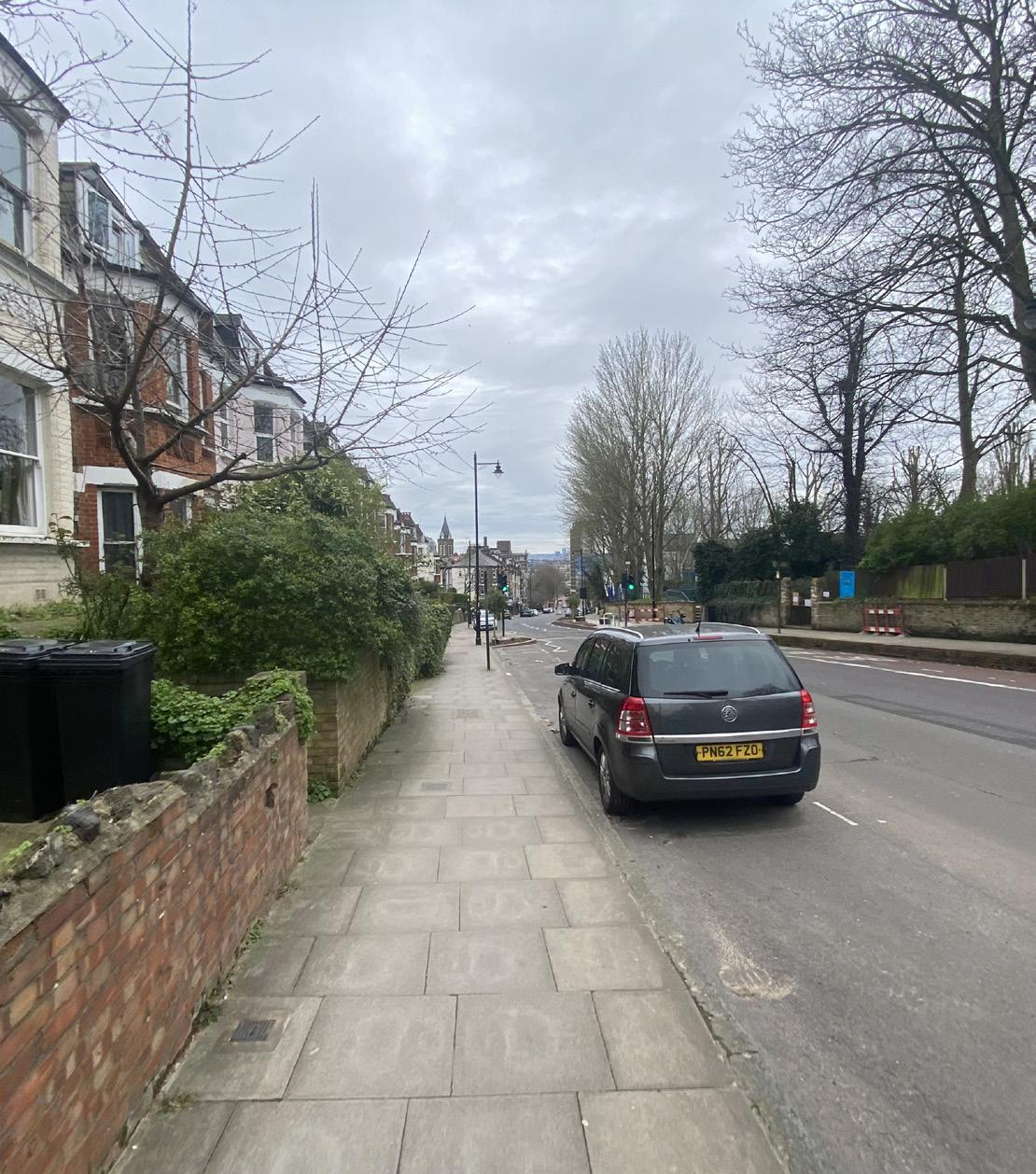
unconditional. This is not love. It’s neglect, and it just leaves Uncle Sam’s kids fighting.
With trains, however, there is a social dimension, reflected in the government support for these transportation networks, as well as in the inevitability of interacting with other people every time you use them. This creates a whole different feeling. First, when some complication happens, it doesn’t generate the same frustration. This is in part because, when you take a train, you have put the destiny of your journey in the hands of the rail service who, even if they don’t get you to your stop on time, are just trying to help. But it also helps that, during any delay, you’re surrounded by other people, also waiting for the delayed train, which helps you to realize you aren’t alone.

Second, though, there’s a sense of togetherness fostered by riding a train. Something about seeing all the others, who are also using a service meant to get them wherever they want, helps you feel for the wishes of the other travelers. There’s an example that stands out as a demonstration of this effect, but it’s a little off-putting, so bear with me. I mentioned my distaste for British food in the introduction. I’d like to think this belief is not totally unfounded, since I spent part of the trip struggling with food poisoning (a detail I never shared with my parents, out of fear that they’d worry about it too much. If you’re reading this now, sorry, Mom).
After meeting an old friend in Oxford, I was taking the train home one evening, when my sickness suddenly reappeared. Before I could stop it, I regrettably (avert your eyes) vomited all over myself and the seat I was in. I expected the other passengers to be disgusted, and they would have had every right to be. But instead, the woman sitting across from me got up, gave me the few tissues she could find and asked if there was anything else she could do to help. The tissues barely made a dent in the mess, but I didn’t care. She had made an attempt to help me, which is all that I needed to turn the situation around.
I imagine if I had vomited on an American airplane or wandered around an American airport covered in my lunch, the reaction would have been quite different. But, in line with the spirit of the trains, everyone I encountered offered nothing but support. This is perhaps why, despite all my (literal) distaste for Britain, the trains still helped me to enjoy my time overseas. It didn’t matter what state I was in, what I liked and didn’t like, what I wanted. The trains, and the people who had been overcome by their communal atmosphere, affirmed these feelings, and assisted me in my response to them, regardless. The trains loved me unconditionally; I love them unconditionally in return.
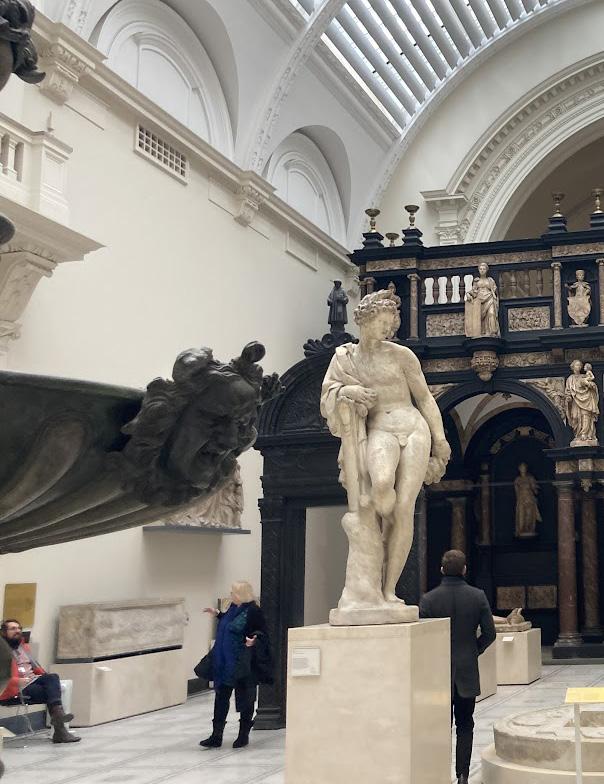
An imaginary kaleidoscope in front of our eyes. Each twist and turn revealing magnificent colors and images we had never seen before. Behind these doors you can put the cultural kaleidoscope up to your own eyes and see it for yourself.


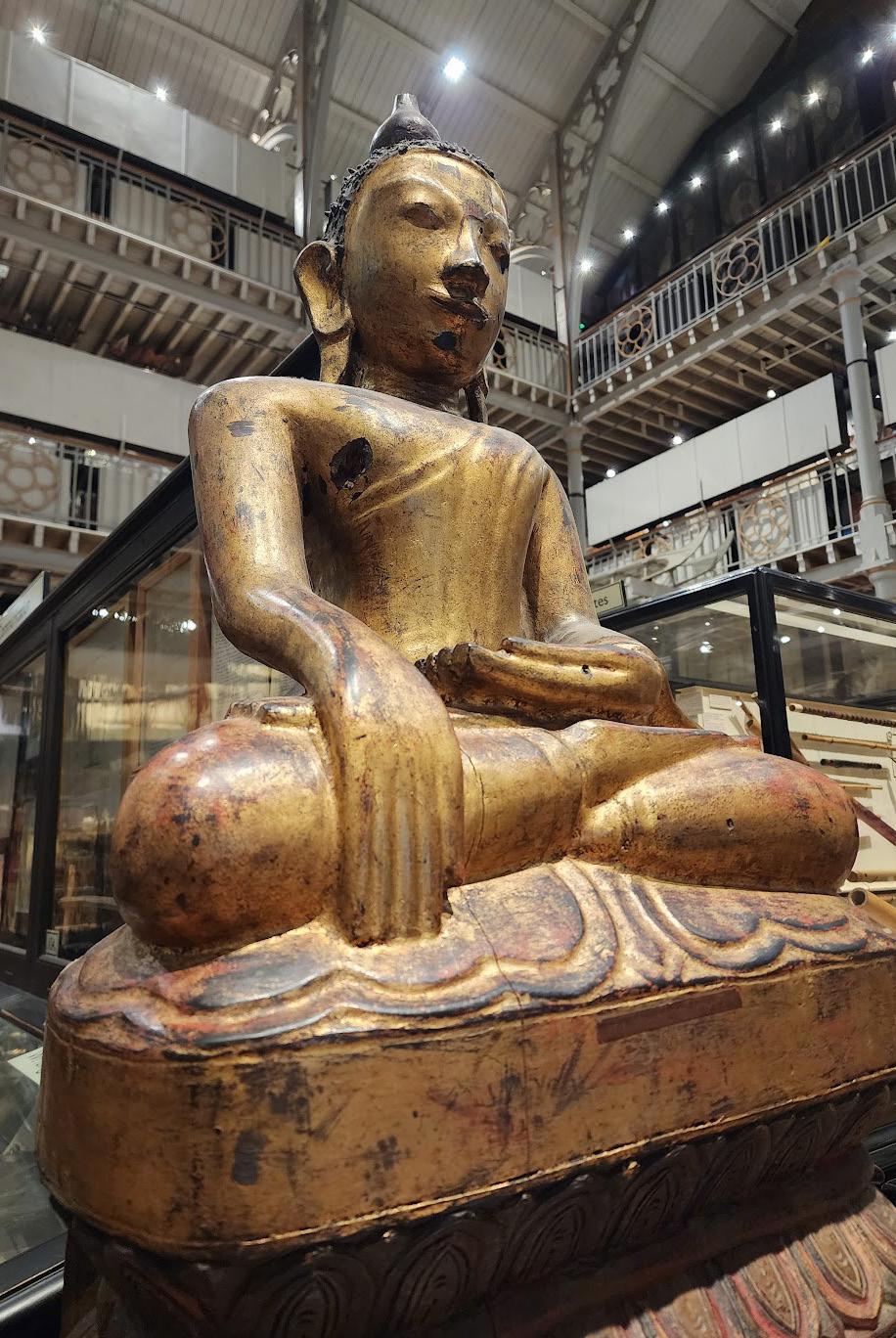



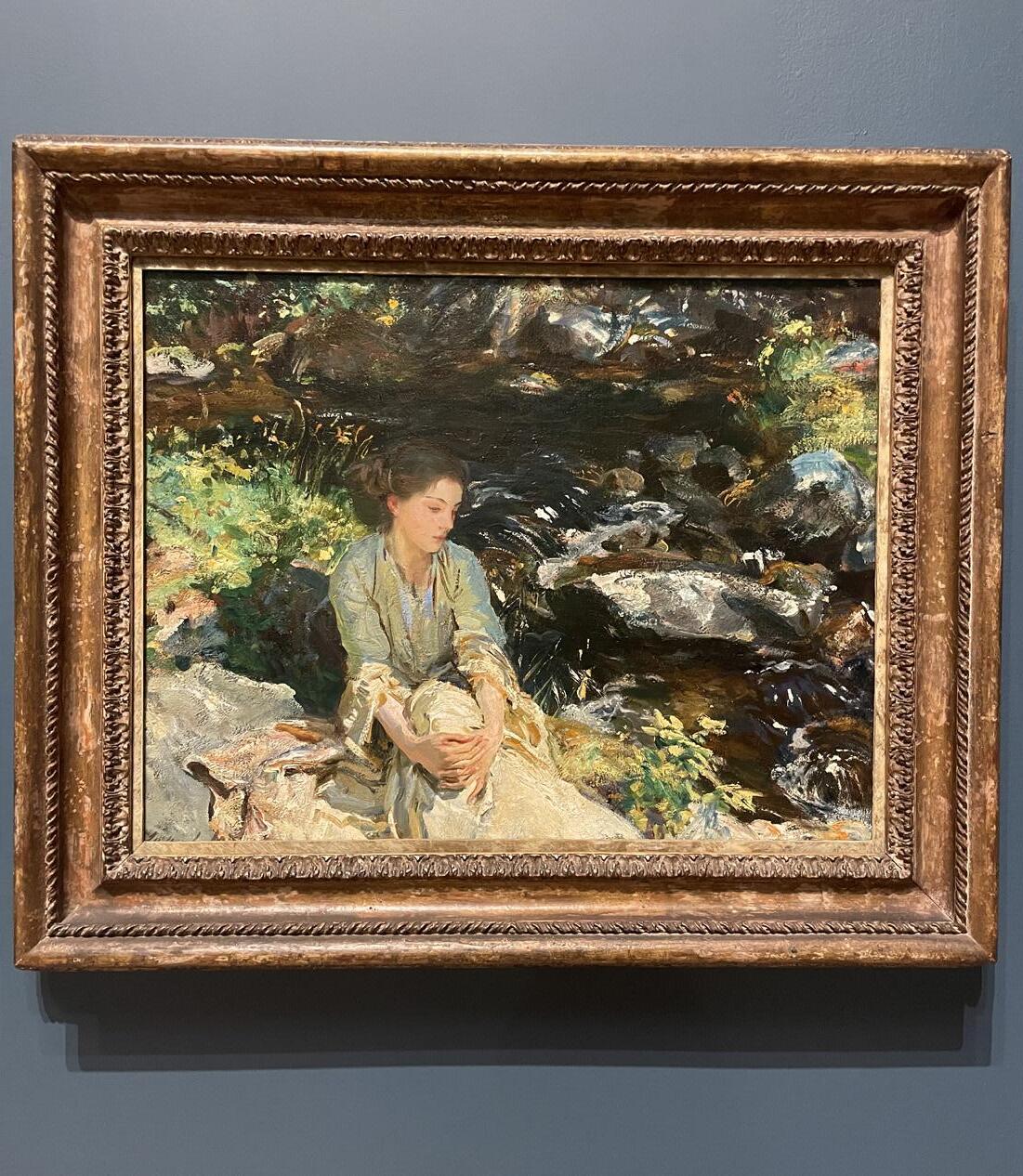
“Behind the cotton wool is hidden a pattern; that we—I mean all human beings—are connected with this; that the whole world is a work of art; that we are parts of the work of art. Hamlet, or a Beethoven quartet is the truth about this vast mass that we call the world. But there is no Shakespeare, there is no Beethoven; certainly, and emphatically there is no God; we are the words; we are the music; we are the thing itself.”
- Virginia WoolfThe idea that art is a luxury is a farce that has harmed several generations of human beings. We hold the idea that knowledge is a power very dearly in our culture today, but what we lack is emotional knowledge; our ability to connect has shifted and begun to struggle to thrive. People feel alone and lost in the world, overwhelmed with thoughts of insecurity and frustrations over the lack of control we have over our fate. What we need most is to relearn the importance of connecting, and not just with each other but with art.
Art is a complex concept as many associate the word with the famous painters of the past, but art is not just a portrait of a rich woman in the 19th century, nor is it just another depiction of biblical stories. Art can be as simple as the first spring flowers blooming and reaching for the sky; art can be a photo of your new friend laughing candidly in a restaurant. Art can be many things, and the pressure that we put on ourselves to think that art must be “perfect” is a disservice to us all. Humans are not perfect; they are ever-changing, ever-evolving, forever aiming to reach this ideal of perfection, but it is not real; it is all a made-up concept to try and make us improve increasingly. We are not meant for this kind of life. We are meant for a life filled with immense joy paired with paralyzing grief, giving back to the earth, and telling our stories of connections, whether it be love or friendship or even a connection with a material object.
Even when we try to go back to our basic instincts of wanting to connect with something greater than us, something that moves your soul so deeply, we are met with an entrance fee. We are divided into groups of people who can afford to connect with art and those who cannot. We do not prioritize our time to be able to enjoy these moments, for they are a distraction from the traditional grind that we all are slowly broken down to follow. We need to have these moments in spaces of reprieve to connect with what we have created and to realize that there is more to life than just money and vacations; it is about living as we are meant to live. Creating diverse types of art to connect us all together into the fabric that is existence.
During my stay in London, I made it a point to visit as many art museums as I could without burning myself out. From sculpture and painting to more geological artifacts, this endeavor was eye-opening through the lens of someone pursuing a WGSS minor. Throughout many of the museums I visited, there was a great lack of female representation that was not entirely based on the hypersexualized feminine figure or materialistic value such as jewelry. As the British Museum is one of the largest collections of historical art, I had higher expectations of what would be held there, hoping, and praying for more representation. However, those expectations quickly dissolved the more I traveled throughout the museum. It reflected the patriarchal biases that already exist and thrive in most modern societies and how strongly these prejudices grip onto capitalistic ideals. Throughout the different cultures and periods, the main pieces of art showcased regarding women had foundations of the great jewelry worn or their physique. The holy statues were the only exception to this philosophy, and even then, they would

Lilia Spiess
be covered in layers and layers of clothing so that the shape of their body could be hidden. During these periods, it is important to note just how little a woman’s worth was seen. Many of these cultures only valued the ability to reproduce and forced them to stay slaves to their husbands for much of their life. Keeping this in mind when viewing the art made their intentions much more visible.
A specific example of this idea of beauty standards and materialism controlling women’s representation in art was small ivory figurines from the ancient Egyptians. They were about the size of a person’s finger, their overall purpose I am not sure of, other than to keep them as a small trinket. The idea behind their creation was, at least from the artist’s perspective, to show the “idealized image of feminine beauty.” While the beauty standards in those times were slightly different, the general idea was rather similar to today’s, emphasizing features specific to femininity. Another example was a small exhibit on “The Queen of Sheba” that was based on a woman from the bible. The story went that she visited Soloman in Jerusalem with a large amount of wealth and immense beauty, acknowledging his god, and then moving along. Supposedly, she also gave birth to his child later and started a royal line that continued to the 20th century. In all of these artifacts, Sheba was portrayed nearly naked, surrounded by riches and other half-naked women. Even women who had power at the time were still sexualized greatly, most likely hurting their image as rulers. Walking through these rooms and exhibits, it was disheartening to see the parallels that this misogynistic art must present-day western society. So many women struggle with their body image, and it is because of media such as this that it stays persistent. Instead of sexualizing the thin-thick ideal and imposing it on women globally, we as a society need to become more body-positive and promote those who do not fit the “standard.” With as much progress that has been made in the past few decades, there is still such a long way to go in terms of activism that can be done; and it can start with museums as big as the British Museum adding more female artists and positive images of women.
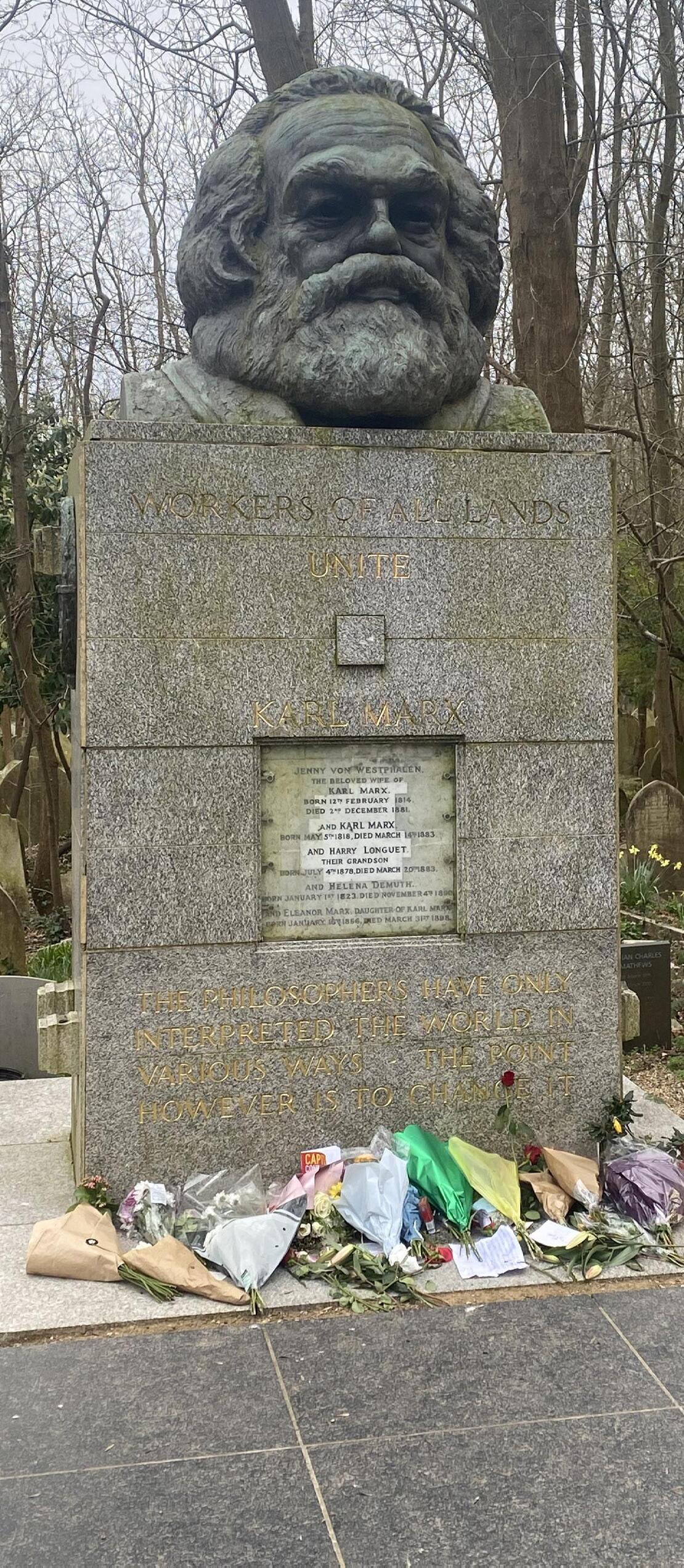
…Symbolic Exchange and Death’,
Jean BaudrillardOur whole technical culture creates an artificial milieu of death.
Death is not something I planned to spend much time thinking about on this trip. But it is rare that someone plans to think about death. Rather, one stumbles across the specter somewhere, anywhere, and is overpowered by its spell. It follows you around, haunts you, never to be extinguished, never to be repressed. You can only hope to come to terms with it. So, that is what I did.
Riveted to his machine, glued to the spot in it, he no longer runs the risk of dying, since he is already dead.
I encountered death in the Churchill War Rooms. The underground office, half-headquarters and half-bunker, from which the prime minister directed the Second World War, perfectly preserved, frozen in time. Of course, any remnant of World War II has death stained
all over it. But two relics in particular caught my attention. First, a static-speckled recording of a Churchill speech, claiming that the people of London would rather die in the air raids than surrender to German forces. Second, a table, a neat grid, filled in with red numbers---‘51’, the one I recall---which marked daily civilian casualties.
Even our bodies, which have become biological machinery, are ordered on the inorganic body, and therefore become, at the same time, a bad object, condemned to disease, accident and death.
I’m not sure why these representations had such a hold on me. I had come to terms with death before. For I had determined, some time ago, that insofar as the risk of death is omnipresent, I could not orient myself towards avoidance. Instead, I acknowledged, in all that I did, the potential of death as an outcome, one potential among others, all of which were affirmed. This line of reasoning had always worked to ease my mind.
The problem: it was this same willingness to die for a cause appeared in Churchill’s announcement---the announcement that left me with an unsettling feeling, the willingness that allowed the dead to be shrugged off as numbers on the wall. How could I be right, I asked, and he be wrong? Worse still, I wondered, could we be different at all?
Is it so that men might live that the demand for death must be exhausted? No, but in order that they die only the death the system authorizes.
I couldn’t shake these doubts, as much as I tried. Our last day in London arrived; I went for a walk to clear my head. I walked around Highgate Cemetery. For someone struggling with the thought of death, I found the graveyard quite comforting. The weather was nice. The music that shuffle graced me with fit the mood. The inscriptions on the tombstones lining the path were not mournful, but instead celebrated the various lives that wandered into this archive. The main attraction, Marx’s grave, was stunning. Flowers and books rested at the base of the marble block, a quote of his etched into it. “The philosophers have only interpreted the world in various ways. The point, however, is to change it”.
It is necessary to rob everyone of the last possibility of giving themselves their own death as the last ‘great escape’ from a life laid down by the system.
A new specter overcame me. I stood still, letting the movements of the moment---the cries of the song in my ears, the kiss of the gentle breeze, the intensity of the statue’s gaze---flow through me. Change. That was the secret. The power of ambivalence towards death is the change it enables. Potentialities, otherwise locked behind the threat of or surrounded with unpleasant anxiousness toward the end, now waiting on the table. Reflected in the graveyard, where the memorialization of death coincided with an affirmation of a unique life. Acceptance of death opens up a radical freedom. But Churchill’s embrace of death is surrounded, on either
Easton Logbackside, with paragraphs of war plans, demands for aid, rations, sacrifice. He guides us not towards infinite potentialities, but funnels us back into a single system, the British war effort. People are not celebrated as irreducible differences, as in Highgate, but limited to an undifferentiated individual, a part of a machine, a number on the wall. Folded into the symbolic exchange.
As long as the exploited retain the choice of life and death through this small resistance to security and the moral order, they win on their own, symbolic ground.
Just as the fear of death locks us on the path of joyless persistence, Churchill has locked us on the path of joyless patriotism. He has not freed us from our symbolic overdetermination. He has only given us a new symbol to be reduced to. But we have already discovered the method to rupture the fear of death, to reject the dilution of life to mere survival, that being to affirm the death that is cast aside. We could do the same to Churchill: affirm the countless distinct productions of life that are exterior to the British state’s prescription.
This is all we can do. To fight for death against life; to fight for life against death. To affirm the potentialities that have been coded out. To rupture the symbolic exchange. To take a walk through the cemetery. To stand before the marble monument, and to echo its call.

Fatima Asif
London is home to over 150 museums ranging from prominent institutions like the British Museum to lesser-known ones like the Museum of the Home. Unsurprisingly, most of these spaces are built upon and entrenched in Britain’s imperial history: from the Maqdala royal artifacts at the Victoria and Albert Museum (V&A) to the Parthenon marbles in the British Museum, London is home to hundreds of thousands of treasures stolen (or acquired under problematic circumstances) during the British Empire’s imperial conquests around the globe. The legacy of these spaces—and their mammoth collections—was a glaring reminder in every museum that I visited, particularly the V&A.
The V&A markets itself as “a world of creativity in the heart of London.” After checking its website (I confess, rather hurriedly on my way there), I looked forward to seeing exhibits geared toward contemporary fashion and design. But when I walked through the “Tunnel Entrance” of the museum, I found myself in its vast South Asian collections. I wandered through rooms containing paintings and attires from the Mughal era in the South Asia section, followed by carpets, pottery, tiles, and religious artifacts in the Islamic Middle East collection; looking back, I realize that I spent more than fifty minutes in just these two sections of the museum alone. Every single artifact was intriguing, ranging from the collection of illustrated Persian poetry and Mughal royalty’s cutlery studded with precious gems to the intricately detailed minbar (pulpit) from an Egyptian mosque and turquoise tilework from Iran. Yet—just like at the British Museum—every artifact made me pause and wonder how it ended up at the V&A. Was it pillaged after some imperial conquest or war? “Acquired” by some British colonist? “Purchased” by the museum or a past curator? Although the V&A’s website is transparent about the “historical context” of their collections, this essential background is not mentioned in most artifact labels on display—or at least not in the two collections that I visited.
My experience at the V&A (as well as the British Museum) can only be described as conflicting.
It was fascinating to see these centuries-old relics from around the world; yet it was also distressing to consider the somewhat unapologetic display of the Empire’s power on view in its curation of thousands of objects taken from past colonies. Personally, spaces like the V&A make me wonder if they can ever be considered through a postcolonial lens when peoples/nations that these artifacts belong to have been divested of their national and historic relics for years.

One of the main reasons I chose to be a part of the London Review was to experience the historical significance the city had for my ancestors in South Asia, but from the opposite perspective. I grew up hearing stories of the sacrifices made, the battles fought, and the families torn apart in the 200 year-long movement for Pakistan and India’s independence from the British Empire. For this reason, I had my reservations about the capital city of an empire that did so much harm to my heritage land. As it turns out, today’s London is vastly different from the London my ancestors spoke of. It’s a bustling cosmopolitan, influenced by the very countries it used to control. Despite this change, the city still has received criticism on the ethics of museums and archives under the excuse of protection. I found myself struggling to interpret this as admiration for my culture or an assumption that South Asians cannot represent their own culture correctly.
A crushing guilt fell on me when I thought of how the artifacts in Victoria and Albert Museum were acquired. I didn’t know if I should appreciate the tapestries and manuscripts covering the walls or grieve for the empty walls of the mosques and palaces in the city they were taken from. It didn’t feel right to advocate for the former colonies’ right to own their own history while directly benefiting from the forceful congregation of my people’s history.
And yet, I will never forget how connected I felt to my roots at the V&A. Entire wardrobes displayed what my ancestors used to wear, manuscripts depicted how they socialized, and artwork and furniture illustrated their understanding of beauty. I read some of the Persian and Urdu manuscripts aloud, understanding the gist of each page before confirming with the exhibit plaques. This turned into a game with my friends to see how accurately I could summarize the literature. The experience humanized my ancestors and allowed me to appreciate my roots on a whole new level. Former colonies like Pakistan and India deserve to have their claims on their pieces of history validated. However, this doesn’t have to mean they can’t be shared between nations for all to appreciate.
Hamdan TariqMoreover, my friends and I had lunch at Dishoom, a popular Indian restaurant in Kensington. I fully expected the place to be full of South Asian patrons, like Pakistani/Indian restaurants in the US. Instead, it was packed with appreciative Londoners of all backgrounds enjoying the music, art, and taste of South Asian culture. There had to be a catch, I thought- perhaps a whitewashed, westernized menu. I was ecstatic to see so many of my favorite dishes with complicated recipes, and even more delighted to see people ordering them.
Day by day, South Asian culture not only grows in influence in the city, but in appreciation. Although London and I share a complicated history and have plenty more work to do, I am grateful to see how far the city has come in the wake of globalization.
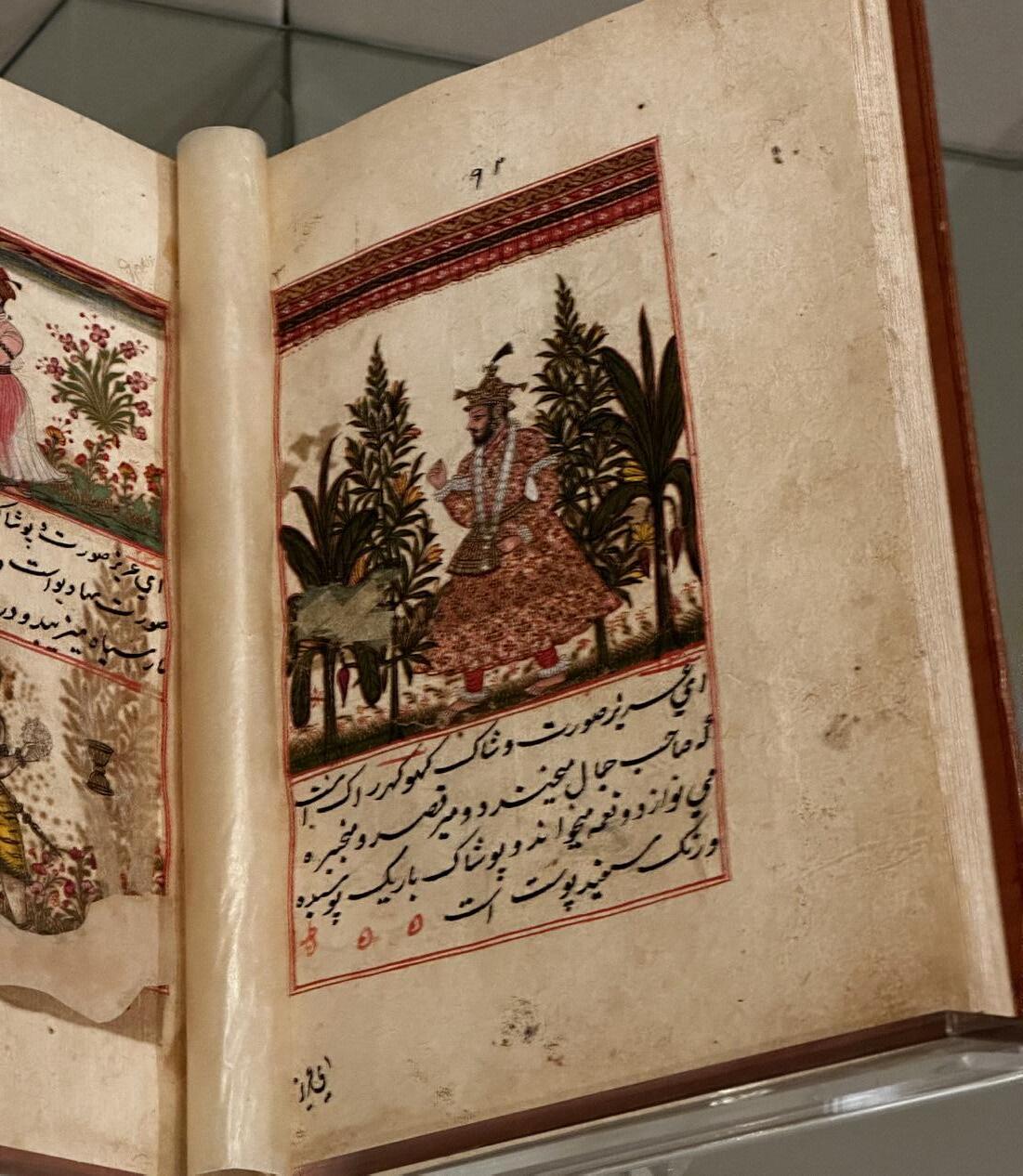

In the early 19th century, the English Lord Elgin made a trip to Athens, Greece, where he appropriated many Grecian statues from the acropolis. One of these statues was a part of a set of caryatids which held up the entablature of the temple Erechtheion. Caryatids are pillars carved to look like Greek maidens and come in matching sets. In the Erechtheion’s case, there were six; five still live in the Acropolis Museum in their hometown of Athens, but the sixth, thanks to Lord Elgin, is on display in the British Museum. It would be inaccurate to say he stole them, as he got permission from the ruling force of the time, but one should note that this force was not the Greeks, but rather the Ottomans. Despite repeated attempts by the Greek government to reclaim this historic landmark, along with the Parthenon marbles, the British Museum has remained firm in their ownership of the works, claiming on their website that “The Acropolis Museum allows the Parthenon sculptures that are in Athens (about half of what survives from the ancient world) to be appreciated against the backdrop of Athenian history. The Parthenon sculptures in
London are an important representation of ancient Athenian civilization in the context of world history.”1
My own experience with the caryatids began in the fall of 2021 when I took HA 150, the beginning art history course at the University of Kansas. In this course, we looked at these sculptures and discussed the moral obligation and dilemma of repatriation. Immediately, I was fascinated by these women and their story. Then, in the summer of 2022 I was given the remarkable opportunity of visiting Athens and saw the caryatids that live there. My awe at the historical and artistic importance of these figures was undercut by the empty space reserved for their lost sister. So, when the opportunity came this year to visit London, the top of my list was to reunite these sisters in my memory.
In order to access the room she is stored in, you must walk past the imposing Nereid Monument, already setting a tone that reminds you none of these works were intended to be here. In a room smaller than I had been
in thus far at the museum, I finally located her. My very first impression was a man, clearly a tourist, imposing himself in her space to take a picture. While there was nothing inherently wrong with posing for a picture by her side, there was something about it that felt irreverent. I stood in front of her for a while and watched as group after group came in, posed for a photo, and left. Some people I could tell understood the story of this figure and some would walk right past without a second glance. Admittedly, I took my own picture of her, but in as respectful a way as possible. There are no people, little work done by angles to make her look more dramatic, I wanted to represent her as she is and deserves to be seen.
I couldn’t help but think of my own sisters. I am the youngest of four, and the only boy, so growing up I was always sort of the odd one out. Then year after year I watched as each of my sisters graduated high school, then college, and moved on with their lives while I was left behind. Today, my family is spread across the country: one sister in New York, one in Denver, and one in Kansas City, so we only get together a couple of times a year and that makes those moments so much more special. Even though growing up I was always the odd one out, I have noticed in recent years as I grow older, and hopefully less annoying, that our bond has taken a new shape. One of mutual understanding, support and encouragement, I cannot stress enough how much I rely on my sisters for strength when life seems too scary.
This Erechtheion sister has no support system, other than her fellow captives, and even though she is sculpted to be strong and sturdy, I think that loneliness must be an incredibly heavy burden to bear.


Sir John Soane’s Museum is one of many hidden gems tucked away throughout the streets of London. Made up of three separate houses Soane bought over 31 years, the museum sticks out like a sore thumb...but in an elegant way. The buildings look nothing like the other houses on the street. The tall, gray brick structure creates a looming backdrop and exudes a sense of mystery; an anonymous canvas for the treasures inside. However, the bright white facade that fronts the house is a juxtaposition against the lackluster backdrop; a contrast that makes it seem as if you are entering a modern-day temple. The houses showcase Soane’s ability and are one of his last legacies as one of Britain’s greatest architects.
When I first learned about this museum, I pictured a house crammed with random, worldly objects. The efforts of another rich man who benefitted from the “empire,” and a messy hoard of artifacts shoved into cramped hallways. In other words, a hoarder. While John Soane did benefit from the British empire and its massive hold over the world, his collection was far from aimless and unorganized. (However, if you want to experience something hoarder-like, you can head on over to the Pitt Rivers Museum in Oxford).
Looking back on this trip, this was my favorite museum I visited. From exploring the kitchens, to the crypt, to the study, the museum provides not just an opportunity to look at historical objects, but to see Soane’s passion and precision when it comes to his collection. It was evident Soane’s was passionate about his work, his home, and his museum. But you know who else was passionate about these same things? The museum volunteers. As some of the most friendly, helpful, and beyond all, knowledgeable people, these volunteers could have told me what time Soane got up to use the loo each morning.
One of the most special moments during my time at the museum was when I found myself in the same room as a personal tour. During this sneak peek into the premium treatment, the tour guide showcased Soane’s ingenuity as an architect and designer. In what is formally known as “The Picture Room,” Soane designed the walls to act as functioning cupboard-like
Ben Flynndoors. This means that the walls can unlatch, and a new set of paintings can be shown to viewers. However, this can be done not once, but two times, transforming the room into a triple-gallery. Words now do not do it justice, which is why I recommend everyone go to this museum and see it for themselves (even if it costs a bit extra for a personal tour).
However, what makes John Soane’s Museum so special is its ability to transport you back in time. The house is a living mummy. Preserved to look like how it was 180 years ago at the time of Soane’s death, it complements the crown jewel of Soane’s collection –the sarcophagus in the basement. However, what also made Soane’s Museum special was the wide range of periods and objects that he managed to showcase, including Ancient Egyptian, Roman, Greek, and paintings from the 16th century.
As an outsider looking in, it appeared that John Soane was not just a man who collected because he could, but because it was something that he genuinely enjoyed doing. While his success as an architect gave him the means to purchase the pieces in his museum, his passion for history is evident in every step you take through his former home. Every single artifact had its own place in the museum. They were at home, and honestly, I felt like I was too. Well... I guess that is what happens when you make a museum in a house. My last piece of advice is as follows: if you ever visit, buy the guidebook. It is only £3, and it is worth it.
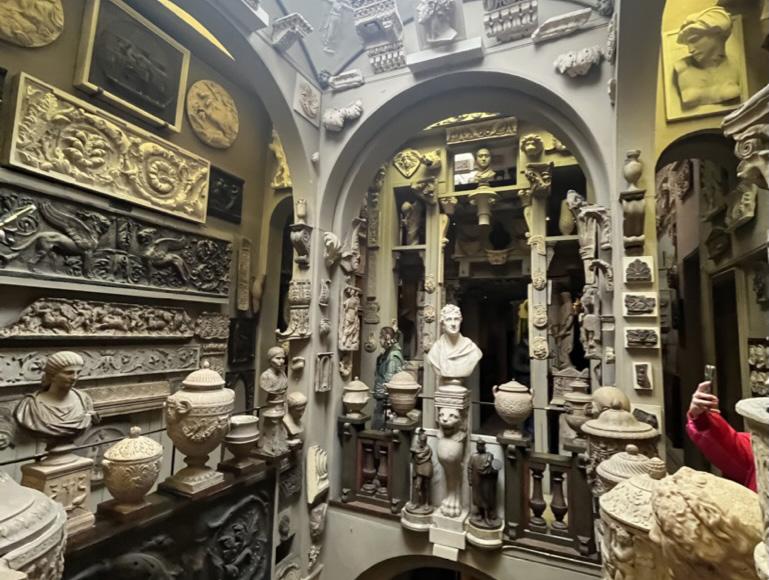





Coco Chanel, a French fashion designer and creator of the luxury brand Chanel, once stated, “The best things in life are free. The second best are very expensive.” Coco Chanel’s statement could not be truer regarding the fashion in London. Experiences that I had, such as strolling down the streets of London and observing every person dressed in a chic, long coat, browsing the markets, window shopping in the luxury stores, and guessing prices of the most exotic items we could find in the stores, were all free experiences regarding London fashion. Sometimes, my friends and I would people-watch as everyone hurried through the city and guess if people were from London or not, solely based on their fashion.
To live and dress in London requires a particular style and financial status. I will never forget the first day that I arrived in London. We decided to walk the streets of London before heading to our first dinner. Almost every person on the streets in Kensington appeared confident and elegant with their unique style. It was quickly
evident that people from London did not walk around in athletic leggings and a college sweatshirt like in America, but instead presented themselves in a more formal way. We walked into Harrods, a giant department store in London with over 3,000 designer brands of everything you could ever want. I gazed at a beautiful purse only to learn that it was over $1,000. Throughout my London trip, I was fascinated with the chic fashion of the locals and how they effortlessly looked like Zara models, even just going to the grocery store. I could not help but wonder why European fashion was so different from American fashion.
Not to my surprise, I learned that “London is a major player in the fashion industry and has rightfully earned its place as one of the most important iconic fashion capitals in the world,” according to Biddle Sawyer Silks. In medieval times, London fashion did not compete with Paris and Rome, but London was still heavily involved with cultural exchange. London began to thrive through obtaining wool, silk, fur, embroideries, and other luxury items. This created a great societal divide between the rich and poor since the rich people could afford these luxury items. As more luxury items were produced and Parliament was established, wealthy and prestigious people fled to London. London housed royalty in palaces, drawing more craftsmen to produce high- quality goods and clothes creating a distinct “English” style.
Fashion evolved in the eighteenth century when silk embroidery, large wigs, extravagant dresses, and long coats became more popular. Fashion mimicked the English royalty as corsets, gowns, and tailored outfits were present in balls, theaters, and courts, showing off London’s booming society. Throughout the nineteenth century, women’s fashion emphasized a natural figure with puffed sleeves. London’s markets became more popular selling high-end items.
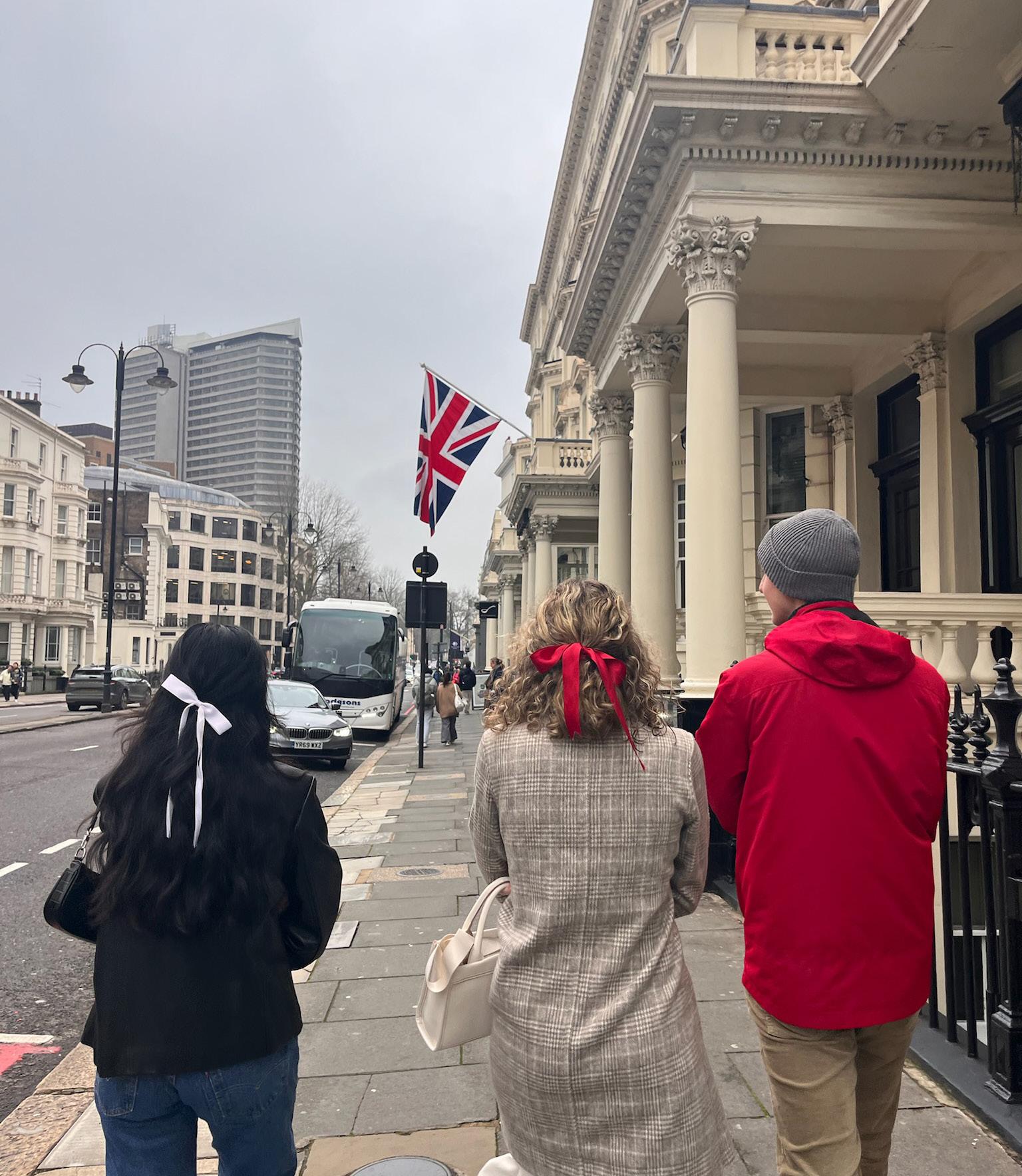
During World War II, women dressed more casual in trousers because resources for fabrics were short. Women also gained more influence as they began to express themselves through more unique long skirts. Since 1984, London has held a fashion week debuting trends that are extremely “fashion-forward.”
I am so thankful that I got the opportunity to experience a new culture in London. I noticed how fashion and the way people presented themselves in London was very elegant and chic. Each day in London, I adored walking down the street and seeing the unique fashion of the locals. When I got home, I was inspired to learn more about the history of London fashion and why it was significant. London continues to have an influential role in the fashion world, ultimately becoming a city with fashion to fancy.
• Custom made belt
• Scarf
• Gold ring
• Black long coat
• Graphic tee
• Oxford Tote Bag
• Vintage denim short jacket
• Matching oxford sweatshirts
• Spiked coat
• Button up
• Burberry wallet
• Kilt
• Spitalfields bandana
• Handknit Strawberry Cardigan
• A scarf from Mary’s favorite scarf vendor
• Perfume

Fish and chips. Tea and biscuits. The best chocolate-covered strawberries in the world. Hopefully all this food isn’t making you hungry. Behind the doors of this gallery, experience the mouthwatering recounts of all the magnificent food we enjoyed.


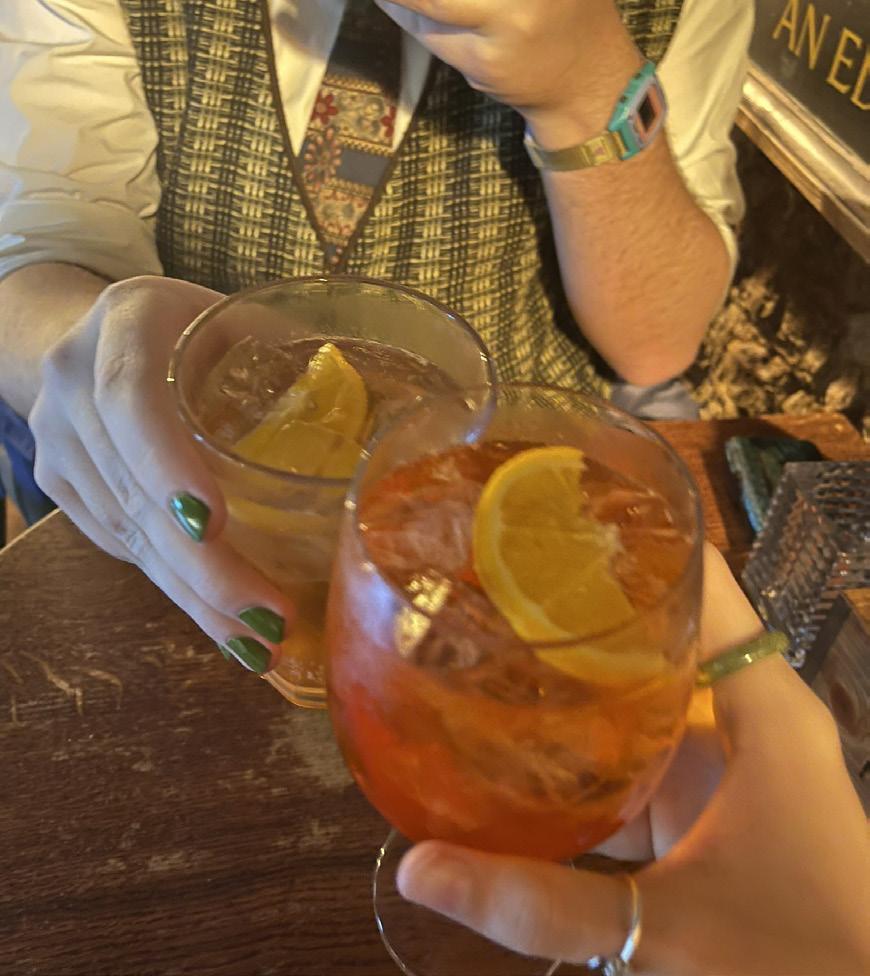

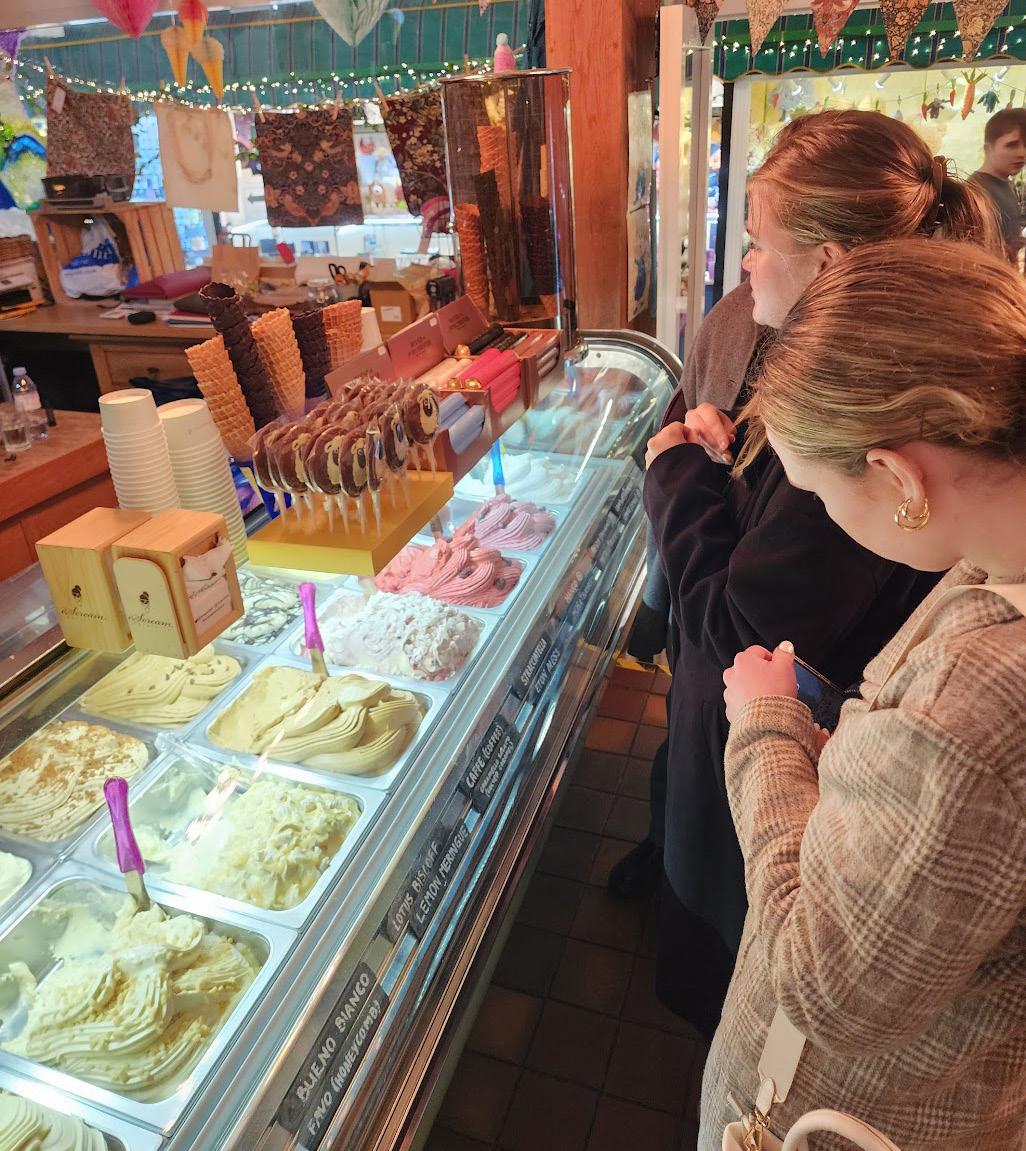
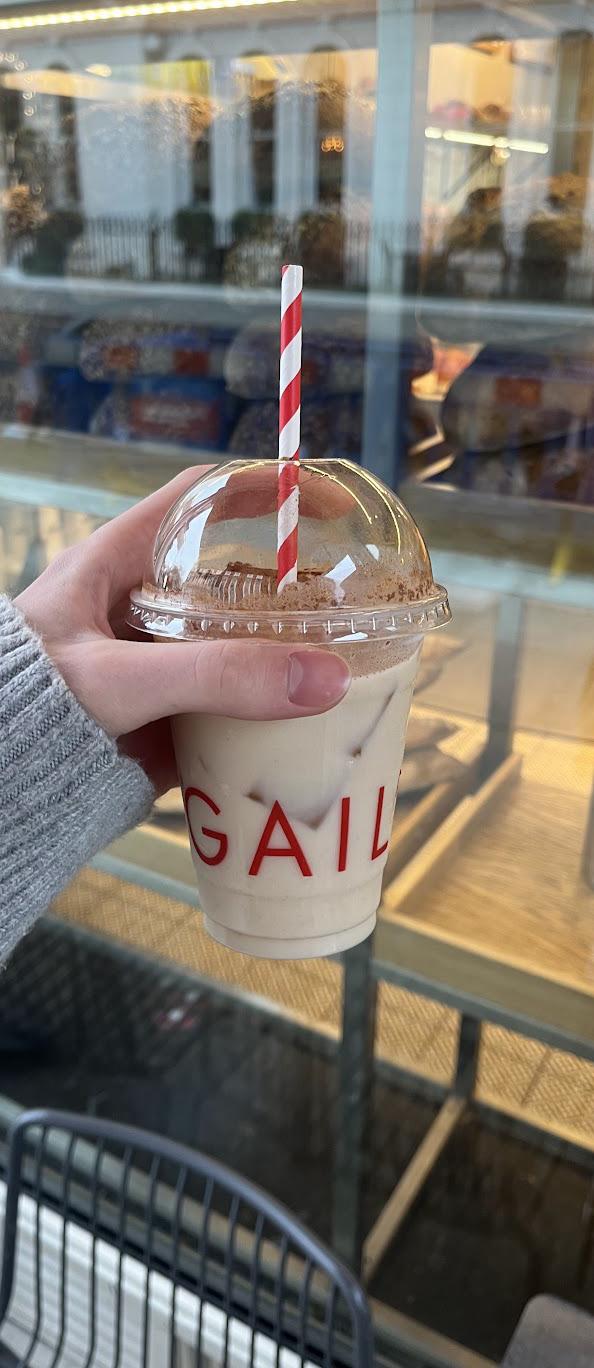

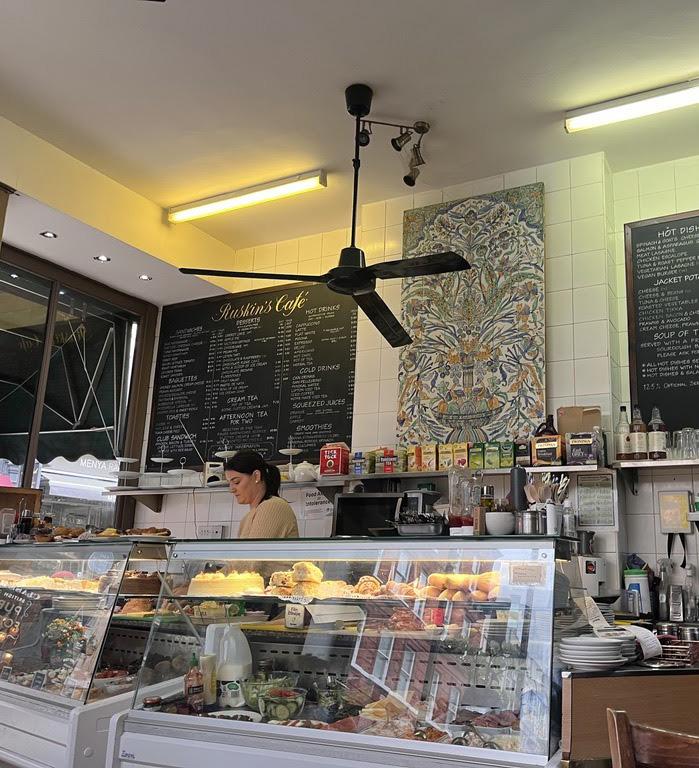

It is a known generalization (and fact) that England loves tea. Many reviewers experienced firsthand the truth of the favored drink over the pond. Consequently, I was shocked to find that the United Kingdom has another, naughtier, drink that is highly favored to an extent comparable to that of tea.
Cider! Bottled or on tap at your local pub, cider is enjoyed nearly as much as tea, according to The Orchard Project. It is not surprising, then, to learn that the UK drinks more cider than all other countries in the world… combined.
I was shocked to learn of their apple obsession, but not as much as I was excited to (safely) consume large amounts of cider throughout the duration of my time in London. Since I could remember, my family would take yearly trips to Kansas’s Louisburg Cider Mill for our good share of cider donuts and, of course, apple cider. Growing up with what I consider to be the best cider in the world, I had high standards for London.


#1 Cornish Orchards Raspberry and Elderflower Cider, Pizza Shuttle
WUPOC Ranking: 8.5/10
Not very crisp
Hands down the best flavor Could distinguish the raspberry from the elderflower
London held strong in my cider showdown. In more detail, here is my cider rankings for the 2024 London Review ranked by the WUPOC (Wyatt’s Unprofessional, Purely Opinionated Cider) standards:
Overall, the ciders of London were of a quality I wasn’t expecting. Another pleasant surprise I didn’t expect was the variety of origins of the ciders, which included Sweden, Italy, and England.
In hindsight, it makes sense that there were numerous cider country origins, given the closeness of England to other European countries and the cosmopolitan nature of London.
Cider has, for me, always tasted like liquid comfort and safety. For that reason, I am grateful to the London pubs and restaurants I visited. While braving new experiences and traveling abroad for the first time, the cider I had gave me a piece of home throughout my journey to London.
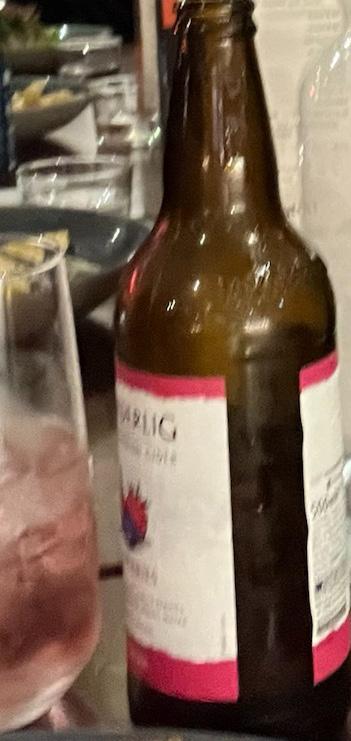
#2 Thatcher’s Cider, King’s Arms Pub
WUPOC Ranking: 7.5/10
On Tap AND at the Pub from Saltburn!
Gave a classic, crisp taste
More initial “beer” taste
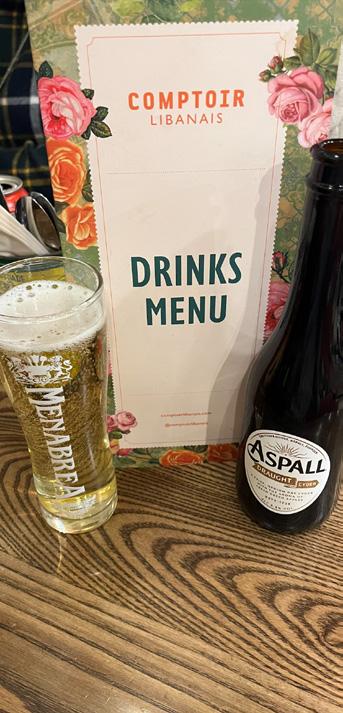
#3 Rekorderlig Wild Berry Cider, Prezzo
WUPOC Ranking: 7/10
Crisp beginning and end Good flavor, though less distinguishable
Similar to previous, less initial “beer” taste
#4 Aspall Draught Suffolk Cider, Comptoir Libanais
WUPOC Ranking: 6/10
Initially Crisp, unlike most others I tried
Flavors not as strong as other ciders, but still delicious
Less initial fermented/ “beer” taste
It is not new information how much Great Britain has colonized the world since their reign started in the 16th century. While there are numerous problems that have arisen from this, one positive aspect is the increase in cultural diversity in big cities like London. With so many people from other nations immigrating there, various culinary traditions have been brought over to the larger cities of Great Britain. These traditions are so abundant in London, it is difficult to go to any neighborhood without some sort of restaurant that offers unique dishes from all over the globe. Of course, there were plenty of chains like Burger King or KFC, but even then, those had slightly different options compared to their American counterparts. Despite taking over so many countries over the years for spices, surprisingly, it was the native British food that was the absolute worst when it came to seasoning and flavor.
Some of the best food I had while staying in London was the mediterranean and Asian cuisine that was over. One restaurant that particularly stood out was the Lebanese restaurant a block away from the hotel. Not only was the inside of the restaurant littered with brightly colored flowers and lovely pastel pink and green walls, but the food was exquisite. The falafel I had there was some of the best I’ve ever had in my life, not even comparable to the Mediterranean food here in the US.


Another place that was absolutely amazing was a booth at Borough Market that sold Japanese rice bowls. From the meat and rice to the toppings, every part was seasoned so beautifully and blended together amazingly.
On the opposite side of the spectrum, the British pub food was not near as good as it looks on social media. During my time there, I, of course, had to try fish and chips. Not only was it rather underwhelming, but so painfully bland that I couldn’t stand to finish it. The fries were pure sticks of straight potato dunked in hot oil without any flavor other than starch. The breading on the fish tasted so unseasoned, I thought it was only made out of flour. At this point, I thought that maybe it was only this one pub. I was sorely mistaken. After going to another pub in a completely different neighborhood, it was the same thing all over again. The only difference was they had better sauce for the fries and fish that made it slightly more tolerable. I thought that because Britain colonized so many places for their spice, they would hopefully use them. I suppose they really were just for wealth.
Overall, no matter how much I complain about it, the food experience wasn’t all that bad. If I had to change one thing, I would just go try more cultural food and explore my options a tad bit more. The longer the trip went on, I realized that it wasn’t just about the food I ate at these places, but the experiences I shared at these locations with others that made it all okay.
Tea is the most underrated drink in the United States. Yes, I know about squirt, kombucha, and bug juice. Tea is elegant, sophisticated, timeless, and clean. That is probably why it’s not popular in the United States. One should know I love tea, and I do not discriminate. Matcha, chia, black, iced, sweet, and so much more. Having this in mind, I was quite excited to learn that London is known for its tea. I knew right away I wanted to have as much tea as possible, but then I was informed about this magical place called Fortnum and Mason. Fortnum and Mason were tea shops where apparently the royal family had gotten tea from before. I was amused and wanted to see it myself.
We planned out a day when we would go to the magical tea land. We eventually made our way there, and when we walked in, I was met with surprise. Everything was so elegant looking and shiny. There were chandeliers and marble everywhere. Most of all, there was tea everywhere! This was like paradise for my tea drinking machine I identify myself as. My friends and I decided to divide and conquer because this place was so large. I then came across a restaurant inside the building where, of course, they were selling tea. I thought to myself, “You can’t go to a famous tea place and then not have any tea yourself!”. So, the waiter brought me to a table, and I sat by myself. As I looked over the menu, I decided to go with a nice floral drink that was about $9 vs. the $30 tea they also offered. When the waiter came, they brought me a whole teapot full of my tea and a cup of milk with biscuits.
It was in this beautiful blue and white floral China. I was quite excited but was not sure where to start. As I sat there, I realized that for as much as I loved tea, I did not know how to have it in the “proper way.” I went to pour the tea into my cup but saw something in the spout. I thought it was a plug and started trying to pull it out. I felt quite aggressive pulling this weird plug out, and it was not wanting to come out. I realized that it was not a plug but a strainer keeping the leaves in my pot from going into my drink. As I continued and went to pour myself a cup of sophisticated tea, I ended up going too far, and tea started spilling from the top of my pot. As I quickly caught my mistake, I subtly grabbed my napkin and started whipping up my burning hot tea. After that embarrassing moment, I decided to move on to the milk.
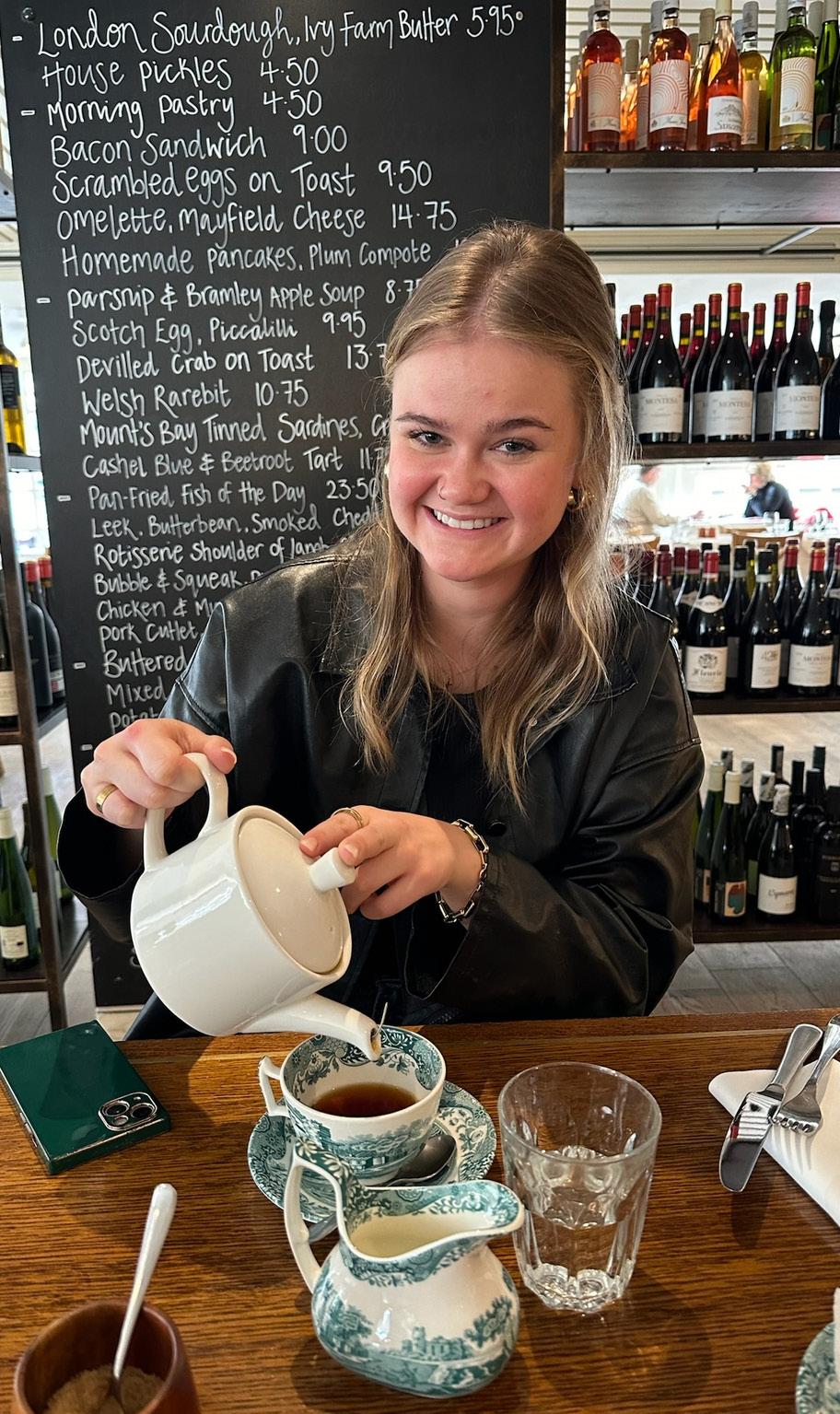
I thought the milk was supposed to be added to my tea, so I added a splash. When I did this, though, my tea turned an ugly gray/green color, and I felt that maybe that wasn’t the right move. I then thought I would redeem myself with a biscuit dunking. As I started to make my first dunk with my biscuit, I started doubting myself. I had been wrong about so many things beforehand. What if I was wrong again and dipping the biscuit in the tea was improper? I, very slowly, trying to draw the least amount of attention to myself, dunked my biscuit. I knew this was the right move because that biscuit was dense, and without the tea watering it down, it would have been too much. I began feeling much more comfortable and could enjoy my tea in peace. I even took that time to call my mom until my friends decided to join me and get some tea themselves. This was a special memory I will forever hold dearly to my heart.

Across the street from Gloucester Station stands a small convenience store that sells the cheapest, delicious meal in all of London: the TESCO Special. The name of the combo was coined by Michael Koch who raved about it to every person on the trip, including me. In reality, the TESCO Special is just a meal combo that costs about 5-6 pounds and comes with an entree, side, and drink. The best part of this meal combo is that there is a variety of choices for each type. For entrees, there are sandwiches to sushi rolls. For sides, candy bars to fruit bowls. Then, for drinks, water bottles to dedicant smoothies.
Throughout the trip, I had the TESCO Special three times because of its price and accessibility. After a long day of walking around London, I would head back to the hotel feeling famished, so the only nearby place that was open and unique to London was TESCO. (Although Wingstop sounded like a good option, it is an American chain).

The first time I had it I had the special I got the: Chicken Triple Sandwich, Supreme Prawn Cocktail Crisps, Juice Burst – Apple. The sandwich was delicious with tender chicken breast, slices of bacon, bits of corn between two slices of white bread with some creamy sauce. Surprisingly, the sandwich was able to fill me up, and I felt satisfied with just eating it alone. The next best part was the Juice Burst – Apple juice. I am an avid fan of apple juice, and when I say that this juice was delicious and not sweet, I am not lying. This is my second favorite apple juice after the Dole Apple Juice that they have in the campus vending machines. Last, but not least, was the Supreme Prawn Cocktail Crisps (emphasize on the crisps because these are not British chips)
The second time I had it I got another sandwich, fruit, and a bottle of water. I cannot remember what type of sandwich I got, but I think it had chicken. And I remember liking the first sandwich I had more than this one. As for the bowl of fruit, it was a necessity. On the plane ride to London, Fatima had a bowl of fruit as part of her meal. I remember desperately wishing that they would give me that as a dessert, but I got a truffle brownie (which was delicious). In addition to not eating anything healthy, the bowl of fruit was refreshing to eat. The bottle of water quenched my thirst because I swear I think the most water I drank in one day was probably 8 ounces of water. So, the water bottle was essential.

The third and last time I had the TESCO Special, I had a sushi roll, a Lion candy bar, and a smoothie. Never get the roll. To be fair, I was catching up with Bhavya, Carina, and Hamdan about their terrible day so the sushi was sitting there at room temperature for some time. So, when I had a bite of the sushi, I immediately hated it. It may have made me a bit nauseous too . . . Therefore, I am glad that I had the smoothie there. The healthy punch was what I needed to get over it. I saved the Lion candy bar for later when I felt snacky. And it was so chewy yet crunchy. It reminds if you mix a Crunch with Twix but remove the cookie part of the Twix. I wish I had bought more before leaving.
Although I enjoyed the TESCO Special, I know that there were some people who were not able to due to dietary preferences/restrictions. I hope in the future that TESCO considers these needs and improves their choices to accommodate to them. Therefore, thank you Michael for introducing and raving this combo to us. It was very delicious for its price and quality.
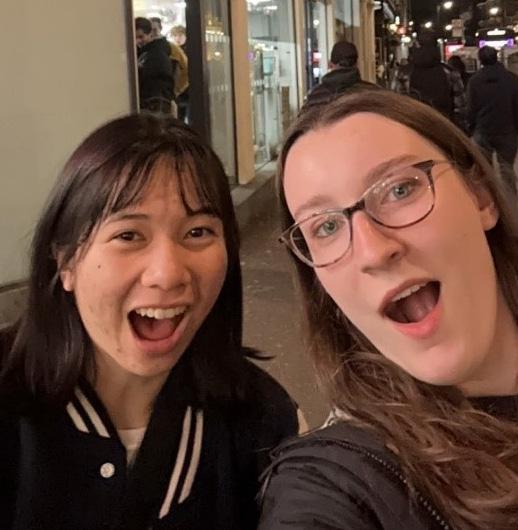
As someone with celiac disease, it’s almost obligatory that I talk about my experiences eating gluten-free in London. But to do that, it would probably help to know what the experience is like back in the States.
In Lawrence, Kansas, a thriving college town with a population of nearly 100,000, there are bound to be people who have dietary needs – and the restaurants know this. Roughly 40-50% of them offer alternative dishes that are gluten-free, dairy-free, vegan, and so on. But celiac disease is far more sensitive than the typical allergy or preference, and in my experience? There are – maybe – three restaurants in all of Lawrence that I trust to be safe.
Given this, how on Earth could someone manage to eat safely while in an entirely new city?
Surprisingly, quite easily.
The first meal was easy enough since it was a group dinner. The meals were ordered in advance, so I was able to work with the trip organizers to make sure that the place (Pizza Express) would be able to accommodate me. The airport exhaustion definitely began to set in as dinner continued, but the food itself was as safe as anything I’d find in Lawrence, and pretty good at that.
The next morning, my worries started to set in. People formed into groups pretty quickly – based on who was traveling where – and anyone with an eating restriction knows how painful group meals can be.
It’s always more difficult, because you need to find a place that satisfies everyone, and having someone especially hard to satisfy (like myself) makes things infinitely more difficult. By the time the group found a Korean restaurant they were happy with, I had already resolved to getting sick – but was pleasantly surprised. I will admit that the service was a bit disorganized, and I’m almost certain that the waitress hated us, but they had a bibimbap bowl that they assured was as safe as possible: all gluten-free ingredients, prepared in a cross-contamination free space, and so on. It wasn’t the best meal I’ve had, but it was safe, and I was happy to have that.
Dinner was another mystery, as we popped into a restaurant just a few minutes’ walk from our hotel, given that restaurants were beginning to close left and right. Again, I found myself anxious – this was nothing like eating in Lawrence, which was always a series of careful, familiar steps. Spontaneity wasn’t something that celiac allowed; that was what I always told myself. But the longer I spent in London, the more I realized that it was only the States that were my problem. Dinner was delicious, a plate of chicken and fries (sorry, chips) and some assorted veggies. It didn’t take any tedious preplanning, scanning the internet for relevant reviews or picking apart the menu for any signs of dubiousness.
This pattern of easy eating only continued, day after day after day. Where Lawrence only offers one or two restaurants with a dedicated gluten-free fryer,
London offered just as many on every street. Fish and chips, chips and chips, even (admittedly overpriced) pastries.
London’s Indian cuisine is well known, and I was delighted to see that it was just as safe. It’s easily my favorite category of food, but most places in the US are unsafe due to the naan cooked in the tandoor or the flour used to thicken the sauces. In London, almost half the menu was guaranteed safe for me. Probably the best meal I’ve had in years was an incredible chana masala with gluten-free naan (can you believe that?!) that I found just a short walk from the British Library – again, a spontaneous choice.
Suffice it to say: eating in London was one of the best experiences I’ve had. That isn’t to say that it’s perfect, but it’s damn near close to it. It gave me a freedom that I didn’t know I was allowed to have, and that alone was enough to make it an incredible trip. If anyone reading this wondered what eating gluten-free was like in London, rest assured: it’s great.

During my first few days in London, I enjoyed finding little differences between the UK and US. “Way out” instead of “exit.” Chips instead of fries. Street signs on buildings instead of posts. “Take away” instead of “to go.” However, there was one difference that stuck out to me the entire trip and I immediately knew I wanted to write about it.
I’m an environmentalist. I’m the kind of person who uses old assignments as scratch paper and packs silverware when going somewhere that only has plastic utensils. Because I’m constantly making efforts to go green, I couldn’t help but notice London’s sustainability efforts.
The UK makes several appearances on rankings of the most sustainable countries. It actively works towards its goal of net zero greenhouse gas emissions by 2050. Throughout the week, I saw and felt the effects of London’s environmental policies.
Though the streets didn’t have many trash cans, or “bins,” people made an effort to pick up after themselves and left almost no litter. Trash cans were always accompanied by at least one type of recycling bin. Recycling was often divided into numerous sections–glass, coffee cups, mixed recycling, paper. Some places, like the British Library, emphasized this by calling these locations “recycling points.” This made me happy, as I’ve found myself hauling recycling bags home since KU removed recycling from my apartment.
Shops and restaurants also contributed. Many of them, especially bookstores and museum gift shops, used paper bags. Besides boba places, restaurants and pubs only had paper straws, if any at all. Wooden cutlery was included in takeout meals rather than plastic. I don’t think I was even given the option of a plastic straw or utensils the entire week. The shops and restaurants resonated with my refusal to use plastic straws and obsession with tote bags.
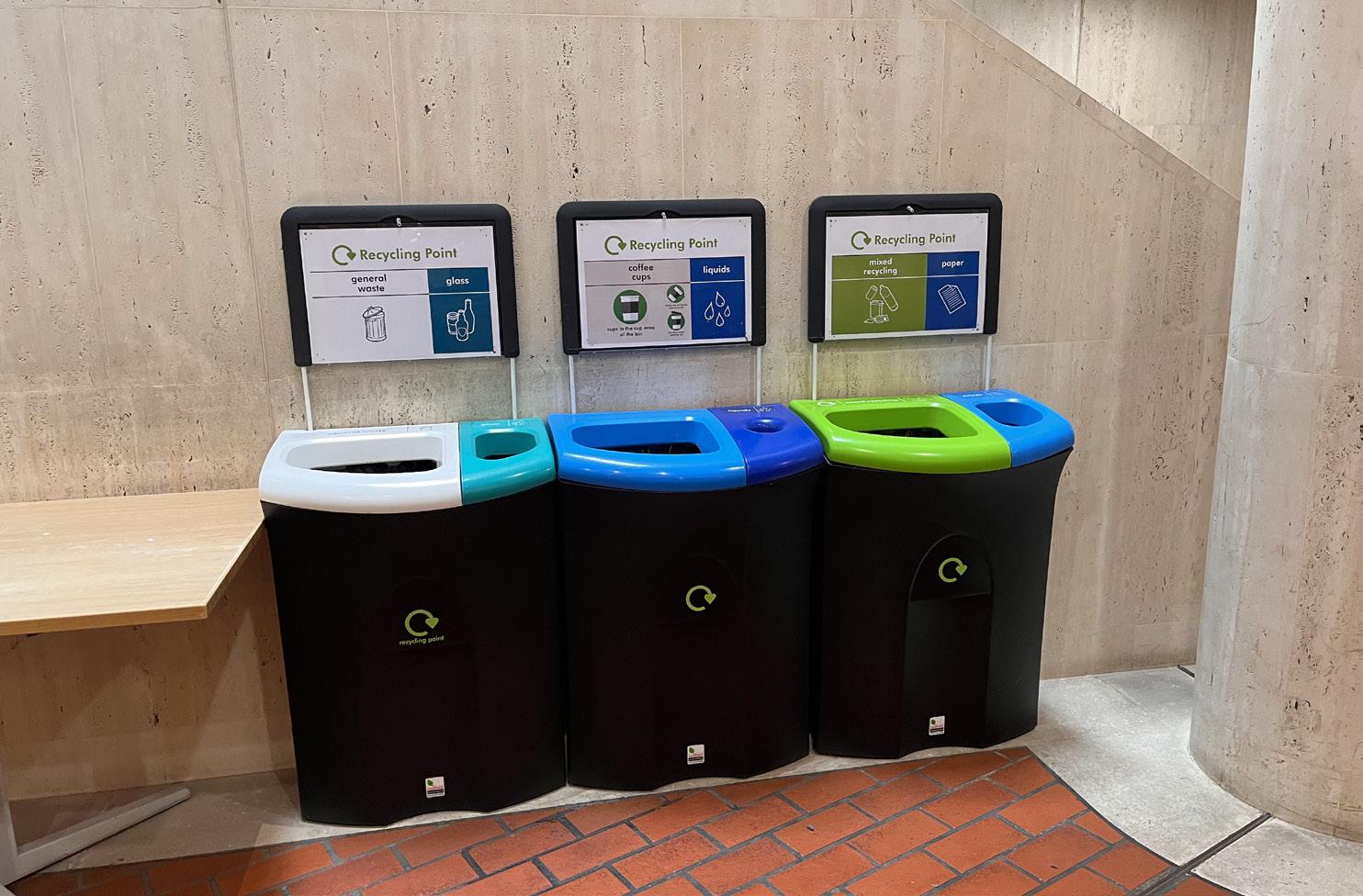
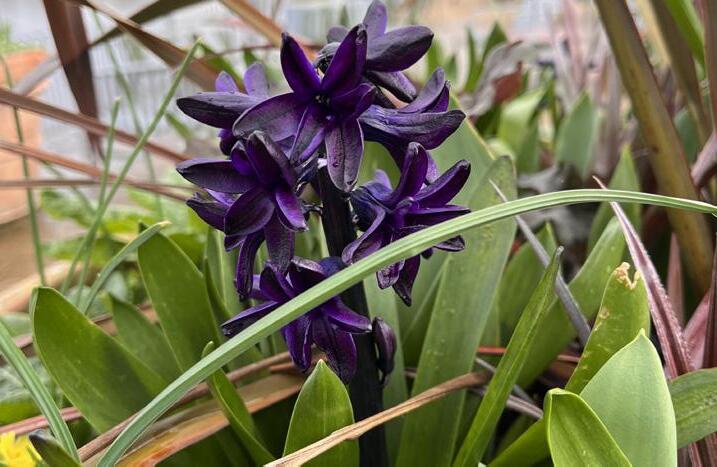
One of the integral parts to the London experience is also quite sustainable. The tube that sends gusts of wind through the whole station is a quick way to get around. The double decker buses that almost topple over every time they turn a corner simultaneously provide transportation and sightseeing. Once I learned how London’s vast public transit systems worked, I realized how convenient and eco-friendly it is. For instance, the tube was so efficient that we never had to wait more than five minutes for the next one.
In addition to London’s indoor efforts, it also has many green spaces. I enjoyed strolling through these spaces, especially Hyde Park, to get a break from the museums and city. I appreciated its flowers and lush, green grass occupied by frolicking dogs. I would go there to read the book I purchased at Blackwell’s and take photoshoots of the swans, ducks, and geese.
I wasn’t expecting to notice these small details as much as I did. It’s weird how accustomed we get to things like plastic bags and utensils until they’re changed. It felt good to spend a week in a place that’s so environmentally sound. It almost gave me a sense of comfort and hope. Upon returning to the US, I felt encouraged to continue my sometimes over-the-top efforts and seek more ways to be more eco-friendly.
Ever since I was little, food has been a reprieve from the world. I could lose myself in the smells, the wonderful tastes, and the people I dined with. I knew that when I went to London, my reprieve would become my obsession. Little did I know how that obsession would change me.
The beginning of my spiritual adventure with food started at the Tate Britain with a lychee, raspberry, and vanilla donut. This donut was different from anything I had eaten before, it was sweet but not sickly, rich but not dense, and had a dusting of granulated sugar that made it the perfect morning treat to satiate me through the two hours I spent at the museum. At the sister Tate Modern, I hopped off the boat to indulge in a fluffy cheddar scone with cherry and caramelized onion spreads and a ginger-lemon kombucha. I was renewed physically, mentally, and emotionally enough to walk through the exhibits and come out the other side ready to jump on the tube.
The two Tate treats delighted me not only because they were delicious, but because they both played right into making me feel at home in incredibly overwhelming spaces. Some of my most nostalgic memories are tied to eating donuts with my grandmother and scones in Wheatfields with my parents.
Through these comfort foods, I learned it is of the utmost
importance to not only fuel your body when you’re working hard but to also give your mind a break when choosing what fuel to eat. It’s okay not to always be adventurous with food even in new places and it might serve you better. The second impactful food experience occurred at the Borough Market, just after my adventure going to my dad’s house and school.
I was positively starved by the time I found the market and I was immediately drawn to the warm savory pie section. The warm self-contained package changed my presence in the market completely, instead of a food hunter I was more like a happy butterfly wanting to land on every flower. I paired mulled wine with my pie and sipped it as I took the time to look at every single stand in the market. I got two cannoli, a pretzel, a strong limoncello spritz, a baklava, and a black cherry Turkish delight during my travels. I was tipsy, slightly too full, and so incredibly happy.
Just by the entrance, where I had wandered to by the end, a man was playing 2010’s songs. As I slowly walked toward him and out the doors, my eyes started to well up. I had no idea where I was going once out in the warm sun, but I felt so lucky. So lucky to be able to try all the food, that the food was so delicious, to be in London, that the market had a pretzel stand, to be standing in the warm sun, and that the day wasn’t halfway done. I went on to drink and eat delicious food till the wee hours, having the best day on the trip.
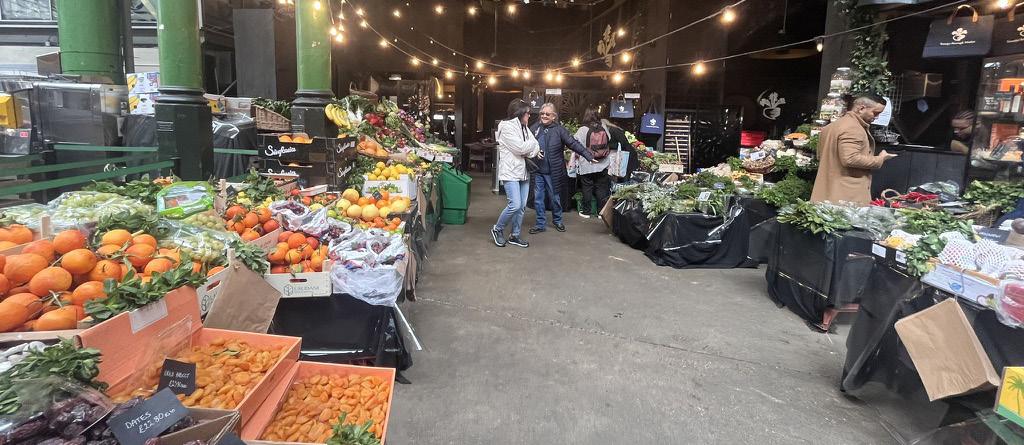
Coming to London there are a lot of things one could want from this trip: a new experience, growth, memories made, or self-discovery. These are all great, but I had one thing in mind, and it involved milk, cream, and sugar. This was gelato. To know why this is my true love, we must go back to the summer of my 7th grade. My family went on a vacation to Rome and that was when I was first introduced to gelato. In Rome, there was a train station selling gelato so light that it was like whipped cream, with rich, chocolate swirls. It was like a kiss from heaven and has enchanted me ever since. Hoping and dreaming of this Italian gelato for years, I thought this trip to London would be my chance to be reunited with my love.
As I broke the news to my friends, they were immediately on board for “Mission, Get Preslie Gelato Every Day.” Our hopes were high, and the mission seemed simple, until tragedy struck. Days went by without even a taste of this sweet substance. Do not be fooled, this was not due to a lack of effort. Each day we tried, but it seemed that the harder we tried, the further the gelato got from us. It finally happened though on our way to King Lear. We were in a rush, but suddenly, we ran past a gelato shop. We had no time to stop so my only hope was that we would come back after the play. The play lasted longer than expected. I had no hope that the store would still be open, but my friends were optimistic. As we approached the store with anticipation, we were met with the store light still glowing strong!


With great cheer, we went in and picked our flavors. As I took my first bite with excitement, I was met with disappointment. It wasn’t the same. Even though I was discouraged by this, I was more than fearful to inform my friends that this gelato was not like the one in Rome. I squeaked out, “It’s good,” but they immediately saw through me and knew the mission was not over. The next day we were on the hunt and found a new place. I quickly picked out my flavor and added whipped cream hoping it would lighten it up. With lower hopes this time, I was pleasantly surprised. It was quite delicious and better than the one before. Sadly, I still had to inform my friends it was not the same.
It started to hit me that maybe my memory was failing me, and my 12-year-old self thought that gelato was so much sweeter than any other treat I have had. As this new reality was settling in, my friends’ drive to find my perfect gelato seemed to have grown. I would like to say this story has a happy ending. I would love to tell you that on the last day in London we found this shiny new gelato place and a man with a tall chief’s hat, like from the Lindor Truffles commercials scooped me my perfect scoop of gelato that melted in my mouth and my heart sang and all was at peace in the world. But all these things would be a lie. We continued to look, but it was never found. The question remains: did it ever even exist or did the dream of my gelato experience in Rome become over-exaggerated? I was not upset though because my hunt for gelato was still some of my favorite memories. For what makes an experience special is not the experience itself but the people with you, and my company was that much sweeter than any gelato I had.
Traveling to a major international city has all kinds of perks: world-class museums, historic sights, famous musicals, and some great people-watching.
For me, however, the lure of visiting a foreign city comes down to snacking and wandering. And in London, that is just what I did. I tried my best to work up an appetite by walking for the better part of each morning until I could feel a rumble in my tummy. When traveling, I try to follow the lead of some of my favorite fictional characters, hobbits, who are devoted to second breakfasts and elevenses, so I really had to cover some ground to achieve my culinary goals. Throughout this endeavor, a few particular meals and musings stood out.
After a few days of classic London drizzles, the sun burst through the clouds and turned Hyde Park into a beautiful, vibrant emerald green. It was just warm enough for me to entertain the idea of enjoying a scoop of gelato and letting the sun work its magic on my often-chilled bones. I sat beneath a Japanese maple, listened to the playful chirping of birds, and enjoyed the forgotten pleasure of eating an ice cream cone in the park. Just as I was finishing, I was reminded of my childhood. On warm summer days, the ice cream truck would jingle its tune, and all the kids in my neighborhood would stop everything they were doing and run pell-mell to spend 50 cents on a popsicle. Both the gelato and memory were excellent.
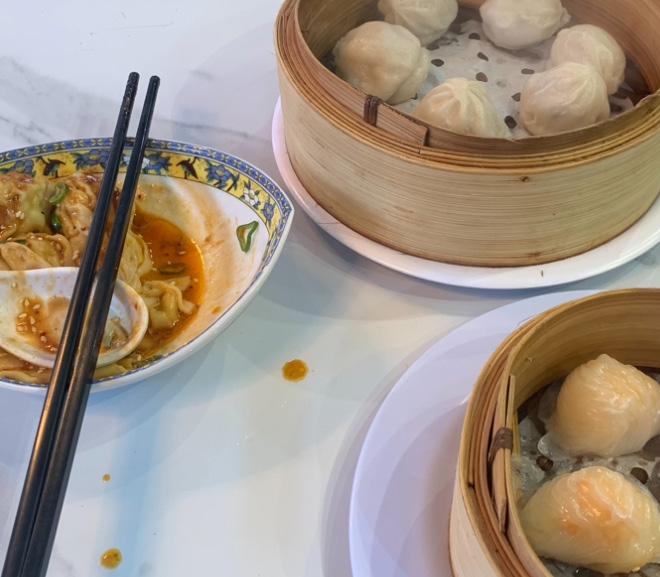

On another excursion, I was determined to walk around with no designed purpose other than to continuously fuel myself around the city until I was too tired and then take the Tube back to Gloucester Station. My first stop came on Dr. Klayder’s advice, and I grabbed a coffee and cheese scone in the crypt of St. Martin-in-the-Fields. The combination of warm, bitter coffee blended perfectly with the flaky and buttery scone. Sitting in the well-lit crypt allowed me to reflect on what it would have looked like by candlelight hundreds of years ago. From there, I wandered through Soho to London’s Chinatown and enjoyed a plate of dim sum. I was even able to find my favorite dim sum, xiaolongbao, which I often ate while living in Shanghai. Further walking and snacking led to two more coffees, a vegetable Punjabi samosa, capped off by a side of spicy falafel. That day, I walked 12 miles and felt like I had really accomplished something, even though I didn’t check off any “must-sees.” My best memories involved the special moments along the way.
If there’s one thing about me, I love dessert; especially anything chocolate. Chocolate in liquid form, frozen, or truffles; chocolate cake: mouse, flourless, or lava; or chocolate on top of strawberries, pancakes, and croissants. During my week in London, I managed to have about 20 sweet treats, almost 3 a day, and nearly all of them involved some form of chocolate.
Upon arrival, while exploring the Kensington neighborhood, a group of us stumbled across EL&N bakery. Filled with the excitement of having just arrived in London and drawn to the colorful display of treats, a friend and I decided to indulge. I picked out the raspberry-filled chocolate cake (raspberry and chocolate is such an elite combination). The server notified me that my selection was vegan, a warning which I would have heeded under normal conditions, but I was too eager to back down now. The cake was solid: the chocolate was rich, and the raspberry filling was tart and flavorful. However, I should have known better—a vegan batter will never be as good as one made with eggs and dairy. Overall, 7/10.
Approximately 3 hours later, I was eating my second dessert of the trip: a chocolate lava cake with a scoop of vanilla ice cream and fudge. I ate three different lava cakes in London, and this one ranked second. It was a good dessert, an 8/10. However, the real star of the show was the chocolate lava cake I had at Indian restaurant Dishoom, which was served with a house-made chili ice cream, a definite 10/10!
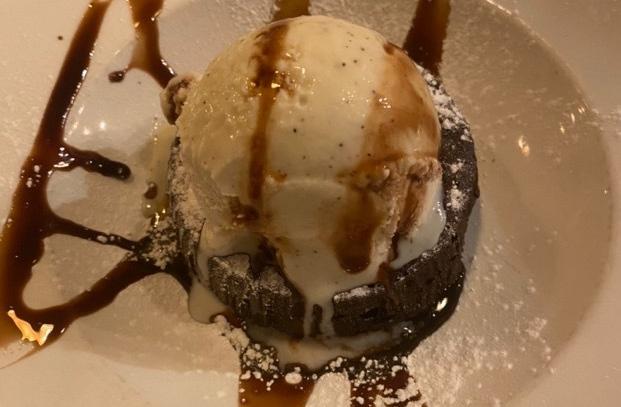 Irene Caracioni
Irene Caracioni

Several truffles, croissants, and hot chocolates later, I was craving something healthy. Strolling through Borough Market, I came across a crowded fruit stand selling cups of strawberries. I got in line, and once at the front, I was confronted with a decision: would I like my strawberries plain or covered in chocolate? What a no-brainer! The strawberries themselves would still be healthy, only now more delicious, with the addition of melted chocolate. It was love at first bite! These had to have been the best strawberries I’ve ever eaten: 100/10.

Finally, on my last day in London, I wanted to make sure to eat a dessert I knew I loved and could not find easily back home: souffle pancakes. Torn between the chocolate and honeycomb or Nutella and strawberry toppings, but then remembering how much better strawberries are in the United Kingdom, I ultimately decided on the classic topping combination. After a 20-minute wait (the pancakes were made fresh to order), my mid-day treat came out. Although they were two sizable, thick pieces, I did not want to share. The souffle pancakes were so light and fluffy, the drizzle of Nutella was just enough, the strawberries were sweet, and the crunch of hazelnuts on top paired perfectly. 10/10. Overall, I would say I had a sweet time in London :)
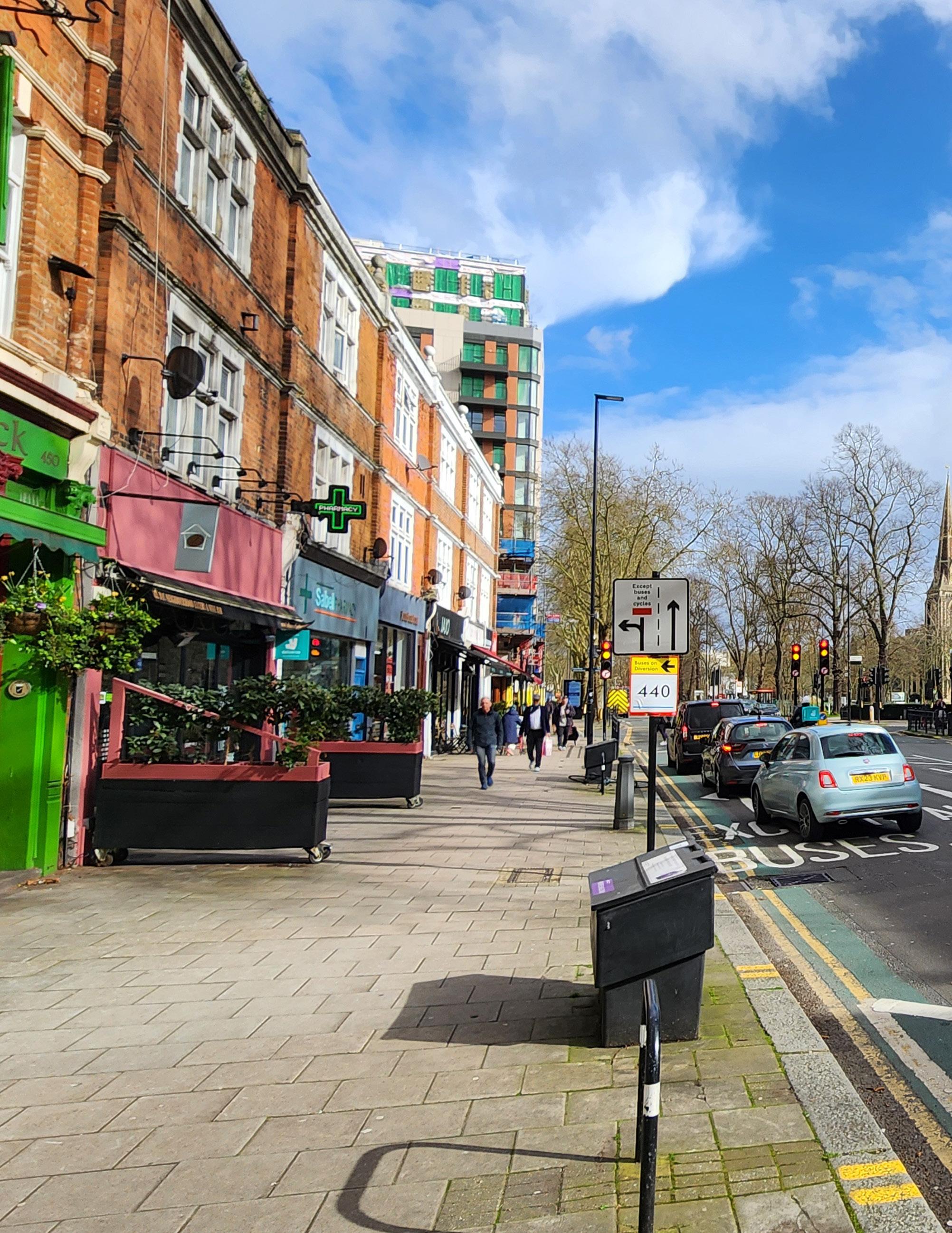
The “It’ll Be Fine” gallery is made up of five articles on navigating challenges to mind, body, and wallet while in London. Titled after Dr. Mary Klayder’s catchphrase, “It’ll Be Fine” is an exploration of resilience and perseverance amid unforeseen circumstances.
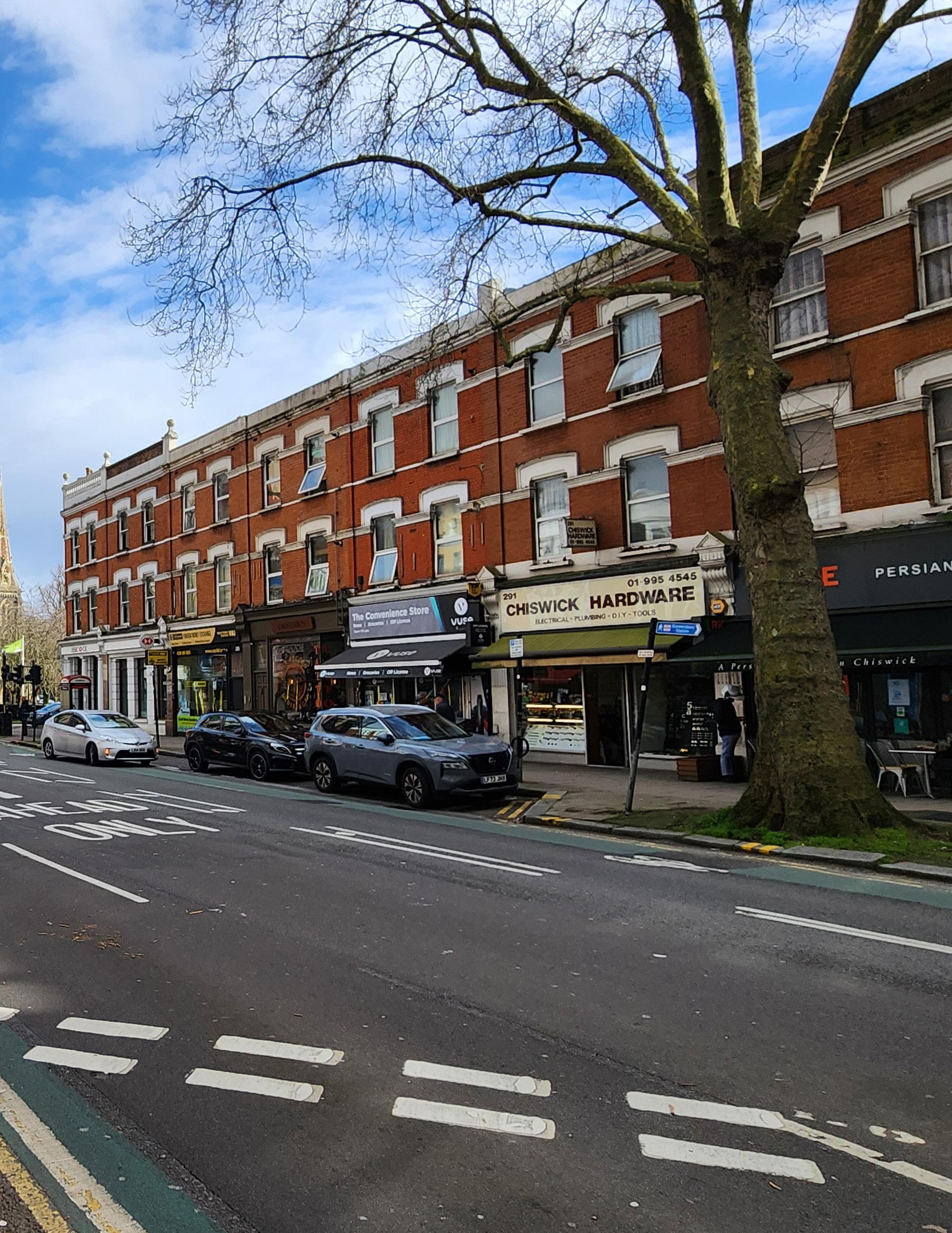




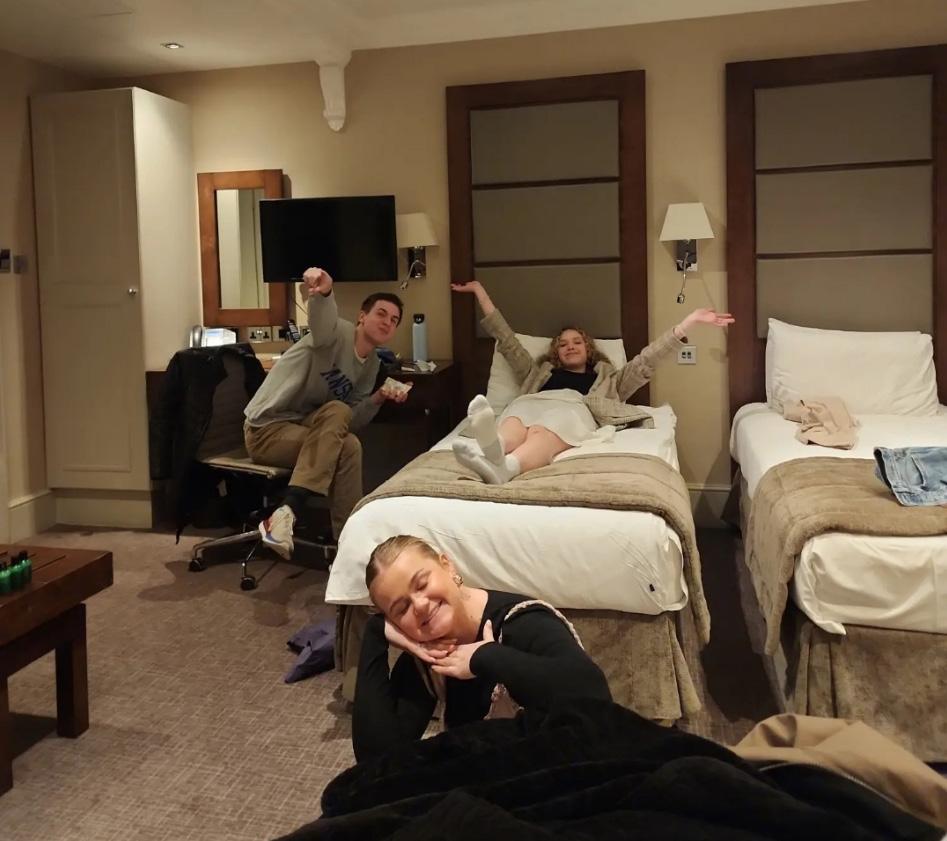

Richly cultured, London takes on many titles. London: Birthplace of the Industrial Revolution. London: Home of Royalty and Regency. London: City of Sickness?
When I applied for the London Review, I envisioned many activities and aesthetic sights. Hot teas, high-quality pastries, cobblestone roads, Victorian architecture, pub culture, museums, and tube lines.
I did not, however, envision myself glaring with empty eyes at the bottom of a toilet. Gross, but true.
Initially, I had crushed spirits when I went abroad. Exhaustion, headaches, and nausea joined me in my travels when I headed back from Oxford early. This mental low, while tangible, was incomparable to the sickness that reached me later that night. After a midnight bath in the cozy hotel room I shared with fel
low reviewer Lilia, I knew I would be sick; consequently, I sent Lilia a text to tell her to go on without me the next day… and to buy a bottle of water from room service for me.
The next twenty-four hours were abhorring. As I balanced my nausea and exhaustion, I put up no effort to find a silver lining. However, a silver lining would find me as I grew slightly better each hour. Just a day or so before, I confided to Lilia.
“I feel guilty for taking a nap while we are in London—like it is wasteful.”
She responded with an epiphany I would later realize.
“Well, you won’t really enjoy London if you’re tired and annoyed, so it justifies taking a nap for the sake of having a better time when you are out and about.”
Lilia is a genius. I came to this conclusion when I was reflecting upon the trip so far (I had plenty of time to ponder while in solitude). I realized I had been stressed. Am I doing this right? Should I do this instead? Should I have planned this more? All these doubts made me frustrated and took away from my experience.
In being sick while in London, I was given the opportunity to reframe my thinking of my trip. I realized, with much gratitude for the food poisoning I got from eating some egg pastry, that I needed to be flexible, and live in the moment—to enjoy London for what it was instead of what I could make it out to be.
The next day, Lilia and I went to the Sir John Soane Museum and loved it. The second round of sickness, however, I did not love. Sickness, you suck… I thank you for that.

For a trip whose days were chock-full of breathtaking art, delicious food (surprising for London, am I right?!), monumental sights to behold, and intensely spiritual experiences in the middle of the street, its beginnings were not so glamorous for me. I arrived three hours early to the Kansas City airport—partly because my roommate Katie (who also went on the London Review) had a flight that took off an hour before mine and partly because I had a sneaking suspicion something would go wrong.
Tossing and turning the night before, I had worried that I would miss my plane. Or that I would not be able to navigate the airport and get lost. Or that I would come down with a nondescript illness and find myself hospitalized for two weeks, ensuring that my dreams of traveling to London would never come true! So, when a friend of ours offered to drive us two hours earlier than anyone should arrive at the Kansas City airport for a regional flight, I jumped on it.
The flight to Chicago (I’ll bet you can guess where this is heading based on the destination) was delayed because of the weather. And it kept getting delayed. I waited for four hours in KCI as my already short layover went from an hour to twenty minutes. When I finally landed in Chicago, I, and the other frantic passengers headed to London, rushed to the bus system. Clutching my carry-on and passport tight to my chest, I waited in the long line for the bus and just barely made the final one.
Finally able to breathe, I checked to make sure all of my things were in order (and if you’ve paid attention to the title, you’ll know they were not, in fact). I had been keeping my driver’s license in my passport to ensure that I did not lose track of it, and it was nowhere to be found. On that cold, wet bus seat, I scoured every pocket, crevice, nook, and cranny of my backpack to no avail. I had lost my license.
I arrived at the gate—a flushed face mess of stifled tears and shaky hands—and called my mom the moment after I checked in.
“Mom… I don’t know what happened. I don’t know what I did. But I lost it! I lost my driver’s license.”
She took a beat before calmly replying. “It’ll be okay! You’re okay. At least you still have your passport!”
But when you’re a control freak like me—someone who needs to have everything in its precise place, who needs every box ticked on her itemized prep list before being able to continue with plans, who arrives three hours early to the airport for an hour-long flight—hearing an “at least!” does little to comfort the worry-wart mind.
I did my best to dry my tears, to assure her that I would be okay (and to believe it myself), but I could not shake the feeling that this loss would define the entire trip. That by not being entirely in control on my journey to London, I would lose control while in the city.
Betsey LewisThat my not being “on top of things” would place a burden on someone else in our group. That the “at least!” would be for nothing, and my passport (along with whatever shred of stoicism and chill I had left) would magically disappear.
Luckily, none of the above were true. Rather, they were the rambling worries of the perfectionistic eldest daughter turned first-time solo traveler. Nothing more. The loss of my driver’s license turned out to be more of a nuisance than a burden. More lesson than the end of the world. And it’s true: at least I still had my passport!

In London, it’s almost essential to ride the tube for getting around the city quickly. That’s why everyone on the trip got an Oyster card, which is essentially a tube pass that you tap onto an oyster-shaped card reader to pay for your trip.
I had the privilege of having my oyster card for barely over 24 hours. In my excitement to take a photo of Big Ben, I must have dropped my Oyster card from my purse in my search for my phone. It might be still laying in a puddle somewhere near Big Ben, sad and expired and with so much potential (money).
I was upset, of course. I had to pay that fare of $4 with my credit card to get back to the hotel when it could have been free. Those four dollars could have gone to gelato or something else wasteful. I sulked in my bed all night, thinking of how I would have to get a
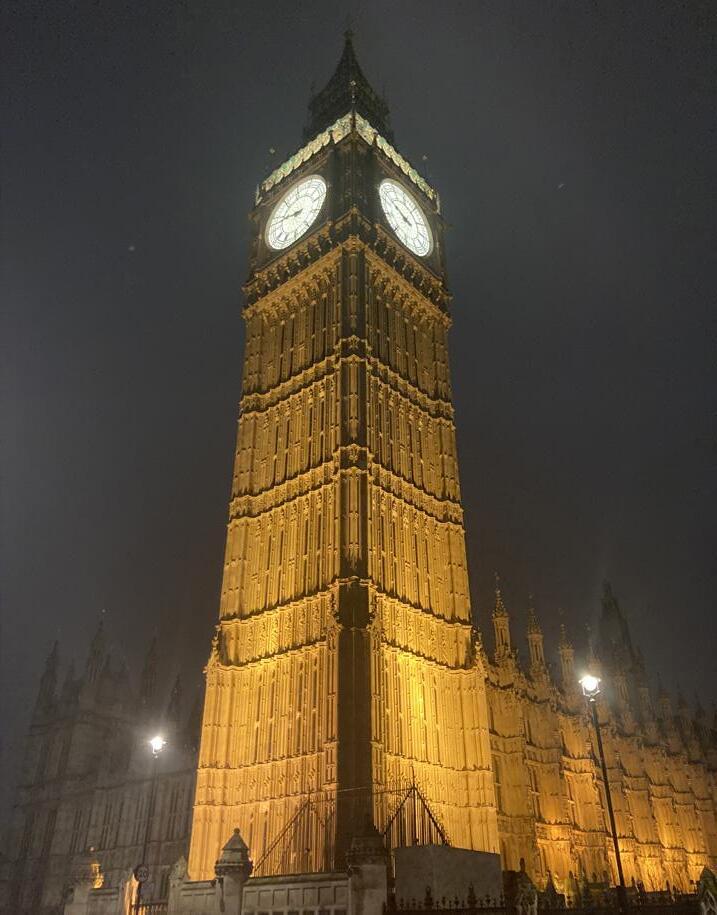
replacement card the next day. I didn’t think it would be too expensive.
Bright and early, I made the short walk from the hotel to the Gloucester Road tube station to purchase a new Oyster card. It was £49.70, or $65, for a seven-day card with access to zones 1 and 2, which encompass most of central London. I gritted my teeth and paid for it, figuring if I went without a card for the next four days of the trip it would end up costing more than if I’d just bought the replacement card.
I stashed the card in a safe pocket of the purse that I wouldn’t be unzipping unless it was to use the card. I would protect this one, I told myself. I happily and extravagantly tapped it at several tube stations that day, consoling myself with the thought: At least my card looks different from everyone else’s.
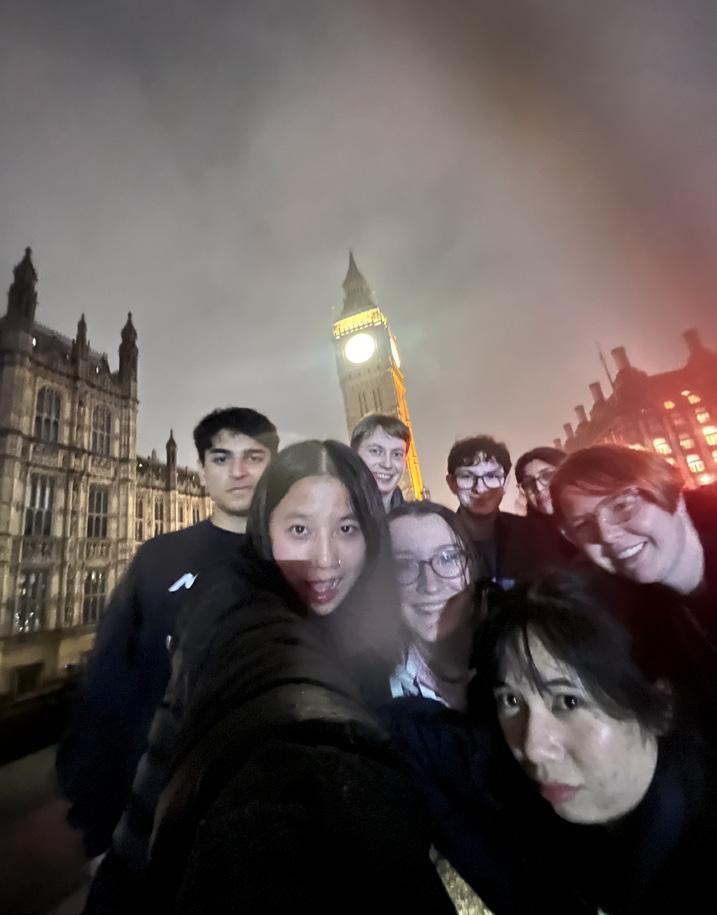 Rylie Oswald Al-Awhad
Rylie Oswald Al-Awhad
That night, the group went to see a production of King Lear. Before the play began and after a day of using the card with no problems, I just felt the need to look at it in my purse to make sure it was still there. I unzipped the pocket, and to my horror, it was empty. I immediately rushed to the bathroom in the ticket lobby to see if I had dropped it while there.
I had not.
Panic and irritation flooded through me in the middle of the women’s bathroom, and Fatima, who made the mistake of being at the sink while I was in my meltdown, pitied me. She accompanied me to retrace my steps down the street and to an Italian restaurant we had eaten at not even 15 minutes before.
The waitress said she’d seen no oyster card, sorry. We returned to the ticket lobby because seating for the play was about to begin, and we didn’t want to miss it. For the next two and a half hours of King Lear, I sat in frustration and anger with myself for losing an expensive oyster card. I told myself I would walk everywhere as a punishment.
Almost at the end of the play, something compelled me to flip my purse around and unzip the pocket on the other side. There was my Oyster card, seeming to gleam smugly. I had forgotten my purse had two outer pockets.
Most vacations are accompanied by any number of well-intentioned attempts at spontaneity. There is always the sentiment that one can do a little more, see a little more, find something more “authentic,” or indulge in the delights of traveling abroad to maximize one’s time in a new environment. These endeavors – though entirely respectable – often end up as a flawed attempt at achieving some personal metric of productivity. This approach ultimately results in a less authentic experience than one could have encountered without exerting any effort and simply letting experiences occur in a relaxed fashion.
On one fateful night in London, I found myself subject to this particular line of reasoning. I was tired after a full day of activities. Furthermore, I was aware of the fact that I was fatigued but felt the incentive to push through in the instance that I might discover a life-changing series of events that would otherwise be wasted (although there is truly no such thing) relaxing. So, my peers and I set off into the night with only a rough objective in mind: to see the Tower of London and associated landmarks. This plan in itself had issues, namely the fact that at 9 p.m. nothing was open, and we would be doing little more than looking at a building before moving on. Regardless, the spirit of adventure persisted.
A short journey later, we found ourselves along the Thames in the City of London. After walking along the river for a few moments and finding very little of note, my peers felt that a more exciting journey to our destination would be in order. By this point, my exhaustion had been slowly creeping up on me, to the point of realization that I would much rather delight in watching something on the hotel television before falling asleep. But the nearest tube station was a long walk away, so I searched for the fortitude to continue out of pure curiosity.
We came to the conclusion that a ferry ride would be the most interesting option, as we were already near the dock, and the schedule showed one arriving shortly. Even
 Nile Russo
Nile Russo

better, it would be compatible with our oyster cards! (A convenience which had no foreseeable consequences at the time...) It was when the ferry arrived that our problems began. While some of us boarded effortlessly, others were accosted with a red light informing them their card ran out of money and had to subsequently top up. As we were stepping onto the boat, a man gruffly asked us what our destination was, to which we were speechless, assuming that it operated similarly to a train, stop by stop.
Somehow, we were able to board, albeit with newfound paranoia. Firstly, I was not entirely certain where our destination was. Secondly, I was beginning to fret over the fact that I may have just spent the last of the money on my card, that I would not be able to get a train home (as I did not bring my wallet with me on this juncture), alongside a multitude of similar concerns. Both uncertainties would be unceremoniously revealed to me sooner than I anticipated. As we departed from the dock, I decided to make the most of my unfortunate position: I found ferries like this to be very cozy, so I settled in, ready for a pleasant ride if nothing else. Certainly, I would have a few good minutes to enjoy the ride and admire the scenery at the least? As I looked out the window, I noticed just how familiar the scenery was as the boat slowed. Then, to my horror, we began to glide toward a dock – not any dock, but in fact, one we had passed on foot minutes earlier. We had arrived at our destination.
As I took the train home that night (learning that our cards, in fact, had unlimited usage within zones 1 and 2, though I was now out of luck anywhere else thanks to the ferry), I reflected on the events which had transpired. In a roundabout way, I had certainly done something spontaneous, wasted seven and a half pounds, and gained a significant number of gray hairs, with the silver lining (monkey’s paw?) of a memorable experience. Though I can’t lie and say that I wouldn’t have preferred watching BBC and going to bed.
Even through my eyelids, the rays of light that peek around the corner of the curtains in our hotel room burn my retinas. My phone displays 2 p.m., along with a text from my parents about the absence of a trip report from the night before. Even without a face or voice, my phone screen still seems to judge me. I should have been furious at the sickness chaining me to my bedposts. I wasn’t angry. Even in retrospect, I am unperturbed by the time I spent with no view greater than the hotel wall.
You could say that while I was sick, I did nothing well. In fact, I did nothing fabulously. I ruminated on the nature of being sick, which is something the current writer-me is thanking past sick-me for. I formulated the basis for this essay. I ate carrot batons (yes, that’s what they call baby carrots there) and rewatched my favorite show, which never fails to stab me through the heart.
To think of only joyous times as valuable is such a waste, I think. I don’t mean the classic “good things are only good if you have bad things to compare them to.” I don’t mean “life is a sacred gift and to do less with it is blasphemy.” I don’t mean “make the most of a bad situation.” No, I mean “to be stabbed in the gut is perhaps
Joel Harrisonunpleasant but no less real than any other experience.” I mean “even at the lowest of lows we can find not joy as we may wish but a certain rough-edged ragged appreciation, like cutting through tough bread with a serrated knife.” I mean “life has always been more akin to acned skin than clear, to a forty-three-degree drizzle than seventy-one sunshine, to transience and loss than security and prosperity.”
Deep under the effects of boredom and medicine, I reveled. I reveled in the frustration of seeing the hotel wall instead of the paintings in the National Gallery. I reveled in the pain my stomach reported in acute detail. I reveled in the unique and unmistakable experience of living as a mortal being. I reveled in my word of the year, “impermanence,” both as it relates to death and my diminished time in London.
Truth be told, having less gave me more. Feeling worse made me feel better. Becoming powerless empowered me. Were those two painful days my favorite of the trip? No, but they weren’t my least favorite either. They were head and shoulders better than the fifteen-hour flight times and shitty airport food, at least.

“This isn’t as scary as I expected,” I thought as a walked alone to London Bridge from the Tower of London at 10PM at night.
I didn’t intend to walk around the area alone at that time. But I got lost.
I was with a lot of classmates from the program when we arrived at the Tower. The Tower itself was beautiful at night with lights shining on all the walls and the grounds below. So, I wandered off, not too far from the group, to take some pictures. I was facing the Tower so my back was facing the group, which lead me not to notice them walking off without me. Therefore, I was a bit shocked and surprised to turn around and see no one behind me.
Initially, I was scared and suddenly very aware of my surroundings. I was an Asian-American, petite, kidnappable girl in London alone. Therefore, I tried looking for the group by going up to the street. But I got distracted by the street view at night so I took some pictures when I turned my head and when I saw a large group of people walking to the London Bridge. So, I started following them and tried to recognize anyone. However, as I got closer and closer, they were not who I was looking for.
At that moment, I just accepted my fate. I was going to find them eventually; if not, I know how to find my way back to the hotel. Although, my balance on my Oyster card was devastatingly low. I tried to relax and enjoy my walk to the Bridge.
During that time, Fatima being a great roommate/friend texted me a couple of times asking where I was, which I told her my predicament. They were walking along the Tower of London, while I was at the Bridge. Ultimately, we decided to meet up at the Bridge.
I didn’t know how long they would take exploring the Tower, so I took my time on the Bridge. Breathing in the fresh air and taking pictures when I saw the view from it. I felt safer too as I crossed with all the bright lights and the presence of many people (perhaps tourists) justwalking. I even saw a group of kids with a guardian walking across, so I was honestly chilling. Though, half-
way across the Bridge, I ran into some cops, who were surrounding these two kids sitting on the ground. The kids seemed solemn and dejected as the cops started at them silently.
I swiftly walked passed, trying not to stare too much. Fortunately, I had just missed whatever just had happened.
Then, I had made it to the end of the Bridge. The group just got the Bridge. So, I debated whether to stay or go back to them. I wanted to go back to them, so I crossed the street and started walking on the other side of the Bridge. Because, I might as well see the other side of the Bridge while I’m at it. But, then they got to where I was pretty quickly, so I jogged back to them.
I reunited with the group and we took a group picture, then we left to our next destination. And, that is how I got lost at the Tower of London and London Bridge.




Nine articles detailing musings and provocations from various museums around London make up the “Artifacts & Oddities” gallery. This meta-museum of sorts highlights experiences had at the National Gallery, Natural History Museum, the Courtauld, the Tate Modern, and the Freud Museum.
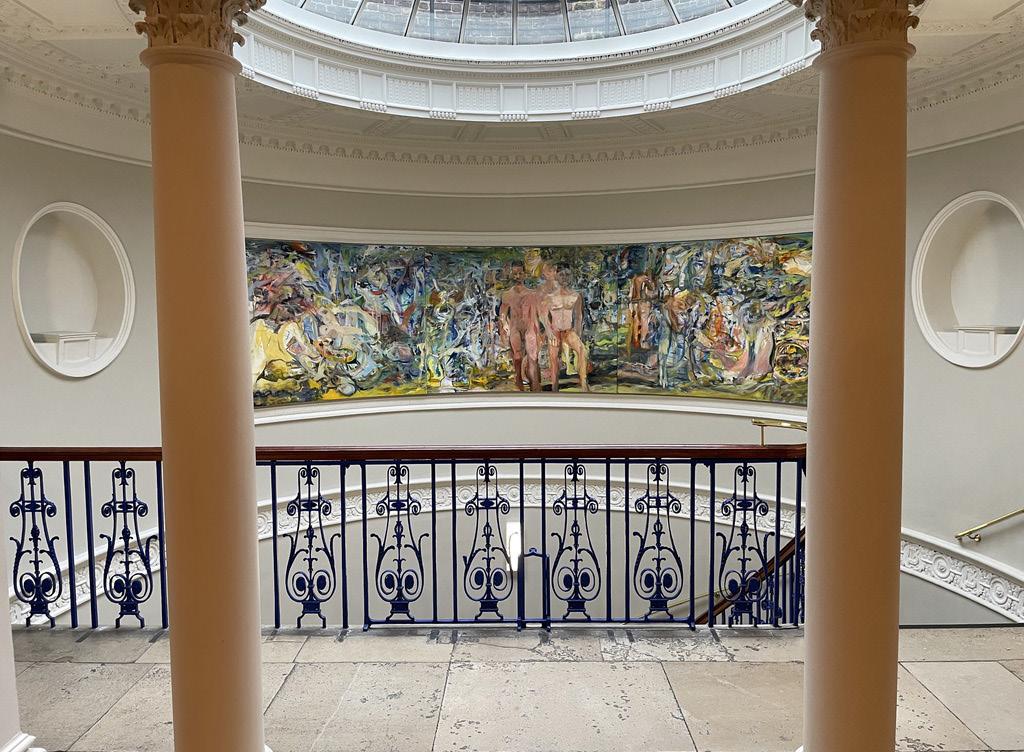
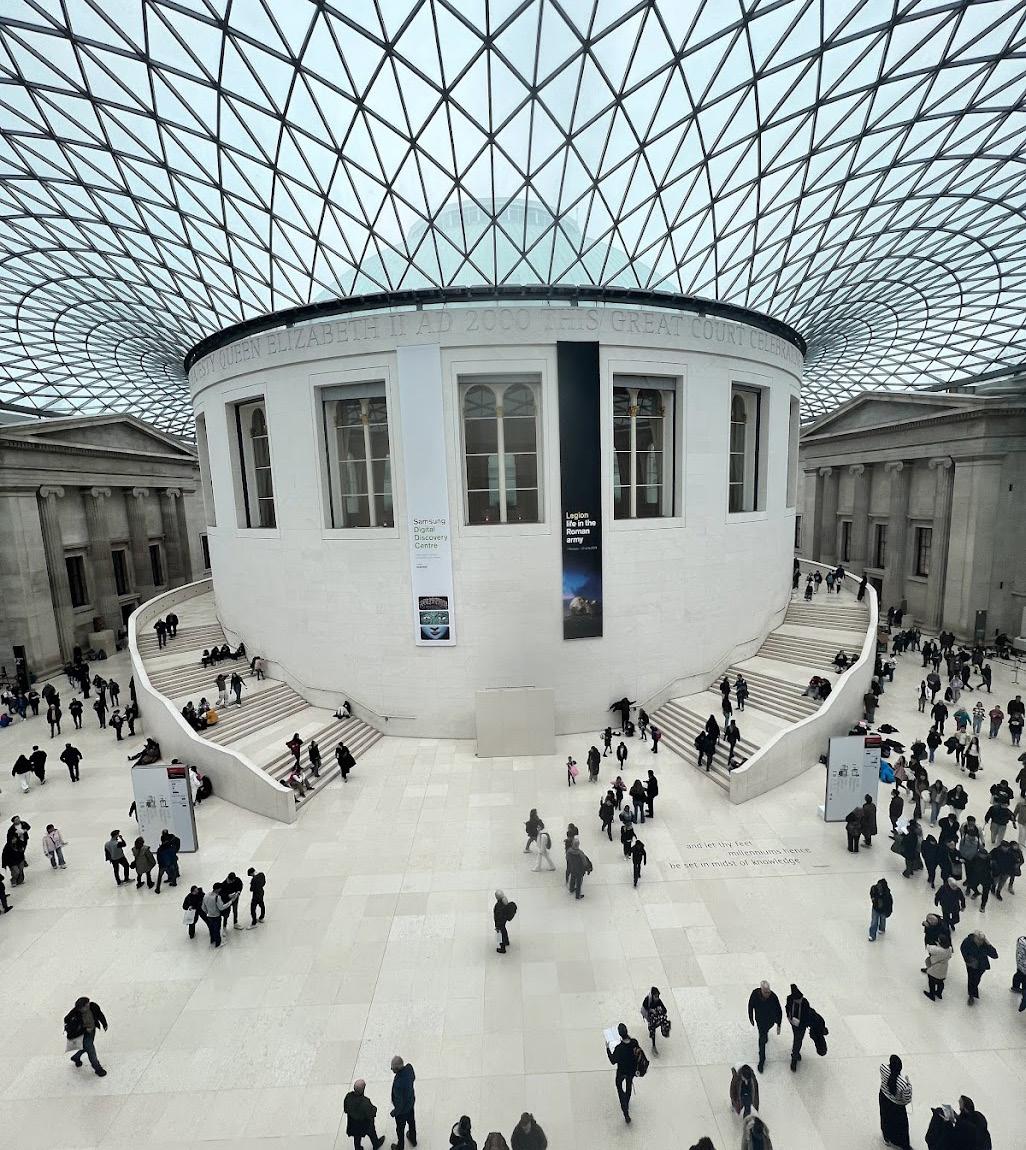
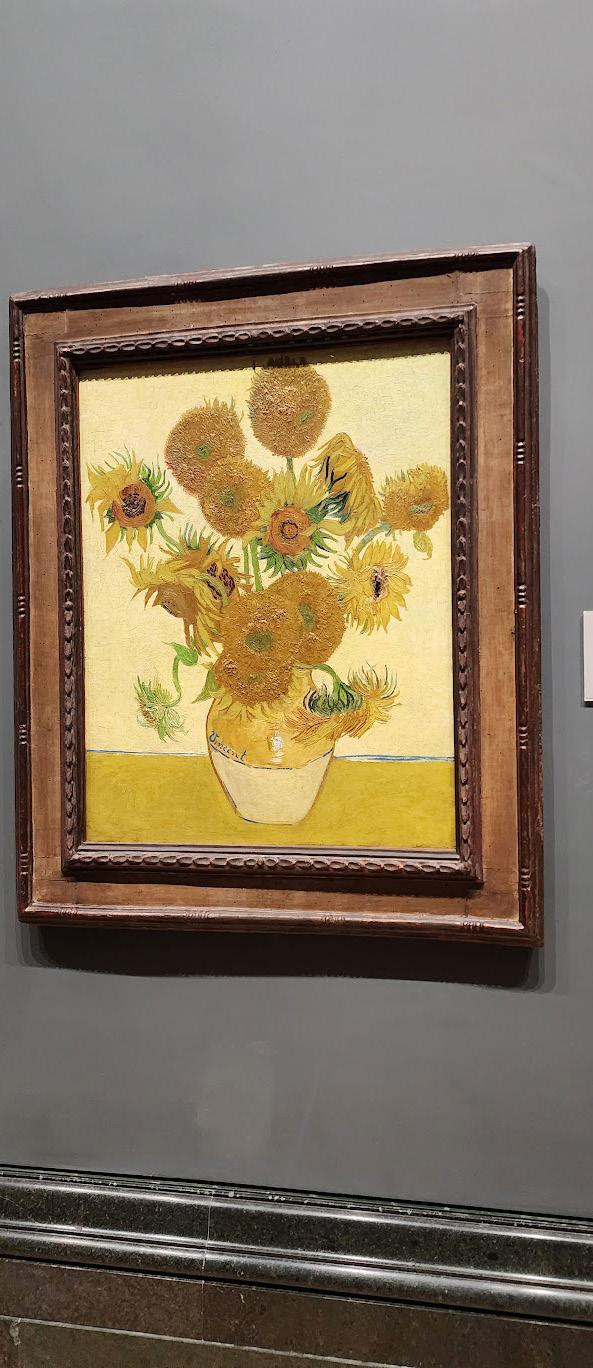


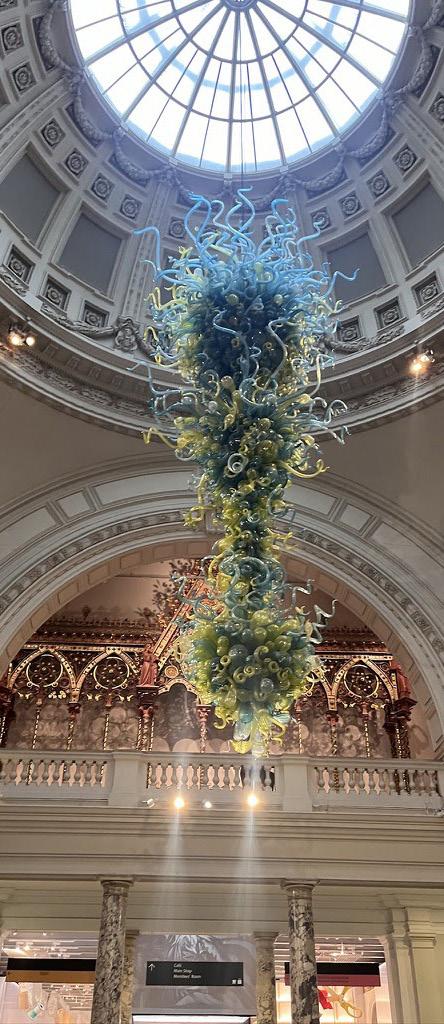



The National Gallery has several of my favorite paintings, and I specifically saved it for the last day, knowing that I was going to spend hours walking the rooms and taking it all in. However, spending that much time in a museum allows you the opportunity to not only observe the art, but also observe the other visitors.
What I saw astounded me. So many people walked quickly through the rooms, only stopping to take photos of the pieces they saw as more famous than the others, not taking any time to look at the art through any other lens but their camera’s. This phenomenon of documenting your visit to an art museum was especially apparent in the rooms that housed Van Gogh’s Sunflowers and Monet’s Water-Lilies, where people were stationed waiting for their chance to get up close -- not to see Van Gogh’s use of the texture of the paint on the sunflower petals, or to observe how the water lilies and the pond they reside in seem to move within the painting, but to get their photo op.
Since it is one of my favorite paintings and a piece of art that needs to be observed and taken in, I found a bench near the Water-Lilies to sit. While sitting, I watched the crowds move through the room, posing in front of the painting of their choice, and moving on. What I realized while sitting in front of Water-Lilies is that it isn’t enough anymore to see art or to go to a museum. You now have to be able to say that you saw the art and went to the museum. There must be documentation of your visit, otherwise what was the point of going? Art is no longer experienced, it is documented, and redocumented, and reposted, and shared, and commercialized, and so on and so on, until there is no need to see it in person anymore. The art of visiting museums is dying.
Even at the other museums I went to that week, which weren’t collections of highly known art, people were still taking every moment possible to document their experience. And I can’t fault them for that entirely – I love looking back at my photos to help me remember what I saw and did, and I wanted to be able to share what I saw with family back home. But there was a lack of reverence in most places; no consideration for the art or exhibit itself, or the history behind what was being seen.
As I started to walk away from the Monet and continue my journey through the National Gallery, I found myself taking more photos of art as I passed it. I too, want physical documentation that I walked through this museum and saw this art. After all, these are paintings that I’ve known about my entire life, and that I’ve studied in art history classes. However, I had made myself aware of what I was doing, and the last thirty minutes of my visit I spent with my phone tucked away in my bag, giving the art around me the attention it rightfully deserves.
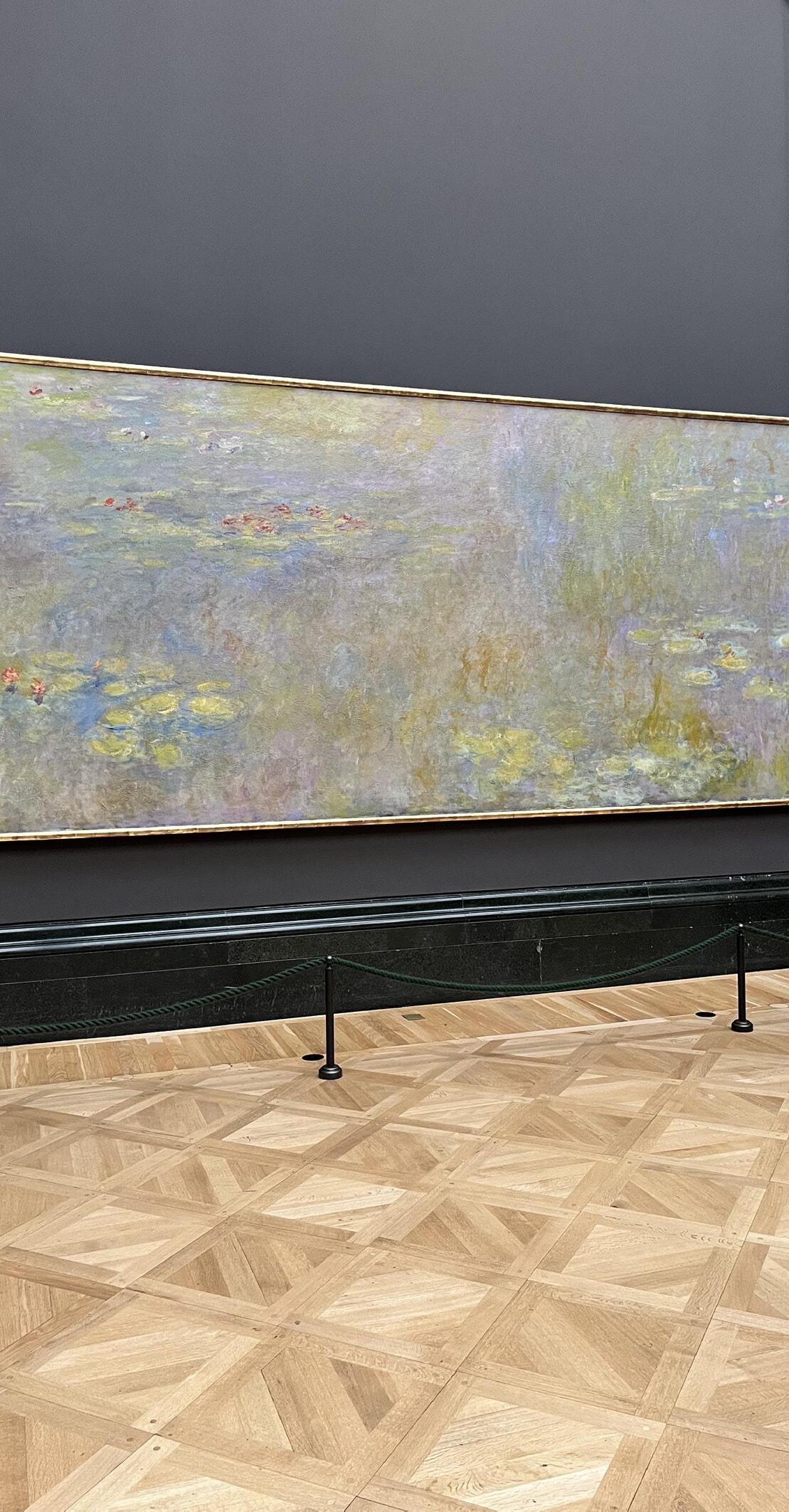
On the sixth day of being in London, I woke up with my sights set on visiting the Natural History Museum. It was an overcast morning (as they all are in dreary England), and I was ready to go on a solo mission. I obtained several of my peers’ reviews of the museum, and just as they had warned me, I was immediately surrounded by swarms of schoolchildren. Like the children, I was buzzing with excitement to see the inside and what treasures it held – although I preferred to skip over the animatronic dinosaur exhibit with a more refined destination in mind.
After a brief wait in the queue, I navigated through the winding corridors of fossils, models of sea creatures, portraits of famous collectors, and more tiny, rambunctious museum-goers herded by their exhausted chaperones. Tucked away in a dark back hallway was the ticket booth for the Wildlife Photography of the Year Exhibit, where I eagerly paid my twelve pounds and began my emotionally charged journey through our natural world.
Maybe it was jet lag or being away from home, but I was thankful I brought tissues in my tourist-grade fanny pack because I never suspected images of a Horseshoe Crab to make me so emotional. A killer whale taking its last breath, Nubian ibexes clashing on a mountaintop, and parasol mushroom spores floating enchantingly in the warm glow of an autumn sunset illuminated the walls. The flow of images brought me back to a curious, childlike mindset. Imagining the photographers immersed in each landscape, waiting to capture just the right moment, filled me with thrill. Simultaneously, it broke my heart as most of the images suggested the bleak future in store for our planet due to human activity and climate change.
American representation in several of London’s museums proved to be rather embarrassing, with Kim Kardashian’s published book of selfies on display in the Victoria and Albert Museum. Although there were no Kim Kardashian sightings, the Wildlife Photography Exhibit was no different. The Photojournalist Story Award featured six images of Texans, armed to the teeth, sporting camo and trucker hats, lugging the corpses of hundreds of bobcats through a field.
Becca JonesAll the photographs invoked a sense of responsibility in the viewers - A reminder that we are not the only beings to inhabit this planet and our actions can have severe consequences. While we are leisurely roaming the streets of London with a £7 latte in hand, on the other side of the globe, or maybe very near to us, another species is on the brink of extinction.
During the trip, there were several reminders of the difference in environmental conscientiousness between the British and Americans -- restrooms had no paper towels, restaurants didn’t have plastic takeaway utensils, and convenience stores provided a much larger array of glass water bottles to choose from instead of plastic. Traveling internationally, noticing these differences, and then seeing the global impact of human activity through The Wildlife Photographer of the Year Exhibit accentuated the importance of erasing borders and taking control of the power to conserve this shared planet we all call home.

Sigmund Freud was an Austrian neurologist turned “Father of Psychoanalysis” who coined “the talking cure” for shell-shocked WWII veterans. Not all of his findings have held up over the years; as it turns out, not every child subconsciously desires inappropriate relations with the parent of the opposite sex. Despite several of Freud’s scandalous ideas, he was vastly influential, and his popularity took on a global scale. In fact, during my visit to his final home in London, the special exhibit was Freud in Latin America (he never did visit Latin America, but he received tons of fan mail).
A brief tube ride and neighborhood walk led me to the bright blue front door of Freud’s final home, 20 Maresfield Gardens, in Camden. Sigmund and his family, notably his daughter Anna, fled Nazi-occupied Vienna for London in 1938. While Sigmund only lived in the home for about a year before passing away, his daughter Anna occupied the home for about another 40 years, during which time she carried on Freud’s legacy as a psychoanalyst. The house had a beautiful backyard and garden, which visitors were prohibited from walking on, similar to the green spaces in Oxford squares.
Exploring the first floor, I took my time to read all of the plaques installed next to the family photos and heirloom antique furniture. By doing so, I learned Freud was actually quite the dog person. He was fond of his Chinese Chow, Jofi, who routinely attended Freud’s therapy sessions, napping (or perhaps eavesdropping) and then getting up
and exiting the room right at the end of the hour – it is said that Freud never needed a timer because Jofi always ended the session right on time. With the therapy sessions in mind, I went straight to the most notable spot in the home – Freud’s study.
The room was covered in Persian rugs: on the floor, tacked to the walls, and the psychoanalytic couch, the most famous piece in the room. The couch had a particular aura; I could see how someone would lay down on it, with all its cushy, luxurious pillows, and share all their deepest, darkest thoughts. Unfortunately, the couch and all the other items in the study were roped off. However, upstairs was a model of the couch for geeky psychology enthusiast visitors such as myself to snap some photos on. One of the last plaques I read in the study explained it was the room Freud passed away in via euthanasia (lethal dose of morphine, for those morbidly curious) in September of 1939 after a long battle with oral cancer. I entered his study with enthusiasm and left feeling rather unsettled, similar to a lot of psychology professionals before and after reading Freud’s work.
 Becca Jones
Becca Jones
On a lighter note, as a plant lady, I was excited to be greeted with Painted-Leaf Begonias as I climbed the stairs to the second floor. Several plants propagated from Freud’s own collection filled the second-floor windows, Begonias being his favorite. Standing on the landing halfway up the stairs, surrounded by plants formerly owned by Freud himself, I felt like I had reached the zenith of my college career as a Behavioral Neuroscience major. I left the Freud Museum that day feeling a sense of accomplishment; after studying neuroscience for the past four years, I had actually walked the same halls as the Father of Psychoanalysis.

I like shiny things. If I were a fish, I wouldn’t last a single day before biting down on a shiny hook, then being served up with a heaping side of French fries. *ahem* Sorry...chips. So, it was no surprise that I managed to get quite distracted in the Natural History Museum’s geology vault. I truly was helpless. With my love of shiny things combined with an environmental science major, the vault was almost asking me to become a permanent resident.
As soon as I stepped foot in the vault, I knew I was a goner. I was met with a wide variety of precious stones, metals, jewelry, and even ancient meteorites. And guess what? A lot of them were shiny. Now any average person might just give each specimen a glance, move on to the next, and be in and out. However, when I started making my way around the room the spirit of a tortoise descended upon me. And you know what? Slow and steady really does win the race. I read every single placard and admired each object, entranced by their uniqueness: color, size, and of course, shininess.
However, when I had only made my way around a quarter of the room, I encountered a roadblock...a video screen describing nearly every specimen in the room. Sign me up! So, there I stood, feet plastered to the floor and eyes plastered to the screen, taking in every bit of information about the rocks and gemstones around me. Scientists who are passionate about their fields educated me about the geologic phenomena on my left and the ancient meteors on my right.

However, the specimen that left me the most dazzled was the Aurora Pyramid of Hope. Consisting of 296 different colored diamonds, the exhibit acts as both a scientific display and work of art. This piece, which took over forty years to assemble, is named after the aurora borealis. Colored diamonds are quite rare, and only 1 in 10,000 is considered fancy – outside the typical colorless to light yellow range. According to one of the curators of the piece, Alan Bronstein, he sees the pyramid as relating to humans. After all, diamonds are made of carbon and so are we.
However, the diamonds in the piece are also said to act as a metaphor for the natural diversity of the Earth. Whether it’s in their color, shape, size, or cut, every single diamond is different. Additionally, due to their chemical makeup, which also gives each diamond their specific color, the diamonds exhibit a unique property in that they can glow under UV light. I personally see this as a symbol for how at face value our personalities may not be seen, but in the right light, we can truly shine and be ourselves. Finally, it shows how after going through pressure and hardship, we can emerge stronger, and more beautiful than before.
Now, after being entranced by a cursed amethyst, crystalline gold towers, the oldest thing I will ever see (diamonds made from stardust in a meteorite), and so much more, I was torn away by my fellow London Reviewers. After all, we were on a bit of a time crunch. Now, the next time I go to London, my goal is to see some even shinier things... the crown jewels. However, this vault might be a bit harder to break into.
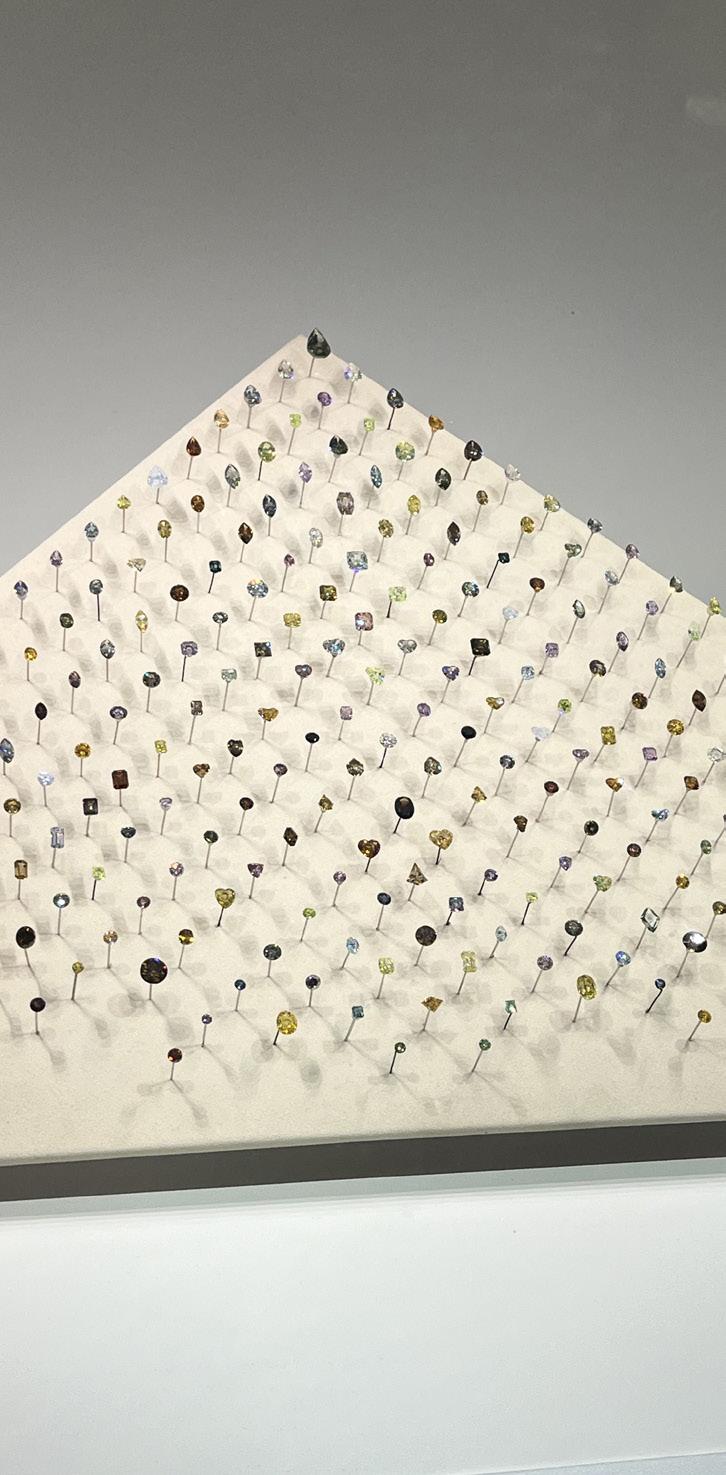
Oxford is one of, if not the most, prestigious universities in the world. Going there as a tourist you might not get the full experience, but the experience I had was one for the ages. The day we went to Oxford was a rainy one, but something about that just felt right. Having to watch out for puddles as we walked through a beautiful town with our umbrellas out felt just the way I pictured Oxford would be. For me, the allure of Oxford is how timeless it is. Just by looking at the buildings, one can tell that these buildings were the product of an era long ago. While the buildings themselves might be old, the people of Oxford have done a phenomenal job of maintaining them without taking away from their history by modernizing them.
By this point of the trip, I was a little bit museum-ed out, but I had heard how great the Museum of Natural History was. I figured since we were only going to be in Oxford for one day, I probably should check it out. I’m so glad that I did, as this was my favorite museum of the entire trip! Walking into the museum, you’re greeted with skeletons of animals to scale. They had skeletons of extinct dinosaurs including T-Rex, Triceratops, and Pterosaurs, and animals like crocodile, bull, elephant, and giraffe. Name an animal and they probably had a skeleton or a fossil of it. I was blown away by how remarkable those were. And the fact they just had cast out in the open only added to my amazement. The Museum of Natural History in Oxford houses a second museum within it called the Pitt Rivers Museum. The Pitt Rivers Museum has a lot to it, but my favorite aspect of it was the look into ancient civilizations and cultures. They had clothing, armor, weapons, and other items people of the past used in their everyday lives.


I enjoyed seeing the difference between these items, especially the weapons they used because you could see alterations to each throughout the years and throughout the different civilizations. The entire time I was walking through these museums, I felt like a kid in a candy store. Everything was so exciting and interesting.
As much as I enjoyed the Museum of Natural History, I enjoyed Saint Mary’s Tower even more. Saint Mary’s Tower is one of the tallest places in Oxford, and tourists can climb up the 127 steps to the top. The climb was daunting – not because of how many steps there were, but because of how narrow the spiral was. It was so narrow that only one person could fit in the path at a time: as we went up, we had to occasionally step into crevices to make way for the people heading down. This is yet another example of how you feel like you’ve stepped into a bygone era. Once we made it to the top, I was again in awe. Seeing all of Oxford from such a high vantage point was truly a sight to behold. The walkway at the top of the tower circles around, so we were able to see Oxford from 360 degrees.
What makes Oxford so special is that there’s nothing quite like it back in the United States. Sure, you can go to the top of a skyscraper in New York and see the whole city, but you’re looking at a modernized world. With Oxford, you’re getting to peek into the past. Just from walking around, I felt that I had traveled back in time. While some places in the United States have traditions and keep old buildings alive, none will ever come close to Oxford’s allure to me. Oxford is truly the pinnacle of prestige and timelessness.


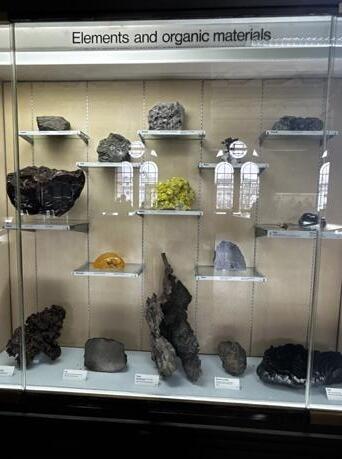
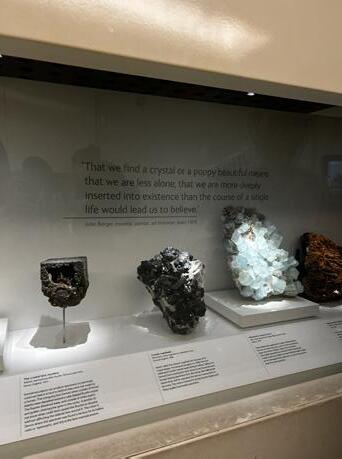

As a student enrolled in predominantly science classes, I was decidedly against the idea of interacting with anything remotely science-related in London. The trip would have to be dedicated to only learning about the humanities and simply just living in the moment- away from the storm of classes and homework I had waiting for me back in Lawrence. I succeeded at this for the first couple of days, until someone mentioned The Natural History Museum.
When I walked into the museum and saw the skeletons of dinosaurs and the giant whale, I was completely in awe. As I floated through the museum, with kids in bright yellow vests zipping in front of me, I arrived at the Geological Museum and almost walked right by it. Why would I want to enter a room filled with rocks? But the large blue Ostro Stone, as big as my hand, really drew me in.
When I first thought of the concept of geology, all I could picture in my head were gray and black rocks- igneous, metamorphic, and sedimentary. To me, they were dull and uninteresting compared to all the other subjects you could possibly study within science. But as I began wandering this huge hall, most of the rocks and minerals that were displayed had incredibly complicated chemical formulas and ranged in colors from neon yellow to marbled teal, all in different shapes. I quickly realized that I would be there for a while.
 Bhavya Gupta
Bhavya Gupta
As I looked at the vast number of rocks, I was able to connect their chemical composition and the different reactions they undergo with my current learning in chemistry. It was strange to see the real-life applications of concepts that I had only learned about on paper and exams. There were minerals on display that are useful to make matchsticks, circuit boards, and toothpaste. Even more, there were cases upon cases filled with elements found on the periodic table as well as organic materials. Again, seeing what I had been studying for so long, the present in front of me left me incredibly interested in geology.
The experience that solidified a new interest of mine was The Vault at the end of the large room. It was filled with the most colorful minerals, so naturally I gravitated towards it. While the minerals were extremely interesting to read about, the museum also displayed quotes above some of the displays that really put those who have a fascination with such small, human things into perspective.
“That we find a crystal or a poppy beautiful means that we are less alone, that we are more deeply inserted into existence than the course of a single life would lead us to believe.” -John Berger, 1926
And in a display of gold minerals: “Gold is the child of Zeus, neither moth nor rust devoureth it but the mind of man is devoured.”
One of the destinations I looked forward to the most in London was the Courtauld Museum at Somerset House. Admittedly, I didn’t know much about this building except that it houses an impressive collection of impressionist pieces (my favorite period of art) and that it holds the Bar at the Folies Bergère by Eduard Manet, one of my favorite works of art. Approaching the Somerset house, I anticipated the museum being quite large, but the Courtauld itself takes a surprisingly small amount of space. It is a ticketed museum, luckily with a free student option, and once you enter you can make your way through pretty quickly. There are 3 small gallery floors above the lobby, the top of which houses the impressionist exhibit.
Predictably, I made a beeline for those rooms and quickly found myself entirely overwhelmed. These small rooms hold so much brilliant art that I had a hard time taking it all in. From pre-impressionist works like Manet’s Bar at the Folies Bergère to post-impressionist works such as Seurat’s Young Woman Powdering Herself, I fell in love with all of it. And, possibly my favorite part, because the museum is so small and not quite as famous as, say, the National Gallery, I found myself not being rushed through, but appreciating each work to its fullest. I was able to have a personal and intimate experience with these masters of light and form without feeling intruded on at all.
One of my favorite experiences came while I was looking at the Folies Bergère when I noticed two

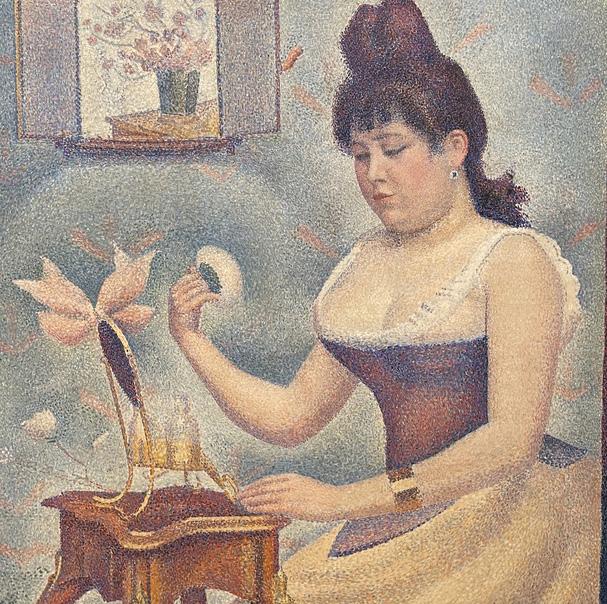
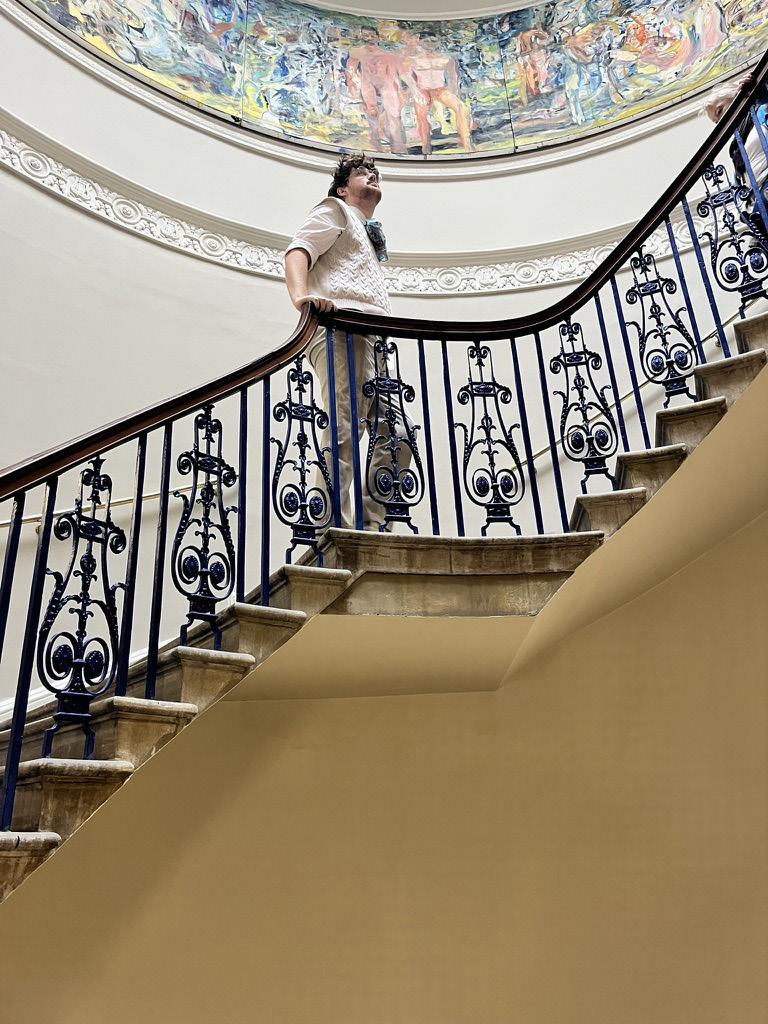 Connor L Maloney
Connor L Maloney
British gentlemen who had clearly read the plaque next to the work but were having trouble understanding the concept that the painting is a mirror. So, a little embarrassingly, I stepped forward and attempted to explain what was going on, being sure to specify that I had studied this work in art history courses and had not come to these conclusions on my own. What followed was a delightful exchange of ideas, me with the painting and them with a little about British cultural history and afterward, I found myself extremely grateful to have gotten to be a part of their experience with this work. Even in the smallest of ways, I may have helped someone appreciate art a little bit more, and perhaps aid in their own personal revelation through the piece.
After spending around an hour or so wandering through the galleries I decided that, while I was thoroughly enjoying myself, I wouldn’t be able to fully appreciate the art pieces all in one day and would have to come back again later. After three days, I had an opening in the morning, went back again, and was incredibly grateful I did. It is one of those experiences that grow and change each time you seek them out and if I were to someday live in London, I would certainly be spending a lot of time at the Courtauld.

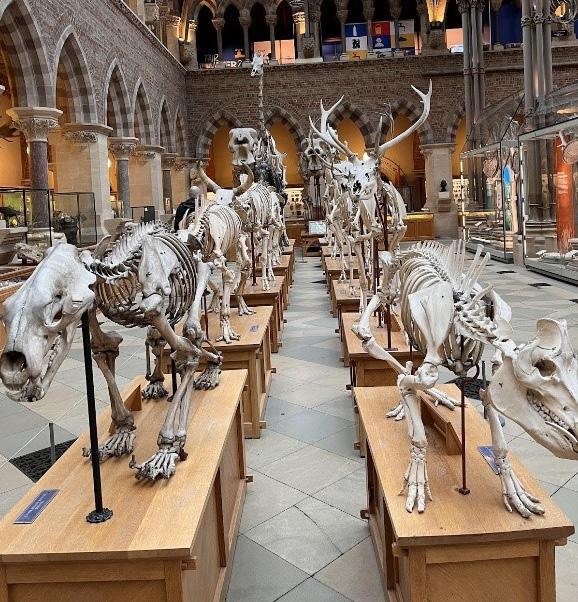
 Elena Pacioianu
Elena Pacioianu
After three midterms within the two days leading up to our departure, the last thing I wanted to think about was schoolwork. As glad as I was to be away from textbooks and lectures for the week, I couldn’t help at least exploring my field of interest on the trip. With two natural history museums and a science museum, I was ecstatic and ready to spend hours at each.
While I love museums, I’m guilty of being more of a looker, rather than one who stops to read each and every plaque. People, me included, may graze over the fancy taxonomic names and turn their attention to whatever creature is staring back at them. However, my experiences at these natural history museums were different. Surrounded by casts and specimens dipped in formaldehyde, I had flashbacks of sketching them in the lab and late nights of trying to memorize their names. Last semester, I took an excruciating yet interesting class, “The Tree of Life,” that discussed nearly all major life forms; from bacteria to fungi to plants to animals – we covered them all. It was neat being able to actually understand these names and see them applied in an exhibit. One of my favorite displays was a row of mammalian skeletons at Oxford. Examining each one’s hooves and teeth, we made a game out of guessing which animal they belonged to. There were many members of the deer family and the skeleton that surprised us the most was a pig.
Though not many from my group were interested, I decided to pop by the British Science Museum to visit its medical gallery. Due to timing and the seas of school children who weren’t too far from my height, that ended up being the only part of the museum I saw. After weaving my way through an engineering exhibit, I was immediately drawn in by the dimly lit instruments and models of the gallery. Its contents included the history of several medical devices and procedures, wax figures depicting every layer of the human body, and even somebody’s arm. The highlight for us was a display of diseased organs. Still on the theme of guessing games, we attempted to identify them. I was considerably worse at this game, given that I haven’t taken anatomy yet and they all had the same lifeless hue. This collection offered everything from lungs to blood vessels to a uterus.
I didn’t buy anything from the natural history or science museum gift shops, but they did satisfy a strange itch for gnarly specimens and cool skeletons. Out of the countless museums London has to offer, these had to be my favorite (along with the V&A). Being the first museums that I visited after my Tree of Life class, they gave me a new appreciation for the hard work biologists put into these kinds of exhibits and helped me gain a new perspective of natural history.

As someone who isn’t particularly into art, I spent a surprising number of hours exploring art galleries in London than one would expect. Wading through swarms of eager visitors at the National Gallery, I (hurriedly) viewed renowned masterpieces like Van Gogh’s Sunflowers or Monet’s Water-Lily Pond. In rooms with relatively less prominent artists’ works—and no crowds—I discovered new favorites, including Canaletto’s intricately detailed paintings of eighteenth-century Venice—many depicting extravagant ceremonies in the city canals—and modernist Ferdinand Hodler’s The Kien Valley with Bluemlisalp massif depicting a verdant Swiss landscape. Going through the National Portrait Gallery almost felt like walking through time as I observed the art of portraiture evolve in content and style, from the large stately portraits of the Tudors to the contemporary vibrant portraits of the Jamaican Windrush generation. Although both galleries had outstanding artworks, I don’t think either holds up when compared to the Tate Modern.
Unlike the traditional paintings and sculptures at the two National galleries, the works at the Tate Modern are more experimental. Artist León Ferrari’s description of art as “effectiveness and disruption” rather than “beauty or novelty” sums up the focus of many works on display. The gallery houses works on a diverse range of mediums, themes and ideas, with some artworks blurring the lines between what is or isn’t traditionally considered “art.”
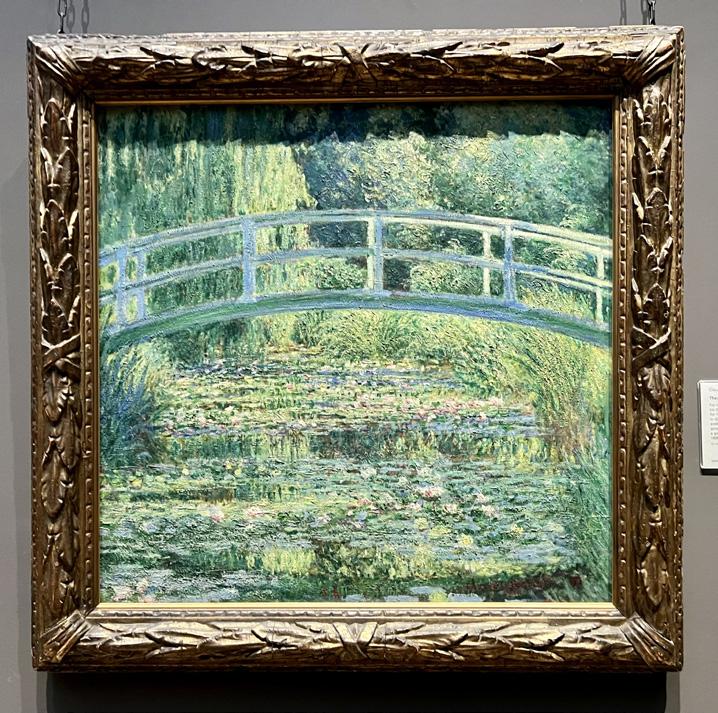
Viewing Sol Goldman and Alex DiLorenzo Manhattan Real Estate Holdings, a Real-Time Social System, as of May 1,1971 by Hans Haacke was one such instance that compelled me to ponder how maps and a list of 350 Manhattan buildings could be considered art. Haacke’s work occupies a full wall and consists of almost nineteen differently sized frames— twelve of them contain pictures, addresses, values, etc. of each building under Goldman and DiLorenzo’s real estate “empire.” In line with Ferrari’s description, this artwork is a sort of a “disruption”—a deviant from surrounding works in both form and content. Almost journalistic in nature, it exposes the extensive monopoly of the Goldman-DiLorenzo partnership embedded in 1970s’ New York.
Apart from displaying avant-garde artworks, the Tate Modern is also commendable for the diversity of artists and communities it represents. One installation that particularly caught my attention was by Siah Armajani, an Iranian-American artist. Armajani’s Seven Rooms for Hospitality is comprised of seven smallscale models that deal with issues of migration-
One of these models is a truck titled Room for Asylum Seekers. According to its description, the model is a replica related to an incident in 2015 when “seventy-one refugees and asylum-seekers from Iraq, Syria and Afghanistan were found suffocated” inside a similar truck.

The truck model—and the artwork as a whole—forces viewers to grapple with the realities of migration as they purview haunting symbols of the dreadful conditions/“rooms” refugees endure during their journeys to seek asylum throughout Europe and America. In contrast to Armajani’s work, which has a broader international appeal, is Bob and Roberta Smith’s Thamesmead Codex, which is focused on the small community of Thamesmead, London. The installation features interviews of Thamesmead residents taken between 2019 and 2020.
Residents span a range of ages, professions, and nationalities; their interviews are just as wide-ranging covering issues of swan mutilation in the neighborhood (!) to coping with Covid-19. Each individual’s story serves as a brushstroke that forms the larger painting of the Thamesmead neighborhood itself—an intriguing dynamic of community during a time of isolation in the early months of the pandemic.
The works I shared above are only a few of the vast array of evocative artworks at the Tate Modern. Each work offers viewers a new perspective of looking at not only art, but also our wider world. In hindsight, the Tate was my favorite of all the galleries I visited precisely because of how much it expanded my own perception of artwork grounded in activism, “disruption” and change. Don’t get me wrong though—the National Gallery and National Portrait Gallery house pretty amazing artworks too.

• Madame X - John Singer Sargent
• Ophelia - John Everett Millais
• El Anatsui
• Haystacks - Paul Gaguin
• Performance Still - Mona Hatoum
• Sewing Beside a Window - Pissarro
• Degas Unfinished Ballet Dancers
• Apollo statue in the Sir John Soanes Museum
• Golden Gallery of St. Pauls Cathedral
• Fashion displays in Harrod’s
• Van Gogh’s Sunflowers
• Eclypse 1978 - Nabil Nahas
• A Shipwreck in Stormy Seas
• The Kien Valley with the Bluemlisalp Massif - Ferdinand Hodler
• The ceiling of St. Paul’s Cathedral
• The Execution of Lady Jane Grey - Paul Delaroche
• Tiles From the Tomb of Buyan Quli Khan - at the V&A
• Self-Portrait in a Straw HatÉlisabeth Vigée Le Brun
• Elephant Statue in V&A
• Lego Big Ben
• Wildlife Photography of the Year
• Water Meadow Near Salisbury - John Constable
• Shrine in V&A
• Daoist Ritual Robe at the V&A
• The Cast of Trajan’s Column at the V&A
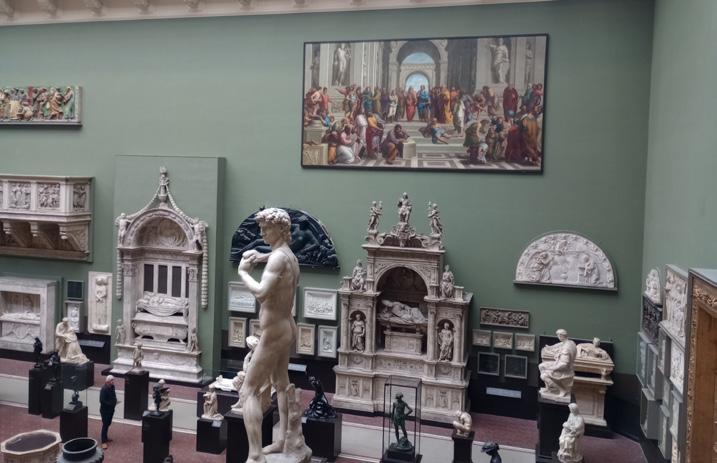
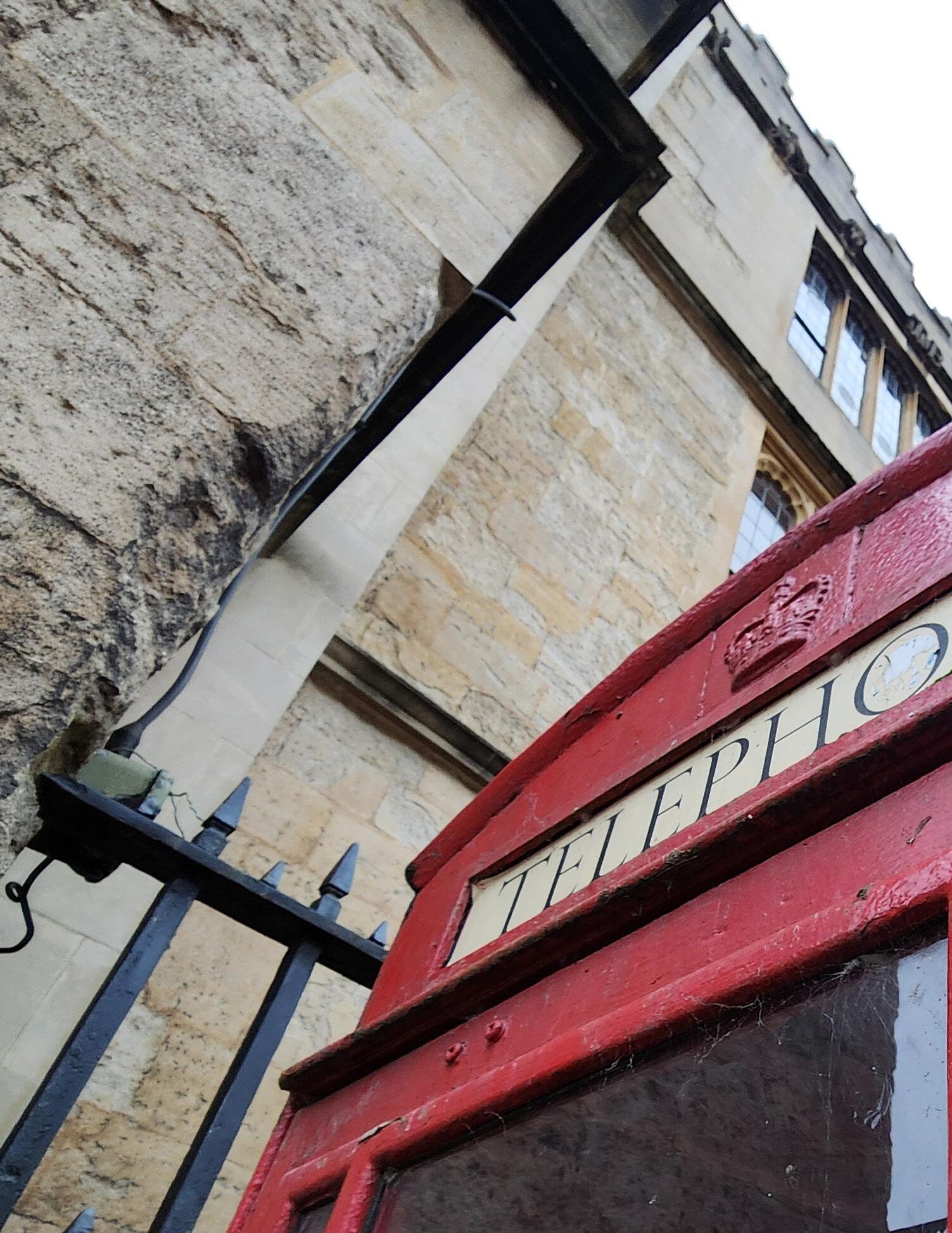
“Mind the (Cultural) Gap” commemorates the times that travelers were forced to be painfully aware of their American ideals. Playing off of the phrase blared through the speakers of the tube station, this gallery shows just how everyone adjusted in their own ways.
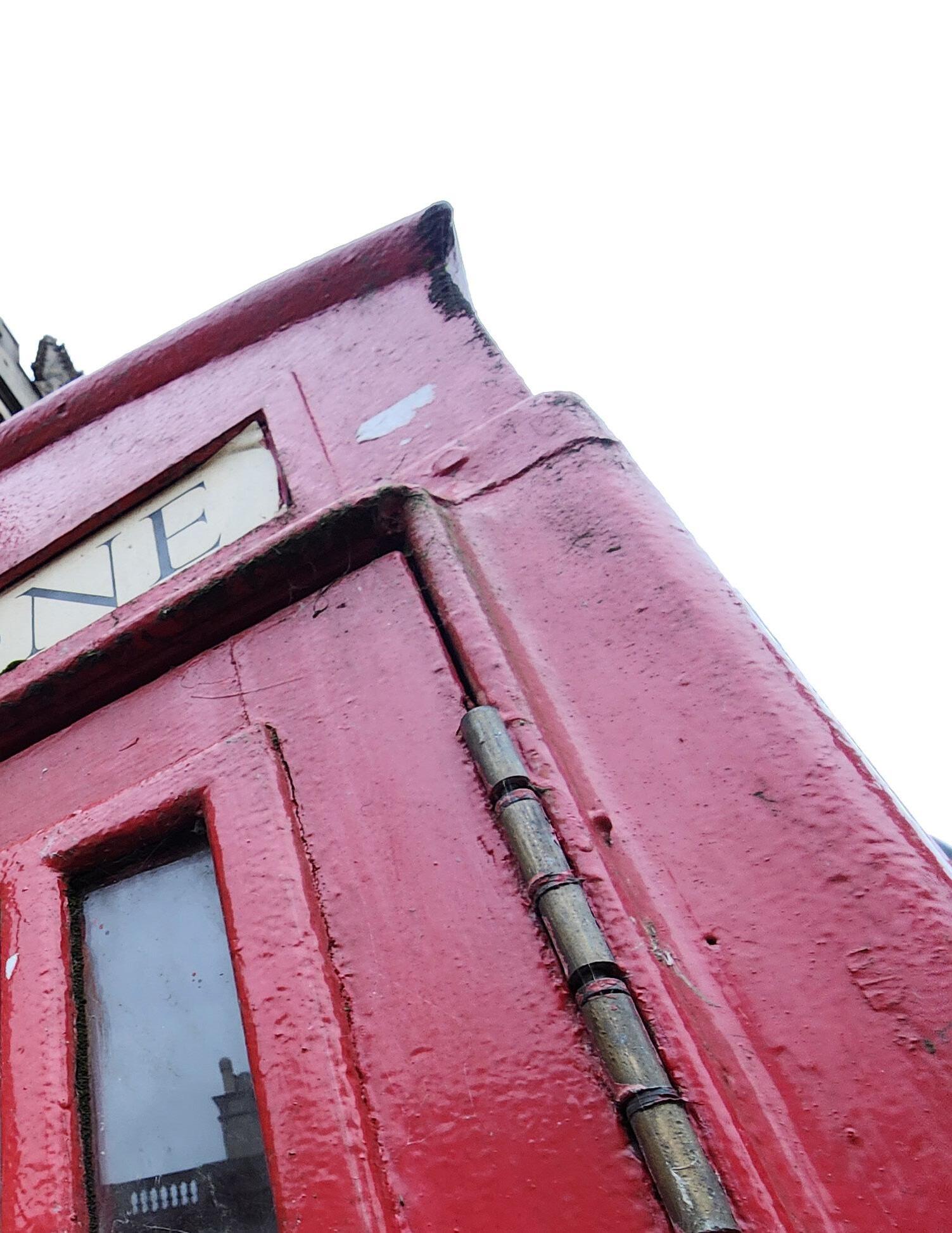
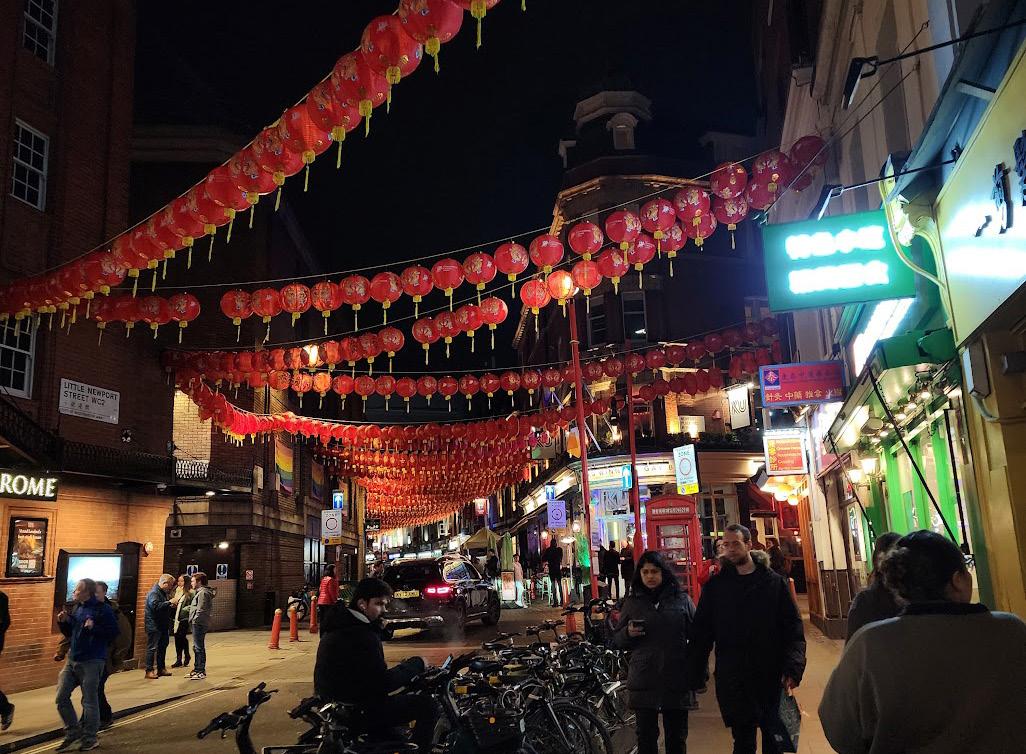
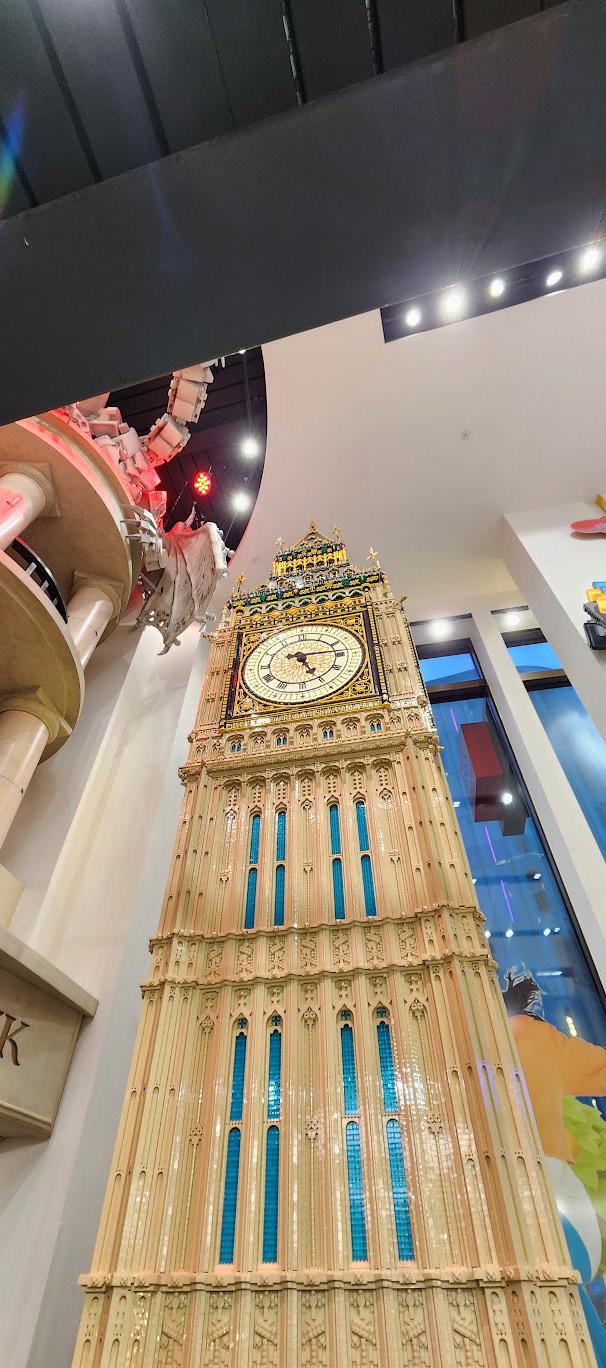


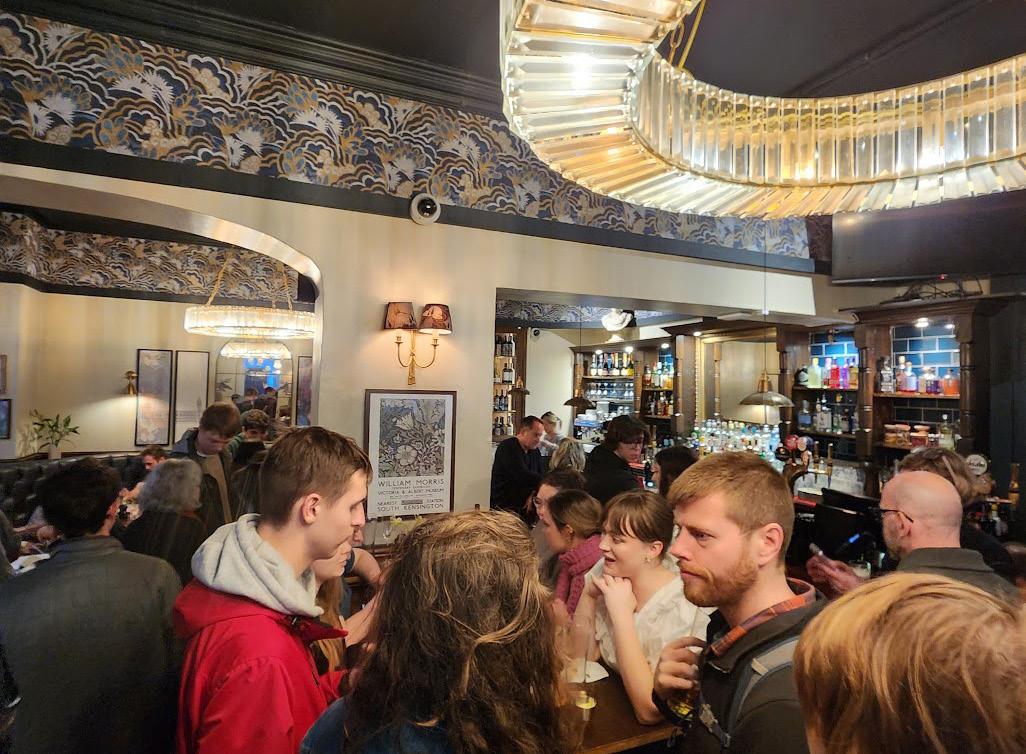
In the very fiber of my being, every strain of DNA, every adenine, cytosine, guanine, and thymine, holds the word “ope” within it. It feels as if I am committing a cardinal sin by even labeling “ope” with the title of word: instead, it is an instinctual, guttural, Neanderthalic syllable that spews from my mouth at any sign of human contact, disrespect, or general awkwardness. It is surely one of the first noises of every wheat-stuffed Kansas babe. Ad Astra per Aspera, To the Stars Through Difficulties—No! The Kansas motto is wrong! Ope Through the Difficulties! Ope to the heavens and beyond!
Even on the first leg of my journey, as I arrived in JFK, I was witness to the distance the land of ope now held. In the bustle of the airport, a man would brush by me, a suitcase momentarily cut off my path, but no remarks of regret were uttered, especially ope. So, when I would inevitably intrude on someone else through sheer accident and I would utter that noise, it was a distinct cultural marking, a scarlet letter forever branded to my chest. A word that once felt so natural, so kindly and polite, had become alien and rude simply because the audience had changed; their tastes were not for ope.
This feeling only grew once I arrived in London. There

remains a distinct divide between country and city life, and there remains an even greater divide between American and English cultures. Ope and I were at odds against both chasms, and I had not the time to attempt to cross them. At first, I could try to minimize the ope, cover the constant apologies, and unshift the muscles of my face from the little half-smile that creeps over when you and another’s paths intersect. I became acutely aware of every Americanism I held. Every ope became a firework, bald eagle, and Mount Rushmore rolled into one.
But ope was not the only culprit. “Sorry” had become just as prevalent, and the dreaded combination of “Ope! Sorry!” was spoken at least a hundred times per crowded museum I visited. Another less common but just as culturally disruptive phrase was “Thank you so much!”, a line that surely was off-putting to whatever wait staff or cashier I interacted with. At a record store in north London, the cashier threw in a free button (of approximately a thirty-cent value) with my purchase of two used records, and I expressed my appreciation with the bold “Thank you so much.” As an American, I am inherently loud and expressive within the grim atmosphere of London, so this, combined with my phrasing, caused the cashier to reply, “It’s just a button,
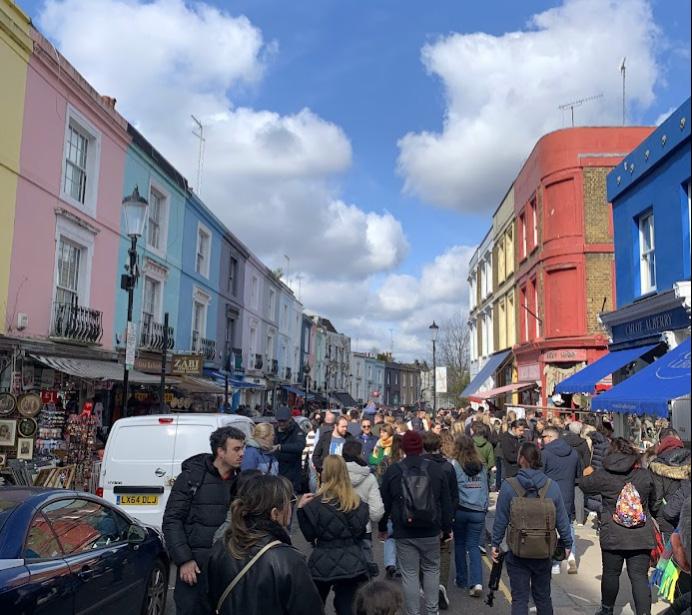

mate—it’s not a big deal.” But it was! In the Midwest, even the slightest gesture of going beyond the expected, especially in the service industry, must be given a “Thank you so much!” and a smile. A waiter tweaks a meal to your request: “Thank you so much!” A retail worker bends a store’s return policy in your favor: “Thank you so much!” It’s the extra effort and human care that warrants the “so much,” but I must apologize to any London workers to whom I caught off guard with my enthusiasm for their kindness.
It was after a few interactions like these (and a fair bit of Yankee-Doodle confidence) that I embraced the Americanisms within me, I gave way to the river of ope. I terrorized the streets, the subways, the stores— nowhere was safe my syllables! I was given looks, I was given glares, but ope continued on with its reign!
The people of London are not automatons, they are not emotionless husks—it was simply their upbringing that did not prepare them for mine. So, when one of them bridged the cultural divide, it was a magnificent sight. On a crowded tube car, I brushed against a British businessman a little too firmly, and when I let out my “Ope, sorry!” he responded with “It’s alright.” When I, like a fool, stepped out onto the street in front of a car and gave the driver the Midwestern-Three— the half-smile, the mouthed sorry, and one-handed wave—he returned with a head nod and four-fingersup-from-the-wheel wave. (This one sits a total exception as most drivers were more prone to rage-filled glares, brief insults, or the occasional middle-finger.)
On the plane heading back, a flight from London to

Atlanta, the guests were boarding, and I was walking mindlessly down the middle isle. A man, who had previously been sitting, stood to fiddle with his over-head bin. Unprepared for this movement, I bumped into him. I let out an “Ope, sorry!”, and replied, with a stiff British accent, “You’re supposed to say ‘excuse me,’ man.” My instincts once again took over, but I luckily caught what was going to happen, and my second “oh, sorry” was hidden under my breath.
Really, what is the proper way to verbally handle a situation where two people co-mingle in a way not expected? “Ope,” on its own, is an exclamation that acknowledges something surprising, unexpected, or awkward has occurred. It’s vague, guttural, and without proper cultural context, could be taken as less of an apology and more of a neutral acknowledgement, maybe even an acknowledgment of fault in the other person, the one being “oped.”
“Excuse me,” being a more common phrase, is more acceptable culturally. But what I find it to lack of any sort of apologetic nature. “Excuse me” is a command—I command that you excuse me for an action I am going to take that will discomfort you in some manner. That is why the pairing of “ope” and “sorry” is so powerful. It holds accountability while acknowledging the inherent awkwardness of the situation surrounding it. “Ope” is the acknowledgement, “sorry” is the deserved apology.
So “Ope, sorry!” to all you see! Hold tight those wideeyed Americanisms! Express your apologies and regret! God bless ope, every ope!
Throughout my journeys in London, and especially when I was wandering off alone, I would find a place to sit down and watch the hustle and bustle of what people were doing.
I like doing this on all my trips just to observe the differences in how people interact, and I like to speculate if the differences are city, town, country. It’s very comfortable when I sit in downtown Lawrence. I know I will either see at least two people recognize someone across the street or someone who knows me will ask I’m what you’re up to. Now, I know a lot of people in Lawrence since I grew up here, and we stop on the street if we see each other and take time out of our days just to say hi. Multiple people made sure to point out that in big-city London interactions like that wouldn’t happen. As I got off the plane, I started to prepare myself for a truly dissimilar culture of connection.
But oh, was I wrong.

I remember watching someone fall off their bike, and three people went to help them. Another time, on the tube, I sat witness to the cutest conversation about a toddler who just started walking. Overall, my favorite interaction was when I watched another small child run at a flock of pigeons and I saw her parents and other passersby’s faces light up with delight at the joy it brought her to see the pigeons fly up and away.
I was so full of joy every time I was assured of the global connection network. So, every time I got on the tube, I started smiling. It was my favorite place to sit and watch which was handy, cause I used it a lot. There are so many tiny interactions that one could have on their journey like smiling with someone after a short stint of eye contact or a slightly awkward touch of the hand, or laughing when someone accidentally sits a bit on your lap as they rest their feet. This city was brimming with these wonderful little interactions just as our college town does. Moreover, I am so grateful to the man in the
Lolly Hindmancafé by the British Museum for entertaining me in a conversation about poltergeists, how his apartment was haunted by a somewhat sly ghost, and about his love life. He was very British and yet he still took the time with me to overshare and be midwestern nice.
Through my watching, I experienced a sort of sonder. Defined as the realization that every person you meet or pass by has a life just as rich and complex as your own. I longed to sit down with all the people I observed to figure out what their hopes and dreams are, what makes them tick, and what led them to where they are today.
More than anything though, I hope the Londoners didn’t notice or weren’t weirded out that I enjoyed staring at them so much. I doubt any of them will take the memory of me into the rest of their lives, but I know I will take the feeling of their kindness, connection, and joy with me through every interaction I have from here on out.
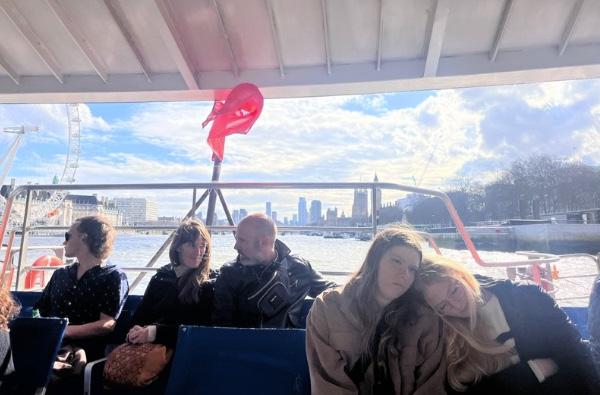
For as long as I could remember, three words came to mind when I heard the name London: strict, gray, and cloudy. Despite being the hometown for so many inspiring writers, poets, and actors, I could swear the city lacked any warmth (literally) and joy. Solely relying on the hope that the city’s history, architecture, and literature would make up for the gloominess, I decided to be a part of the London Review. Who knew a three minute and ten second pop song would be all it takes to change my perspective.
Having plenty of time to try out different artists and genres of music during layovers, I happened upon a song that I thought would be worth a listen, as the title consisted of where I was going, “London Boy” by Taylor Swift. In the song, Swift endlessly praises the city. One would think the city is a paradise on Earth, complete with smiling mates in pubs, flower-adorned paths for strolls, and endless boroughs to explore. Surely, only be-

ing with someone you love could make the sad city seem that happy.
As much as Londoners and Anglophiles would insist otherwise, I was right. The sky is gray, it is almost always raining, and the residents are rude. Despite all this, I will never forget the joy I felt radiating from the city during the week. The modern cosmopolitan hustle performing on the elegant stage of ancient roads and royal buildings kept repeating one message: times change and so can you. For once, I traveled without a strict mental itinerary and opened myself to trying new things.
I can’t name what specifically about London was so magical, but I can try. Right off the bat is the humanness of the city. Transportation that could take my friends and I to see Big Ben at a moment’s notice, pubs filled with strangers conversing like lifelong friends, and endless places to just… be. Coming from a country where every experience outside the house is either a half hour drive or a hit to
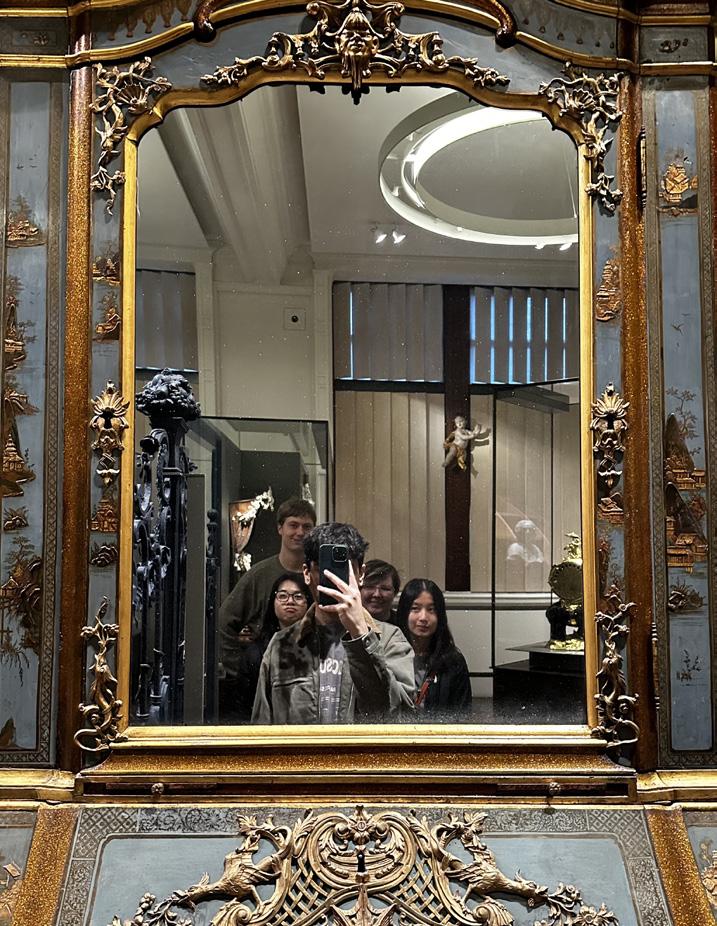 Hamdan Tariq
Hamdan Tariq
the bank account, London felt like a goldmine of firsts and core memories.
The group of friends I made during the trip also changed how I saw the city. I scroll through my pictures of London and see cloudy weather and gloomy buildings yet can’t stop smiling when I see the foregrounds filled with my friends’ laughter, our shared confusion, and a new version of myself. I let myself take the back seat in decision making over what we would do next. This new mentality allowed me to be more mindful and appreciative of the little moments of joy throughout London.
The song shouts it best, “show me a gray sky/rainy cab ride.” It didn’t matter if it was pouring rain, or my friends and I almost got mugged, or if a bird pooped on my head; the appeal was in the diversity, beauty, and humanity of the city, the people I spent my time with, and the person I felt myself become. The upbeat hook of the song echoed in my head all week long.


The sun was out for maybe the first time on the trip. We were sitting outside, at a table still a little wet with the residue of morning rain, next to a cafe. The cafe was also a boat, resting on a pond. ‘Little Venice,’ the area was called.
“Wipe your face.”
For a moment it didn’t register that he was talking to us. He didn’t even look over when he spoke. I was eating eggs on toast, the first meal I had attempted since struggling with food sickness the night before.
“Me?”
I was drinking, in addition to water, a bottle of lemonade called Fentiman’s, brandishing a label that boasted its establishment in 1905 next to a drawing of a dog’s head. I was more amused than I should have been by a drink called ‘Fent.’
“Yeah, wipe your face.”
And then he was past us, walking at a brisk clip down the water’s edge. I blinked and looked over the table at Joel, hand still on my lip. Between us sat the remains of breakfast (if your first meal is at noon, is it still breakfast? I was breaking my fast, I suppose).
“Why
would he say that like a command?”
The lemonade was carbonated, and sour, which was not what I expected, and I did not enjoy it as much as thin and sweet American lemonade, nor did I enjoy it less. I did not enjoy it an equal amount, either. I just enjoyed it in a different way, as a different thing. You can enjoy two lemonades at once.
The sun shined bright on the surface of the canal. It was that sort of early-spring heat that you always forget exists when you’re up to your neck in winter. Must have been London’s first warm day in ages. It felt wonderful.
“Did you see that guy?”
We were walking along the water, on a path from the cafe-boat to the markets. A man was climbing up some steps, away from the canal, dragging a husky behind him. His collar didn’t look like it would contain him, just a thin band around the dog’s tree trunk of a neck, and oh, how the dog strained.
“The one with the huge dog?”
The dog seemed hot. Its more-than-audible panting and coat like a polar bear’s agreed with that assessment. I’m sure the man was aware of all this. He was probably rushing home to get his dog a drink and some A/C. But the way the dog radiated exhaustion, the lack of slack on his leash . . . he just wanted a break.
“He looks like he wants to jump in the water lol”

His owner thought he was being helpful, that he knew what was best for the dog, that he would be better off rushing home. But he was ignoring all of his friend’s attempts to express what he wanted. The man was confident that his dog wanted some thin, sweet, American lemonade. But it seemed clear to me that the dog wanted some Fentiman’s. It has a dog on the label, after all.
On the walls of the market stall hung various clothes. Women’s clothes stuffed anywhere they would fit, in any orientation. Racks of coats, partially blocked dresses, and a teal cape that caught Joel’s eye.
“Is this for a friend? Do you know her size?”
The walls themselves were all but invisible. They certainly were brick, like the rest of the building, but they may as well have been bright pink stucco for all I could see of them. Joel, who was to my left, hesitated for a moment, and then replied with a sheepish smile, never looking away from the cape.
“Uh, no, not really. It’s not for a friend, I mean. I, uh, know my size. Obviously.”
Joel clearly hadn’t taken my advice to ‘own that shit’ when this exact situation occurred a few days ago.
“Well, I kind of know my size. Women’s is harder for me.”
A moment of confusion from the store owner. Eyes narrowed, brows furrowed, mouth thin. A moment of realization. Eyes wide, brows raised, mouth open. Then, a moment of reaction to that realization. I prepared for the worst. London doesn’t have the best track record with these things. But the worst never came.
“It’s a beautiful cape, yes? You can try it on.”
I’m not sure that she knew what was going on. But she didn’t let that bother her. She didn’t avoid the unfamiliar. She didn’t retreat to her prior concept of thin and sweet lemonade. She took the Fentiman’s on the table.
I wanted to attempt co-authoring because two of my favorite thinkers (Gilles Deleuze and Felix Guattari) co-authored two of my favorite books (Anti-Oedipus and A Thousand Plateaus). To co-write a thing is a curious experience. “The two of us wrote Anti-Oedipus together. Since each of us was several, there was already quite a crowd”. To demonstrate the process we have developed to co-write, note the italics, which are Easton’s words rather than mine, which are in bold. Joel-and-I were also quite the crowd.
We each wrote our own description of an act, then spliced them together, wove each into the other while also retaining enough of the original such that the other piece was forced to fit with our own. We often left out parts where we thought the other writer understood more or could write better (Joel was far better than me at dialogue and description) (but Easton’s overarching designs were far more structurally sound). We wrote everything from the first-person-perspective of me (Easton), for whatever reason (not “whatever reason,” his perspectives were allegedly more interesting than mine).
To me it feels almost like normal writing, except that some of the ideas are plucked from a foreign mind rather than one’s own. I do not think it would be accurate to say that both of us wrote this piece. We, the singular assemblage of the two of us, wrote this piece. The effect this has on the whole is quite remarkable; I assumed originally that our distinct styles would stand out but instead they became more akin to a symbiotic relationship of prose. The orchid and the wasp; (re)production and nourishment; destructive deterritorialization and reciprocal reflection.
When I was in middle school, my Aunt Regan (my mom’s identical twin sister) came to visit. She lives and works as an artist in Florence, Italy, so it was always a special treat when she would come back to the States growing up. During this particular visit, my mom, Aunt Regs, and I went on a shopping spree at Forever 21. Post-dressing room delirium, I remember staring at the items in our cart and begging my mom for this black tee shirt with an image of the Eiffel Tower on the front. Below, it read “P A R I S.” Recently, I had been obsessed with the idea of traveling to Paris and seeing the Eiffel Tower, so this shirt was a real find!
My aunt pulled me aside. “I will buy this shirt for you, but I have a few conditions.” I nodded my head up and down, my eyes wide with excitement. “When you get to college, you will be faced with a lot of options about how you’re going to spend those four years. Now, you can do whatever you’d like to do during that time—study whatever you want to study—all I ask is that you study abroad.”
She pointed at the shirt. “When you’re pulling out shirt options in the morning, scratching your head and trying to decide what you want to wear for the day, you’ll see this shirt and be reminded of studying abroad.”
“I mean, how cool would it be to study French in Paris?!” She gave me a big hug and flashed a knowing smile. “Plus, you would only be a train ride away from me, pickle.
Well, Aunt Regs, I didn’t end up studying in Paris. I don’t have a knack for French, as it turns out. And it has been years since I could get the “PARIS” shirt over my head. But I remembered what you said all those years ago. So when the opportunity to go on the London Review came my way, I jumped on it. And as you have been all my life, I knew you were supporting me.
My Aunt Regan has always motivated me towards curiosity and creation. From sitting with me as I doodled to gifting me my first drawing journal, she was one of the people who helped me to tap into my love for the arts. For years, she has asked to read whatever I write and motivates me to pursue any and all of my creative passions. I spent most of my time in London hopping from museum to museum, from exhibition to bookstore, trying to absorb as much art and literature as I possibly could
Betsey Lewisin our short time in the city. And I felt my Aunt Regan with me in every space I entered.
Wandering through the National Gallery and the Tate, I would remind myself that the art I was seeing for the first time had been something she had seen for the first time when she was my age. She had taught classes about El Anatsui and Mona Hatoum before I had even heard their names. In the case of the rosenclaire exhibition at the Goodman Gallery, the art I saw had been created by her mentors. I had my own experiences within the museums and galleries I witnessed, but there was an entire history in the spaces and the art I encountered that was strictly between my aunt and I. A secret and shared memory that no one else around was privy to.
Even though we remained physically separated by distance, we remained embedded in one another’s world through art (and Whatsapp, of course!).


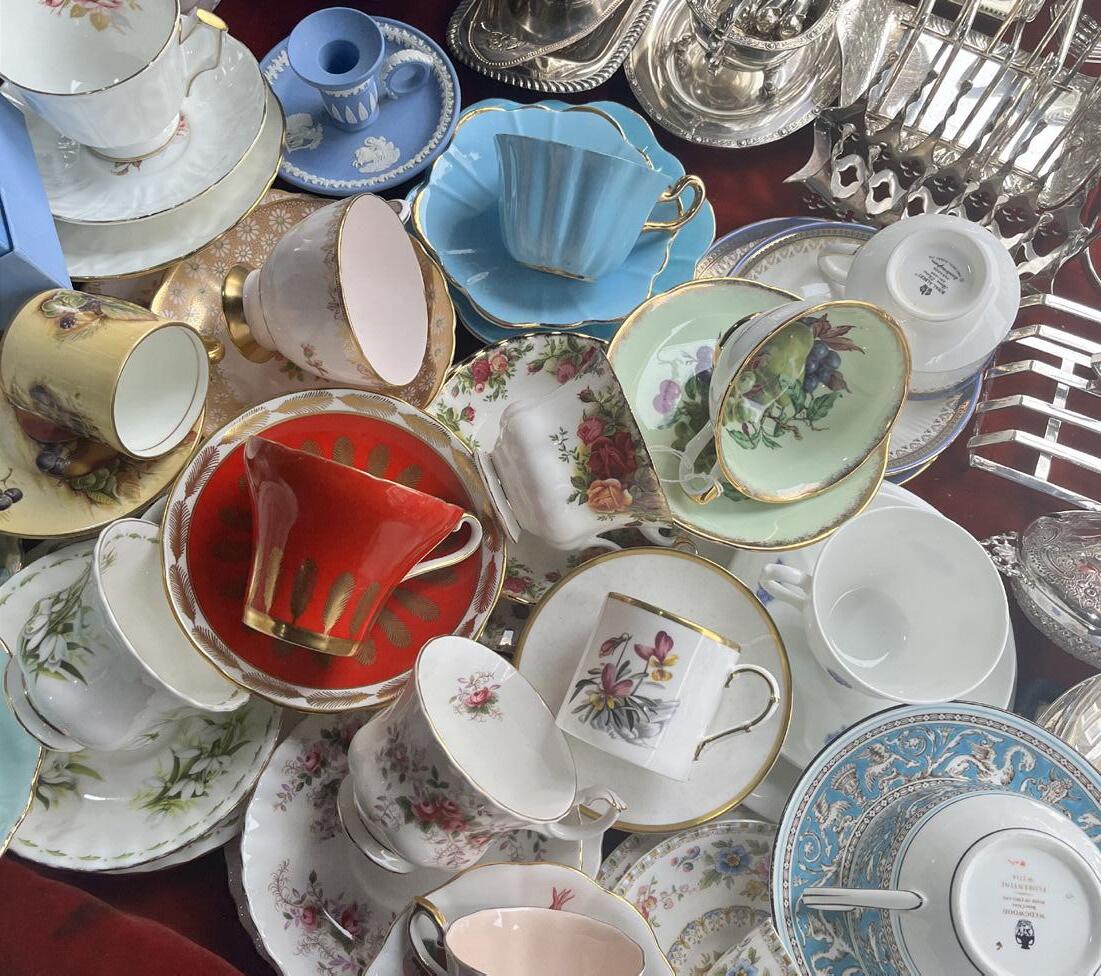

I spent a lot of time traveling alone while in London. This started the second day I was there when I took the tube alone at 6 in the morning to pick Connor up from the airport. Later that day, I explored the Victoria & Albert Museum alone, and from this day on, I placed a huge emphasis on finding time every day to do something entirely by myself.
Throughout the week, I spent more time alone than I did with the group. Most of my days were spent exploring a new neighborhood, museum, or park, and when I found that I had more time than I thought I had, I’d find a spot nearby to explore. This way, I found vintage stores in Notting Hill selling collections of teacups and saucers, in China patterns I’d never seen and bright shades of blue, green, and red. I stumbled across a set of musical dominos with notes and rhythms replacing the domino dots. I found a house with eyes in the exterior artwork, reminiscent of the eyes on the billboard in The Great Gatsby. In my walk through of Kensington Gardens, I discovered the Peter Pan statue and watched a dog try to mimic a swan he saw in the water. I walked west from St. Paul’s to Piccadilly Square, starting my walk with the bells chiming the hour at St. Paul’s, and ending my walk at Hatchard’s, the oldest bookshop in the United Kingdom. I got familiar with the London Tube system and got very familiar with the pain around your ankles that appears when you’ve walked 10 miles in one day.

Was I absolutely exhausted at the end of the day? Of course.
But I also was able to somehow hit everything on my to-do list, which I had been warned would probably not be possible.
It’s a very unique experience, being alone in a city in a foreign country. You are both never really alone, what with the crowds of people in almost every space, and at the same time you are completely isolated. I grew comfortable in that in-between, and it allowed me to explore the city at my own pace.
One thing that struck me while wandering through Notting Hill was that although I spent so much time separate from the group and traveling alone in a city, I never felt lonely. There was always the possibility of running into someone from the group in a Tube station or grabbing dinner with a couple of people and swapping stories. Some of my favorite moments from the trip were the debriefs I would have with Connor about our days right before seeing a show together. Spending a day, an hour, or almost an entire week exploring a city alone is not a lonely activity. It allows London to be seen in the way it should be seen: at your own pace
Upon arriving in London and at the hotel, I dropped my bags in my room on the fourth floor and sat on my bed fighting jetlag. My roommate and I had met in class a few weeks prior, and aside from her, I did not know anyone else on the trip. I felt out of place, and I worried that I would spend the upcoming week wandering the city of London alone. When I walked downstairs hoping to bump into someone in the hotel lobby, I was met with short smiles and quick waves.
My fears were put to rest just as quickly as they rose, and on my very second day in London, I experienced my first taste of people conversating in our hotel’s lobby. After a hectic day of rain, museums, and lots of walking, seven of us had gathered by the end of the day exhausted, and ready to eat dinner. Seven quickly turned into eight, when another student ran into us planning and asked to join. This marked the start of a communal meeting place where I talked to just about everyone on the trip.
There were late nights spent sitting in circles on the floors of each other’s hotel rooms reminiscing about our day. It was there that I felt like I learned who my classmates were as people, and I stopped seeing them as just another face in class. I found solace in these conversations as these people were my home away from home. In a foreign country, my first time abroad, it was these moments that kept me feeling positive.
 Carina O’Brien
Carina O’Brien

The lobby wasn’t the only place in the hotel where I got to talk with students. There was a time a big group of us started doing “room tours” showing each other how we managed to make the cramped spaces feel homey. There was a night I sat on the steps outside of the hotel with another student where we talked about London, life, and what led us to end up on this trip in the first place. At breakfast, I talked with people about their previous days and looked through the pictures people took of their adventures. I created plans of my own with people, sitting at the breakfast table over a cup of coffee.
One of my favorite things about our trip to London ironically became going back home after the day was done, just to have more meaningful conversations. I was introduced to alumni, discussed literature, told professors about a rough day of exploration, and argued over the pronunciation of the word “crayon” all while seated in the lobby of the hotel.
On my very last night in London, I sat downstairs talking to my now good friends. A group that had originally started as strangers felt like family after just a few days. If you walked past us that night you would probably just hear eruptions of laughter. As people cycled in and out, I couldn’t help but feel sad when I parted ways with everyone to pack up my things and prepare for the early morning flight back home. My biggest worry became the thing I enjoyed the most: meeting people.
Traveling in a foreign country, even a remotely comparable one to your home culture, can begin to create a sense of isolation and unbelonging. This fact is widely recognized and experienced by countless travelers regardless of their origin, and halfway through my London traveling experience I became no exception. It was on this day, that I found myself not in London at all, but wandering the streets of Oxford. Although pleasant and lower energy than the city streets, I felt the sense that I wasn’t entirely fitting into society still weighing on me. With this sentiment I decided, naturally, to go to the pub and decompress, which is when I came upon a novel idea: as people came up to the bar and ordered, and hearing an American accent, my companion and I would ask them where they were from. It would make for some light, sociable banter and a little friendliness from home on an (expectedly) drizzly English day.
Our first attempt was upon hearing a woman come up to the bar and order with a slight country accent- we asked, and she said she was from somewhere like Nevada or Iowa, but proved to not be particularly dynamic or interested in conversation and thus the details escaped me. Undeterred, or perhaps just craving some American sociability, we persevered. Our success came when a middle-aged man dressed in typical American sporty fare came up to order, and we initiated conversation, asking where he was from. He told us that he was from Texas, and asked us the same, which resulted in one of the highlights of the day: Upon telling him we were college students from Kansas, he asked if we went to KU, which was an exciting question on its own. When we replied yes, he told us, that in fact, he was a KU alumnus as well! Immediately I felt a little relieved, as well as a sense of a significant experience occurring: this was my first “global college alumni” experience, and it had come at a perfectly opportune time, just as I needed some reassurance from back home. We continued to talk and learned some more details; he in fact had lived in Kensington and Chelsea for a few years and gave us some words of encouragement regarding our accommodations. And, as the cherry on top, he bought us beers as a token of KU camaraderie- and as a bridge of communication which transcends beyond the UK or USA.
Feeling satisfied, I left the pub that day with three new pieces of wisdom. The first, which I came upon myself,
Nile Russo was the importance of a sense of home abroad, but also the freedom to explore a unique cultural experience once that has been satisfied. The second and third were relayed to me by the KU alumni, who out of gratitude, will remain anonymous for this article. He told us to first “always order the cask ales at the pub”, because in his opinion, they were of superior quality to larger brands. Secondly, stipulating that his time had come and gone, and he now raised a family, he said that the secret to meeting British women was holding the door and saying “ma’am” with a slight country twang. Though the later piece of advice was not of practical application to me, even that warmed my heart: a little piece of lighthearted American bravado, all the way in Oxford.


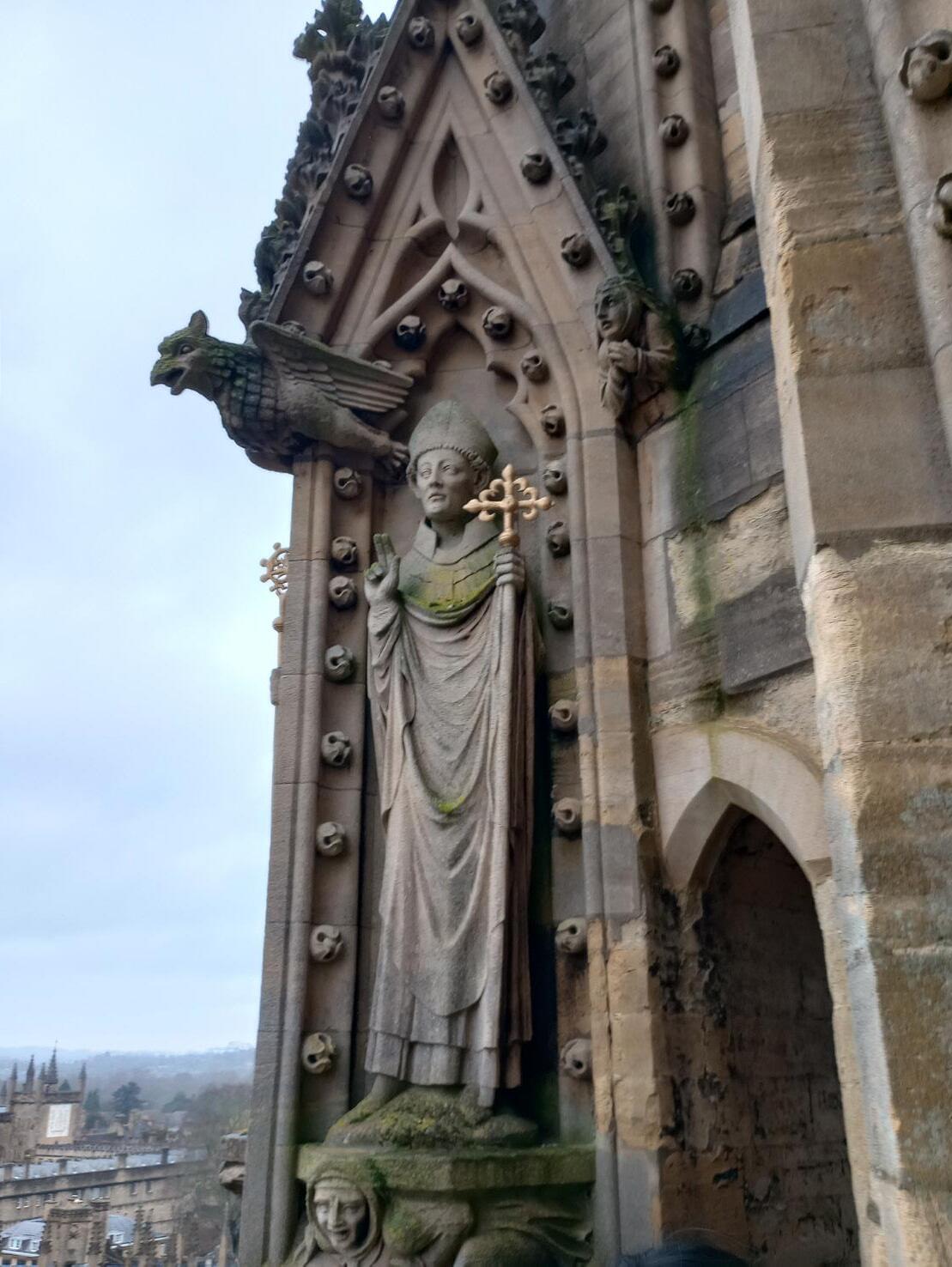

“All the World’s a Stage” shows the theatrical displays that others experienced while in London. From performances ranging from the 16th to the 21st century, these curations explore the euphoric peaks and devastating tragedies of dramatic theater.
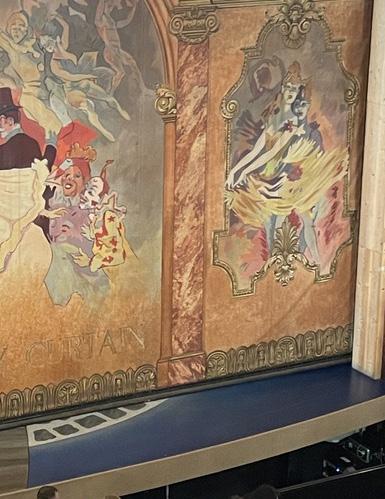
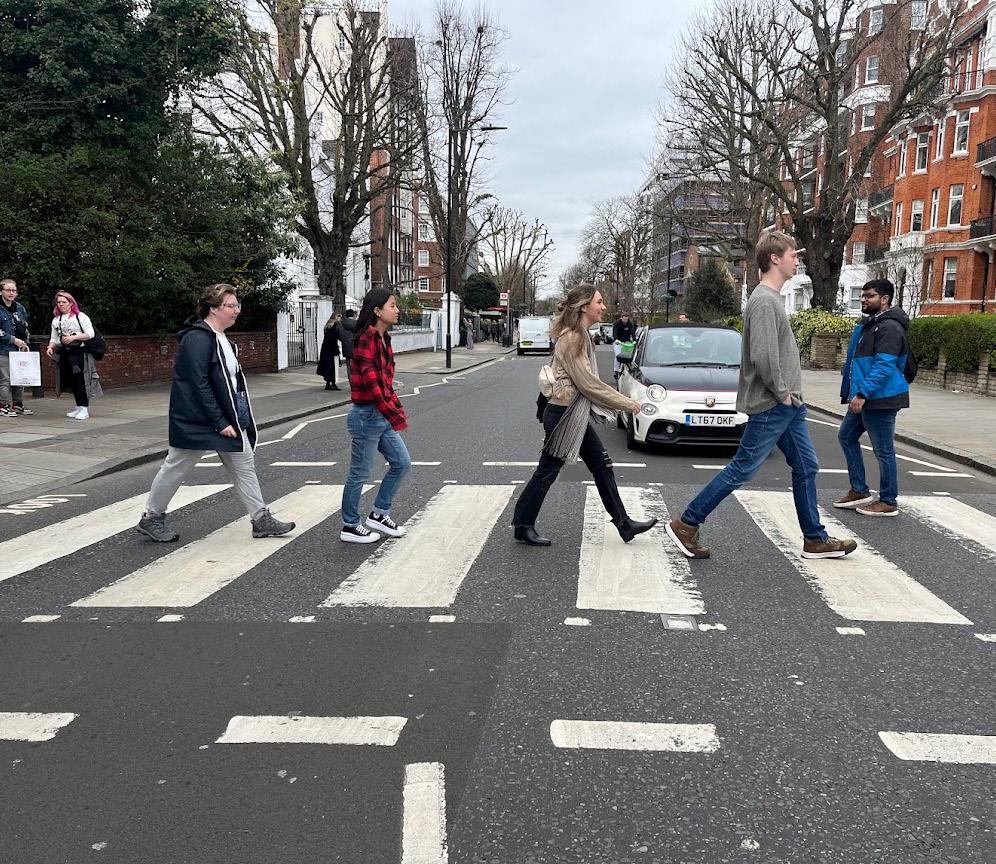

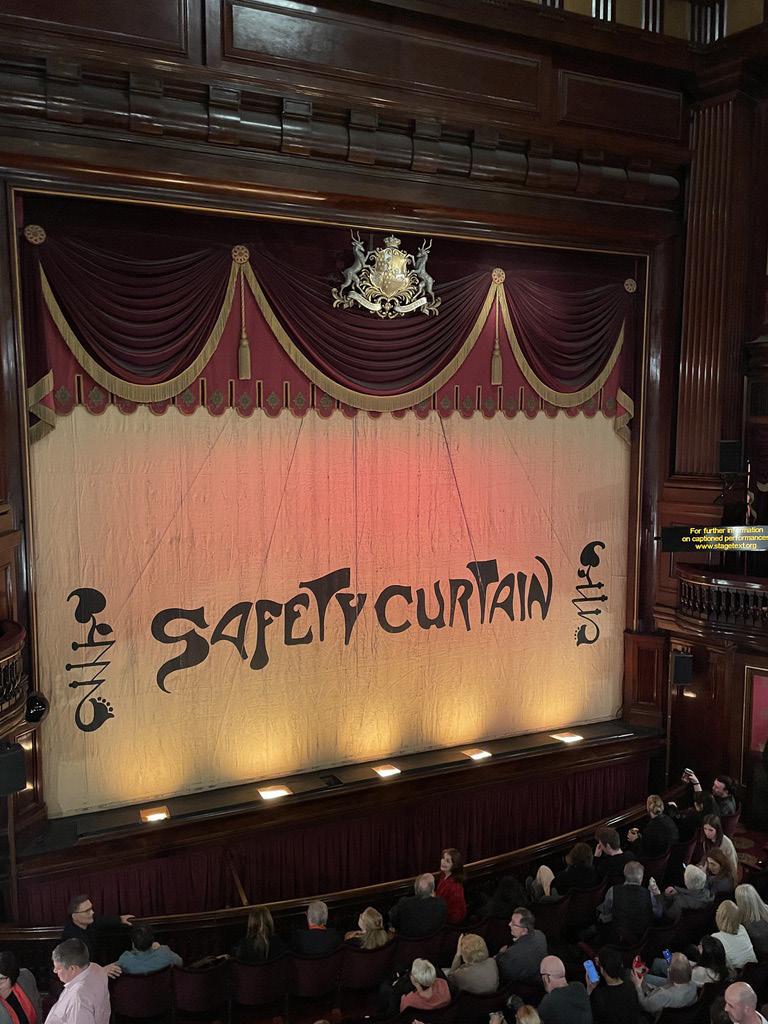
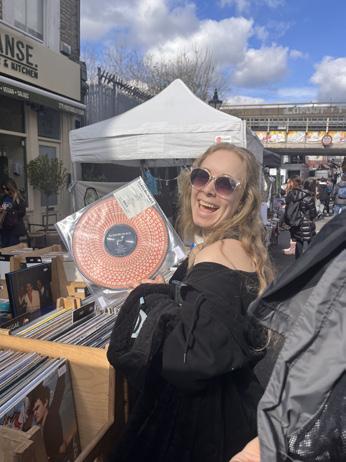

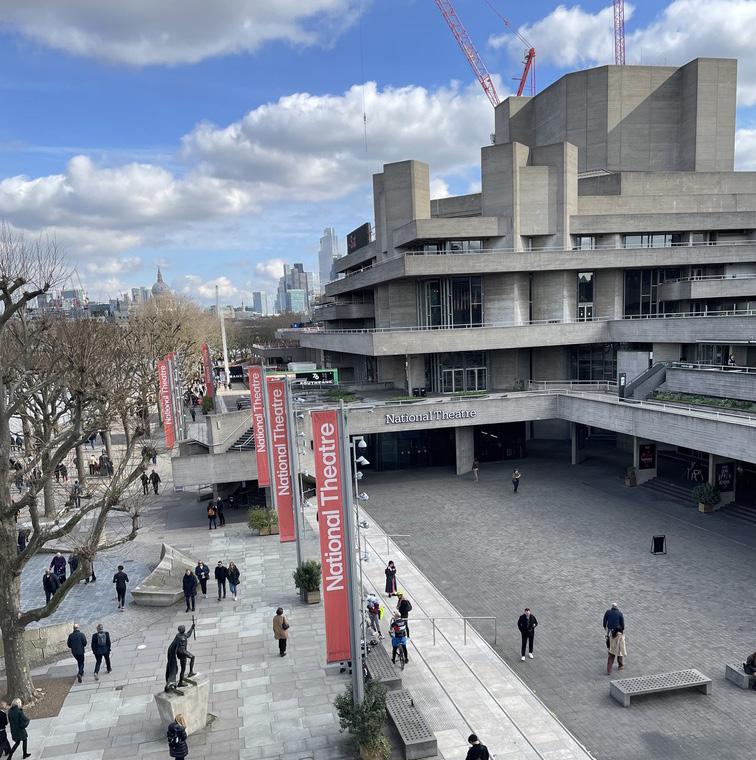
It wouldn’t be too much of an over-exaggeration to say that theatre has consumed my whole life. It all started eight years ago when my middle school choir went to go see the touring Broadway production of Wicked in Wichita, Kansas. Looking back now, I still don’t quite know what it was about that production that got me so hooked; perhaps it just happened to be the first one I got to see, but something about it put me in a vice that I haven’t been able to shake. In the following years, I had what you could call a turbulent relationship with the arts; it probably wasn’t until Covid happened and theatre ceased all together that I realized I couldn’t live without it. Finally, I realized that a life on the stage wasn’t my calling, and I began my Theatre Design degree at KU, eventually finding a love for stage management. Suffice it to say, when I began my planning for London, lots of theatre was always on the schedule. Through a combination of encouragement from my friend and fellow theatre lover, Madeleine, and the discount tickets on TodayTix, I was able to see 7 shows in just six days. I saw 4 plays and 3 musicals all for around $330 USD.

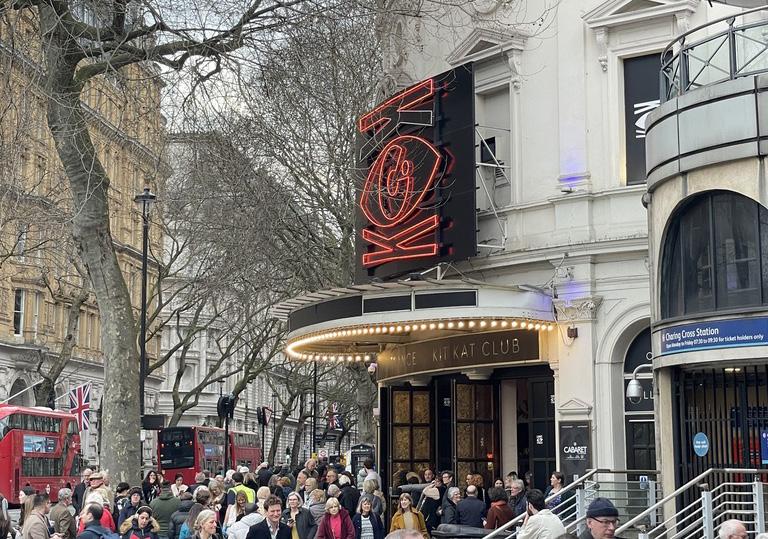

 King Lear by William Shakespeare
King Lear by William Shakespeare
The Almeida Theatre
This was the show seen by our group, so I did not pay any extra for the ticket. I thought the show itself was incredibly well done. Modern designs for Shakespeare plays have been done many times before, and I thought that it worked very well here. I was especially impressed by the sound design on the show. The audio landscape of the show really helped to immerse the audience.
Wicked Book by
Winnie Holzman, Music and Lyrics by Stephen SchwartzThe Apollo Victoria Theatre
Revisiting this show eight years after my first view was surprisingly nostalgic and enjoyable. I paid $52 for a last minute mid-balcony ticket. One of the great joys of watching a show like this for a second time is anticipating particularly impressive moments and looking at the other audience members’ reactions.
Book by Joe Masteroff, Music by John Kander, Lyrics by Fred
EbbThe Kit Kat Club
This was the only production I was dedicated to seeing from the moment I knew I was going to London. This production of Cabaret has stuck out to me as an artistically brilliant show since I first saw photos of it during my research as the assistant costume designer on KU’s own production in 2023. This is an entirely immersive experience which starts from the moment you enter and are handed a shot of schnapps. A must see for any theatre lover visiting London (or the recently opened Broadway production). I paid $72 for a ticket in the front of the circle.
This was a last minute decision made during the intermission of Cabaret earlier that afternoon. I had never seen Phantom of the Opera and had been waiting to see it live. I paid $47 for a back stalls, obstructed view seat and absolutely regretted my choice of seating. Back of stalls meant that the balcony was obstructing my view of anything that took place in the top half of the proscenium, which for Phantom of the Opera is quite important.
The Mousetrap
by Agatha Christie St. Martin’s TheatreAny theatre scholar in London should go see The Mousetrap. After seeing the show, I understand why it has been running for 72 years. One thing that really struck me was the energy of the people working front of house. They seemed so excited to ask if people had seen the production before, which made me that more excited to experience it. Unfortunately, I had read The Mousetrap previously for a class, but even though I knew the end I still had a lot of fun. I spent $33 on a rear balcony ticket.
Mamma Mia!
Book by Catherine Johnson, Music and Lyrics by Benny Anderson and Björn Ulvaeus Novello Theatre
Being a longtime fan of the film adaptation, I was incredibly excited to be seeing this show on the Friday night of our visit. Surprisingly, this ticket was the most expensive one I bought, coming in at $104 for a mid-balcony seat. The show itself was phenomenal with an understudy on for Sophie who blew me away. Unfortunately, this was possibly the worst audience experience I’ve ever had at a show. There was a large school group of pre-teens sitting behind me who were being particularly obnoxious and the whole theatre just lacked the sort of reverence I’ve come to expect at a live production.
Dear Octopus by Dodie SmithThe National Theatre
Another last-minute ticket decision, and the cheapest one I bought coming in at just $25, I went to see Dear Octopus not because I knew anything about the show itself but because seeing something at the National has been a longtime goal. I found this play to be very entertaining, heartwarming, and sentimental with strong themes about family and reunion among childhood friends. What struck me most in this experience was the incredible production value of the National. They truly are the leaders in contemporary theatre.
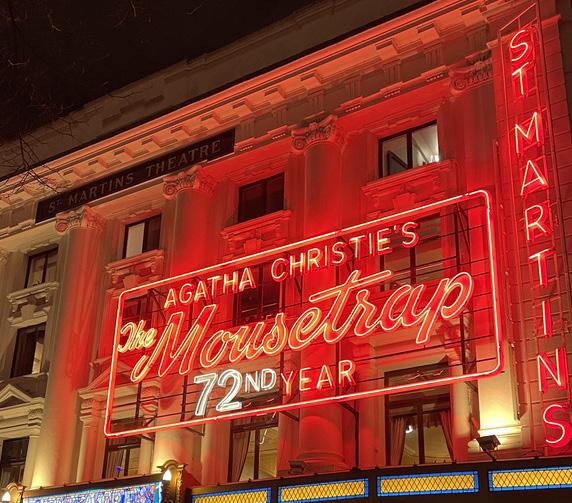
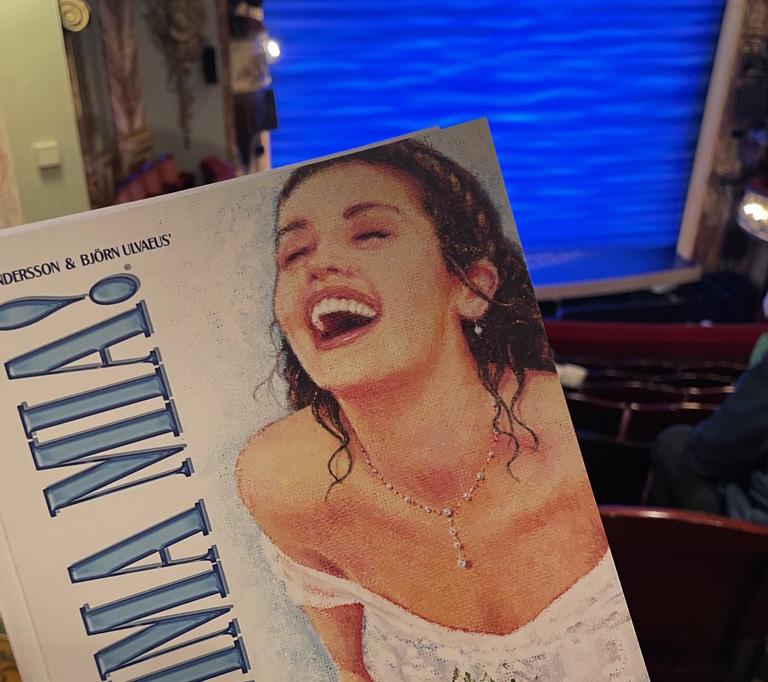

Take an actor from Dungannon, hand him a lit cigarette, and place him in the hands of a South African director, and from the proverbial ashes will rise the most gripping critique of the impacts of the empire I have ever seen. Fra Fee, what an actor you are!
I have always felt critical, confused, and utterly conflicted when interacting with media that comes from the empire that tore my family apart once upon a time. And yet, King Lear at the Almeida Theatre was one of the best works of art I have ever seen.
I can precisely pinpoint the moment I felt Farber’s directorial choices take over my senses. It was the instant that the smoke cleared, and I recognized a Northern Irish actor playing the bastard son of the British Empire. The second Fra Fee stepped onto that stage with an accent I hold in the back of my mouth and heart when someone asks me how I got my name, an accent that is so few and far between in the States that anyone who can recognize it is likely a second cousin.
It was a choice, an intentional moment in which Farber placed a man from Dungannon across the stage from Kent, played by Alec Newman (Dune), a Scottish actor whose character clung to the good in Lear despite the clear historical meaning—when Lear gives away his seat, Kent becomes a figment of the past. In that instant, I knew that this version of Lear was looking at the concept of ego and empire in the eyes and challenging it to its core. The soldiers of France, with their paramilitary garb and the haze of fear cast from the single violin players slumped in corners, it was all a choice.
Danny Sapani (Killing Eve) is Lear, a corrupt, confused, and faltering ruler. But his fear, love, and immense stage presence shift the atmosphere of any stage he steps onto. In his first moments on the stage, set in front of a row of microphones, posh and well-mannered, it is clear he is a politician. Here to ask the most significant question—which child of his loves him the most? The instability of Lear—and England—becomes clear when Cordelia rejects him. And the burst of violent rejection is woven into the very fiber of this play. The relationships and precise human moments of these ever-present historical characters are brought into a new, haunting level of clarity in this production that changes everything for
the audience. The set, a dark landscape with controlled moments of light and glinting, shaking chains, paired with sparing, crescendo moments of singing and orchestral clashes, takes on a sliver of humanity itself as it shifts and changes with each moment of love, panic, and beautiful violence.
Farber’s plays are visceral and often shockingly modern. With casts in contemporary dress (see 2021’s Macbeth starring Saoirse Ronan) and interactive elements that leave the audience tearful and aching.
I spent over three hours of that three-and-a-halfhour play leaning over the chair in front of mine, mouth agape, tears in my eyes, genuinely transported. Historically, Lear is a play that refuses to be cut; it is long, often confusing, and must be done with two wildly interactive stories in mind. And Farber had no intention of cutting a second off this classic tragedy.
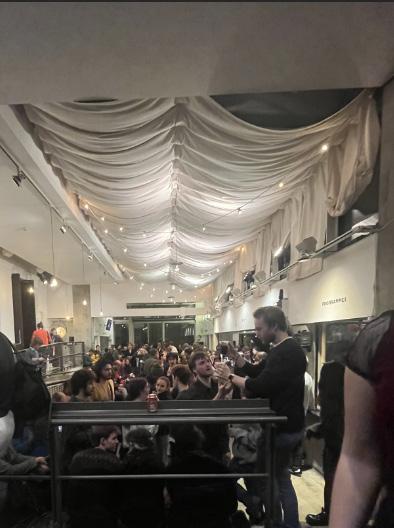
Music followed us everywhere in London. We heard people singing live music as we got onto the tube, walked through the streets, or passed through the markets. Sometimes we would seek out particular types of live music by attending a jazz club or an Evensong at a church. When there was no music present, one of my friends or I was quick to fill the silence with our own singing. Regardless of the types, there was always some live music serenading us in London.
I first noticed how normalized live music was in the tube station as sounds of joy followed me around. My friends and I were riding the escalator and heard an electric guitar. As we got closer to the sound, we realized that it wasn’t just music playing over a speaker. It was a man playing the guitar with just one hand, which was impressive. The electric guitar echoed throughout the station as people hustled to their next stop. Throughout our trip, we continuously heard wonderful singing in the tube station that made the wait for the tube pass by faster. Sometimes we would see people stop to listen or tip the musician, but other times it was just background music that locals were so accustomed to.
One evening, we went to a jazz club called Ronnie Scotts. People filled the room and crowded the band. The musicians were extremely talented, and it was
 Emily Colby
Emily Colby
evident that the people listening were enjoying themselves as they danced and chatted with friends. Walking through Camden Market, we saw another man playing violin and dancing at the same time! It was so joyful to hear and watch. We also went to an evensong at Christ Church College in Oxford. The beautiful harmonies echoed throughout the church, creating the most beautiful experience. When we didn’t have the tube music, jazz club, or evensong to serenade our London trip, we would become performers ourselves. My friends and I would play this game that we called “riff-off,” inspired by the Pitch Perfect movie. We would start singing a song and then another person would start singing a new song picking up off a word that was previously sung. We played this game in the hotel lobby, walking down the streets, on the tube, and everywhere we went. We would try to convince all our classmates to participate in this game because it was so entertaining. One day, we were playing riff-off on the tube, nothing out of the ordinary. A British man came up to us and said, “Thanks for singing. It makes me happy.” We were a little bit embarrassed, yet still happy that we could bring some joy to his day. Although we were not nearly as good of singers as the live musicians in London, we enjoyed ourselves. Just as the British man said, music makes people happy. I was thankful to have heard a variety of live music to add an extra sprinkle of joy to our London trip.


North London is a long way from Oklahoma, but lead songwriter of The Kinks, Ray Davies, seeks to bridge the gap between these two cultures with the band’s tenth studio album, Muswell Hillbillies. Shifting away from their usual rock styling, Muswell Hillbillies musically takes on a theatrical country twang. Lyrically, it spends its entire runtime relating the two cultures, that of Muswell Hill in North London and the American South/Midwest/West. (Ray himself admitted he conflated the cultures of all three of these American regions. For the sake of this paper, we will apply his observations for all parts of rural America, whether that be South, Midwest or West.)
I find it important to note that Davies is writing less for himself and more for his parents and their generation. By the mid-20th century, Muswell Hill was expanding rapidly, moving away from the steel-factory-dotted, railroad-run-through area it had been. The buildings bombed during World War II, the streets coated in grime, the people old and weary-eyed: these were all coming to a close as London, and its developers, swooped in and built up the area. A wave of Irish immigrants rushed in around 1960-1970, and the old grimy ways Davies writes about were scrubbed clean. The well-worn, traditional behaviors and stories from people like his parents and their generation, but most visual representations of the lessthan-posh past were tucked away.
The characters and attitudes Davies presents on the album certainly hold many similarities between the cultures he compares. After seeing how Davies writes about Muswell Hill, how it’s becoming a place of “identical little boxes” where the residents fear being turned into “a zombie,” there is a clear comparison to rural America (“Muswell Hillbilly”). Change is occurring all around these people who previously lived insular lives. They have been forced into “the age of machinery,” and the response of many is to break down— they “ain’t got no ambition” (“20th Century Man”). Life has grown too quickly and too obtusely; and this spurt of growth ails many both physically and mentally, shown through “a pain in my heart and a pain in my chest” (“Complicated Life”).
All of this struggle and strife, leading to pain, stems from one major origin: a lack of purpose. It’s not just that all they know is being torn apart, but they must find a way to make sense and grab hold of this new world. Their previous place in society has been ripped from them, and finding a new reason to exist is a horrid journey. The slow and tragic “Oklahoma U.S.A.” sums it up within its first two lines: “All life we work but work is a bore/If life’s for livin’ what’s living for.” The curve of modernity has cultivated a sense of un-personability within professional and personal life. Those in Muswell Hill, those in rural America: they have all been jolted into a position where

Before, purpose was instilled by a variety of factors. For those in Davies’ parent’s generation, supporting the war front was the defining factor. In America, a similar sentiment arose. So once the war was over and the people’s function had been completed, they found themselves in a world that had been transformed, especially in regards to technology. These groups must search for purpose again, but unlike previous generations, occupations have become less personal, more offices and corporations and factories where you stand as more of a number than a person. Sure, there is a sense of honorable pride among those who find themselves thrown into these soulless jobs, but that’s not purpose.
Domestic life cannot endure either. Davies sings that “even my old dad” is corrupted by this purposelessness, giving himself to paranoia just like his son (“Acute Schizophrenia Blues”). This onslaught of change is so sudden that one cannot turn to their parents for help, for their parents are just as baffled and worried about the world as them. In the age of technology, of social acceleration, there remains no acclamation period for anyone. The youth benefit the most, but they too find themselves in a world far different than what their parents trained them for. The slow life is annihilated, the simplicity washed away, and as economic conditions strain these groups into positions with a lack of purpose, they grow disillusioned, combative, and weary. Instead of embracing all new aspects of society (ones that certainly deserve to be accepted and understood), the aspects that provided the most support (occupations and domestic life) have fallen to pieces, leaving certain victims of an age trained to be dismissive of newness in all its forms.
One does not need to be in 1960s-70s Muswell Hill or rural America to feel the sense of insecurity creeping around them. In the current day, dramatic change is threatening to take over all areas, all job sectors, and all pieces of purpose. When the factories of Oklahoma automated and the ones who worked there left without a job, most could see the problem as distant and impersonal. When it is not your world crumbling, it takes far more effort to empathize, mostly because of the inherent competition within the systems they find themselves in. Muswell Hillbillies gives that empathy while connecting two separate worlds. Muswell Hill was forced into the modern as London overtook it. Rural America is being forced into the modern as its youth flee into the cities and jobs become more and more technologically oriented. This has extended even beyond rural America. We now face a world where occupations, no matter what, are threatened by new technology. No matter your future, you could easily find yourself in a world you do not understand (which is not entirely your fault either, for all these things move so rapidly). So, when your purpose is lost, when your finances are bleak, when everything feels out to get you, when you become an outsider to a world previously accepting of you, you will have become a Muswell Hillbilly too.
“Well, I’m a Muswell Hillbilly boy/
But my heart lies in Old West Virginia/
Though my hills, they’re not green, I’ve seen them in my dreams/
Take me back to those black hills that I ain’t ever seen.”
Now with that out of the way, who would have known with £35 you could cry, laugh, and with everything inside you keep yourself from singing along to some of the most iconic sounds ever written? I did not know what I was signing myself up for when I bought my ticket for “Wicked.” We meticulously picked out which seats would be the best bang for our buck and eagerly waited for Friday night. When Friday rolled around, we made our way to the tube station and were on our way. Now I had heard a few songs from “Wicked” but didn’t know much. I thought the musical was about a cool girl taking this weird girl under her wing and making her popular. I had no idea what I was getting into.
As we walked into the building, the hustle and bustle of the people running around getting their drinks and popcorn was electric. After everyone got their drinks, snacks, and used the restroom, we made our way to our seats. We walked in, and the theater was beautiful and large. The ceilings there were detailed with intricate designs and painted with flakes of gold. The stage had a large curtain closed with the glowing green words that said “Wicked.” It was so beautiful, and I was so excited.
As we sat and waited for the show to start, I started asking my friends about what “Wicked” is really about. They informed me that it’s a play-off the “Wizard of Oz.” It was from the perspective of the wicked witch and her part of the story. I was intrigued but highly discouraged since I knew how “The Wizard of Oz” ended, with the wicked witch melting. Now one should know
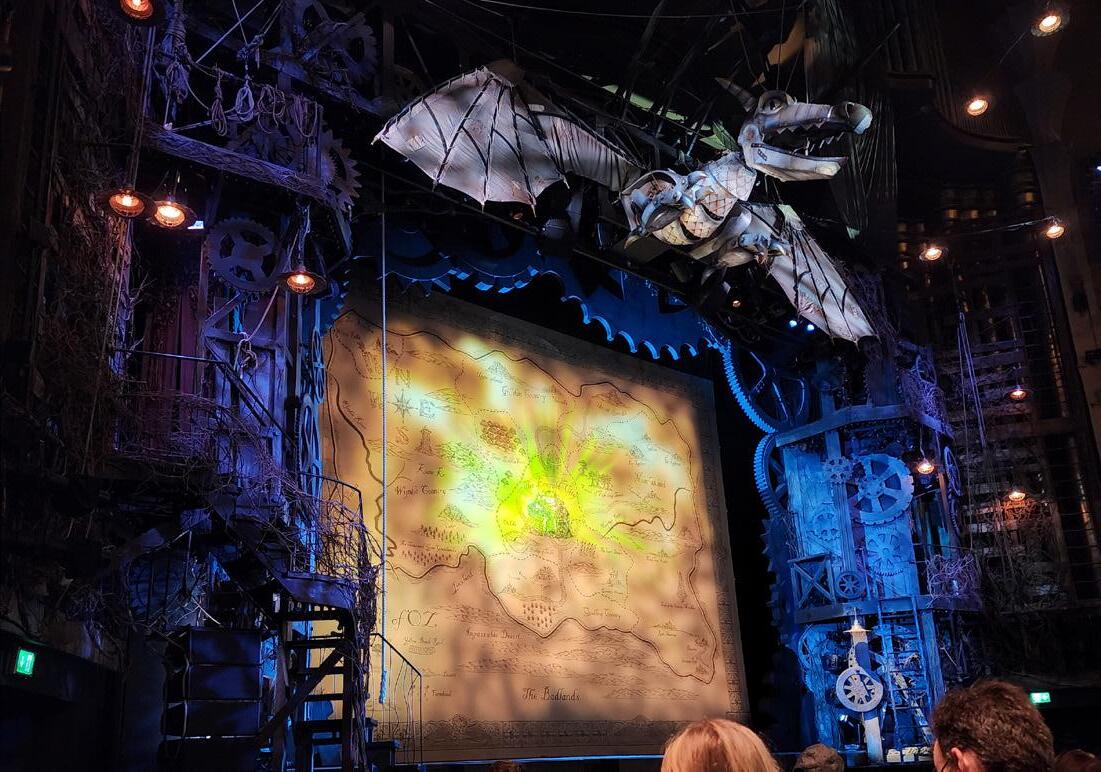
I hate anything less than a happily ever after, and I was already feeling disappointed before the play started knowing there would not be a happy ending.
The curtains opened, and I was met with amazement. Everything was so vibrant; the music, the colors, the lights, and so much more. I was drawn in and could not be distracted. As the plot developed, the more I grew frustrated because my heart went out to Elphaba, the rejected green witch. I just couldn’t see how they could let this play end with this miss treatment of Elphaba and no kind of resolution. By the end of the first act, I had tears in my eyes as I sat with amazement listening to Elphaba singing “Defying Gravity” with all she had in her. I couldn’t believe the first act was already over and was ready for the second act to start!
As the crowd started chatting and people made their way to the restroom, I couldn’t get over the idea that this story ended in tragedy and started explaining my frustration to my friends. They kindly told me to wait till the end of the show and we can discuss more. As the show began once again, I was highly entertained with a roller coaster of emotions. As the storyline began to wrap up, I was nervously awaiting her death. Then something happened that I didn’t see coming. She faked her death! I admittedly was overcome with relief and shock. When the curtain closed, I was left with emotions and had no way to express them. I was deeply moved and inspired, left with my happy ending.
 Preslie Wallace
Preslie Wallace



Walking down a dark alley in SoHo, the only thing that could possibly cheer me up after seeing a robbery right in front of me was live music. It was about 10:30 pm and we had gotten off the bus and saw two women chasing after two men on bikes with their belongings. Stressed, I clutched my purse closer to me and began walking to Ronnie Scott’s as a possible safe haven. And a haven it was.
Every time I study for exams, I always listen to jazz music. Something about the dynamic rhythms and fusions of beats always kept me focused. This genre of music has continued to be one of my favorites and I have dreamed of listening to live jazz music. When I heard that Ronnie Scott’s was one of the best jazz bars in the city, there was no doubt I was going to visit.
As I walked up the dimly lit flight of stairs, the music grew louder. Muffled, it was an amalgamation of the trumpet taking over the melody, the drums keeping the underlying beat, the piano’s rich keys being run, the bass contributing to the “dom, dom” of the beat, and the guitar switching from a flowing melody to a dominant one. I opened the door and saw the band in the front, the lively crowd in the middle of the room, and other seating arrangements in the corner of the room. I swear at that moment I began writing this article in my head.
Bhavya GuptaThe effortless symphony of the impromptu show is what made it so special. The beat was unpredictable- no one in the crowd was swaying in the same way. Laughter would erupt from the bar, where the bartenders were flourishing their drink making skills, throwing cups in the air. Above all, everyone had a smile on their face. The difference in melodies were taking over the minds of every single person in the room, making the whole night improvised.
Although not enforced, everyone arrived classy at Ronnie Scott’s. Slick backed hair, all black, collared shirts, not one person in the room thought to be underdressed to hear such electrifying music. Whoops would come from the room after a 10-minute solo of the trumpet; everyone knew when the rest of the instruments would back away and let another shine.
That night painted a vivid experience of the human experience. This is something I am extremely passionate about studying, simply through sound. The dialogue between the musicians on stage was intricate and infectious. They would respond to each other, ideas would be exchanged, and were subsequently reinterpreted. With just 4 or 5 instruments, this transformative experience shows how the sheer power of music transcends so many boundaries.
To remind you who you are:
“No need to hurry. No need to sparkle. No need to be anybody but oneself.”
For Graduating Seniors: “Growing up is losing some illusions in order to acquire others.”
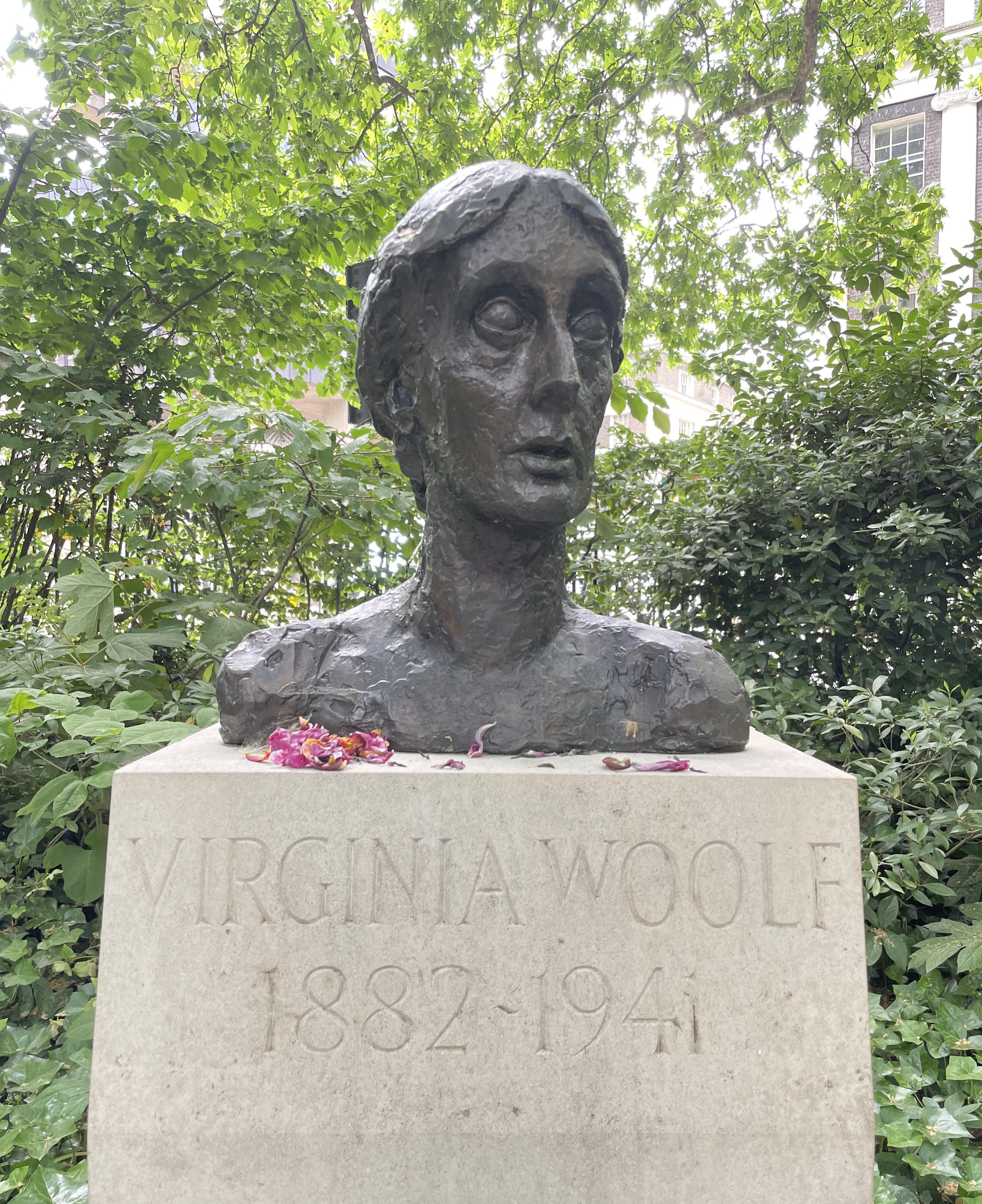
For rainy days:
“Often on a wet day, I begin counting up what I’ve read and what I haven’t read.”
On the Act of Writing: “So long as you write what you wish to write, that is all that matters, and whether it matters for ages or only for hours, nobody can say.”
On Love and Friends
“I see you everywhere, in the stars, in the river, to me you’re everything that exists; the reality of everything.”
On the time we spend together
“I don’t believe in aging. I believe in forever altering one’s aspect to the sun.”
On Introspection:
“My own brain is to me the most unaccountable of machinery - always buzzing, humming, soaring roaring diving, and then buried in mud. And why? What’s this passion for?”
On London
“What a Lark! What a Plunge!”
A group survey of what is hot and what is not in the glamorous city of London.
Greenspaces throughout the city
Being environmentally friendly
“Haven’t you heard!? Green is the new black!”
Minding our own business as tourists
Funny advertisements in the Tube
Bringing an umbrella everywhere
Saying “Cheers!”
Most foods
Long coats
Cider
Waterproof shoes
The Tesco special
Buying lots of books
Walking everywhere
Closed Tube lines
“Mind the gap and mind your business.”
“Those KU calves come in handy when walking 10 miles a day!”
Getting sick/food poisoning
Being stuck in the rain with no umbrella
Suitcases too small for souvenirs
English “food”
Fabric shoes
The currency exchange rate
Losing important documents
Taking the bus at night
Getting scammed by an Uber boat
Almost getting hit by a taxi
“Rachel bringing a luggage scale was so fetch!”
“What is up with the pedestrian laws in England?”

“Victims of Introspection” displays a collection of rather heartfelt pieces where the artists explored their inner struggles abroad. From these, they learned to grow and become better observers and navigators’ society.




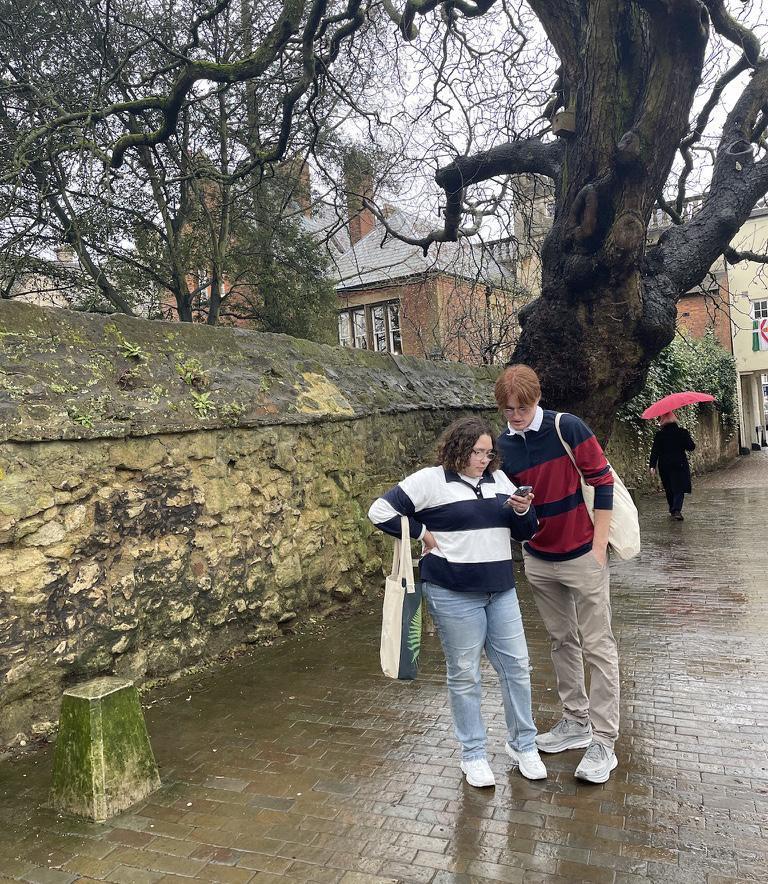

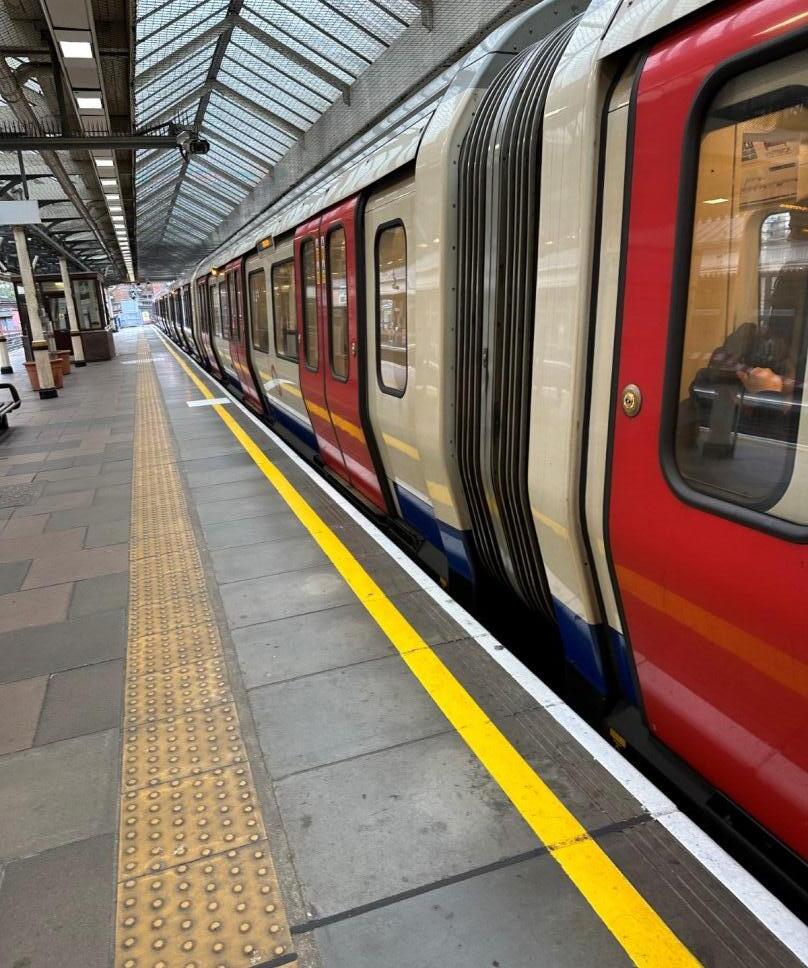
When I first landed in London and sat on the coach, all I did the entire ride was stare out the window. It was my first time in a new country, and I had absolutely no idea what to expect. The very first thing I noticed in London was how green it was. I took photos of the grass, and the architecture of the homes we passed by, and marveled at the simplicity of the small European cars. However, when I landed in America and looked back at these pictures, I immediately noticed how these initial photos paled in comparison to the rest of the sights that I saw.
Experiencing something foreign for the first time was jarring to me. I was too scared to take the tube the first day or two, but by the end of the trip, I was taking it completely on my own. Letting the unfamiliarity of London become a comfort was the most important thing I had to let myself learn to do on the trip. With a culture I was expecting to be so much like America, I was pleasantly surprised at all the small minute details that stood out to me as a foreigner. Things that I didn’t even think twice about by the end of the trip jumped out to me upon first landing. Like the soft font of signs on the tube lines, or the way the traffic moved. I remember quickly shuffling to get into a “queue”, the amount of secondhand cigarette smoke I inhaled, or the way people dressed. Or maybe it was the overabundance of cafes, the cleanliness of the city, the lack of trash cans, and how vastly different neighborhoods ranged in volume level. The rain that had drenched me initially no longer bothered me by the time I left.
These were the experiences of London that made me learn the most. They made me appreciate the mundaneness of the unknown. What feels so normal and secondary was so big and beautiful in London. The cultural and aesthetic differences between the UK and the U.S originally frightened me. Wandering around London for a week gave me a new perspective on what traveling meant to me and made all the newness feel comfortable. What was once unknown became a staple, and the uneasiness I felt vanished. A bad sense of direction and a fear of getting lost turned into, “This
is my stop!”. By the end of the week think I may have left some of my heart back in London.
While London provided me with sights and experiences that could not be replicated anywhere else in the world, I learned how to take in the simplicity of the experience. How to enjoy walking around the city with no plan in mind but to look around at things. How to travel with no distractions and to be completely present in the moment. These are the things I took away the most from London, was the attention to detail. The appreciation of small things and living presently in the moment. As I walked down Jayhawk Boulevard to head to class that first Monday back, I immediately noticed how blue the sky was here.

Irene Caracioni
Independence and adventure in an unknown world. Pushing boundaries by navigating new terrain and trying novel things. Personal growth. Studying abroad is a once-in-a-lifetime experience that allows you to encounter new perspectives and navigate different cultures, all while developing a greater self-understanding. By participating in the London Review, I was lucky enough to experience it twice, with this trip being just as impactful as my first.
On our first full day in London, I knew I wanted to visit the Columbia Road Flower Market. Open on Sundays only, this was my one opportunity to go. As our groupwide walking tour was coming to an end, our class began to split into different clusters unified by plans to visit a particular attraction. Some visited Trafalgar Square and the National Gallery, others headed to see Big Ben nearby. I pitched the idea of Columbia Road to some friends, but after follow-up investigations of how long it would take to get there (45 minutes by metro with multiple transfers), interest waned low. It did not help that the Flower Market was outdoors, and it was raining quite consistently that day.
I could have easily joined any one of the groups, but the Flower Market was something I did not want to miss. I decided to head there on my own, and I am so glad I did. I reminisced about my study abroad in Spain, where living there for a full year, I commonly ventured out on my own. I love the independence of navigating an unfamiliar area—admiring the architecture, people-watching, and peeking in storefront windows, all the while lost in my thoughts. No one to entertain but myself, and oh how exciting it is to explore something completely anew.
On another night, I set out to experience London nightlife. I met up with a friend at a bar in Shoreditch. We sat and talked and drank until the bar closed at 1 am. At this point, it was time to go back to the hotel, a onehour journey consisting of two buses, a transfer, and a short walk. While most people I know would be intimidated by this route, I shrugged it off as an inevitability. Having lived far from the city center when I was in Madrid, I was no stranger to 1-hour commutes, especially at night when the metro was closed. As I was waiting for my second bus to arrive at the British Museum stop, I even realized I quite missed them. Blasting techno club music through my Airpods, I was having a one-person dance party. Life was so good—and so easy. All I had to do was follow the signs and numbers guiding me
where I wanted to go. I had no other task or priority on my mind. It was like a simple-minded, singular-objective game, one that is difficult to lose. Knowing myself, my surroundings, and my capabilities not only put me at ease that I would make it home safe, but the opportunity to play this game once more was exhilarating.
Overall, the London Review offered unique opportunities for personal growth and adventure with the prior experience of having studied abroad before. Whether navigating London’s transport system solo or exploring iconic markets, I embraced independence and cherished the chance to immerse myself in new experiences. These moments reinforced the value of stepping outside my comfort zone and embracing the unknown. My time in London was truly enriching and left a lasting impression on my journey of self-discovery.

I love getting souvenirs from places I’ve been. Just recently I’ve started getting souvenirs that are more than just t-shirts and magnets. When I went to Colorado last year, I got my nose pierced, and after that I decided I wanted to continue this practice of getting a souvenir to carry with me.
About a month before embarking for London, I thought about getting a tattoo in London. I mentioned this to my dad, and he offered to pay for it because he knew how important this trip and its memory was to me. Of course I jumped on the opportunity to get a free tattoo.
When the day finally came around to get my London tattoo, I was nervous. I rode the tube to Hammersmith and loitered outside a Tesco near the tattoo shop because I got there entirely too early. I’d had tattoos before, but this felt different somehow. Maybe because it would commemorate my time in my now-favorite city.
The shop is called Hammersmith Tattoo, and it’s small enough to call a hole-in-the-wall, but it packed a lot of character. Music with lyrics too questionable to be on the radio played through the speakers, and the artists there were edgier than your typical Londoner. While most Londoners wore overcoats and boots with jeans and a scarf, the artists wore band tees with holes in the sleeves, fishnets, and combat boots.
I walked up to the counter and said I had an appointment. A woman with a black pompadour-mullet with teal punk highlights seemed to materialize from around the corner.
“I
think you’re with me,” she said.
She goes by Freaky Amandine. She had an accent that I thought was French and posters of topless women on the walls of her workspace. She was nice but warned me she doesn’t talk when she tattoos. That was fine with me, but it also meant I had to bear the pain in silence.
And it hurt. Badly. As she inked the quill pen on my forearm, I imagined a searing-hot scalpel dragging across my skin.
Some of my suffering was due to nervousness. Some of it was due to not eating enough for breakfast that morning. Or British tattoos just hurt more, but I think it’s the former two possibilities.

She asked me multiple times, after I had shifted enough to be annoying, if I wanted to take a break. I told myself I wasn’t a quitter and said through clenched teeth that I was fine.
We both knew I wasn’t.
Eventually, she said we would take a break because she was “tired.” I didn’t believe her. It was because I was all but flopping on the table. I looked at it in the mirror, and I fell in love. The pain was completely worth it, but I still internally groaned when it was time to get back on the table for her to finish the shading.
When it was finally done, it was beautiful. A quill pen with birds flying around it, a tattoo I’ve always wanted to symbolize my love for writing and birds. I think it’s possibly the most beautiful one I own, and now whenever I look down at it on my arm, I remember London. I also remember pain, but that memory is not nearly as sharp.
Thanks, Dad.
Bhavya Gupta
The earliest time that I was awake and about in London was at 8am in the morning for our walking tour of the city. Although I was sleep deprived and groggy, the people of London weren’t. In Hyde Park, there were runners taking different paths in the rain, some were with their dogs and some with their strollers and kids. Other people were sitting on the park bench reading a book and some were catching up with friends and families.
On Sunday morning, we were able to ride on the tube for the first time and I got to experience public transportation in a foreign city. I passed by a group of individuals who were all speaking three different languages and the way they dressed was different from anything I had ever witnessed in Lawrence.
Having observed the way that people in London live, I realized I wanted to emulate that in my future. I really enjoy running and appreciate the accessibility of a walkable city such as London. My goal after my undergraduate studies is to go to medical school, and London taught me that I believe that the only way I could stay sane would be to live in a city that would allow me to fully embrace early Sunday morning runs and fashionable attire.
When I arrived back in Lawrence, I realized how much I missed the long commute times to different destinations in London or how I was able to experiment with fashion that I wanted to wear- as I am not the type of person to particularly enjoy wearing leggings or sweatpants. I thoroughly enjoy being dressed up for my day and London made me feel like living in a big city could help not feel insecure about that choice.
Even more, when I went to Notting Hill market, the thrift scene was vastly different from Lawrence, or anywhere in Kansas. It was a hub for leather jackets, high quality vintage sweaters, and tops that would single me out in Lawrence if I ever wore them. With limited space left in my luggage, I had to begrudgingly window shop for an hour in the market knowing that, realistically, I couldn’t
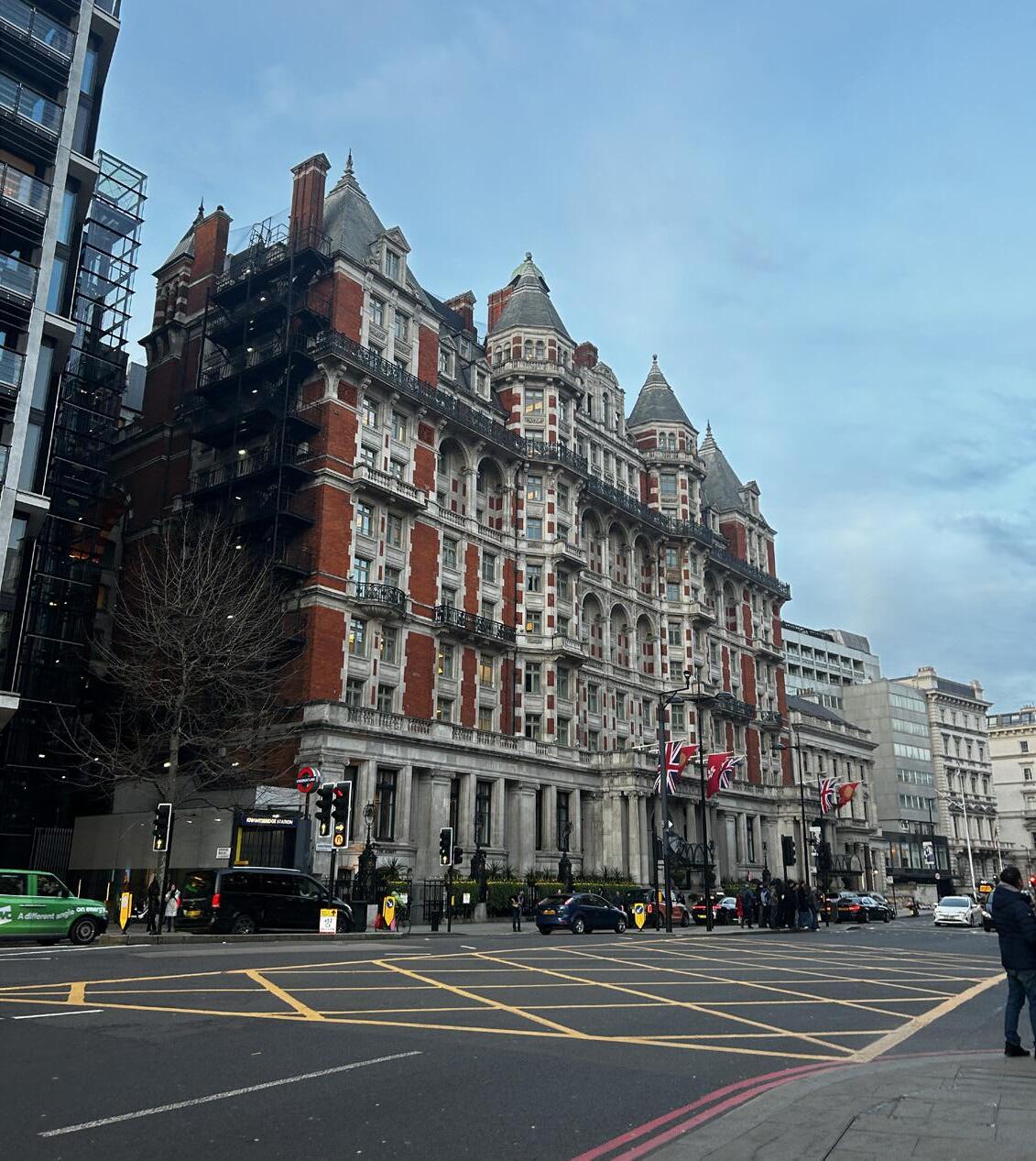
give in to buying clothes I would feel uncomfortable wearing in Lawrence.
This further reinforced my desire for getting out of Lawrence and living in a big city, where public transportation, long commute times, and early morning runs in parks, were all normalized. Being able to live in a big city would also let me fully embrace the style I want to pursue. Because of London, I feel like I now know more about myself and the type of environment I would undoubtedly thrive in.
I grew up with The Hobbit as a bedtime story. My dad would read a chapter or two to my sister and I before bed, because he knew that The Hobbit was originally written as a bedtime story for Tolkien’s children, and he felt it was appropriate for the story to be told in the way it originally was. When I got older, I read The Lord of the Rings, Roverandom, and The History of Middle-Earth. The fantastical lands of Middle-Earth have always been there for me, to the point where I never had to think of their creation. They always existed to me, and in my brain, that means that to some extent, they have always existed to everyone.
Then I went to Oxford. I walked through the University and down passages between buildings, finding Elvish written above doorways, discovering a Tolkien translation of Beowulf, passing by the Eagle and Child pub before finding the memorialized Tolkien bench on the banks of the River Cherwell.
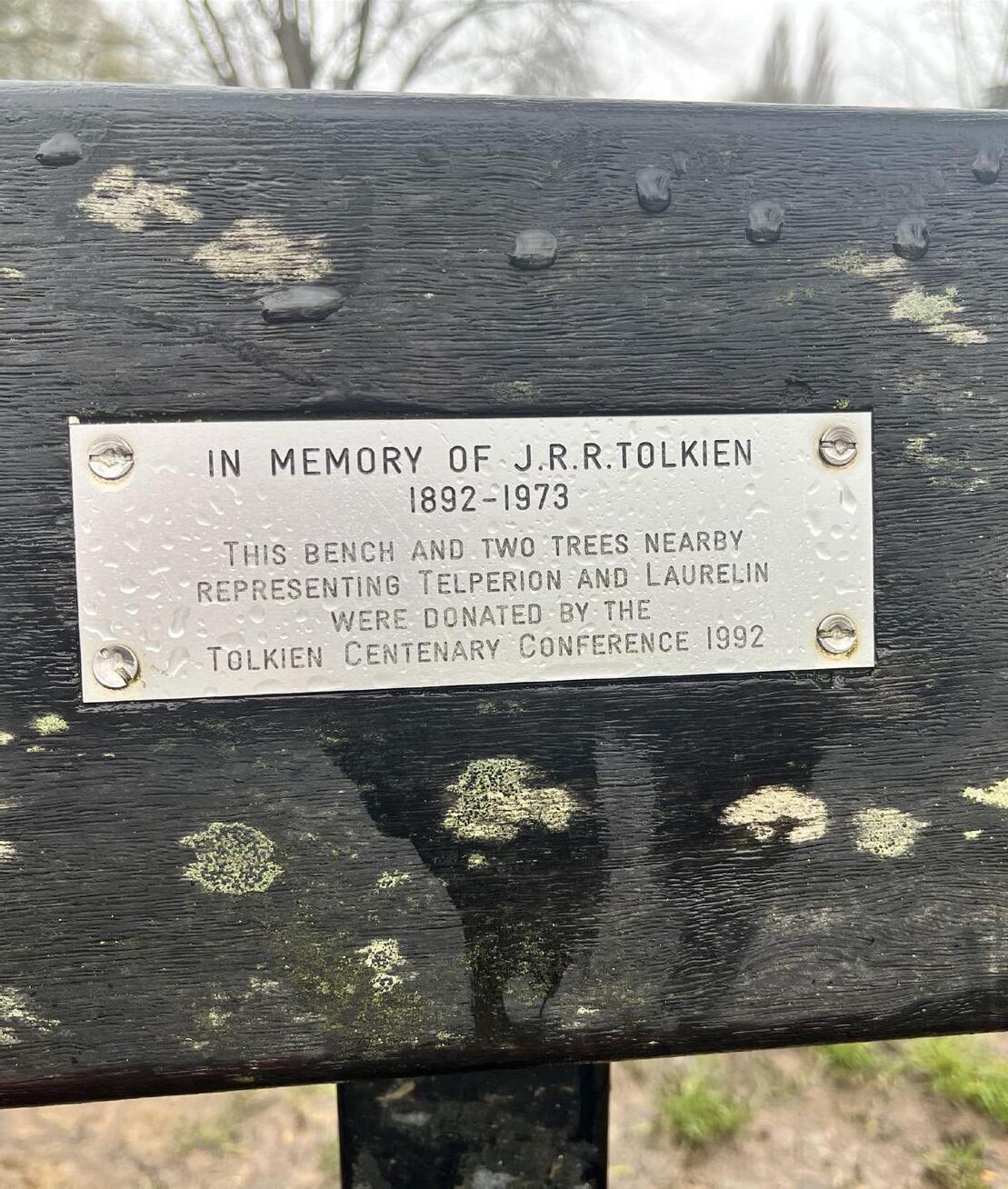 Madeleine
Madeleine
There is something so quietly intimate and respectful about existing in the same place as an author you revere once did. Sitting by the river on the bench, it appeared as if his stories were coming to life. The gnarled, twisted tree to my left seemed to inch forward, Ent-like in its leaning and reaching of branches. The two dogs by the shore trying to go fetch a stick morphed into Sméagol and his brother fighting over the ring by the river side. Further down the river, each moving tree limb and waving willow leaf brought to mind the graceful elegance of Galadriel, Arwen, and Legolas. At any moment I expected Bilbo to come and sit beside me. The story that I knew too well seemed to fade in and out of focus around me, as if all I needed to do was walk into the river and I would appear between the pages myself.
The creation of the lands of Middle-Earth seemed so simple sitting on the bench. It made perfect sense to me how someone could walk the bank of the river and through the streets of Oxford and be inspired to create a world that would go on to influence fantasy writing for years.
While in London, there was the underlying knowledge that I was walking in the same neighborhoods and seeing some of the same sights that my favorite authors had: Zadie Smith, Virginia Woolf, Oscar Wilde, even Shakespeare. I had even seen original manuscripts from some of these authors at the British Library a few days before. But nowhere was it more apparent that I was truly existing in the same place as an author than it was in Oxford. It seemed to ooze Tolkien — not just in the fact that the city was proud that Tolkien had once resided here, but in the atmosphere itself.
Betsey Lewis
I have chronic migraines. I have since I was sixteen. The levels of pain I experience and the frequency between episodes have fluctuated over the years, but most weeks, I have a mild (typically manageable) headache five out of seven days. This headache often builds to more intense levels of pain of a migraine once or twice a week. If I catch it early enough, a concoction of Aleve, Riboflavin, and ginger supplements can alleviate my painful symptoms. However, even if I can manage the pain, I still experience fatigue, brain fog, and/or irritability when any big migraine cycle passes through. This habitual process of symptom recognition and management has been my norm for years, so I did not consider the toll my chronic pain would take on me when traveling in a new environment.
There is this misconception that traveling abroad is all glitz and glamour—chatter and excitement. And while parts of this are true, that is not the whole story, especially when traveling with a chronic condition. New environments (like the gloomy ones in London) can be a challenge for us migraine-havers because of that excitement and novelty. So, after a grueling 24-hour travel period of subpar airplane food, an overwhelming amount of new sights and smells, two hours of sleep, and anxiety about traveling solo for the first time, my head was pounding. I tried to manage my symptoms with my tried-and-true methods, but nothing seemed to help.
In typical London fashion, the following day was grey and gloomy. The overcast coupled with the bombardment of constant novelty proved to be the perfect neurological storm.
On Monday morning, I woke up early to another grey day—my brain feeling three times too big and throbbing. Katie, Kahill, and I threw on some clothes and walked downstairs to where breakfast was being served. As we shoveled pastries and tea into our mouths, silence was kept. There was no glitz. And unfortunately, no glamour either. We were all exhausted, and nothing in the dregs of hashbrown and
bean-infused tomato sauce left on our plates screamed “excitement.”
Worn-out and weary from the pain when we returned to the room, I finally told the two of them how I had been feeling. They listened intently and asked what they could do to help. Reminding me that it is okay to rest, they suggested that we stay in the room and nap throughout the morning. When I resisted and argued that we had made plans to explore museums, Kahill told me not to push myself, that there would be time.
Taking an Aleve and tucking myself cozily underneath the covers, I began to cry. I do not know how I expected them to react, but when my pain was met with such tender concern and curiosity, I was reminded of what it means to care and be cared for. In the vulnerable sharing of my pain, I was not ridiculed for being over-dramatic or told that I needed to “toughen up” for plans’ sake, as is so often the case in our hardened society. Instead, I was shown care, validation, and love.
That morning, I was able to sleep for four additional hours. I was able to dream. And when I awoke, I was met with the same care and reduced levels of pain. Knowing that I did not have to move at an unsustainable pace and could take time to rest in the comfort of my two friends was the support I needed to carry on, even when the pain did not fully subside for another few days.
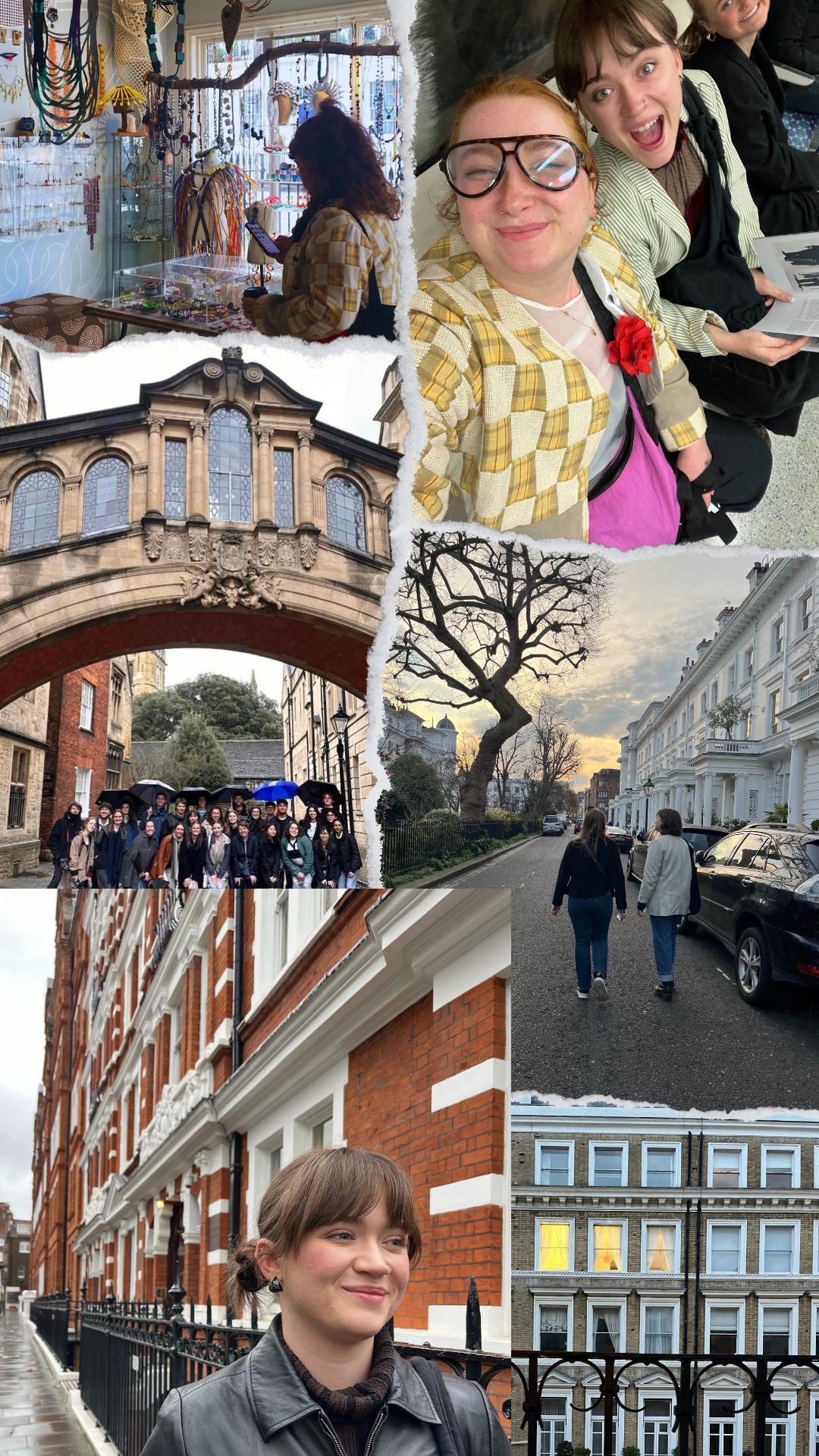

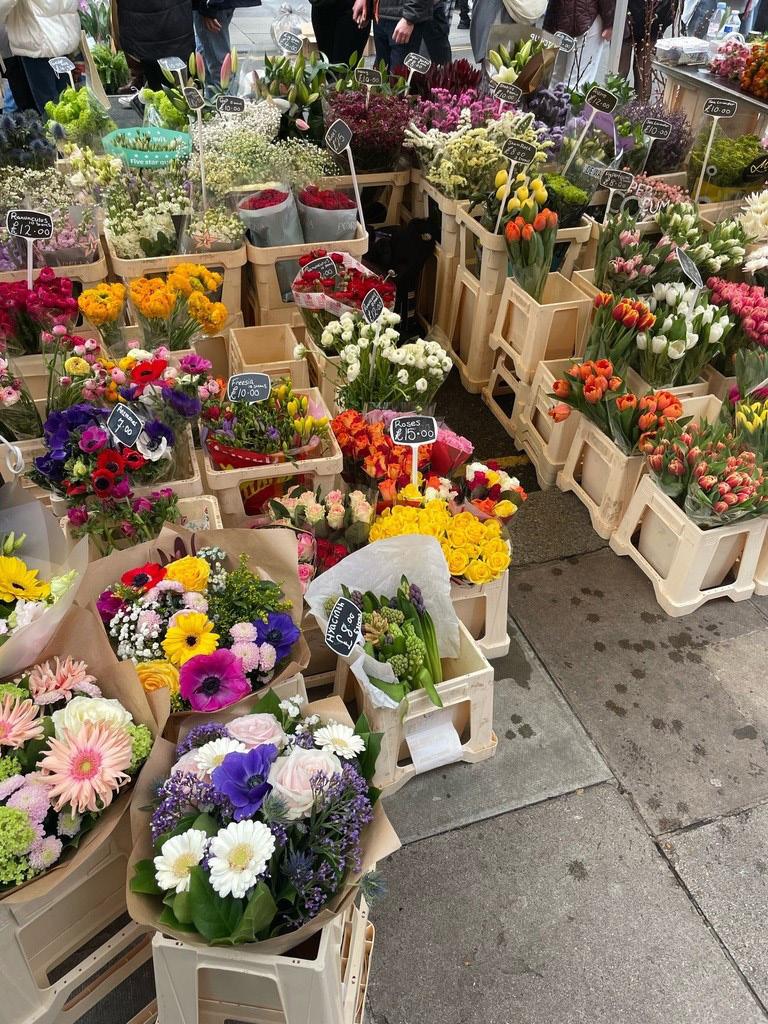
I was born in the summer on June 29th, a Tuesday in Kansas, and almost exactly a month later, on July 24th, in Brighton, my cousin Kayleigh was born. From then on, there was an American “K” and an English “K.”
We have lived parallel lives up until this point, despite being separated by over four thousand miles and an entire ocean. Even though we have only seen each other twice in the past fifteen years, we share a deep sense of closeness and always seem to fall into step whenever we meet.
And so, the second I knew I was going to London, I called K, and we screeched lovingly into the phone about how desperately we needed to see one another.
The last time I saw her, I showed her the intricacies of my 13-year-old world in Kansas when we giggled on the Sheridan’s patio over melting custard in a humid heat someone from England had never experienced. Our rosy summer-flushed cheeks pressed in on each other as we shared melty hugs in the backseat of my parent’s station wagon on the wrong side of the road.
So naturally, it was her turn to meet me outside the pub on alumni night, her face lighting up as I called her name—like no time had passed at all. Taking each moment together in stride as I said good night to my roommates and introduced her to Mary, we grasped hands and fell through the doors at the Gloucester Street station, ready to take on London, for one night, reunited like we were some multinational version of “Donna and the Dynamos.”
The mid-twenties version of our reunion was no less loving, no less laughing, no less like a salve for a part of me that I think I forget I have, the part of us that isn’t lonely but still wishes to be seen, the childish laugh we keep to ourselves and only share when truly at peace. As we ordered dinner in the seven-dials market and I gave my name for my order, to hear it called out with the proper pronunciation, the emphasis on the right consonants, an easiness slipped over my skin as we smiled at each other knowingly. In those few hours, I
was reminded of the truth that there is a home for us, wherever there is love to be shared.
When we hugged before I stepped onto the southbound circle line and she ran to the northbound, I was struck by the intensity of the joy that I felt. Despite the distance and the fact that we are only related by marriage, we are the two K’s, cousins by law, and deep true friends by both circumstance and active conscious choice. That night after we ate, I sat on the tube by myself for the first time, counting down the stations from Covent Gardens to Kensington with my little red notebook on my lap, and I wrote, the beginnings of this essay and poems about the shrieking brakes between stations, grocery lists for imaginary lives in which I shop at Tesco instead of Kroger. And I hopped off the tube on time, gathered my wits and my tote bag, and found my way back to the Strathmore. Perfectly content in the spring air of London to find two unread messages on my phone from Kayleigh:
“Made it back to east London—love you!”
And “that wasn’t enough time, please tell me you’re free Saturday?”
Before I even had the hotel key in the door, I was typing back, “Made it to Kensington! Love you! Meet me in Notting Hill?” As I recounted my evening to my roommates, and we giggled to each other, I was struck by a line from everyone’s favorite English Christmas film, Love Actually: “If you look for it, I’ve got a sneaky feeling you’ll find that love actually is all around.”, especially in London.
• Make sure to have a good umbrella
• Bring waterproof shoes
• Make the most of the museums
• There aren’t many public bathrooms, so plan accordingly
• Make sure you have a contactless payment method ie Apple Pay
• Allow yourself to take naps and sleep more in general
• Don’t use US hair dryers because it will likely blow a fuse
• Wear a money belt or have a safe way to carry your wallet
• Map things out ahead of time because the street signs can be confusing
• Borrow a local’s Tesco club card to save some money
• Don’t use a discover credit card because they may not work
• Set a budget
• Don’t lose your Oyster card
• Oh, and did I mention to bring waterproof shoes?
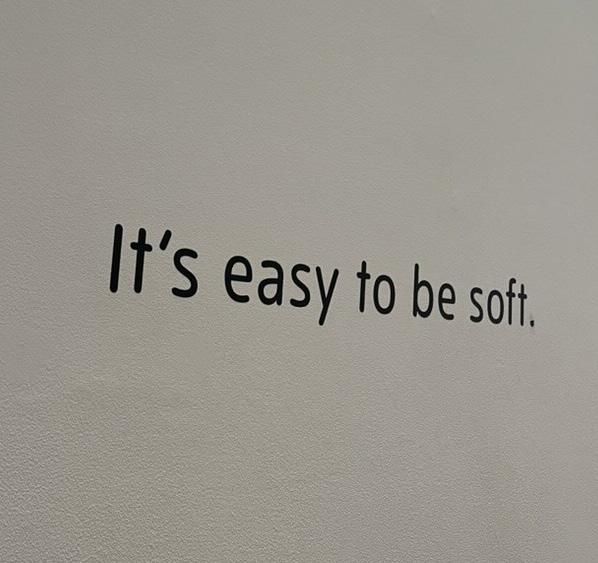

My dad and I have always had a special relationship. I was the youngest child like he is. I am goofy like he is. I am anxious like he is. I thought I knew everything about him for the longest time.
My dad has a lot of quirks; his ability to pick out accents and copy them, his sense of humor, and his absolute disregard for what anyone thinks. Growing up, I so badly wanted to emulate everything about him because I thought he was the coolest person in the world.
Since we were together for so much of my childhood and he had been in my life since I was born, it took me a long while to realize that my dad lived a full life before he had any idea I would exist. So, after realizing this around 6th grade, I made it my mission to try and get to know who my dad was before I came around. He would tell me all sorts of things about his college adventures and being with my mom, but for so much of my childhood, he rarely talked about his own.
The rare glimpse I got to see into his young life was when he would talk wistfully about riding the tube, drinking Lilt, or when he would bring home a Mars bar or bag of flying saucers from Brits. There was part of him that I perpetually missed because I never got to know it well, and it was so mysterious and foreign to me. We couldn’t just go to his childhood house like we
could to my mom’s.
Over time I got to know that he not only grew up in Brussels, Belgium, but moved to a London suburb, Northwood, when he was eight. His routine was to go to school with one of his parents, or take the tube once he got old enough, spend the whole uneventful day at school, come back home, make himself a snack (usually instant mashed potatoes), and watch TV with his mom instead of doing his homework. I started to put together that some of his whimsy came from growing up in big English cities.
So, once I got the opportunity to come to London, I knew I had to go and see his house, follow his routine, and emulate a day in my dad’s life.
On Thursday morning, I set off from the Gloucester Road tube station to Baker Street, and then from Baker Street, I caught the semi-fast train headed toward Westford. A forty-minute scenic ride later, I walked up the Northwood tube station stairs and set down the same path my father took every day to get home from high school.
It was unreal to be stepping on the same ground he stepped on and looking at the same houses. I had an uncanny feeling that I was doing something wrong.
This journey was so special to me because I know and love my dad as he is now, but when he was taking this journey, he was a completely different person. I was basically marching in the path of a stranger.
Strangely, this gave me a renewed feeling of joy and freedom for the rest of the trip. I may try to plan my life and live “the best way” to set myself up for success, but I will never be able to plan or spreadsheet my way into who I will eventually become. All I hope is that who I become is half as amazing as the person I call my dad.
In her well-known—and my favorite—essay “Street Haunting,” Virginia Woolf rambles through the streets of London under the guise of buying a pencil. Rather than focusing on her final task or destination, the essay meanders between an array of ideas ranging from Woolf’s internal thoughts and evocative memories to ruminations about the passersby she observes along the way. In a way, Woolf’s essay encapsulates a part of my own experiences exploring London: wandering through quiet neighborhoods as well as swarming streets whilst observing the life of London flow by.
The first half of my days in London were spent solo as I—much like Woolf’s essay—meandered from one place to the next with no fixed plans or bucket-list items to check off. I let my curiosity lead me from one museum to the next, interposed by time in between sauntering through iconic districts and quaint neighborhoods. Museums like the British Musuem or the V&A— despite all their problematic colonial baggage—took up hours of my days as I slowly made my way through their vast collections of artifacts. Yet, I realized that
Fatima Asif
observing the quotidian lives of the locals was just as—if not more—intriguing. I still remember my first day taking the tube by myself as I weaved through throngs of people, turning down halls and taking flights of stairs all the while walking next to a lady in the most peculiarly elegant outfit I had ever seen (in real life). She wore a full-length bright emerald dress embellished with four or five thin, ductile wires poking out of it at various angles; each wire was fitted with artificial butterflies at the ends. A matching fascinator completed her outfit.
Although I loved my solo excursions of wandering London at my own pace, I must admit that some of my favorite memories occurred when I reunited with my fellow London Reviewers, whether it was over dinner or for group excursions when I was “museum-ed out.” In fact, my time traveling with a group led to my first-ever Uber boat ride (which was laughably only two minutes long), amazing panoramic views of London, and a trip to the Waterloo tunnel, just to name a few. So, while solo “street haunting” was fun, the time I spent with my fellow Reviewers and friends was arguably my most memorable part of the trip.
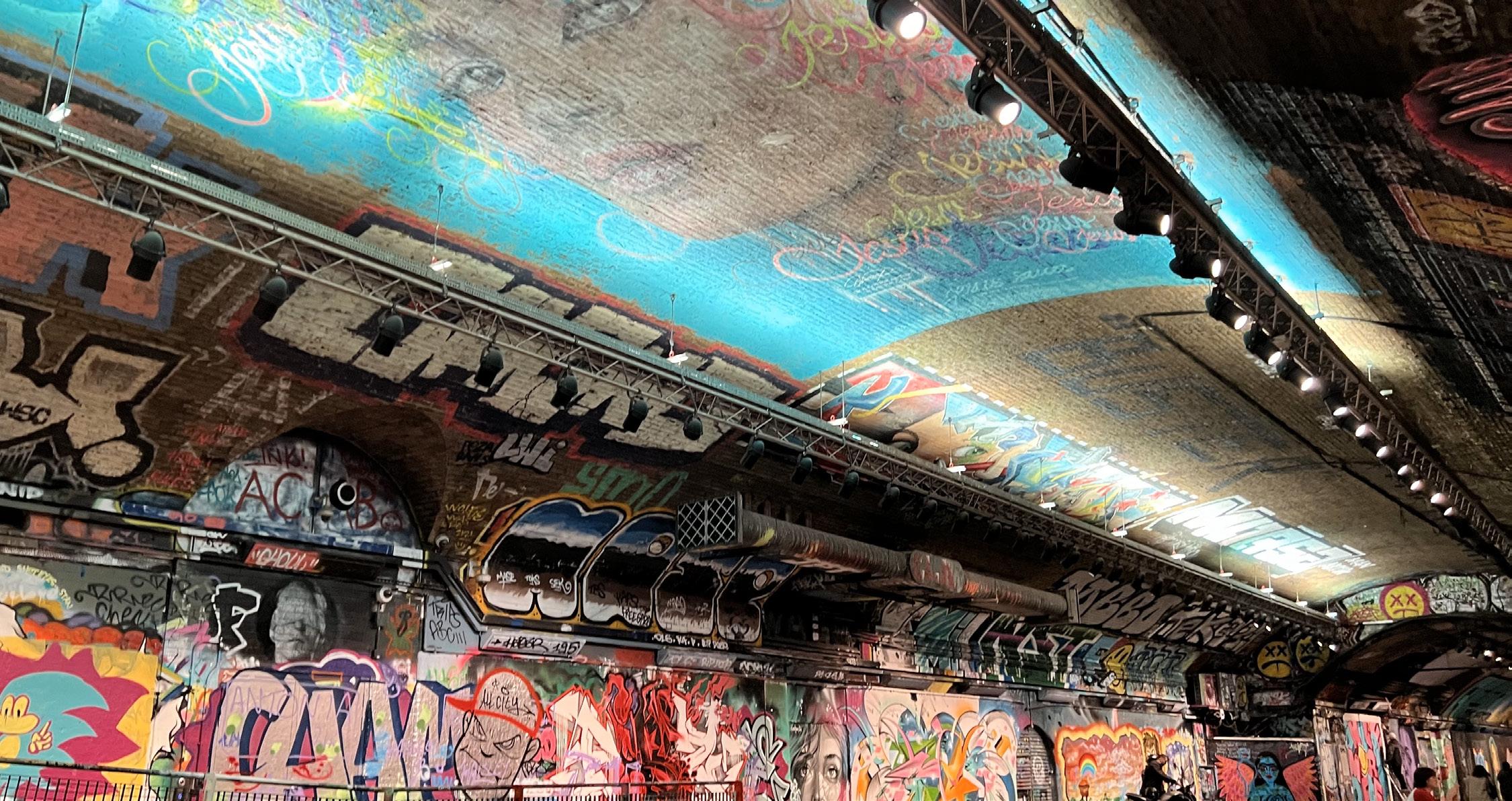
At the tender age of seven, I was awakened by an insatiable curiosity, one that compelled me to drag my mother from her slumber at an ungodly hour, all in the name of witnessing a royal affair unfolded on television. It was the wedding of Kate Middleton, a momentous occasion that captivated my young mind as I beheld the transformation of a young woman into a princess. Despite our American roots, the British royal family held a significant place in our household, a fascination that transcended borders. My grandmothers displayed their Princess Diana wedding plates amongst their fine china, and my mother reads every book on the Royal Family the second it is published.
Our annual Christmas tradition was incomplete without the ceremonious viewing of Queen Elizabeth’s holiday address, accompanied by scotcharoos and Ritz crackers with cheese, and the joyous chaos of gift-giving. The women of my family would cuddle up with blankets, fireplace ablaze and take in the words of Queen Elizabeth, marking the end of a year. When Netflix released the first season of “The Crown,” it became a family ritual to gather around the screen, immersing ourselves in the saga of Queen Elizabeth’s reign. The release of season four sparked impassioned discussions, particularly about the tragic plight of Princess Diana, reminding me once again of the enduring allure of royalty in my upbringing.
Yet, amidst the regal spectacles, there existed another realm of enchantment that shaped my early years—a world of literature and imagination. Long before I could decipher the written word, my mother introduced me to the timeless tale of Anne of Green Gables through the beloved Canadian miniseries. The image of Anne, with her basket and braids, reciting Tennyson’s “The Lady of Shalott,” remains etched in my memory, a symbol of innocence and wonder.
As I embark on the threshold of adulthood, preparing to embark on a new chapter post-graduation, I find solace in revisiting the cherished relics of my childhood. The verses of “The Lady of Shalott” and the lore of the
British monarchy offer a comforting familiarity amidst the uncertainties that lie ahead. And so, when I stood in the hallowed halls of the Tate Britain, gazing upon Waterhouse’s masterpiece depicting Elaine, The Lady of Shalott, I felt an overwhelming surge of emotion, tears filling my eyes.
In that moment, the lines between reality and fiction blurred as the opening strains of Anne of Green Gables echoed in my mind. With trembling hands, I sketched my own interpretation of the iconic figure, seeking to capture the ineffable essence of my reverie. It was a culmination of a lifelong dream—a poignant reminder that amidst life’s tumultuous journey, there are moments of sublime fulfillment waiting to be realized once more.

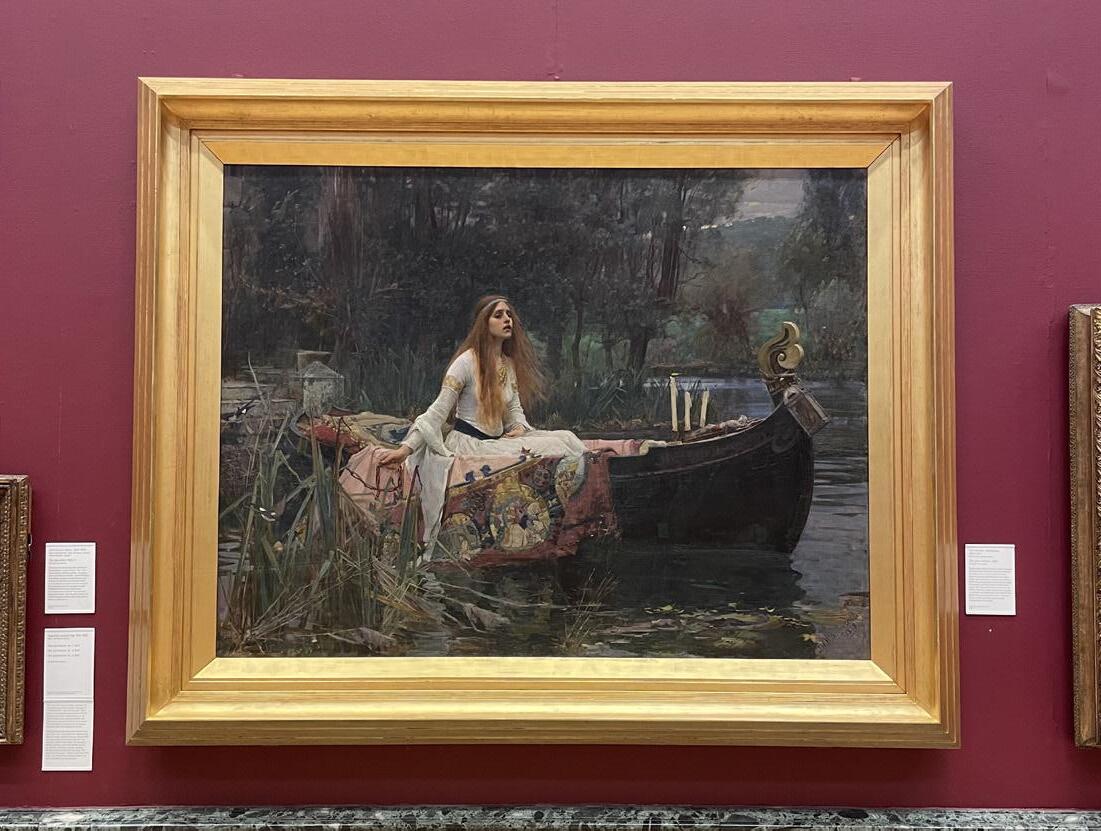


While awaiting the arrival of the train to Oxford, I knew absolutely nothing about the city- I certainly didn’t expect it to become my favorite part of the trip. The second I stepped off the train, I was immediately drawn to how different Oxford was from London. The first thing I observed was how silent it was in contrast to the bustle of cars and chatter in London. In Oxford, I was aware of everything around me. The noises differed from the sounds of the big city. Instead of cars honking, the sound of rain hitting the pavement filled the air with serenity. The sound of voices traveling down the streets was replaced by chirping birds. Oxford was elegantly poised, and I noticed that all I wanted to do was walk up and down the city.
Oxford has a charm to it that far exceeded my expectations. Bookstores lined the streets, and Blackwells specifically kept me entertained for hours. Floors and floors of books lined the walls, detailing just about every discipline you could imagine. The covered market brought shelter from the rain for a while, where
food and shopping stalls stretched for blocks. A hidden crack in the wall revealed a tucked-away tavern where I got to sit with friends after a long day. Museums carried on, and the school buildings of Oxford University sat upon grass so green it looked like it had been painted.
Despite all the views and quaint experiences Oxford had to offer, my favorite part of the day was wandering the streets. With no plan in mind, no GPS, and nowhere specific to go, I felt the true beauty of Oxford revealed itself best this way. Walking around the city was so beautiful because it was unlike any place I had seen before. Buildings older than the U.S. lined the streets, and the architecture was so different than what I was used to. The sidewalks were almost as wide as the streets at some points and tightened back up again at others. This lessened the flow of traffic, making the space feel open and less crowded, but also keeping some of that city feel when walking. The trees were starting to bloom, the flowers had sprung up, and the

streets reflected sunlight and streetlights from the rain.
The beauty of Oxford came from the new experience of architecture, coupled with the enjoyment of simplicity. Where London felt like it never got quiet, Oxford felt at peace all the time. It was a completely different experience from what I had seen so far in London. The subtle exploration of Oxford was the best part of it all. While I felt like I had to cram my days full in London, Oxford gave me the chance to enjoy myself in any way that I wanted. I had no obligations and nothing to look for. Oxford taught me how to be present in the moment and to enjoy the sights of a city that I couldn’t experience anywhere else.



As I was transported to Oxford, I was transported to a state of in-between lives that I felt I could live in universities I have always dreamed of attending. (Thank God for the timeliness and respectability of British transport.)
Between sheets of rain and picked-off cuticles, I smile at sheep and feel a restlessness that embodies the homesickness I have never been able to place. I feel myself at home more in the UK than I have felt in years and then feel guilty about said feelings; I text my mother, who’s still asleep, and the cycle restarts.
Since childhood, I have revered libraries in all their glorious forms: dusty, clean, charming, expansive halfway points between what you know and want to know. The Bodleian Library opened its doors in 1602 and has since remained a touchstone of wooden shelves and academic vigor. With 13 million printed items tucked underneath the floorboards of Oxford, the Bodleian is second only to the British Library in size. And since I was a little girl, the Bodleian Library has belonged to me. (Me & every Oxford student, that is).
For years, no one I talked to knew what it was, where it was, or who Bodley even was. So, I held that library and its 13 million books in my heart—romantically calling it the Bod and smiling about how, one day, I would stand under its archway and feel at home.
There is such majesty and expanse to it, and it is one of six libraries in the UK where, legally, one copy of every book published within the commonwealth must find a home on its shelves.
As it stands, seeing the Bodleian Library in person brought legitimate tears to my eyes as I craned my neck in the Oxford rain, squeaked my shoes against polished marble, smiled apologetically at the gift shop woman as I dripped rainwater and tears on her desk, and moaned about 15p tours of a library I could touch at my leisure for free—I felt at peace.
On the train to Oxford, I sat across from Betsey and Katie, shoulder to shoulder with Lolly, with borrowed headphones in my ears and my head on the window. At this moment, there is peace, and there is revelation.
Coming home to a place you have never been is such a floaty, flighty out of, out-of-body moment that you fear that it’s all in your head, and maybe it is—all in your head.
But that means that it’s inherently yours; no one can take it, and no one can tell you that this place isn’t yours.
No one can tell you that these shelves and these stacks don’t creak out your name as you sigh out your odes to Sir Thomas Bodley himself, this world of wonder he left you.


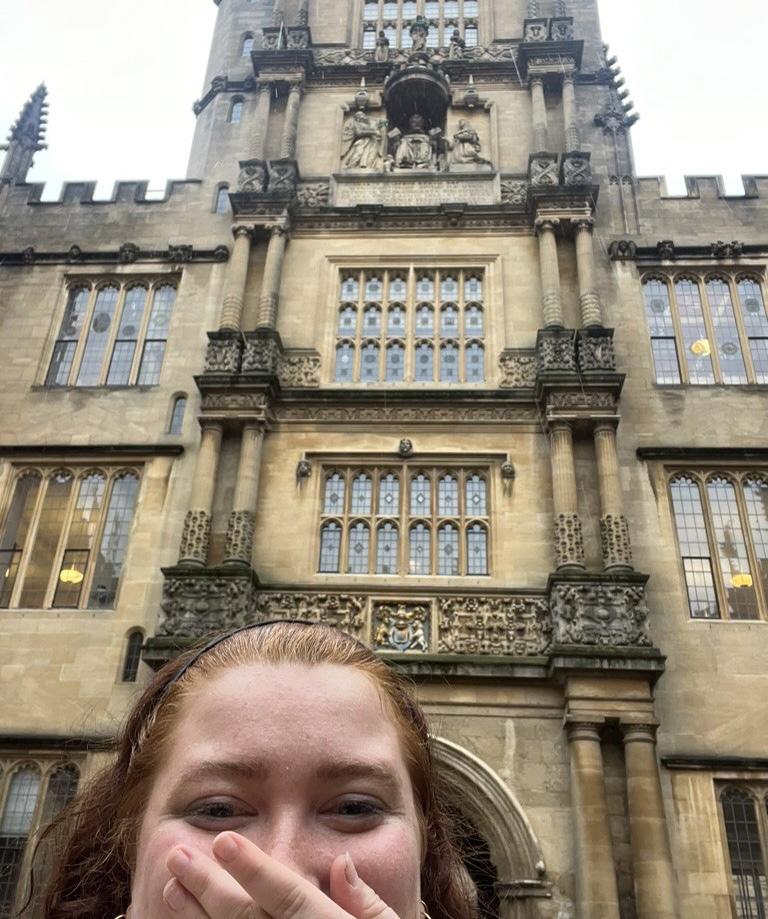
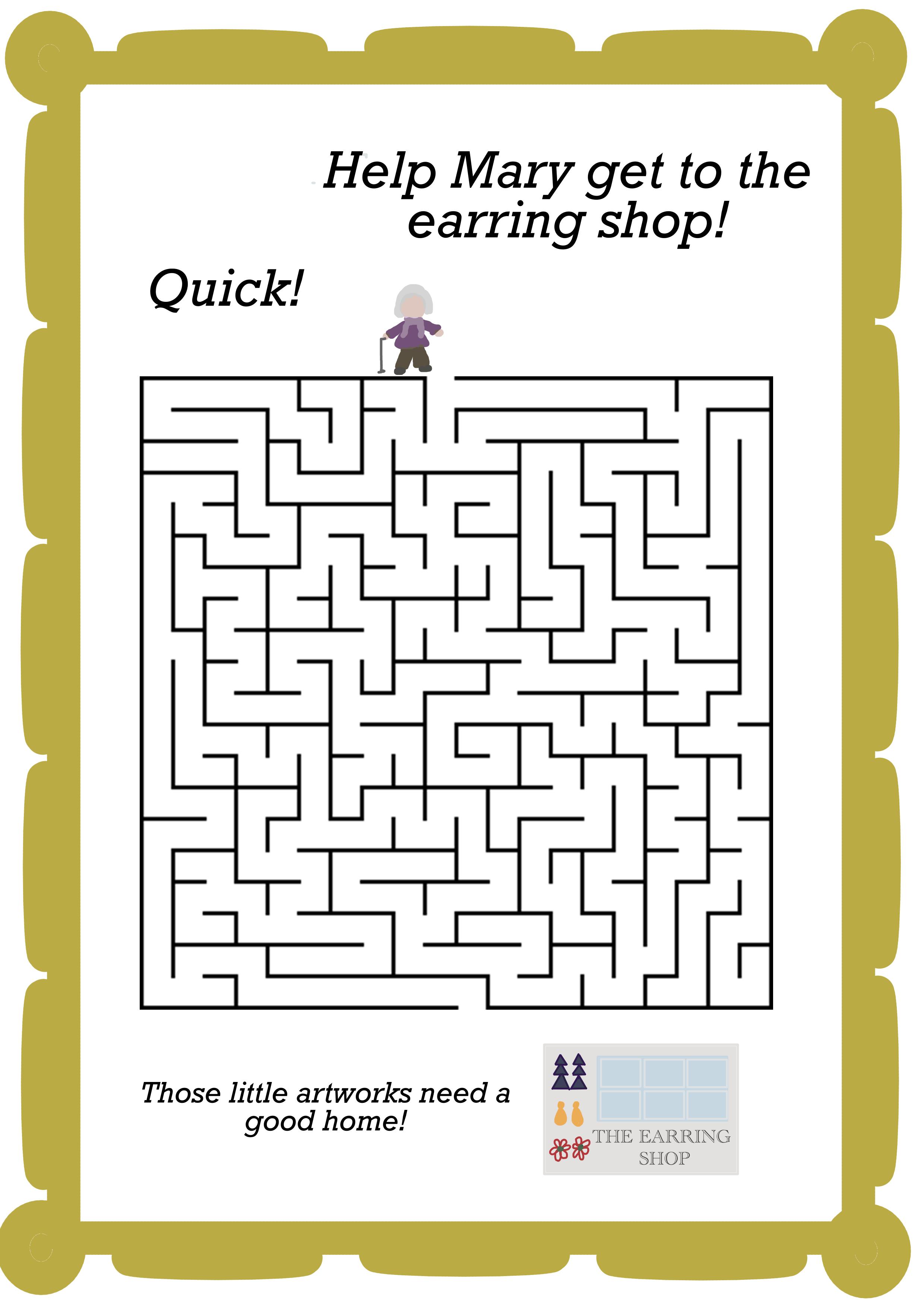
When I was thinking about what I would do for the book while in London, I kept getting flashes of inspiration about what I would paint or draw from the sites of the city.
I was excited and very optimistic about what I would be able to create. I’ve never had formal artistic training outside of high school, and even that is dodgy. I would watercolor in my mind the grey of the sky, the off-white buildings, and the wine red of the brick—not really knowing how it would come out in person.
None of my paintings or drawings made it onto the page in London since I didn’t fill out my sketchbook in the ways that I planned, but they lived rent-free in my head. I was so ready to bring them to life as soon as we got back.
But once we did, on the first day back in class, the realization hit that it would be a ton of work to hand draw as much as I wanted to. Carina was amazing and had already drawn up a mock-up for the cover, and Conner swooped in and said we could split up the rest of the lot, and I was so ready! Both were adept at using their digital drawing tools; however, I was stuck in paper media.
I so badly wanted to be a help that I committed myself to learning and trying and doing all of the work I could to make the best covers I could. The first one that popped into my brain was “See it, Say it, Sorted,” after the repetitive intercom blast on the tube, and I took inspiration from Carinas’ cover with how it would look.
After that, it all went downhill. It was way too much work in too little time to create the masterpieces I wanted, on top of a very steep learning curve.
Connor was also the one to give me a reprieve at the end. He offered to put in the picture collages you now see as the cover of every section, and I think they look amazing. I was completing sub-par work that I wouldn’t have been happy with if it went to print. But what I am happy and so very proud of is the fact that I plowed up that learning curve, I tried my very best, and I am so glad that those drawings won’t see the light of day. But this one deserves a spotlight, and I think it is just great.
Embarking on a trip to London provided me with an extraordinary opportunity to delve into the academic landscapes of two prestigious institutions: Oxford University and London School of Economics (LSE). As a senior majoring in economics and mathematics, graduate school has been on my mind, but nothing I have committed to just yet. However, visiting these schools ignited a newfound interest in pursuing a graduate degree in the United Kingdom.
Stepping onto the historic grounds of Oxford University, I was immediately struck by the aura of academic excellence that permeated the air. The buildings, made of bright Cotswold stone, shone up out of the ground, even on the dreariest of days. The tour of the Bodleian library on campus took me back four centuries; I was astonished to learn that Oxford students used it just as if it were Anschutz at KU. I couldn’t help but feel a sense of reverence for the tradition of knowledge that has been cultivated at this institution and the standard of academic excellence that continues to this day. The prospect of one day participating in the rigorous scholarship of Oxford University resonates with my academic ambitions.
Visiting the London School of Economics was a stark contrast to the centuries-old charm of Oxford. Nestled in the bustling heart of London, LSE exuded a dynamic energy that reflected its status as a global hub for social sciences. Outside, students were everywhere— walking to class, congregating in the courtyard, waiting patiently in line at a delicious-smelling, curry-serving food cart. I peeked inside the buildings I could and visited the library and study spaces. My plans to visit the Department of Economics building were thwarted, however, by the necessity of a keycard and a friendly guard who informed me I needed to join a tour (unfortunately, they were fully booked that day). Nevertheless, my visit was inspiring, as I could genuinely imagine myself attending and loving LSE.
Irene CaracioniMy experiences visiting Oxford University and the London School of Economics reaffirmed my desire to pursue a graduate degree in economics, especially at one of these two institutions. Not only do Oxford and LSE rank in the highest caliber, but their intellectual communities are inviting and stimulating and would challenge me to excel. My eagerness about attending either school can be best understood by my response when asked about my visits: “If I get in, I’m going!”


As someone with a moderate amount of social anxiety, I knew traveling to such a big city as London was going to be a challenging adventure. Especially having never traveled to a foreign country, the lack of familiarity was daunting. The plane ride from Chicago to the London Heathrow airport was one of the most mentally demanding trips I’ve taken. However, all of this was tolerable because I was with one of my best friends. From meeting up at MCI that morning to getting to our hotel the next afternoon, Wyatt and I didn’t dare separate in order to cling to the small amount of familiarity we had from home.
The beginning of the week held some of the best parts of the trip for me. I really got to know some amazing people on the trip and enjoyed my time there to the fullest, or at least I thought. Tuesday hit and everything went downhill rather quickly. It was the day when the whole group took a train to Oxford to spend the whole day there, ending the time with dinner at a pub with the majority of the group. Sadly though, Wyatt and I were never able to make it to that dinner.
To summarize a rather disheartening experience, Wyatt had gotten food poisoning from the prior day and was comatose in the hotel for the next 3 or so days. At first glance, this was the most devastating thing to ever happen to me. I was feeling slightly sick for other
reasons and had to stay in with the sick energy radiating from the other side of the room, feeling trapped in the small confines of my bed. On top of this, the person I knew the best and wanted to spend time with on the trip was down for the count and was going to be ill for a while. All of this combined threw me into a spiral of loneliness and gave me cataclysmic homesickness. However, I did not let this hinder my experience and decided that I would go out by myself the next day. I later planned out the next day of museums I could go to within a short tube stop away along with coffee shops near them. I decided that I would not let my anxiety get the best of me and push myself to make the most of my circumstances.
The next morning came, and it didn’t quite go as planned. As I left the hotel, I found out that my bank had flagged my card for fraud when I went to get coffee at a nearby cafe even after telling them weeks in advance that I would be on this trip and how long I would be gone. To make matters worse, my cell service would not work to call and fix the issue myself, so I had to text my mom and grandma through other apps like Instagram and Facebook to fix the issue for me. From this, I ended up having a mental breakdown on the stairs of the hotel, rain pouring from the sky and mixing with my tears. After sitting there for around half an hour, I thought more about my situation and laughed. By crying in public, it pushed away my mental blocks of fear of showing emotions in front of strangers. It made me realize that the random people on the street couldn’t care less about what I was doing, let alone outwardly judge me while passing by.
By the time I was done with my revelation, it was time to go to the pub and have an alumni happy hour, so I quickly walked there to socialize. That night ended up being one of the best nights of the trip, as me and some others in the group decided to get dinner and go to a jazz bar to unwind from our hectic days. It was because of these crises that I was able to accept the idea that I shouldn’t care so much about what others think of me and instead do what makes me feel happy.
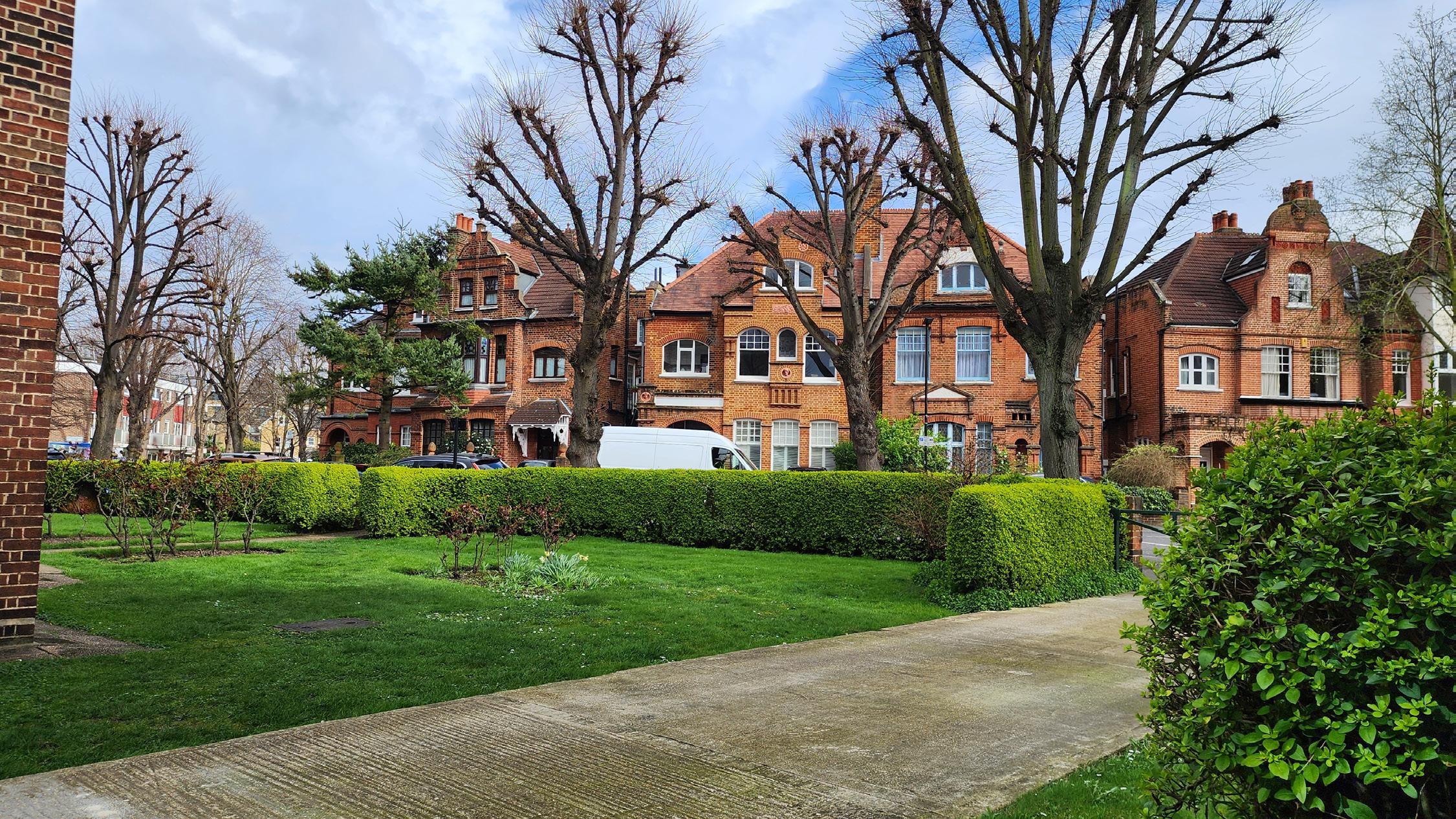
Normally when I go on a vacation, I like to plan out what I’m going to try to do each day, but with London, I decided to take a different approach. With the ability to have so much freedom in a distant land, I wanted to try to plan as little as possible so that I could go with the flow and experience things in the moment. However, I had one thing I circled that I had to do: travel to the city of Richmond. Ted Lasso is one of my favorite TV shows, so I wanted to go to Richmond and see where they gained their inspiration and filmed some of the scenes. Whether I went with a group or by myself, it was the number one thing I wanted to do while we were in London. I started the day by going to the Borough Market, then I departed on my journey to Richmond. After a technology snafu where my phone told me to go to the wrong station, I was able to follow a map to figure out how to get to Richmond.
One of the show’s most prominent locations was the local pub, so I embarked on a quest to find it. My initial excitement was deflated when I found out that
the pub was more than an hour-long walk. However, I quickly turned this negative into a positive as I realized I would get the full Richmond experience. This was truly a blessing in disguise as I got to see some of the true beauty of Mother Nature in this quaint, little town. The bright blue sky paired with the glistening green grass was truly a sight to behold. Not only that, but the unique and distinct architecture of the buildings and the nice weather only added to it. The pictures I took while on this walk were some of my favorites from the whole trip and are so stunning that it looks as though I put a filter on them. As I continued, I made sure to reflect on how amazing everything was, as this was a once-in-alifetime adventure. It also gave me time to reflect on the trip and how incredible the overall experience was. After an hour of walking, I finally reached the pub, but when I got there and looked around it did not look much like the one from the show. I decided to check my phone to make sure that I was in the right spot. Come to find out that I was not at the right bar. The pub I was at was called “The Crown and The Anchor”, which is

the name of the pub on the show. However, the scenes were actually filmed at a pub called “The Princes Head”, which was only a six-minute walk from where I originally started.
While this situation wasn’t ideal, the journey I took to get there was worth it. So, I started to walk back in the direction I originally came from and found that there was a tube station not far from where I was, but I had to hustle if I wanted to make it in time for the next train. After a long delay, I finally made it back to where I had started this journey and took the short walk to the actual pub. When I walked in, I was immediately greeted with kindness by all the workers and customers, an uncommon occurrence in London. Getting to be in the place where they filmed so many iconic scenes was amazing.
The story doesn’t end there though as the trip back wasn’t an easy one. I was planning to meet up with a group at St. Paul’s Cathedral, so I took the tube to
Waterloo Station to get on the connecting line. However, once I got there, they said they were already done, so I told them that we could meet back up at the hotel. The other issue was that the tube line I needed was closed. I ended up going through six different stations to finally make it back to the hotel. While the adventure of getting back was a long and painful one, I wouldn’t have changed any of it because of how precious this entire adventure was for me.
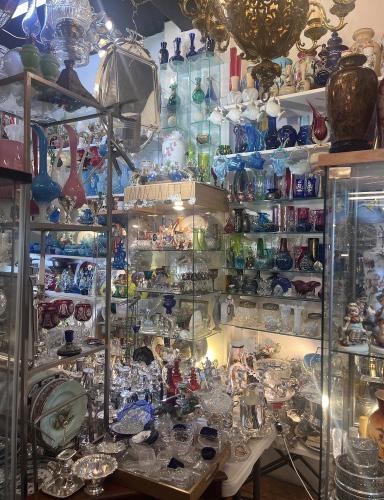
“Exit Through the Gift Shop” pays homage to some of the wonderful gift shops that the London museums are known for. The stories in this gallery portray our experiences with the markets, stores, and shops.
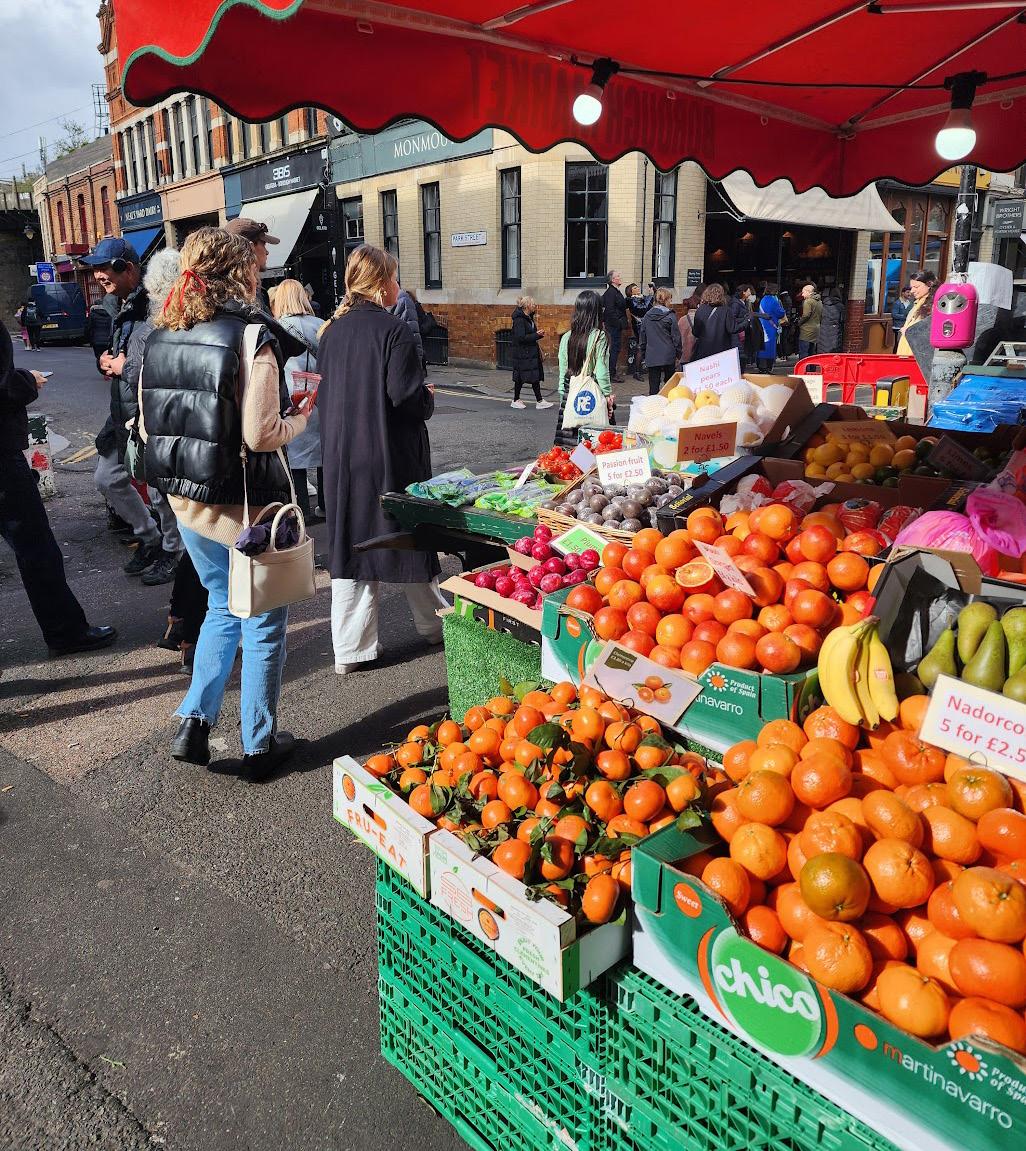



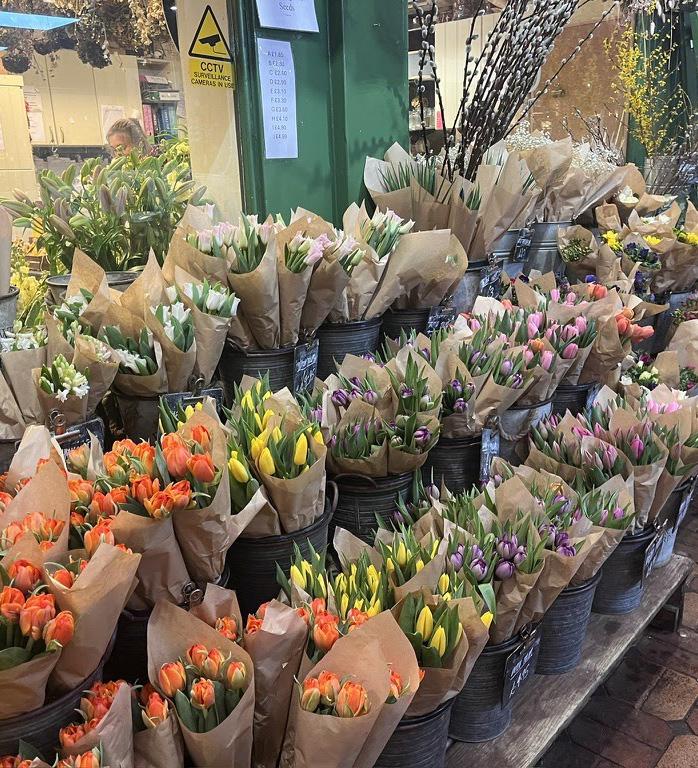
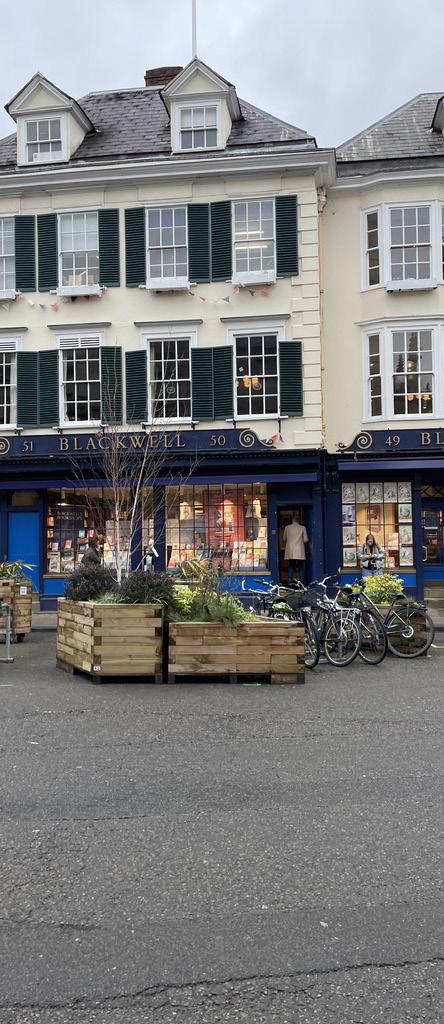


Standing on the ground floor of Blackwell’s in Oxford, I find myself enveloped in a moment of profound significance. As I sift through the tables of beautifully displayed books, my attention is diverted by the ping of email notification—a pivotal decision awaits within its digital confines. For the entirety of my final spring semester, I have been waiting for emails of decisions for library sciences graduate programs. I nervously anticipate my future fate of becoming a librarian. With trembling hands, I navigate to the login page, the weight of anticipation heavy upon me. I read the formalities to then see the word congratulations! In an instant, my heart soars as I am greeted by the words I had longed to see: acceptance into the esteemed digital librarianship program at the University of North Carolina – Chapel Hill.
Amid this euphoria, a revelation dawns upon me: bookstores have become sanctuaries during life’s most transformative moments.
Amid this euphoria, a revelation dawns upon me: bookstores have become sanctuaries during life’s most transformative moments. It is a truth I have come to embrace, a ritual that beckons me in times of transition. In my adolescent years, anytime I felt stressed or confused I would find myself at a bookstore reading every book spine in the fiction section as I tried to organize my thoughts. So, it was not that surprising when I began working at Barnes & Noble when I turned sixteen. No matter where I went in the U.S. I would go to a different Barnes & Noble and straighten up the tables of displays, sorting through my feelings. Whether navigating the unfamiliar terrain of a new city or venturing beyond borders, the allure of bookstores remains steadfast - A beacon of solace amidst the tumult of change. Reflecting on past journeys, I recall finding solace within the walls of The Raven upon my arrival in Lawrence and seeking refuge amidst the stacks of Waterstones in Trafalgar
Katie BryanSquare during my inaugural venture abroad. I find solace and inspiration in these sacred spaces, surrounded by the timeless wisdom of literary giants like Virginia Woolf and the Bronte sisters.
Yet, there lingers a bittersweet undercurrent—a reminder of the inevitable flux of life. The specter of a recent breakup casts a shadow over my jubilation, prompting me to confront the daunting prospect of charting my future path alone. As I stand at this crossroads, I contemplate whether to spread my wings in pursuit of academics or anchor myself in familiar soil. But amid the uncertainty, one thing remains certain: there is forever an imprint in my mind of this moment at Blackwell’s, where the boundless potential of the future unfolds before me. It is here, amidst the hallowed halls of literature, that I find the courage to embark on a journey of self-discovery and adventure, fueled by an unwavering love for books and the promise of a brighter tomorrow.

Vain. I thought I was vain to go to London just to shop. I am supposed to prefer experiences over mere clothes, I told myself. But you know what? No. I’m done with second-guessing myself. I’m done with feeling bad for wanting to do something others don’t. I’m done with acting like I don’t want to put on the dress I see in the storefront. And I’m done looking at a science exhibit I could have read about from the comfort of my bed back home. I don’t like museums that much anyway.
I went to Oxford Street first. Just a bunch of department stores. Mediocracy on top of more mediocracy. McDonalds every half mile. Waste of time. Useful only to demonstrate how much better the real markets were. Moving on.
Camden Market, however, was not a waste of time. It consists of the crème de la crème, unique and on Oxford. Highlights from Camden include a teal cape (just in time for King Lear), a cute summer sweater, and my goal for the trip, a real London coat. Camden was so good that Easton and I went twice just to make sure we got it all.
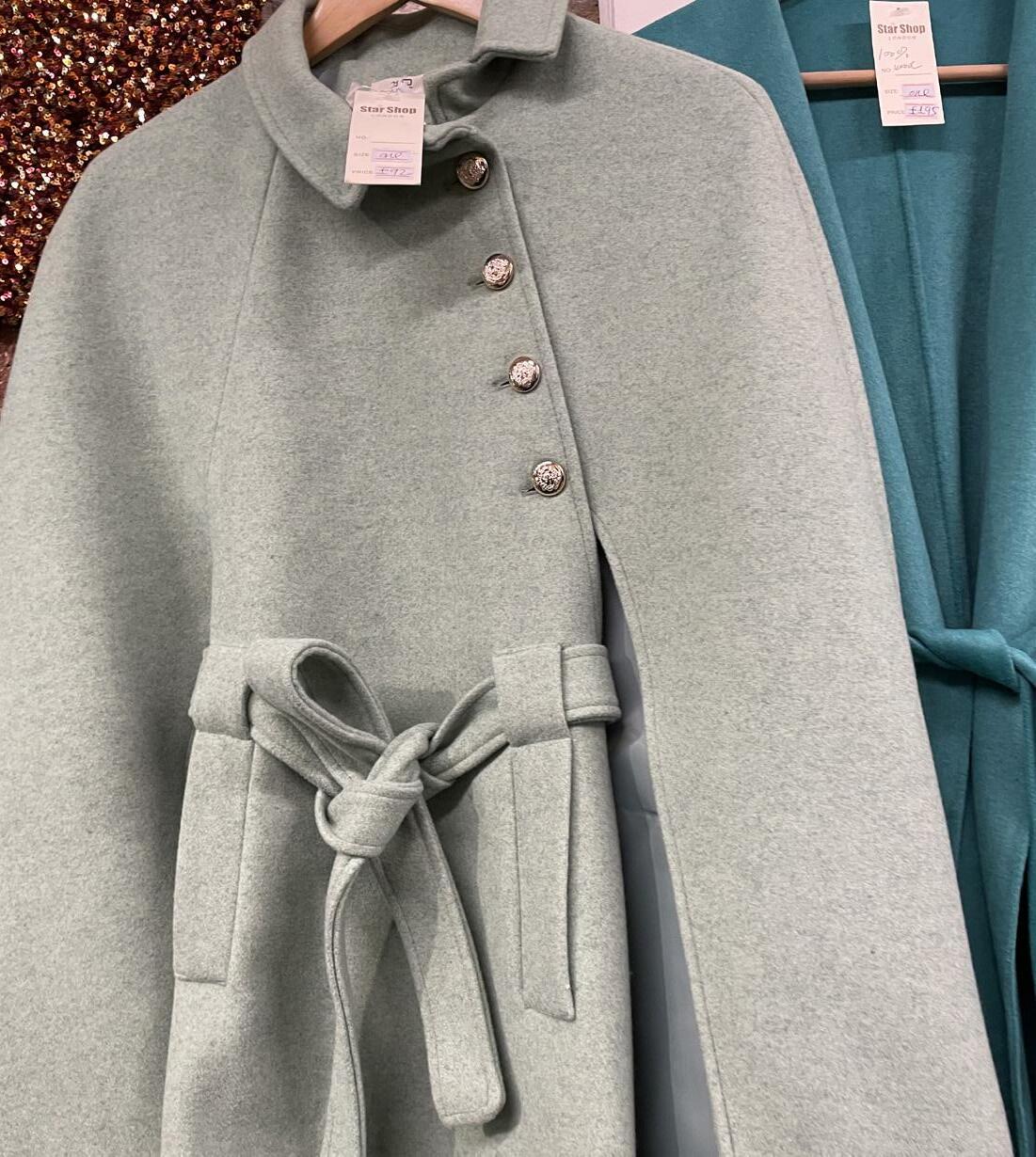
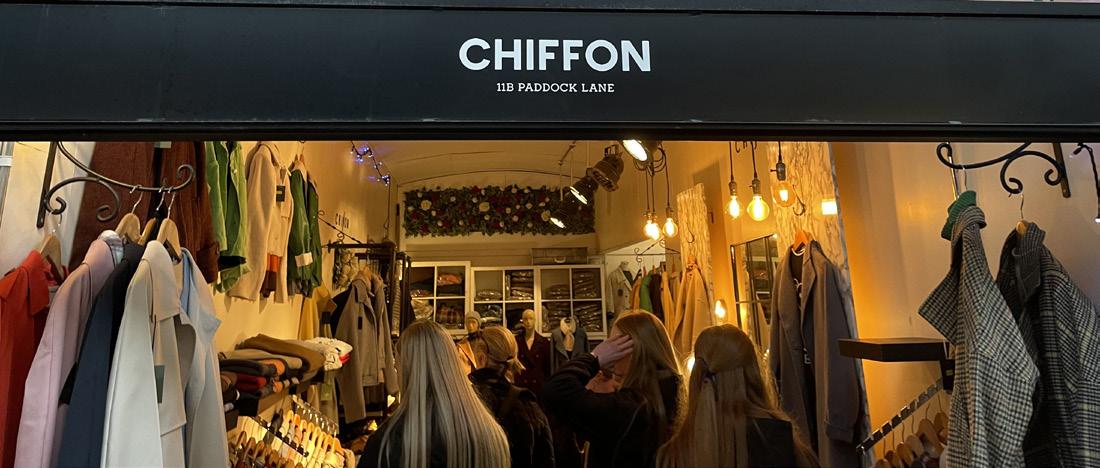
Before entering the crush of people on Portobello Road, I told myself I wasn’t getting anything else. I bought what I wanted for the trip; I was just there to see the sights. How naïve I was. Silver buttons for my cape? Yes, please. Antique jewelry fitted with clip-ons? I’ll take four sets. A mega-cute raspberry jumper sweater: hand knit? Uh, yeah! It had more in the way of knick-knacks and curiosities than clothes, but it certainly delivered.
Did I see a lot of conventional art in London? Nope. But then, is the body not art in its own way? Is fashion not an expression of the self as much as painting or writing? My London wardrobe is my museum, the mirror a gilded frame, and my clothes? My art.

There we were, walking down a dimly lit alley near Portobello Road. We weren’t sure how, but Emily, Preslie, Xander, and I had gotten extremely turned around while exploring the vintage market area, and walked towards what we thought was where we had come from. Instead, we entered what could only be described as the backroom bowels of Portobello Road. We strode on in fear, receiving suspicious looks from the menacing eyes of people lining the narrow road. A man jumped out from the shadows and stopped us. “In need of a… piercing?” He growled as he whipped his fist up like the Wolverine, but instead of razor-sharp claws, he had piercing needles tucked between his fingers. Due to his extreme fear of needles, Xander instantly passed out cold. Preslie and Rachel, unphased, looked at each other and replied, “Yeah, sure.”

And that, my friends, is a completely fabricated story of how Preslie and I got pierced on Portobello Road.

The story actually begins with Emily, Preslie, Xander, and I walking up and down Portobello Road. We had just broken off from a larger group and were still deciding what our next move was going to be. And then I saw it. Like Batman to his Bat Signal, like Yogi Bear to a picnic basket, I saw the piercing shop storefront and immediately said that we should get our ears pierced. Having eleven piercings already, I thought it would be a cool souvenir and story to add to my collection. Plus, I trusted that London would have decent places that would not give me a piercing with a side of flesh-eating bacteria. I suggested it thinking that no one would agree. But lo and behold, Preslie hopped on my crazy train,
saying she had been wanting to get her Doubles done. With that, we scurried over to the shop.
We were instantly greeted by an employee asking us about what we were looking to get done. With all my previous piercings, I had mapped them out and got them over four years. (After having an atrocious experience with getting multiple piercings at once, I decided to slow the process down.) But now, I had decided within thirty seconds what my next hole punch was going to be: a high lobe to go with my Double Conches. But, before committing to anything, I asked the woman behind the counter about what gauge they would pierce with, the type of metal their earrings were, and what their sanitary practices were. After my line of questioning, she asked me if I was a piercer, which I took as the highest form of flattery.

Determining everything was up to par, Preslie and I committed to getting our ears pierced. The woman gave us a quote and informed us that the shop only took cash. This sent our quartet on another adventure to find an ATM to withdraw money, which was easy. My piercing was set to be £30, which equates to about $38, and was an insane deal. Cash in hand, Preslie and I returned to the shop, filled out our forms, and waited for our turn with the piercer. With her nerves running high, Preslie went first. She walked into a small room with various sterilization equipment and a high bench to sit on. When the door was open, the room looked directly into the waiting area where Emily and I sat.
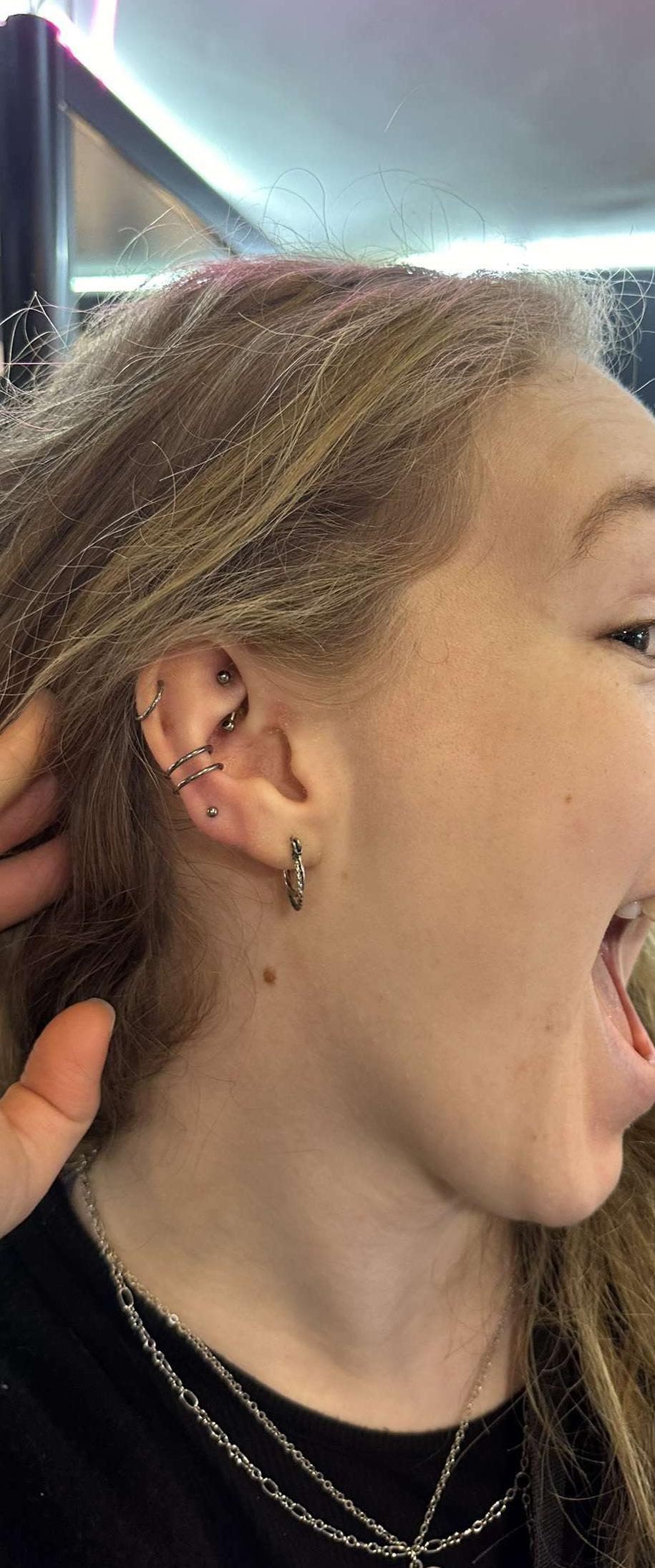
We watched with pride as Preslie smiled through getting her Doubles pierced. (Xander is in fact terrified of needles, so he waited outside.) Then came my turn. I walked in, sat down, and told the piercer what I wanted. She put a guide dot on my ear, cleaned it off, redrew it, and then asked me what I thought of the placement. I looked in the mirror and gave the go-ahead. She used a clamp to hold my earlobe and facilitate the piercing process, lined up the needle, and told me to take a deep breath. I inhaled, and upon exhaling she drove the needle through my ear. I couldn’t help but crack a smile. There was some more moving and tugging as she put in the stud, and then she said I was all set. I instantly got up, looked in the mirror, and knew this was going to be one of my favorite souvenirs.


During my recent visit to London, I embarked on a delightful exploration of the city’s vibrant markets, each offering its own unique charm and character. From the bustling streets of Columbia Road Flower Market to the eclectic atmosphere of Portobello Road Market, my journey was a sensory feast filled with colorful blooms, delectable treats, and an array of treasures waiting to be discovered.
My first stop was the enchanting Columbia Road Flower Market, where the air was filled with a sweet fragrance of flowers and lively chatter. I wandered through the narrow street lined on one side by vendors and on the other by small shops. To my left, I saw orchids, peonies, and daffodils. To my right, cookies of all types and flavors, bagels with every imaginable filling, and never-ending coffee menus. As I continued down the street, I came across lemon trees and the scent of lavender. It was a rainy day, but that did not stop shoppers from coming to fulfill

their flowery needs—the street was so crowded, I was playing umbrella dodge every three steps. My only regret was not being able to buy a bouquet to take with me back home.
Next, I made my way to Covent Garden Market, a historic hub of activity nestled in the heart of the city. Here, I was greeted by a bustling scene of artisans, shoppers, and street performers. Exploring the myriad of stalls, I saw all types of handmade goods, antiques, and souvenirs. While everything was so interesting to look at, I ultimately left empty handed.
My culinary journey continued at Borough Market, a food lover’s
paradise brimming with an irresistible array of gourmet delights. From baked goods and ready-to-order street food to pans of steaming paella and the best chocolate-covered strawberries, the market was a feast for the senses. I made two full rounds around the stalls—meanwhile indulging in samples of artisanal cheeses and mushroom risotto—before finally deciding what to eat. My four-course menu consisted of: half a pork shoulder sandwich, a portion of seafood paella, a cup of strawberries doused in chocolate, and a crème-brûlée filled donut. I savored every bite. With its bustling energy and diverse culinary offerings, Borough Market is a true gastronomic adventure not to be missed.

I concluded my market exploration at Portobello Road Market, a colorful mile containing hundreds of specialist shops and stalls. As I wandered down the street admiring the eclectic array of treasures, I encountered antique coins, hand-made clothing, and never-ending displays of jewelry. I settled on a traveling chess set, a handmade ring, and a knitted shirt (as colorful as Notting Hill). I spent three hours exploring the market’s hidden gems and could have easily stayed longer, had time allowed.
My experiences exploring London’s markets were nothing short of magical. From the vibrant blooms of Columbia Road Flower Market to the collectible treasures of Portobello Road, each market offered a unique glimpse into London’s culture. My one regret is not being able to visit Camden Market, but that only serves as a delightful reason to plan another visit in the future.

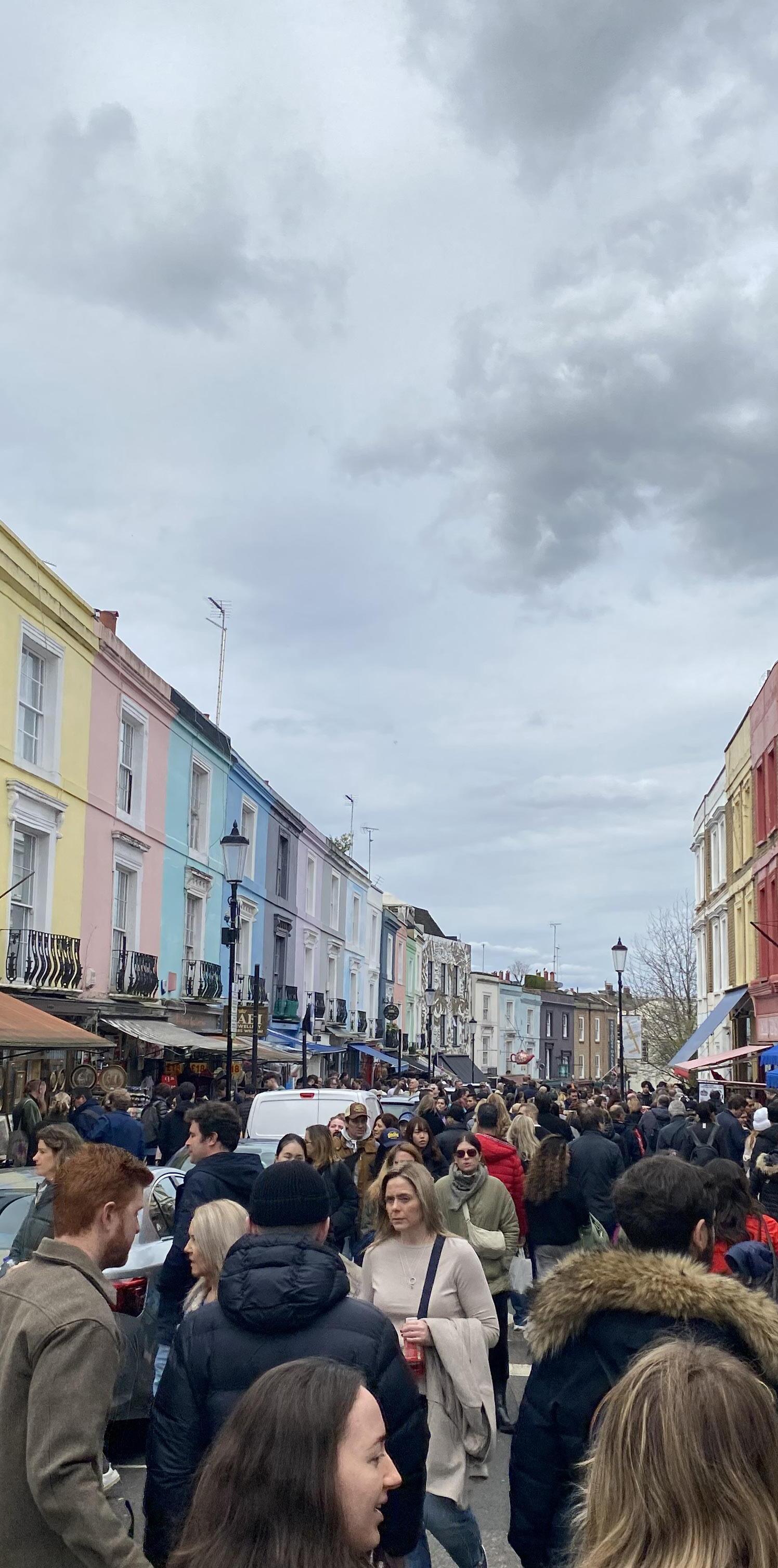
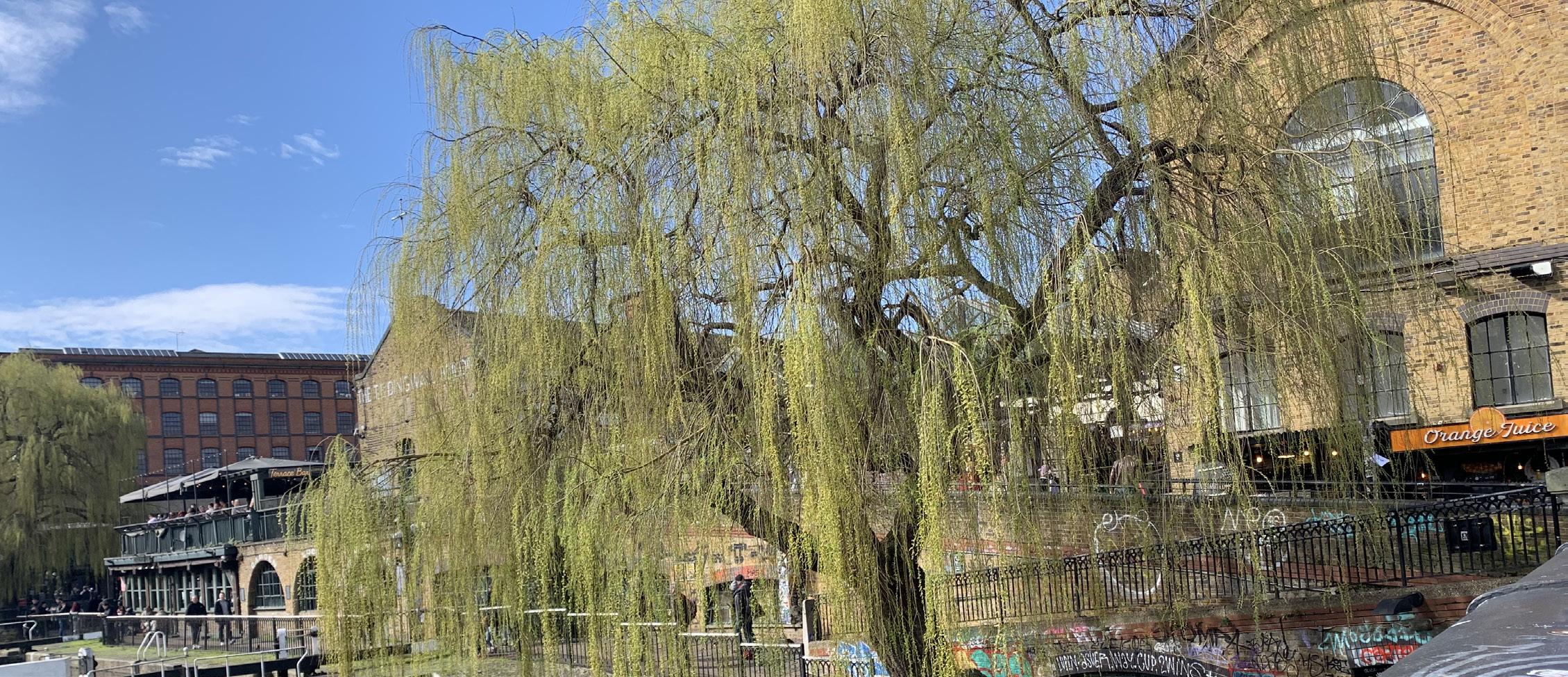
My very best friend put me in a group chat with her roommate from Indiana University to let us know we would both be in London at the same time. I received this text weeks before the trip and made a mental note, but it fell to the wayside as I immersed myself in the shiny, new experience of traveling abroad – I never even had the time to Instagram-stalk this potential travel buddy. Several days into the trip, I was ready to fly the nest and spend a day on my own, but experiencing some museum fatigue, I was unsure where the day would take me. As fate would have it, the friend-of-a-friend, Courtney, was in the same situation, and she reached out to meet up at Camden Market. In blind-date fashion, she texted that she would be waiting on a corner in a tweed jacket and glasses. I turned to my old pal Citymapper and took the three consecutive tube rides to Camden in search of this mystery girl whose attire surely matched every other London marketgoer.
As luck would have it, Courtney was quite the jet-setter – she had been to London so many times that she knew not just a place but several places that transformed my London experience. First, we fueled ourselves for the day with Nutella-covered churros and the obligatory tea. Then, we happily traipsed in and out of jewelry stores, leather stores, denim stores, vintage stores, record stores, and bookstores like an early 2000s cinematic shopping montage. We ended our shopping
excursion at an artisan booth run by a man with curly, gray hair and thick-rimmed circular glasses. He was dressed in all-black with a leather apron that jangled with chains and tools. I’m not sure what this man’s name was, so I will refer to him as the Girdler – another name for a maker of belts or waistbands. The Girdler took my measurements and made me my most-prized souvenir: a red leather belt with a vintage gold-colored buckle. I was mesmerized by his swift hand movements as he chopped away at a simple strip of leather with some old metal instruments and reconstructed it into a unique fashion statement. Surrounded by dangling leather bags, wallets, chains, and belts, the street bustling with foot traffic, and the air filled with the scent of smoke from a nearby grill, I was transported to what I imagine a medieval British leather-worker’s shop would have been like.
By the end of the day, I had reached sensory overload. London market visits, no matter the location, tend to follow the same trajectory; upon arrival, you are filled with excitement at all of the sights, sounds, and smells, and by midday, a quick snack and tea serves as a pick-me-up to navigate the rest of the sprawling shops, but by about 3 p.m. it feels like all of the energy has drained from your body. My time at Camden Market had come to a fulfilling end. I left with a cool new belt, a great new friend, and one of my best memories from the London Review trip.
The London Review was my first international trip without my family. In honor of this big step, I knew I wanted to travel differently. Free from being the perfectionist, hyper-planner I naturally became as a middle child in my family, I was able to take on this trip however I wanted. During my time in London, I learned to be mindful of the present and let the days unfold spontaneously. Although this would be the cause for one truly chaotic day, I’m so glad I chose to take on London in such a freeing way.
I spent most of my time with a group of friends that had unique interests and ideas on what to do in London. Burnt out from midterms, I didn’t spend as much as I wanted towards planning out which sights I’d be eager to see. Therefore, I let my friends follow their interests on open days while I followed along; taking it all in. This system worked great for two other friends of mine as well... until it didn’t. One day, after a serene morning at Hyde Park spent admiring the swans, we walked out one of the park’s exits into the elegant streets of the Belgravia district. Until this point, we were traveling with Tam, our group’s strongest planner and universally appointed leader. When she told us she was going to split off to do some studying at the British Library, it was the first stage of failure.
Within minutes of our separation from Tam, we stumbled into Burberry, a luxury British fashion brand. In the haze of the store’s soothsayers and the adrenaline of being on our own, I dropped an irrational amount of money on a wallet from their new line. It’s safe to say there was extraordinarily little souvenir shopping on my end for the rest of the trip. Despite the purchase just being a wallet, we left with a whopping 16-inch bag on which “BURBERRY” was printed boldly for the world to see.
Stories of pickpocketing and mugging, like one we had witnessed the night before, echoed in my mind. I took off my jacket and draped it over the greedysized bag. Now I was down a couple hundred dollars and cold. Mind you, Tam had left only 25 minutes ago.
We traveled 30 minutes northwards to Camden Market. The borough was fascinating to wander through. Delicious food stalls, shady paths by the river, and an endless line of vendors quickly turned our day around, or so we thought. I was standing on the footpath by the water for a picture when the unthinkable happened. A bird perched on the wire above me decided to go to the bathroom. The next couple minutes were erased from my memory, probably because of the level 10 trauma. I chased my friends with napkins, yelling at them to get the poop out as onlookers witnessed the epitome of American recklessness.
When the chaos subsided, we wandered into a nearby marketplace. One jewelry vendor was adamant that we try on every ring and bracelet. We tuned him out for a couple minutes until suddenly he started yelling at us. Within minutes he went from begging us to try on things to yelling “bye” in our faces. We walked away as he started counting his merchandise and giving us a nasty look.
With our mood utterly spoiled by the mishaps of Camden Market, we decided to leave the area. On the whim of a Tik Tok one of my friends had watched, we decided to check out Hampstead Heath. The park was a nine-minute bus ride but became a 20-minute commute when we overshot our destination by five stops.

We ended up at a back entrance of the park, far from any of the nicer parts of the area. Seeing the wet foot paths and muddy hills due to the recent rain worsened our already sour mood. After about a half hour of miserably walking along the path, we started making our way to the nearest station- another 20-minute walk through a residential neighborhood. On the way, a 10-yearold, dressed as a clown, accused me of recording him. I snapped at him about my innocence, still shaken from the stealing accusation at the market. We realized it was just a prank when he laughed in our faces- the day was defeat after defeat.
We gave the day one last chance by traveling a half hour to Soho. That ended up being a waste when one of my friends got caught in an hour-long line at the checkout at Zara while the rest of us walked in circles. Our feet ached tremendously, and we decided to admit defeat and call it a day.
When we got back to the hotel lobby, however, I realized how important it was to have a day like this. I told the tragic story about ten times, each in various levels of vulgarity and detail- depending on if the listener was a professor or fellow peer. No matter who it was, the shared jokes and laughter we had over the experience made the day worth it. Even now, with the trip over and us back in our normal routines, my friends and I reference events from the day. Stepping out of my comfort zone and being more mindful are two things I have absolutely no regrets doing during my time in London. Though it may have given way to an awful day, the trials were a catalyst for a stronger friendship, and I wouldn’t change a thing about the day.
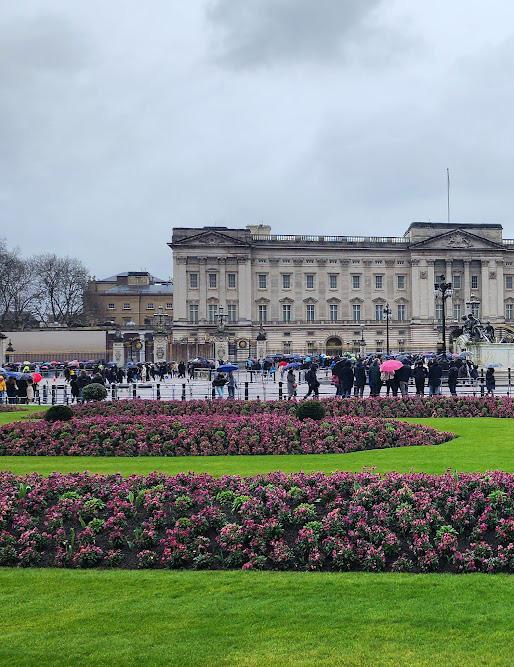
“The Crawford-Parker Courtyard” is in honor of Doug and Sarah Crawford-Parker. Throughout this gallery, stories guide you through the beautiful green spaces and architectural monuments seen throughout London.







I’m not a religious person. As a kid, I would go to church with my parents every Sunday, but I never connected with the ideologies. I usually found myself doodling on the offertory envelopes or counting the organ pipes instead of tuning in to what was being said. well-known and some hiding behind unassuming facades on the street. Each one rendered me speechless.
I felt the power of these churches, oratories, and cathedrals upon entry. The vaulted ceilings encapsulated me as they stretched toward the sky, leaving me paused in the doorway with It was as if the church itself was the being of worship. Walking down the aisles of pews, I felt like an imposter. The immense stone columns reduced me to the size of a germ, infecting the interior with my presence of curiosity instead of prayer. I made sure to move quietly to not disturb those with heads bowed andwhispering to their hands, deep in devotion. Upon reaching the altar, I paused. Here was the heart of the church, and I observed every component of its anatomy. The candles, the Communion Table, the inscriptions in the ceiling, the way the light trick led down from the narrow windows of the dome aboveI turned around and walked down the center aisle, reversing the procession of a bride.
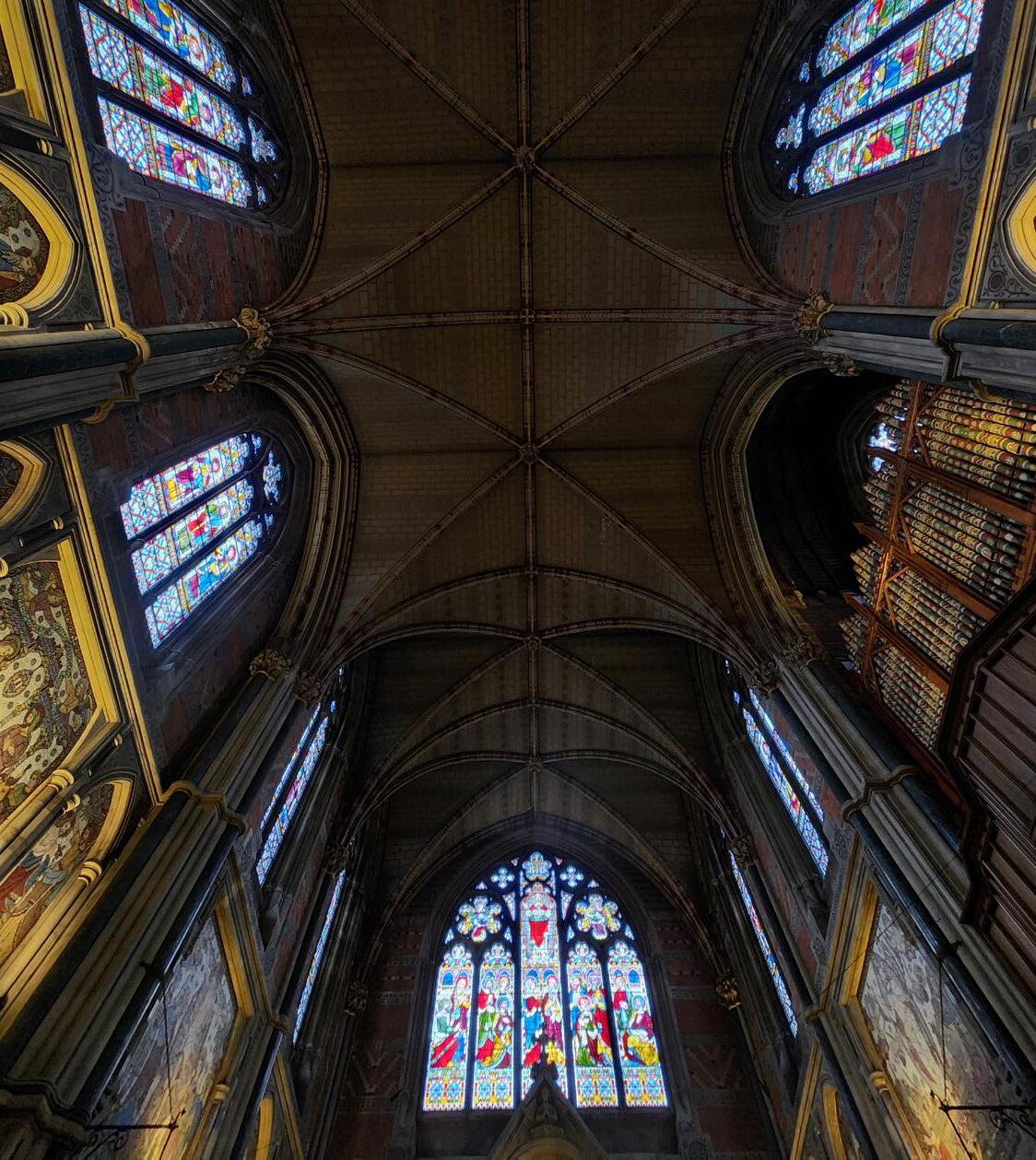 Rachel Odabasi
Rachel Odabasi

My eyes fluttered from the carvings on columns to the sanctuaries adjacent to the nave. If I was visiting at night, parts of these sacred spaces were shrouded in veils of shadows covering the unknown and further expanding the physical boundaries of these already cavernous rooms. I listened to the hushed voice of the church, its breath the sound of its silence. Some of these holy entities respired stiff and heavily while others were sad and wistful, even secretive at times.
I mourned having to depart from these mystifying spaces. I didn’t want to leave until I had taken in every intricate detail. I took ok from the door and returned to the outside world. I stepped onto the street feeling like I had been through a church service, only this service preached inconceivably opulent design to a God of Architecture. There was only a moment to think about the elevating experience before the sounds of cars, people, and life itself rushed back in and it was time to move on. I continue to visit the pictures on my phone and the memories in my head, but these experiences remain indescribable. I hope to one day attend another service for the entity dwelling in the walls of those holy spaces, but until then I’ll continue the hunt to find the words I lost while visiting these venerable architectural works.
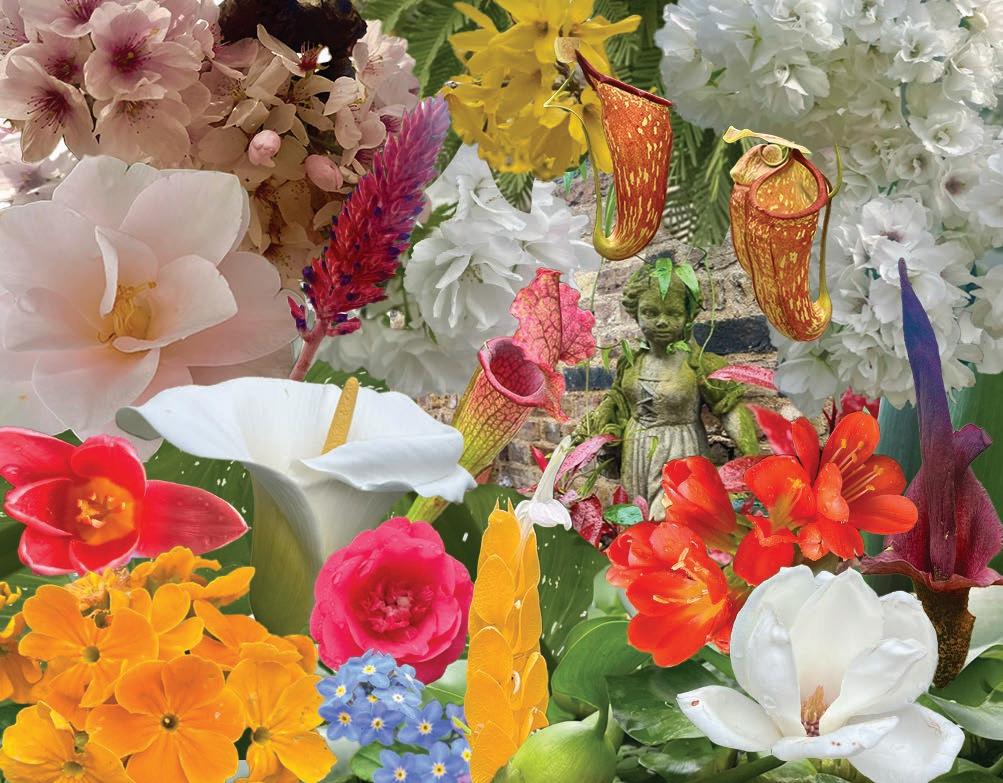

Europe, the old world: I feel I did not have a proper understanding of necessarily how young America is as a country until I witnessed the rows and rows of living history on every street in London. Buildings, any one of which, if found in America, would be held up as an architectural marvel, were commonplace, the mundane, the average. The average of London far surpasses that average of beautiful for ninety-ninety precent of America. It’s not the age that makes it so, nor is it a lack of architectural talent within our fifty states: it’s the structure of America compelling those who build to do so quickly, cheaply, and without artistry.
America, I believe more than most European countries, is a by-product of the industrial revolution. It did not originate here, but our former and current titans of enterprise have steered the nation’s ship. This is because there was and still is simply a lack of existing infrastructure that had to be worked around. In London, if you wished to open a clothing store, you could inhabit one of the previously existing buildings, ones created with longevity and artistry at the forefront—vitally, this remains true both now and then. In America, if you wanted to open a clothing store, you would have to build a place yourself, or in the modern age, rent it from a single-use building built by another store developer fifty to a hundred years ago. In America, one has far more opportunities to build because of the lack of history, so renting, especially in buildings constructed cheaply to maximize profit, is a less viable option.
We build where it is cheap, where a store stands on its own, with plenty of parking. Where parking reigns supreme is the American Super Road, our country’s architectural method of choice: a two-to-four lane road lined with corporate-owned restaurants, stores, and gas stations. Some stand in outlet malls, some independently, some mix-and-matched based on region, but the general gist remains the same. For those in Lawrence, KS, Iowa Street from 9th to the interstate is the perfect example.
To be fair to America, there are minor areas of oldnew-world charm, mainly found in “historic downtowns” that are dotted over the landscape. These hold the most comparable structure to London and other European areas, but with a fresher, more recent (in relation to the age of Europe) style. However, these strips are small and infrequent, but are celebrated and held to high regard by its local government and community. (Again, those in Lawrence, think Massachusetts Street from about 7th to 12th.) Despite a respect for this style of building, it remains a thing of the past, something only to be preserved and never expanded upon.

Why? Because it’s not economical. It’s not the lowest possible investment.
I believe that every sight you take in, every sensory input, has an effect on your mind. This might sound obvious, but we, as a society, have become numb to constant billboards, advertisements, and modern corporate architecture. These things were not created to invigorate our lives but to tempt us to spend our money. We are surrounded not by beauty, but by a constant barrage of temptation. It drains us, takes our energy away, making us more prone to negative emotions and, therefore, a negative life. In London, even the average storefront was treated as if it would live a legacy, and that care oozes from every stone. America has not been given the economic cir cumstances to extrude that care. If that every day is one surrounded by the world of the soulless, we are doomed to join. Still, America is uniquely positioned to create a solution directly in the middle of these two extremes.
We cannot, especially if we can not or will not start now, create entire cities and towns with Old World architecture along every street corner. But that is not what we need. There is certain loveliness in the fact that America and its infrastructure is so impermanent—it can be changed! If an entire block of a city is not working, there is no history left preserving and we can tear it down, replace it with something that helps the general populace. We must acknowledge that London has some of the best public transit and walkability of any city in the world, but it is also filled with plenty of awkward angles, difficult intersections, and paths that simply could be improved if it did not harm the history of the place. The architecture of the entire city is museum- like, both in quality and treatment. There is a great preservation aspect to it, but also a certain stiffness. The community, no matter how it changes or grows, cannot change what is around them without destroying hundreds of years of history. America does not have this problem, so when we do figure out the best methods of community, or architecture, or public transit, or infrastructure in general, we can implement it without hesitation! So whatever generations are to come, they can tear down these unimportant places, make them important and worth saving! They can express themselves through the art of architecture, make the community united and current. The lives of all within that area would be improved. But for this to happen, we must keep infrastructure and architecture in the front of our minds so that we can improve our average of beautiful and of satisfaction.
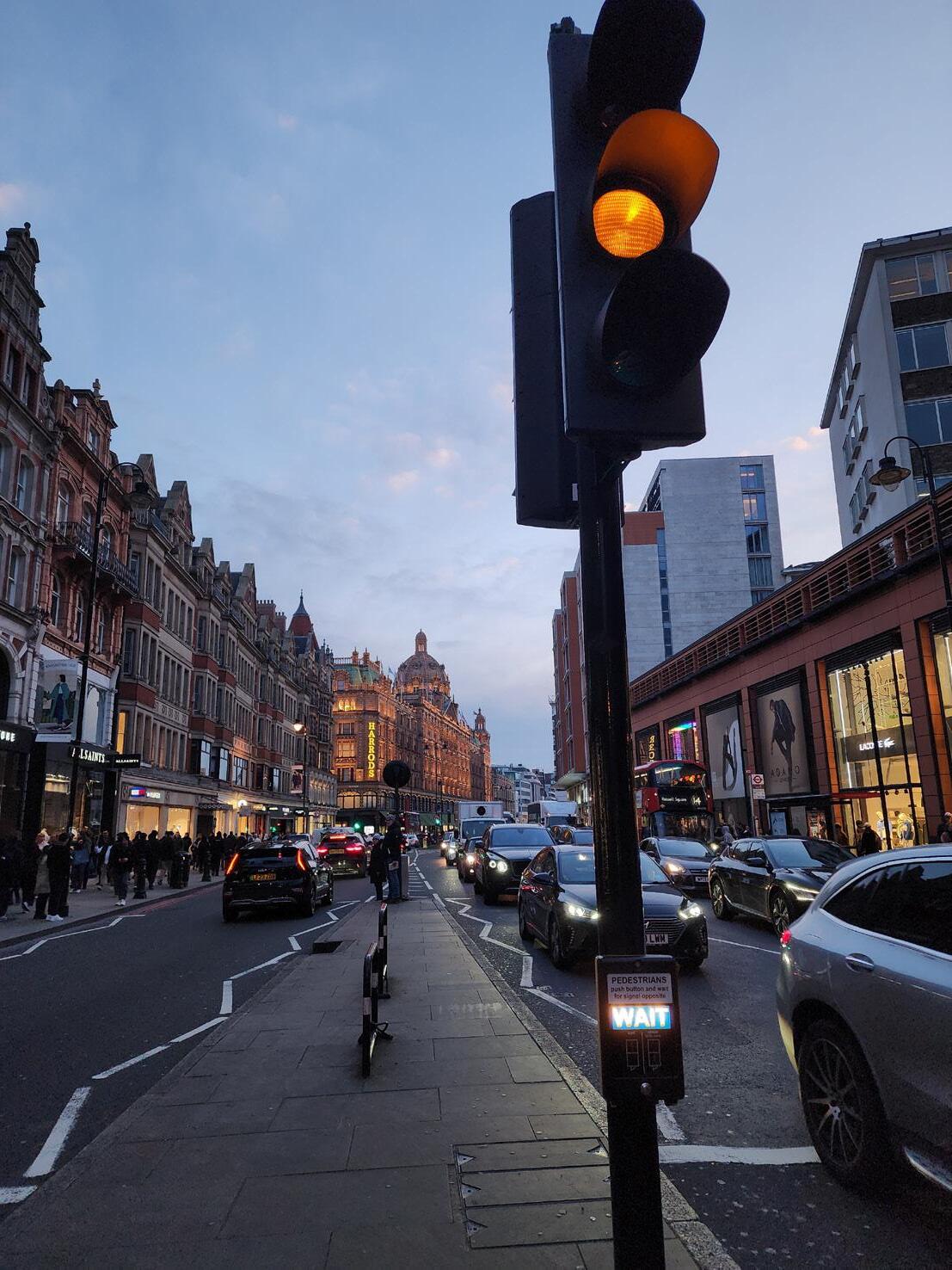
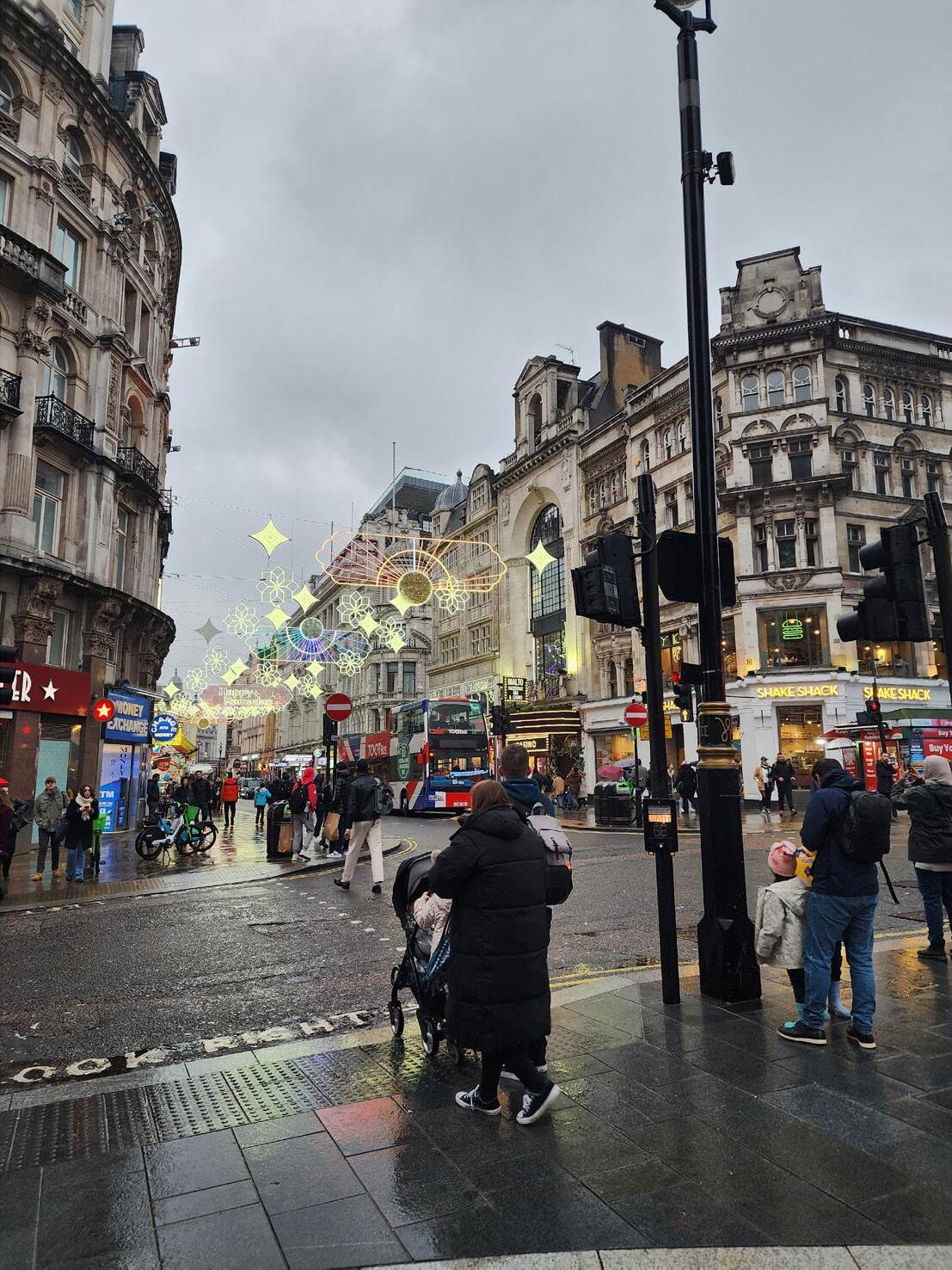
Of all the things to do in London, Hyde Park was my favorite. Although Lawrence offers some lovely green spaces – especially on KU’s campus – they all pale in comparison to this space. Only a ten-minute walk from our hotel, you can find anything you need at Hyde Park: expansive sidewalks, lush green space, rentable bikes, horse riding, a park-wide lake with paddle boats, even a colossal shrine to the royal family. But between these highlights among highlights, there was still something which stood above the rest: the birds.
They can be found everywhere within half a mile of the lake’s edge, though most spent their time resting on the water, awaiting tourists with a keen desire to share food. The variety of birds was roughly what you’d expect from a park: ducks, swans, geese, and the like. But they had a certain character to them that was more noticeable than elsewhere; they seemed comfortable approaching people, while still maintaining the temperament of a wild animal. More than once, I saw someone tricked by their feigned friendliness, almost caught in the jaws of a swan.
But so long as you admired them from at least a few feet away, they were quite beautiful. Several birds stood out to me, shown here:

I heard a nearby child dub this one “longy-neck”, which seems accurate enough. It was a genuinely beautiful bird, especially with its wings open as shown in the picture. Its pitch-black feathers really stood out, especially when it mingled amongst the other swans who had more typical white feathers. The beak was also a much deeper color than the others, approaching more of a reddish pink, which really stood out as it confidently approached anyone admiring it.

I never found out whether this duck truly had one leg, or if the other was tucked somewhere beneath its body. Either way, Pogo was a very mild-mannered bird, who spent most of his time sitting amongst the female ducks and napping. He was one of a large number of American mallards, which was surprising but comfortingly familiar. The question came up several times as to whether they were aware that they were British – but to my knowledge, none of them ever sought out the embassy. We decided to let them live blissfully ignorant.

Last but certainly not least are these three geese, looking more like the Blue Angels than a flock of geese. These same three were active just about the entire time I was within the park, flying back and forth between the two ends of the lake. It was honestly a great addition to the atmosphere of the park, making everything feel more honest and alive. Many people stopped to watch as they flew, which was a sweet moment to share with strangers who are now thousands of miles away from me.
Hopefully from these few birds alone, you can get an idea of the sorts of personalities you’d find at Hyde Park. It was a truly beautiful space, somewhere that I’d have happily spent an entire day, if there were a day to spare. It’s the kind of place that makes you understand why writers and artists from across the world gravitate to this city – it’s an exemplar of the beauty that London has to share, if you’re willing to sit down admire it.
Color is a gift. It allows us to see. If it was all black and white, then what would life be. It would be drab, and it would be cold.
Living in color, it holds greater value than gold.
Red:
Double-decker buses drove all ‘round the town.
And my trusty rain jacket protected from rain that fell down. The Hogwarts Express, the most iconic of trains.
And a cute little phone booth, sat next to the Thames.
Orange:
A beautiful flower, as I strolled through Notting Hill. A perfect English day. The whole world seemed still.
Then on a 20-hour, New York City delay, the color of the sunset kept my worries at bay.
Yellow:
Camden Market willows, reflected the setting sun.
And the gold of Big Ben on our final night run.
Puffy tree blossoms on the walk to Abbey Road
And Van Gogh’s sunflowers, a masterpiece, I know.
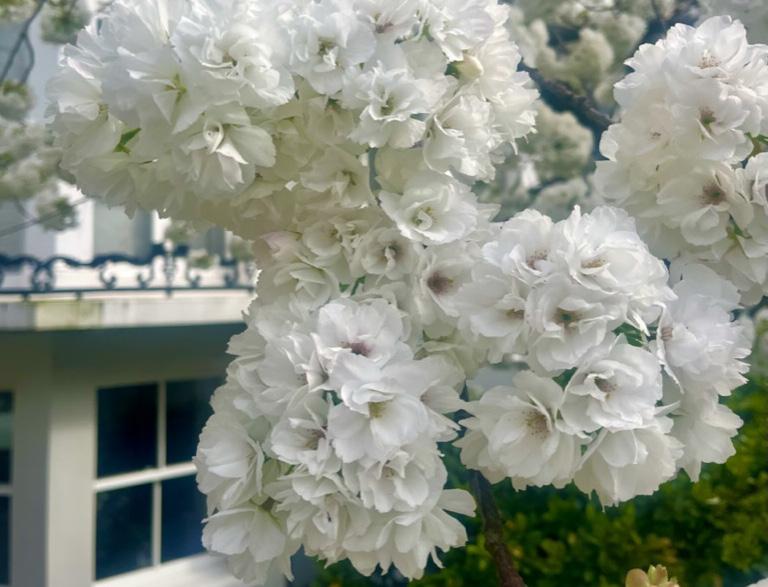
Green:
The vast rolling hills, as soon as wheels hit the ground. And the peaceful Oxford Gardens, where there wasn’t a sound.
Massive glass houses, packed to the brim.
Plants from far and wide, I walked between limbs.
Wicked is the word, the color of the witch. I want to go back, I really do wish.
Blue:
The sky stretched out, on the one sunny day. An open expanse, an ocean to sail away. My Ravenclaw scarf kept me quite warm from the wind and the rain and the massive Tube swarms.
Purple:
The Knight Bus I saw at the Harry Potter studio tour. And the large pitcher plants on my botanic detour.
Pink:
So many flowers were blooming on the trees. Cherry blossoms, magnolias swayed in the breeze.
 Ben Flynn
Ben Flynn
Brown:
Buildings stretched high made of mottled tan stone They rose to the sky. The horizon, they own.
Gray:
Ancient statues and artifacts of time, populate the museums their meanings sublime.
White:
The prettiest tree I ever did see. Like touching a cloud Flora fit for a queen.
Rainbow:
The rare jewels and gems shining brightest for us. An arc of color curved over Camden Market at dusk.
Living in color, many a one we saw. Showing and reaching out to each of us, all.
